

Ultimate Guide to Okunoshima, The Island of Rabbits, Japan

Japan is home to a tiny Island of Rabbits – Okunoshima. “Rabbit island” is only 4km in circumference, easily accessible from Hiroshima, and is covered in friendly wild rabbits. Sounds like paradise, right?
Japan’s Island of Rabbits, officially Okunoshima , is an island that can be enjoyed by people of all ages. Rabbit Island is a perfect day-trip from Hiroshima , or a great stopover on a Japan backpacking itinerary between Hiroshima and Osaka. A visit to Okunoshima can even be extended to an overnight trip with accommodation right on the island!
Here’s everything you need to know for your visit to the Island of Rabbits, Japan: Okunoshima.
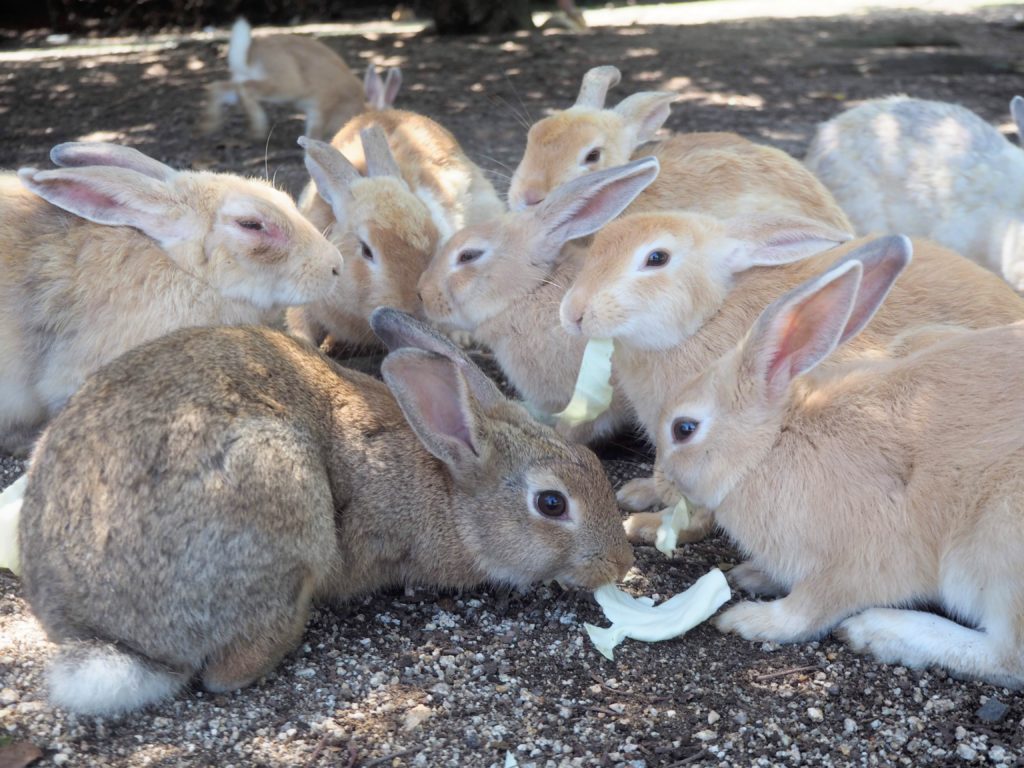
Guide to Visiting the Island of Rabbits:
Budget for Okunoshima: At least 820 yen (~$8 USD per person)
- Ferry – Adult tickets cost 620 yen round-trip
- Rabbit Food – 200 yen per bag at the port
- Souvenirs and Cafe meals – Optional, budget 1000 yen per meal and 500-1500 yen for souvenirs
Time to Allocate for Okunoshima : 3-4 hours is enough time to feed the friendly rabbits and circle the island. Plan to stay longer if you want to go for a swim or have a meal at the island cafe.
Amenities: Rabbit Island’s hotel and information center has clean restrooms and is home to two cafes and a souvenir shop. There are not many places to purchase snacks and drinks on the Island of Rabbits aside from the hotel.
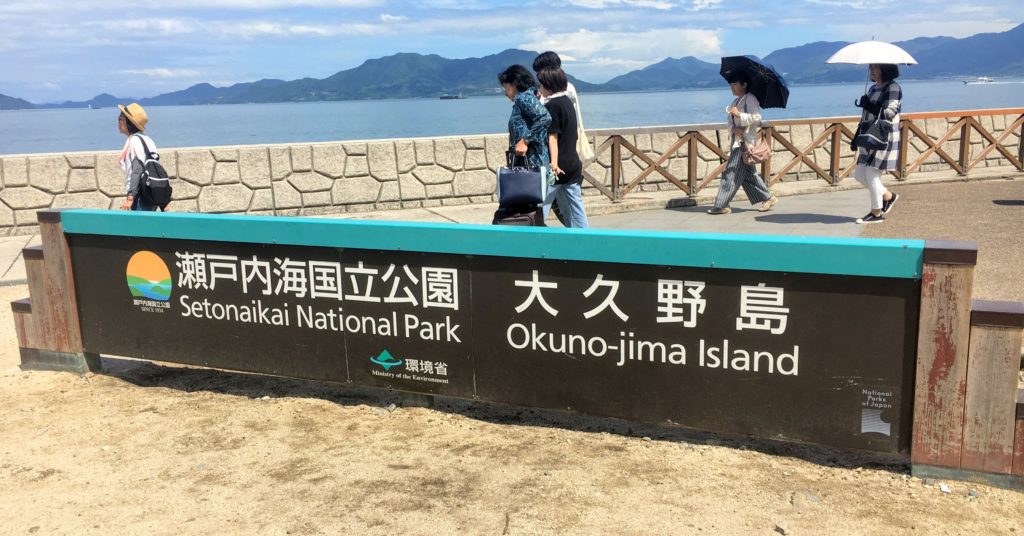
History of the Island of Rabbits
What happened on Okunoshima before it became Rabbit Island? The island has an interesting and dark back story, the remains of which can still be seen there today.
Because of its isolation from the main land, Okunoshima used to be where the Japanese Imperial Army produced poison gas to use as a weapon of war.
Similar to Area 51 in the U.S., the top-secret status of the poison gas production site meant that dying workers exposed to the gas were not able to receive adequate treatment.
On Rabbit Island there are still ruins of old army outposts, poison gas storage buildings, and a poison gas factory that has been turned into a museum. When coming to feed the Okunoshima rabbits, be sure to check out abandoned, ivy-covered poison gas buildings as well!
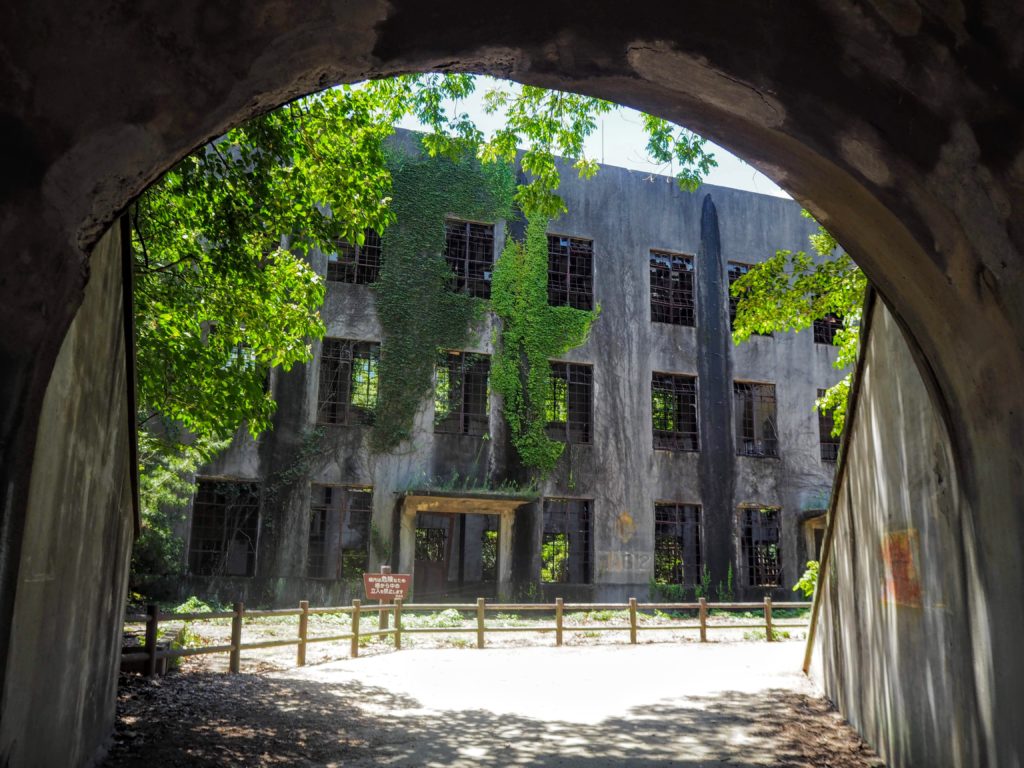
How to Get to Rabbit Island
The Island of Rabbits in Japan can only be reached by ferry. The ferry to Okunoshima leaves from near Tadano-Umi station on mainland.
How to get to Rabbit Island from Hiroshima
From Hiroshima Station, if you have the JR Pass you can use the shinkansen bullet train to reach Mihara Station. Without the shinkansen you can also take the JR Sanyo line from Hiroshima direct to Mihara. Change at Mihara Station to the JR Kure line, which will take you to Tadano-Umi Station.
How to get to Rabbit Island from Osaka
How to get to rabbit island from tokyo.
Even with the shinkansen , it takes a whopping 6 hours to reach the Island of Rabbits from Tokyo. Take the shinkansen to Fukuyama Station, where you’ll transfer to the JR Sanyo Line until Mihara Station. From here, change to the JR Kure line to Tadano-Umi Station. Leave Tokyo early and keep an eye on the ferry to Okunoshima schedule so you don’t get stuck on Okunoshima.
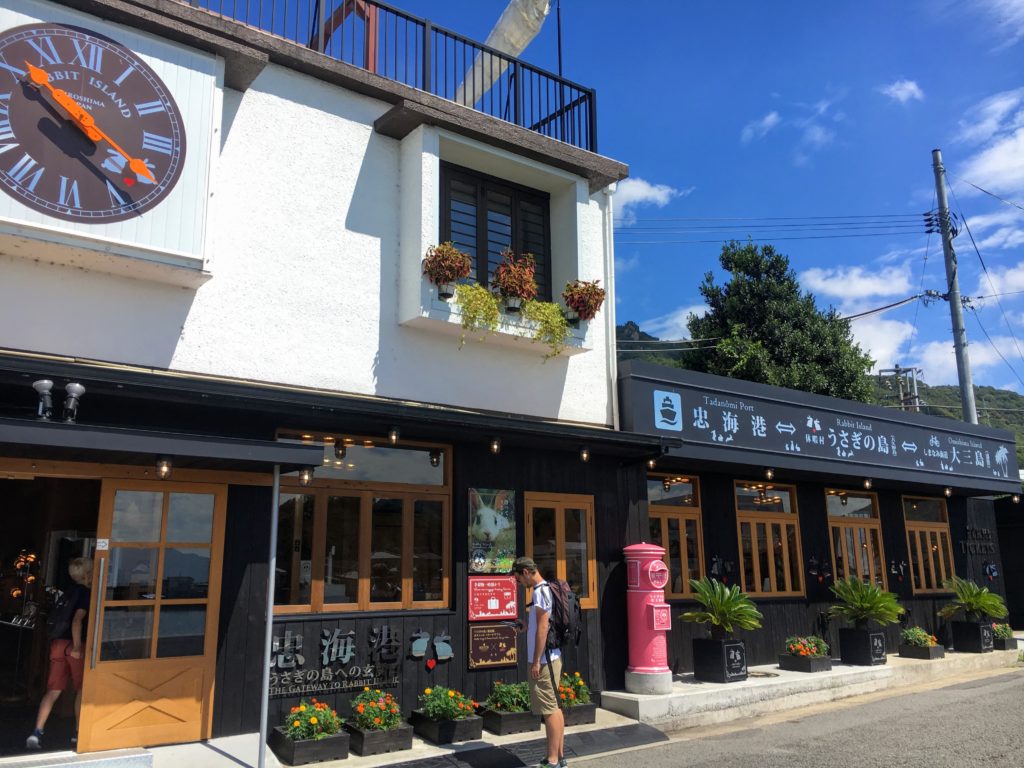
From Tadano-Umi station it takes about 7-8 minutes on foot to reach the ferry port. Take this extra time into account when planning which ferry/train combo to take to Rabbit Island.
The cafe across the street from the port is where you can purchase tickets for the ferry to Okunoshima. Either purchase tickets at the register, or use the ticket vending machine.
Ferry to Okunoshima Schedule
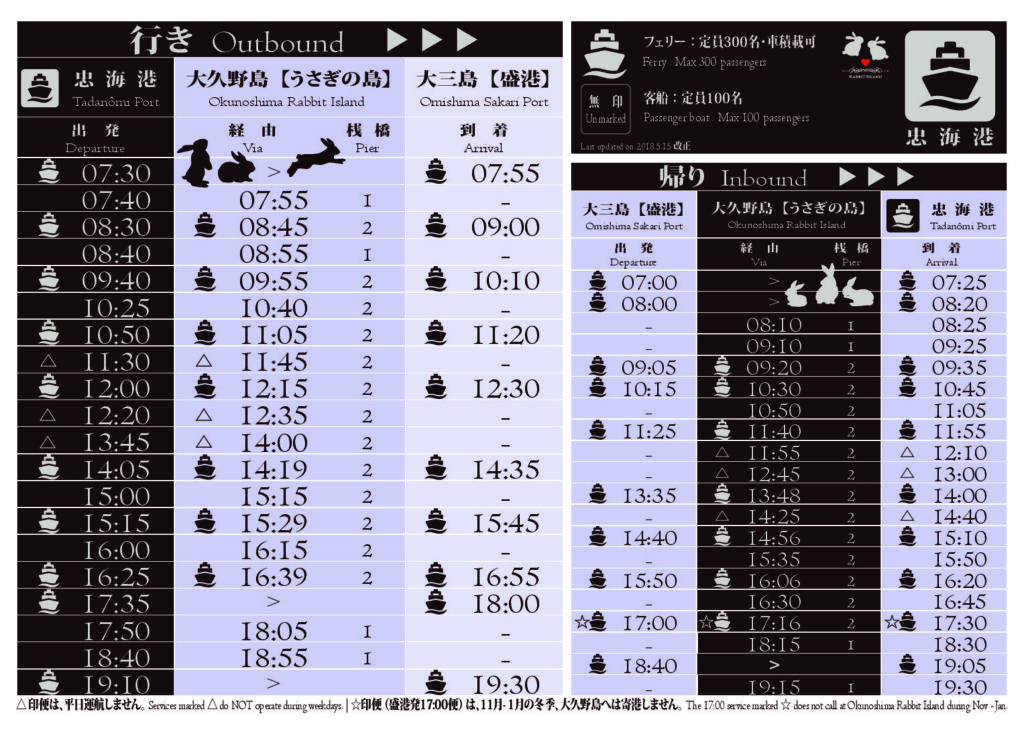
Tip: Buy Rabbit Food for Rabbit Island at the Port, Tadano-Umi!
If you’re wondering where to buy rabbit food for your trip to the Island of Rabbits, there’s only one place you can: Tadano-Umi Port. On Okunoshima island, there are no places to buy rabbit food.
An important tip for visiting Japan’s Rabbit Island is to purchase rabbit food in Tadano-Umi , before you get on the ferry to Okunoshima.
Each bag of Okunoshima rabbit food costs 200 yen from the port’s cafe. When you return the empty bag to the cafe, you will receive a free rabbit postcard.
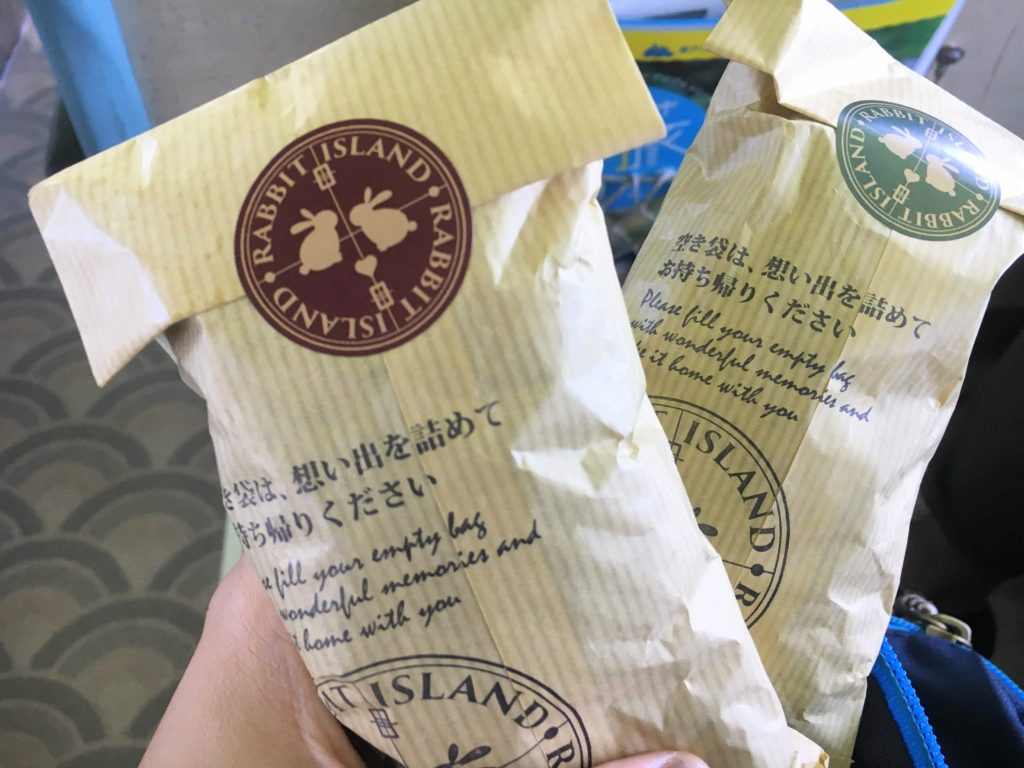
Luggage Check Options at Rabbit Island
I visited Rabbit Island on a stopover between Hiroshima and Naoshima , on my Japan backpacking trip with the Seishun 18 Kippu . I had to leave my big bag somewhere so I wouldn’t have to carry it around all day!
The cafe at the port in Tadano-Umi has a luggage service, 500 yen (~$5 USD) per item. Ask the employees there to keep it behind their desk for you, and you get a numbered tag in return.
After the ferry to Okunoshima, you can also check your luggage at the gift shop at Port 2 on Okunoshima island. A small number of coin lockers are available at a first-come, first-served. Small, backpack-sized lockers are 300 yen, while larger lockers are 500 yen.
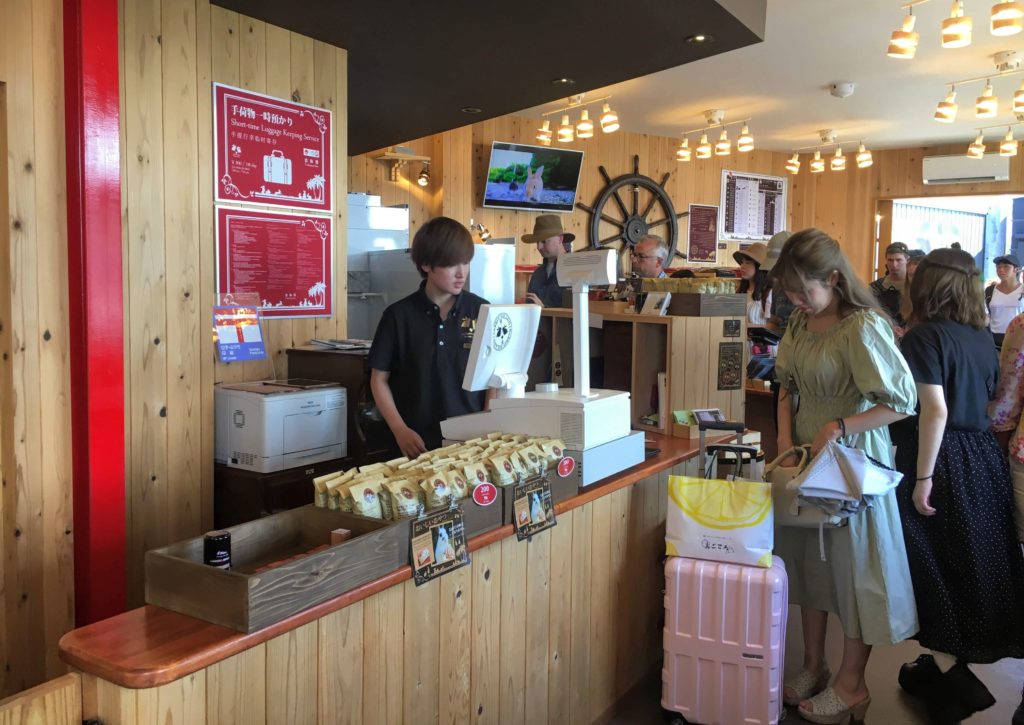
Rabbit Island Accommodation
Want to spend more time in Okunoshima, Japan? There are two options for accommodation on Rabbit Island.
- Stay at the Kyukamura Okunoshima Hotel and Resort , the comfortable option for Rabbit Island accommodation
- Reserve a camp site to stay on the south side of Okunoshima. You’ll be spending a lot of time with the rabbits if you opt for this accommodation on Rabbit Island, because the rabbits LOVE to hang out here where there is free-flowing water and plenty of shade.
Island of Rabbits Map
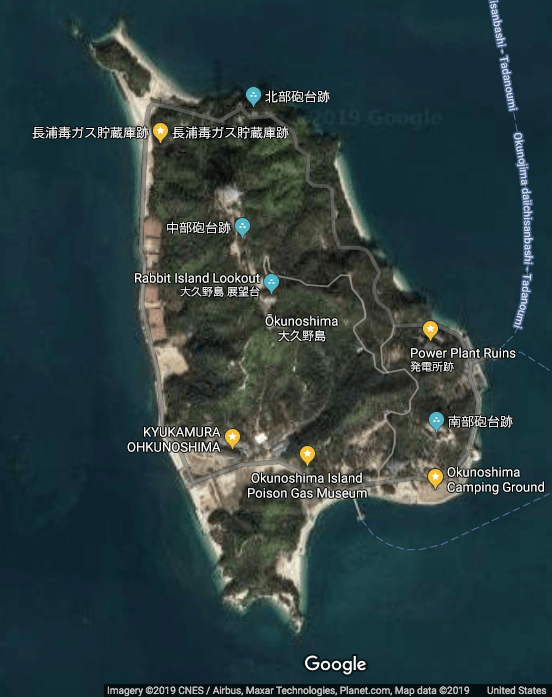
Okunoshima, Japan Ultimate Guide
Rules for visiting japan's island of rabbits:.
Before you reach Rabbit Island, it is reiterated in the ferry ride that rabbits are fragile creatures. There are rules in place to protect them, yourself, and the nature that Okunoshima is famous for.
- Do not feed the rabbits any human food – It is bad for rabbits to eat things like bread and sweets, and not all vegetables are healthy for them either. It’s best to stick to feeding them the little rabbit nibbles that you can buy in bags at the Tadanoumi cafe.
- Do not pick up the rabbits – these rabbits are technically wild creatures, and may panic and injure itself or you if you try to pick them up. When I visited, many rabbits were nervous about me petting their heads and backs, although they would eat happily out of the palm of my hand.
- Do not feed the rabbits that are next to the road – this encourages them to stay where they may get injured. You can bring your car to the island on the larger ferries, so there are a few cars, a shuttle bus, and many bicycles on the roads.
- No littering – it’s best to bring any trash off of the island with you. Try not to put unnecessary pressure on Rabbit Island’s waste disposal services, or risk trash ending up in rabbit stomachs.
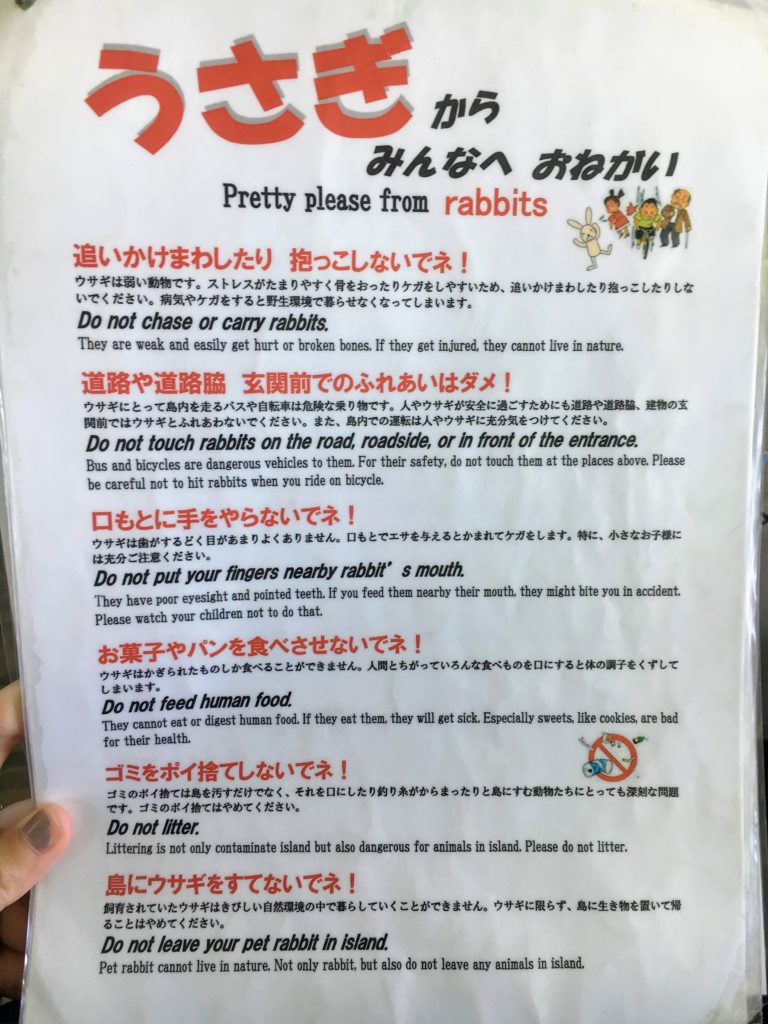
How Much Time to Spend on Rabbit Island?
I spent just under four hours on the Island of Rabbits. I arrived on the 10:00am ferry and left on the 1:50pm ferry back to Tadano-Umi. This was enough time for me to circle the island on foot, see the poison gas ruins, and spend some time feeding rabbits.
If you have less time to spend on Okunoshima, rent a bike to circle the island. Many bikes are available to rent on Okunoshima from the main hotel , rabbit island’s only accommodation. If you want to spend more time here, I recommend bringing a picnic basket and a swimsuit so you can splash around at the beach!
Below are some things to do on the Island of Rabbits, including where to spend your time on the island, and the best places to feed the rabbits.
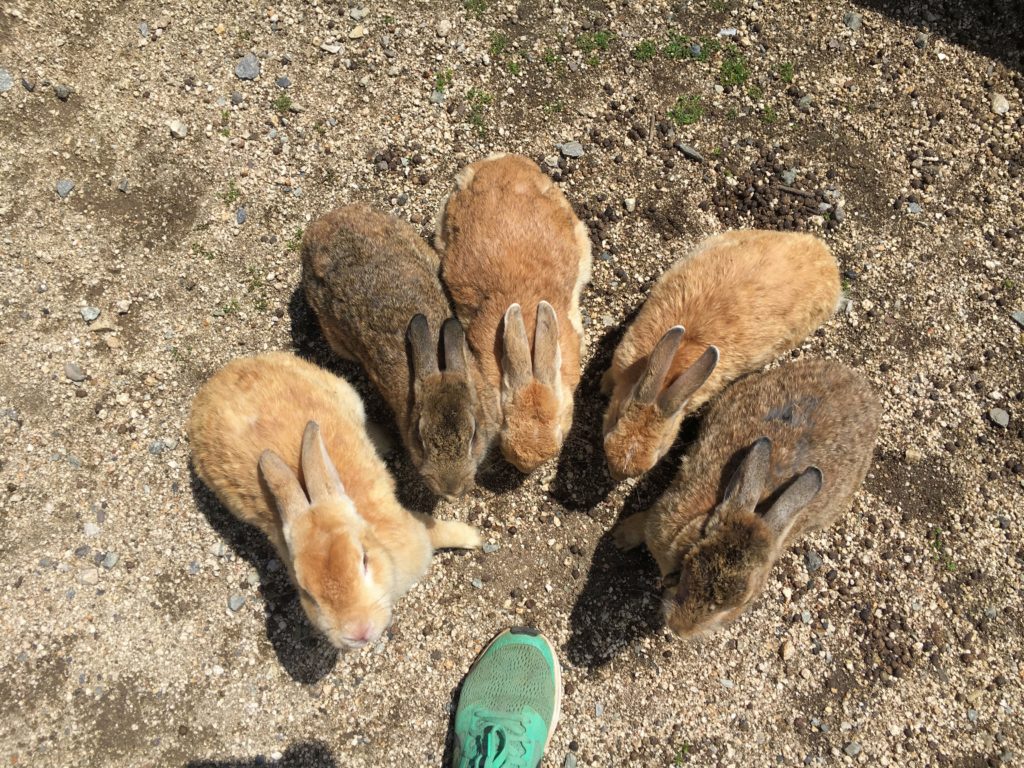
Things to do on the Island of Rabbits
1. go swimming at the beaches or pool.
I had no idea before coming to Rabbit Island that there were nice beaches here, and even a public swimming pool! The locals knew though, and Rabbit Island seemed to be a perfect family destination to spend time in the warm island waters.
The public swimming pool is near to the hotel on Okunoshima. The main beach is also walking distance from the hotel, and is located near Port 1 (see the Rabbit Island map above) and the camping grounds. On the north side of the island, past the tennis courts, is a quieter, more secluded beach with many stone steps leading in to the water.
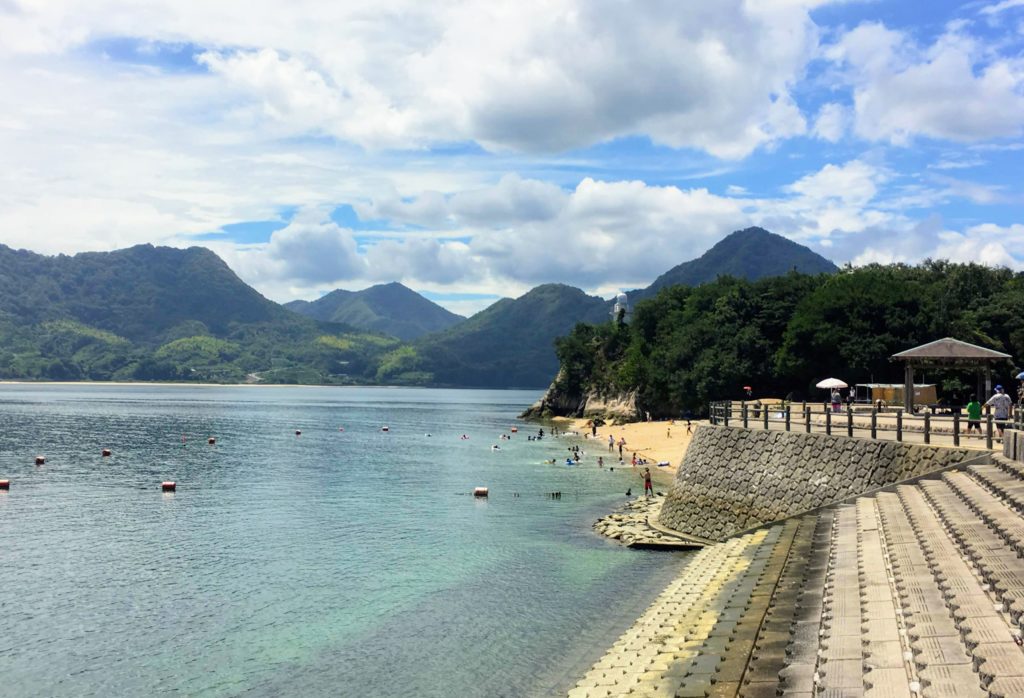
2. Visit the Poison Gas Museum
Okunoshima has a dark history of being home to a poison gas factory. The Japanese Imperial Army went to great lengths to keep Okunoshima hidden, so they could carry out production of poison gas for warfare. The thousands of tons of gas produced here included mustard gas, phosgene, and more.
The poison gas museum is a reminder of the Okunoshima’s dark history in the years leading up to the end of World War II. Inside, you can find artifacts that were used to produce poison gas on Okunoshima, and the clothes that workers wore to handle the gas. Viewer discretion is advised for some of the photographs showing effects of poison gas on the human body.
Most of the small museum is in Japanese, however you can receive and English pamphlet upon paying for entry.
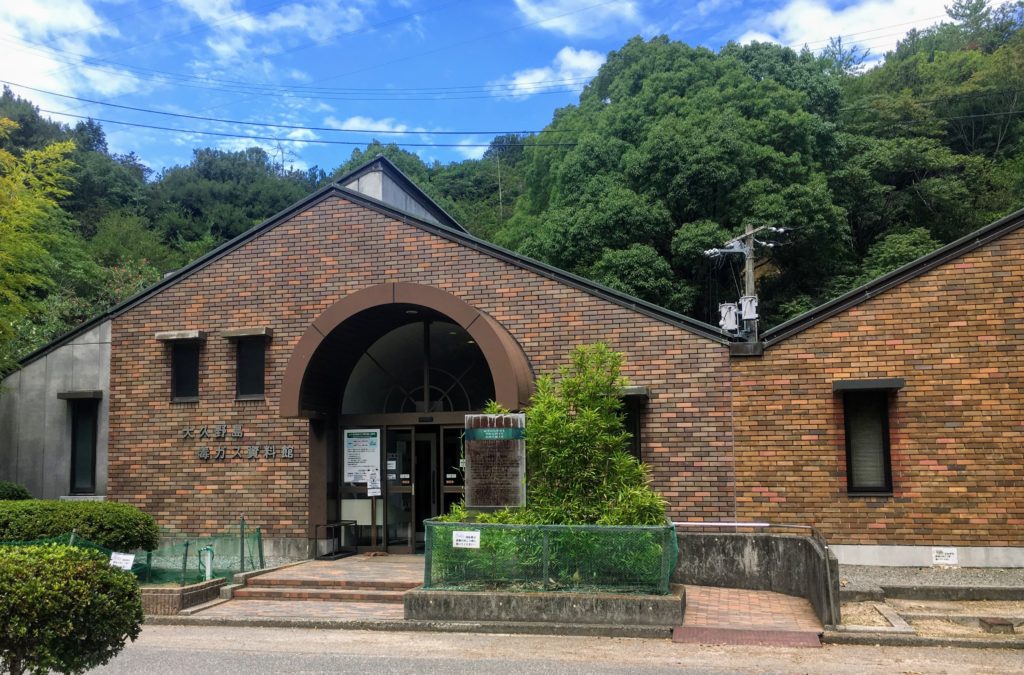
3. Discover Poison Gas Ruins around the Island
After Japan’s surrender in World War II, the poison gas factories, storage buildings, and army posts on Okunoshima were dismantled and abandoned. Today, it is still possible to see the ruins scattered around the island. Grab a map of Okunoshima upon arrival at the main hotel so you know where to find the ruins.
Buildings include a large ivy-covered power plant, many gas storage facilities, army barracks, and more.
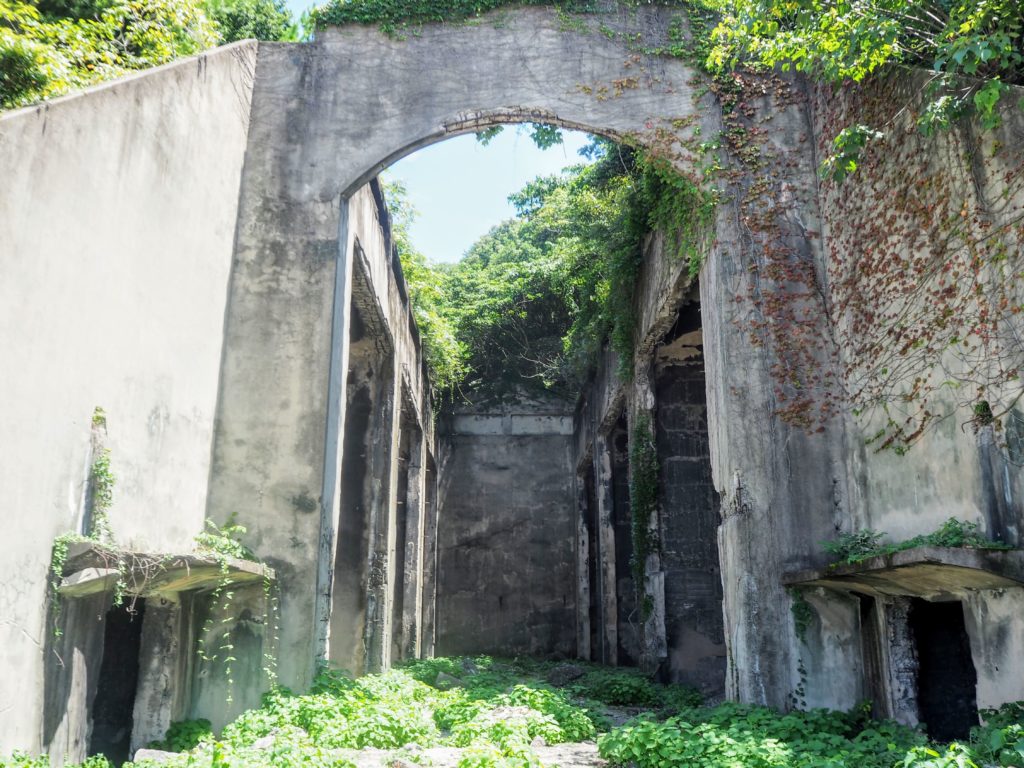
4. Camp During the Day or Overnight
The Island of Rabbits has a large campground area overlooking the water. To use the grounds requires reservations in advance, but you can freely walk around and use the picnic areas.
The lawn that the tents are set up on is soft and flat, and there are many rabbits that hang out in this area too. Facilities include BBQ pits, running water, and a great view over the ocean and neighboring islands. There is an attached parking lot for cars and a public bathhouse you can pay to use.
Reserve your camp spot in advance here .
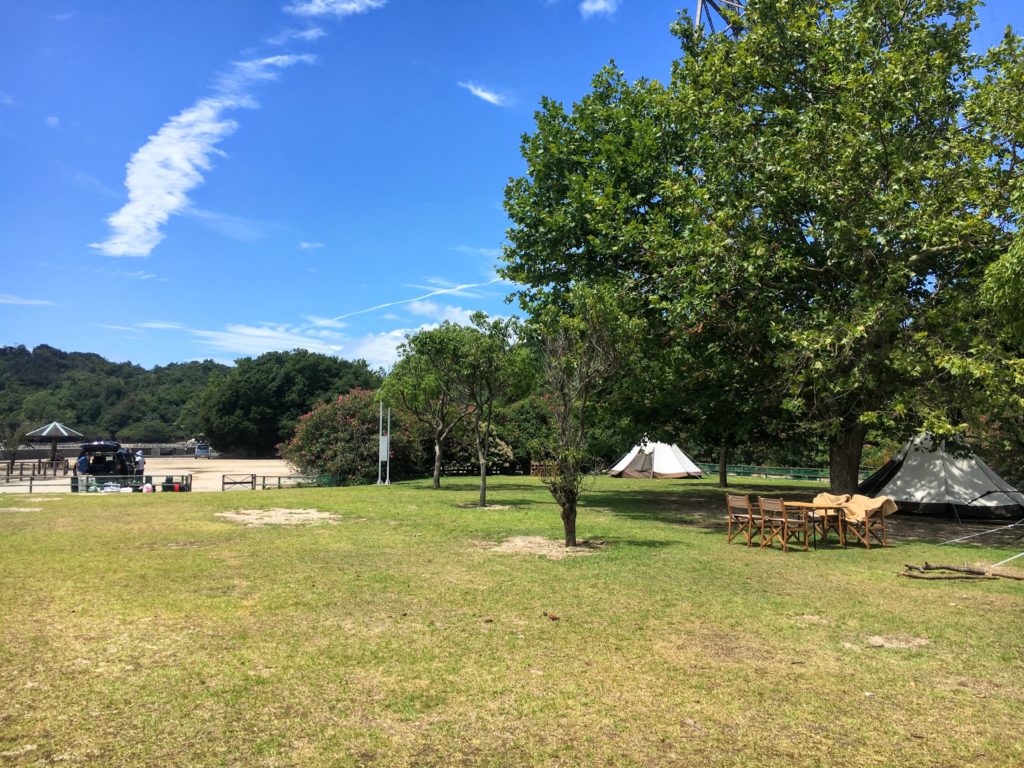
5. Rent a Bicycle to Circle Rabbit Island
There are countless bicycles available for rent from the main hotel for 600-800 yen per day , including kids bikes. If you rent a bike to get around, you could spend as little as 2 hours on the island and see everything.
The road that wraps around the Island of Rabbits is only 4km (see Okunoshima map above), and is wide and safe for bikers. There are some hilly parts that are covered by a tree canopy on the far side of the island. There are a few trails, such as to the lighthouse, that are not accessible by bicycle.
Be sure to watch for rabbits on the road!
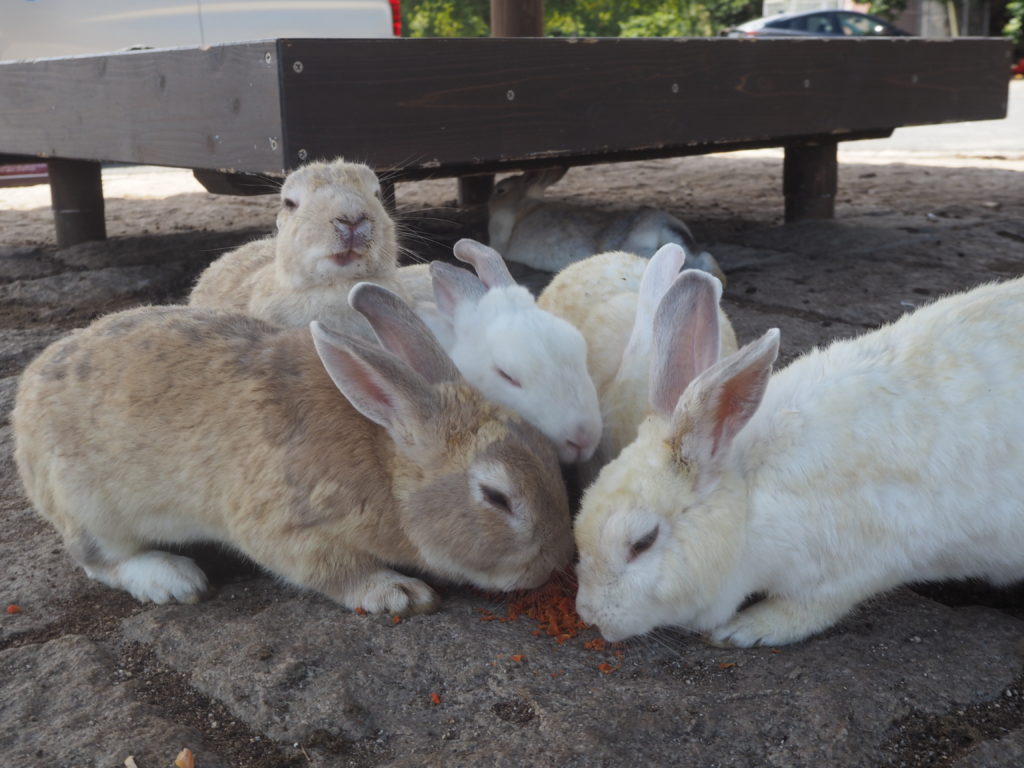
6. Lunch and Shop at the Rabbit Island Hotel
The only place you can get (human) food on Okunoshima is at the main Rabbit Island accommodation, the Kyukamura Okunoshima Hotel and Resort . You can stop by for coffee, ice cream, small finger food, and meals for about ¥900-¥1500 from their cafe, or have a larger meal at their restaurant.
There is also an attached small souvenir shop, where you can buy things like rabbit keychains, stuffed animal rabbits, handkerchiefs, and more. Popular gifts with Japanese visitors include boxes of cookies and sweets with rabbit pictures on them!
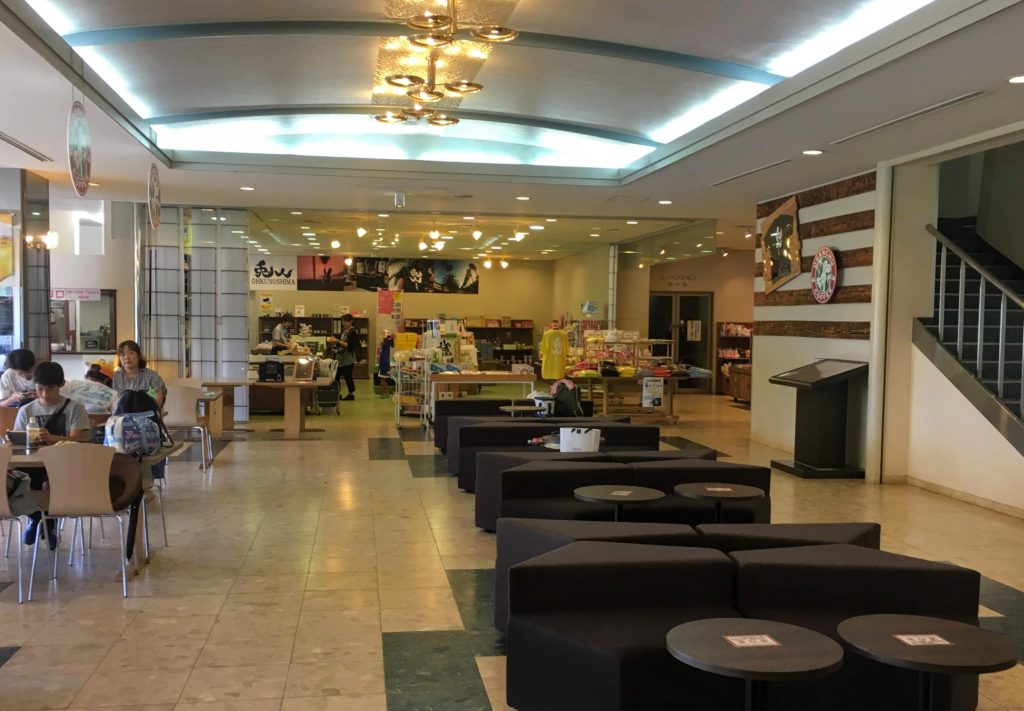
Half-Day Itinerary for the Island of Rabbits in Japan:
10:13 – Arrive to Tadano-Umi station from Mihara Station. Buy rabbit food at the cafe and round-trip ferry tickets for 620 yen.
10:25 – Depart on the ferry to Okunoshima
10:40 – Arrive on Okunoshima. Take the free shuttle bus to the Kyukamura hotel . Grab an Okunoshima map from the hotel. Start walking counter-clockwise around the island.
10:50 – Visit the Poison Gas Museum
11:00 – Circle the island while finding spots to feed rabbits. Examples include the shrine near the beach, and under the wooden walkway at the campground.
12:00 – Discover the many ruins on the north side of the island: Army barracks, poison gas storage buildings, and more.
12:30 – Return to the hotel area and walk the small trails around the lighthouse.
13:00 – Relax at the gift shop and cafe, then take a free shuttle bus or start walking to Port 2.
13:48 – Take the ferry back to Tadano-Umi port and station
- Total Time: 4 hours
- Total Budget: 820 yen (620 for ferry tickets, 200 for one bag of rabbit food)
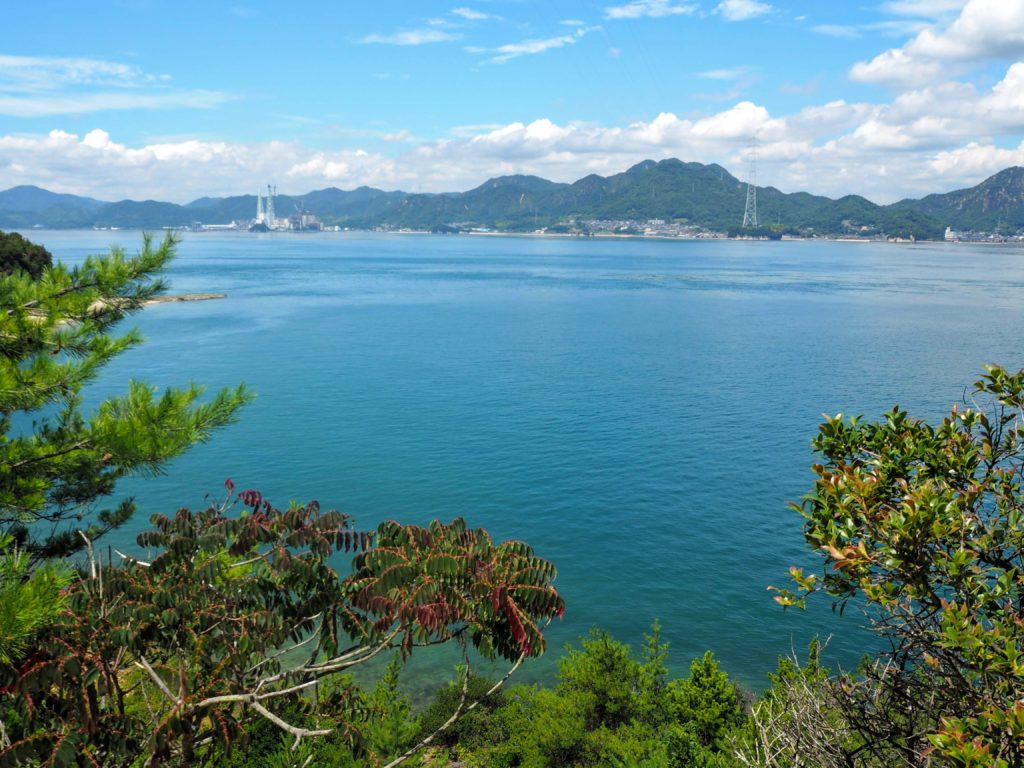
Like this Island of Rabbits Guide? Pin This Post!
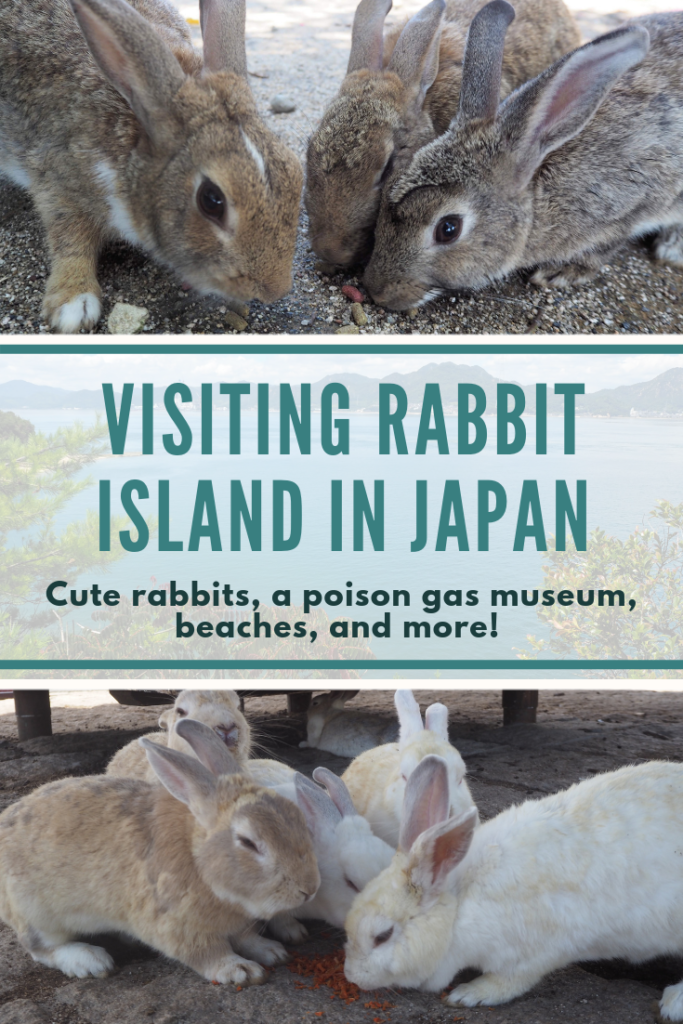
Are You Prepared For Your Trip To Japan?
Be sure to check out my Japan home page for Japan travel information, insider tips, reading list, and must-haves for traveling to Japan!
- Book Your Flights – To find the cheapest flights, flexibility is key. I use both Google Flights for their low fare calendar, and Skiplagged , which uses airfare loopholes to get the lowest prices. For a trip to Japan, check flights to both Tokyo airports (Haneda, Narita) and to Osaka (Kansai).
- Getting Around Japan : Prepare your JR Pass and Suica transit card before you depart.
- Book Your Accommodation – Check out Booking.com for the largest selection of accommodation in Japan. Consider having a bit of fun at one of these Weirdest Hotels in Japan too 🙂
- Book Local Excursions – Don’t miss out on world-class experiences, like Teamlab Planets or Tokyo Disneyland , by booking tickets online now. Check GetYourGuide and Klook for fun experiences all around Japan.
- Stay Connected: Order a pocket WiFi for airport pickup if you’re traveling with family or with a large group. Solo traveling to Japan? Order a SIM card just for you.
- Buy Travel Insurance – It’s better to protect yourself from mishaps when traveling. Get a quote from World Nomads to see how much it’ll cost to get you covered!
- Pack Your Essentials – Check out my posts about Long Term Travel Gear , and Carry-On Luggage Packing Essentials .
- Read more on my Travel Resources page!
You might also like:

Ghibli Museum vs Ghibli Park – Which should you visit?

30 Cute and Kawaii Things to do in Tokyo

25 Cool and Unique Hotels in Tokyo
3 thoughts on “ ultimate guide to okunoshima, the island of rabbits, japan ”.
- Pingback: 8 Gorgeous Beaches In Lebanon That Promise A Refreshing - Tripbbio
This sounds like a fun outing. What a diverse mix of history. The rabbits should be a calming influence for all who go there.
Japan is an absolute dream for me! I heard about fox island, but never about the island of rabbits… only in Japan haha. Loved this article, thank you for sharing ?
Leave a Reply Cancel reply
Your email address will not be published. Required fields are marked *

Hiroshima(09:05 AM)

Okunoshima “Rabbit Island”
It’s not due to the shape of this island that it got the nickname of Rabbit Island, but because it is completely overrun with the cute, fluffy bunnies. There are conflicting accounts as to how the bunny population began, but there are now between 700 and 900 rabbits living wild on the island and they are now Okunoshima’s main attraction.
Where did the bunnies on Rabbit Island come from?
Scroll to the bottom of this page for the Tadanoumi-Okunoshima ferry schedule.
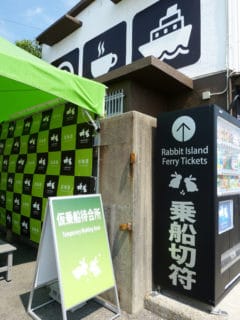
There is a good sized hotel (resort) with hot spring bath, restaurant, pool (in summer) cycle and walking paths, kid-friendly museum and it is also possible to visit the abandoned site of the chemical factory if you are interested. On a visit in late summer of 2016, we wandered around the whole island on foot, feeding bunnies and catching Pokemon along the way (they are pretty good at posing for pictures with the rabbits before you capture them!) #RabbitIslandPokemon
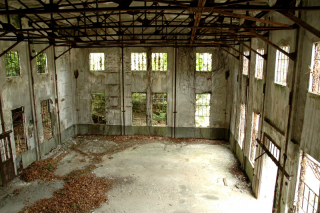
The hotel information, museum staff, tourist information and local government do not mention any remaining problems and advertise the island as completely safe. As more visitors come to the island, we can hope the government is making more effort to maintain visitor safety. This is another reason to enjoy all the healthy bunnies jumping around the island. If you do notice any rabbits that are sick, please make sure to notify any of the staff who work in the hotel or at the port.
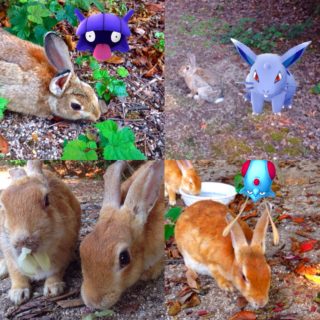
The Kyukamura National Park Resort Okunoshima website has information about walking tours and rentals available on the island as well as hotel rooms, food deals and other services.
This Japan Times article on wartime history of the island by Eric Johnston outlines the history of the chemical making during wartime and poses questions on the current safety of the island. Another interesting piece on the island comes from a traveler writing for Coilhouse . A favorite is this beautifully written review by a travel writer for Metropolis online magazine.
How to get to Rabbit Island:
Okunoshima is a 15 minute ferry ride from Tadanoumi Port (Adult ¥300, Children ¥150 one way) with boats leaving about every half hour 07:45-19:30. The port is a short 5 minute walk from Tadanoumi JR Station which is half way between Takehara and Mihara on the Kure Line (it takes about 2 hours by local train from Hiroshima and costs around ¥1280-¥1500 one way).

Tadanoumi to Okounoshima “Rabbit Island” Ferry Schedule (Updated August 2017)
Okunoshima “rabbit island” to tadanoumi ferry schedule.
Ferries go on to Sakari Port on Omishima Island after calling at Okunoshima. Return ferries originate from Sakari Port on Omishima Island. Additional services my be added on particularly busy days. Ferry schedules do change fairly often so please confirm times on this page (in English via Google Translate here ) or by calling the Sanyo Shosen Tadanoumi office on (0846)22-6199.
- ← Asa Zoo
- Medical Reference →
Writing about Hiroshima for over twenty years. Co-founded GetHiroshima in 1999 and founded the sustainability-focused InboundAmbassador business in 2019. Monthly CleanUp and Seeking Sustainability event organizer, guide workshop facilitator, online content creator and tourism destination consultant. Passionate about promoting solutions in Japan for people and the planet.
You May Also Like
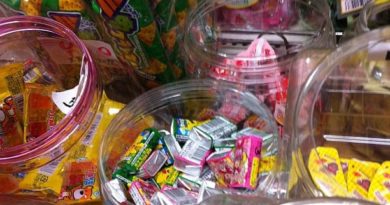
Tanaka Beikokuten

Kanak Indian Izakaya & Dining

Miyajima Aquarium
■ Only 15-minute ferry ride
Official Port Live Cam
Coming to port by vehicle
PLAN YOUR VISIT TO RABBIT ISLAND; THE MYSTERIOUS ENCLAVE OF 1,000 RABBITS OFF THE COAST OF HIROSHIMA, JAPAN.
■L ocated in eastern Hiroshima, Rabbit Island is a small enclave occupied by hundreds of wild rabbits that roam the forests and fields, chasing tourists for food. Only a 15-minute ferry ride from the mainland, the island is a popular destination for tourists from around the world. Rabbits are usually surrounded by their large families and are known for their high fertility rate. For these reasons, rabbits are often considered a symbol of safe childbirth and the blessings of many children. Rabbit Island, the home of over 1,000 rabbits, is known as a place to seek good fortune for your own family's fertility. ■
ITINERARY MAPS
Fastest and most frequent access to rabbit island.
■R abbit Island is a 15-minute ferry ride from Tadanômi Port with services leaving roughly every 30 - 45 minutes. The port is a 3-minute walk from Tadanoumi JR Station, which is a 25-minute train ride from Mihara Station on the magnificent coastal JR Kure Line. This ride itself is worth the trip, with stunning views of the Inland Sea and its many islands. ■ All Kodama Shinkansen Super Express coming from both Hiroshima and Osaka stops at Mihara Station. It takes about 20 minutes from Hiroshima and less than 2 hours from Osaka to reach Mihara Station. ■ The Kaguyahime Highway Bus Service is also available directly to Tadanoumi JR Station, which operates from Hiroshima Bus Center via Hiroshima Station. ■ If you plan to stay overnight, advance hotel reservation is advised as accommodation is limited around the area. The hotel on the island is not always available for last-minute visitors, especially during high seasons. ■ Japan Rail Pass accepted up to Tadanoumi JR Station but not for ferry services. ■ Cash (JPY) only.
Search with Japan Transit Planner
FERRY TIMETABLE
Ferry fares, short-term luggage keeping service.
■ A short-term luggage keeping service is available for your Rabbit Island trip. 500 yen per bag / day. Open during ferry operating hours, 365 days. a year.
FREE PUBLIC WI-FI AVAILABLE
■ Free public Wi-Fi is available at the port. You need to register with an email address.
DO NOT HOLD RABBITS IN YOUR ARMS OR CHASE THEM
■ Rabbits are usually afraid of being held; they will struggle to escape. Living in the wild means they have no access to vets in case of injury, therefore it is crucial they are left alone to minimise the risk of getting hurt. ■
DO NOT FEED RABBITS ON ROADS
■ Roads are busy with bicycles; while eating, rabbits are usually too focused and do not notice incoming traffic. By trying to escape at the last moment, they may run crash into bicycles or even vehicles. ■
DO NOT LEAVE RABBIT FOOD LEFTOVERS
■ Rabbits do not eat dampened pellets or spoiled vegetables. These attract crows which interfere with rabbits. Also, leaving rabbit food near their nest means leaking the whereabouts of baby rabbits to their predators. ■
DO NOT FEED RABBITS WITH HUMAN FOOD
■ Rabbits will become ill by eating our food such as bread or snacks. Also, rabbits cannot digest potatoes. ■
DO NOT RIDE BICYCLES RECKLESSLY
■ While eating food, rabbits are usually too focused. By trying to escape at the last moment, they may run towards you. ■
DO NOT TAKE RABBITS HOME
■ By the Wildlife Protection and Hunting Law, prior permission is needed from the Ministry of Environment to capture wild animals. Also, you may incur expensive treatment fees later on as some rabbits may carry parasites or other diseases. ■
DO NOT TAKE YOUR OWN RABBITS AND ABANDON THEM
■ Rabbits which have been kept as a pet cannot survive on the island. Rabbits are strongly territorial and will get bullied and beaten by local rabbits. ■
DO NOT FORGET TO CHECK UNDER YOUR CAR
■ For rabbits, under the car can be an ideal place to hide from the direct sun and their predators. Please make sure to check under your car as they may stay even after starting the engine. ■
PLEASE REFILL WATER PANS
■ Water is scarce on the island, especially around the hotel. Please refill the water pans around the island wherever possible. Rabbits living up on the hillside can feed off natural springs, however, for those around the hotel these pans are crucial for their survival. ■
PLEASE QUIETLY WATCH OVER THE RABBITS
■ Please quietly watch over the rabbits and DO share your photos online. Let the world know about this mysterious enclave, Rabbit Island !! ■
A DAY TRIP TO THE ISLAND IS FUN ENOUGH, BUT STAYING OVERNIGHT CAN GIVE YOU THE CHANCE TO FULLY EXPLORE THE ISLAND, INCLUDING ITS DARK HISTORY.
■B eing the center of chemical weapons research and production during WWII, Rabbit Island was completely “erased” from the map and workers on the island were sworn to secrecy. With its picturesque scenery of the Inland Sea, the island is now a National Park Resort and welcomes tourists from all around the world. Some say that rabbits were released onto the island after the war to spot signs of poison gas leaks, just as caged birds were dropped down into constructing wells to see carbon dioxide concentrations back in the day. ■
■A free shuttle bus or a 15-minute walk will take you to the National Park Resort Hotel on the island, where there are many rabbits welcoming tourists. Of course, many rabbits can be seen on the way to the hotel, and the sidewalk along the shore is spectacular. ■
THE NATIONAL PARK RESORT HOTEL
■T he only Resort Hotel on the island, where you can dine on local delicacies. A hot spring is available with towels available for visitors to rent. You can also rent a bicycle and fully explore the island using its bicycle track running along the 4km perimeter. ■ ■ For details
Resort Hotel Official Website
THE POISON GAS MUSEUM
■A dorable rabbits and the dark history of the island --- the two antithesis give the island a more mysterious touch. Being the center of chemical weapons research and production until 1945 under complete secrecy, the island now offers a museum which displays and preserves memory of the cruel aspects of Japan's WWII history. Tadanômi Port was extraterritorial during the war, being the only departing port to reach the island. It is said that the thick historical wall besides the ticketing office at Tadanômi Port separated the port from the mainland during WWII. ■
■ Bicycles for rent on the island
■ Rabbit objet d'art
■W ith several different walking trails along the coast and into the mountain, you can enjoy hiking along with other outdoor activities all year around. You can of course swim in the sea during summer seasons. Please note that there is only one restaurant operating on the island along with a coffee shop. Bringing your own food is advised during peak seasons. Plenty of snacks and drinks are sold at the hotel. ■
■ A pondering rabbit
RABBITS GATHERING AT THE BEACH
■ A 5-minute walk away from the hotel is the bathing beach. Shower rooms and snack booths are available during summer seasons. ■
360-DEGREE PANORAMIC OCEAN VIEW
■ The summit of Rabbit Island is well known for its 360-degree panoramic ocean view. The view is one of a kind with small islands constituting layers one after another. You can take the trailhead between the campsite and the visitor center to reach the summit. ■
■ Lighthouse
■ Scenic ocean view from the lighthouse
■ Campsite by the sea
■ With its magnificent ocean view, the campsite can accommodate about 10 groups. ■
■A s rabbits are nocturnal, they are most active during early morning and late in the evening. With overnight stays, you can observe their activities during the night, while fully enjoying the night sky away from artificial lights. In Japan, legend has it that at full moon you can see a figure of a rabbit pounding mochi rice cakes on the surface. ■
■ The hot spring is available at the hotel with towels available for visitors to rent. The water is said to have fatigue-relieving compositions. ■
■ Spending the afternoon reading a book by the beach with rabbits
■ A day on the island
■A n original commemorative rabbit stamp is available at the port. We offer free original postcards to stamp on in exchange for the empty bags of our rabbit food purchased at the port. ■
■S erving as a reference for departing ferry services, a 2-meter rabbit wall clock is installed at the port. The color of the letters change according to the weather, reflecting the colors of the sky. Photos of this clock is popular with travel bloggers and writers. By the way, can you guess why the rabbits are at 4 o'clock? ■ ■ Hint: it relates to the twelve horary signs of time.
RABBIT CAFÉ & GIFT SHOP
■W aiting for the ferry is a bliss with Whipped Ice Cream at ocean view Rabbit Café. We offer takeaway coffee, snacks and lunch boxes. Original rabbit items are available at the port gift shop. Open 7:00 – 19:45 / 365 days a year. ■
■ Tadanômi Port Management 1-2-1, Tadanoumi, Takehara, Hiroshima, 729-2316, Japan Tel. + 81 (0) 846 26 0853 English speakers occasionally available upon request.
RABBIT ISLAND WHIPPED ICE CREAM
■ Matcha / Vanilla / Mixed. No artificial additives within the cream.
RABBIT MUGS
■ Mugs with a rabbit silhouette,“Memories of Rabbit Island” written in French. Made in Japan.
RABBIT TOTE BAGS
■ Rabbit tote bags with a stainless-steel medal curved out in rabbit silhouette.
RABBIT KEY CHAINS
■ Genuine Italian and Japanese leather. Made in Japan.
RABBIT LETTER SETS
■ Original set of postage stamps / envelopes / letter papers. A postbox is available at the port.
RABBIT STICKY NOTES
■ Original sticky notes with a rabbit silhouette.
RABBIT PLASTIC FOLDERS (A5)
■ Gold stamped plastic folders with a rabbit silhouette.
RABBIT CORD CLIPS
■ Genuine Italian and Japanese leather. Made in Japan. Available in four colors.
RABBIT PHOTO ALBUMS
■ Rabbit photo albums from National Geographic Publishing. Comes with an original rabbit postcard.
OCTOPUS KELP ROLLS
■ The area around Rabbit Island is known for its octopus. We dare you to try our local seafood delicacy. It goes well with sake.
TWOSOMETRAVELLERS
Spending a day on Okunoshima bunny island Japan, how to get there and what to expect!
Is any trip to Japan really complete without a trip to bunny island? Hundreds of wild bunnies live on Okunoshima island also known to tourists as Rabbit island , it is very easy to reach if you are travelling to Hiroshima.

This awesome trip is the perfect day trip from Hiroshima (only 2 hours by train) or if you are travelling the other way from Onimichi it’s around 45 mins by train. A visit to Okunoshima rabbit island can even be extended to an overnight trip if desired, they have a hotel bookable on the actual island.
Here is everything you need to know to make a perfect day trip to bunny island including:
How to get to Okunoshima island from Onomichi and Hiroshima
Budget and what you can expect to spend for a day trip
What to expect when you get there
If you prefer to watch a VLOG, you can use this link to watch our entire day on our Youtube channel.
From Onimichi station
Take the JR Sanyo Line to Mihara (12 mins), change here for the JR Kure Line to Tadano-Umi station (25 mins). If you have a JR pass use this. (or will cost around ¥500)

From Hiroshima station
You can take the Shinkansen bullet train to Mihara Station which will take 50 minutes and is the quickest way to get there. Without the Shinkansen, you can take the JR Sanyo line from Hiroshima to Mihara, then change train for the JR Kure line to Tadano-Umi station - t his is slower and will take around 1hr 45 but will be a lot cheaper. Use your JR pass or costs are roughly: Shinkansen - ¥3,610, Local lines - ¥1,340)
From Tadano-Umi station, the ferry terminal Tadano-Umi Port is a 5 min walk away.

Adult ferry cost is ¥310 each way (£2 / $3)
Additional ¥100 if travelling with bicycle
Services depart roughly every 30 - 45 minutes
The cafe across the street from the port is where you can purchase tickets for the ferry to Okunoshima island. Either purchase tickets at the register, or use the ticket vending machine.
TIP ALERT : Don’t forget to purchase rabbit food from the same place you purchase your tickets (we made this mistake!) You are unable to buy rabbit food (¥200 per bag at the port) on Okunoshima island. Please make sure you only feed the bunnies rabbit food.

A short-term luggage keeping service is available for your Rabbit Island trip and costs ¥500 yen per bag / day. It is open during ferry operating hours, 365 days. a year.
Accommodation
It is possible to stay overnight on the island either in the hotel or at the campsite.

You can stay at the Kyukamura Ohkunoshima in a traditional Japanese style room and includes breakfast and dinner. We had lunch here and would recommend a budget of ¥1000 per meal.
The Big Mystery
How did all the bunnies get there in the first place? Well, there are a few theories about this, including a suggestion that they arrived there back in World War II to be used as test subjects, but experts say that all rabbits were euthanized and so this is unlikely.

Another rumour is that a couple brought the bunnies to the island and have since populated. No-one really knows how they got there, its the big mystery.
We recommend to take time to read the rules that are in both Japanese and English around visiting the island, what to do and what not do when it comes to the safety of the rabbits. This is includes appropriate behaviour and food that is fed to the rabbits, the rules can be found both in the shop on the mainland, on the ferry over to the island, and also on the island. This is to continue to protect the island and the rabbits.

Darker history
Okunoshima rabbit island does appear to holder a darker history as it once had an operational poison gas factory. It has now been transformed into a museum serving as a reminder of its darker years back in World War II.

The island takes around an hour to walk around, there are a few beaches to see and stop to take a dip in the sea. The water is surprisingly clearly and incredibly blue! There is a lovely nature walk at the back of the island which has great views of mainland in the distance, the steps take you down to Okunoshima hotel.

Lunch at Okunoshima Hotel
It is possible to have some food and refreshments in the hotel restaurant/cafe that offer light bites and more substantial meals. There is also a souvenir shop, unfortunately you are not able to purchase rabbit food from anywhere on the island, including the hotel, and so will need to purchase prior to arriving the rabbit island if you wish to feed the rabbits.

Total budget on island per person: ¥1,370 / $13 USD
Ferry Tickets - ¥620 return ticket
Rabbit food - ¥200 per bag
Lunch at Okunoshima hotel - ¥550 on average
Train travel - Use JR pass // or varied pending on location travelling from (see details at beginning)
You might also like:
The Ultimate guide to 10 day in Ja pan, full itinerary including accommodation and transport
Japan Travel tips: 17 things to know when planning your trip
How to spend a d ay in Kyoto Japan, a full 24 hour itinerary!
H ow to spend a day trip to Himeji from Kyoto - Himeji Castle
Recent Posts
A Winter Wonderland Escape: Everything you need to know about visiting Lapland (Rovaniemi) Finland
JAPAN TRAVEL TRIPS: 17 Things to know when planning your trip in 2022
The Ultimate guide to 10 days in Japan 2022 - Osaka, Kyoto & more!

The Dark Secrets of Okunoshima, Japan’s Rabbit Island
Updated August 2, 2020
// By Margherita
Have you ever heard of Okunoshima, Japan’s rabbit island? At first glance, it’s one of the most kawaii places we’ve ever seen and an easy day trip from Hiroshima – but it conceals a dark secret.
One of the things I really wanted to do when we went to Japan was visiting Cat Island . If you know me, you’ll know I love cats – the fact that Kuching means ‘cat’ in Malay was reason enough for me to visit Sarawak , and I chase cute cats and kittens anywhere we go, from Cape Town to Jerusalem .
When I started researching the matter I found out that Japan didn’t have one, but ELEVEN cat islands – sadly, none of them was close to where we were heading, and with only three weeks in the country we had to give up on the idea.
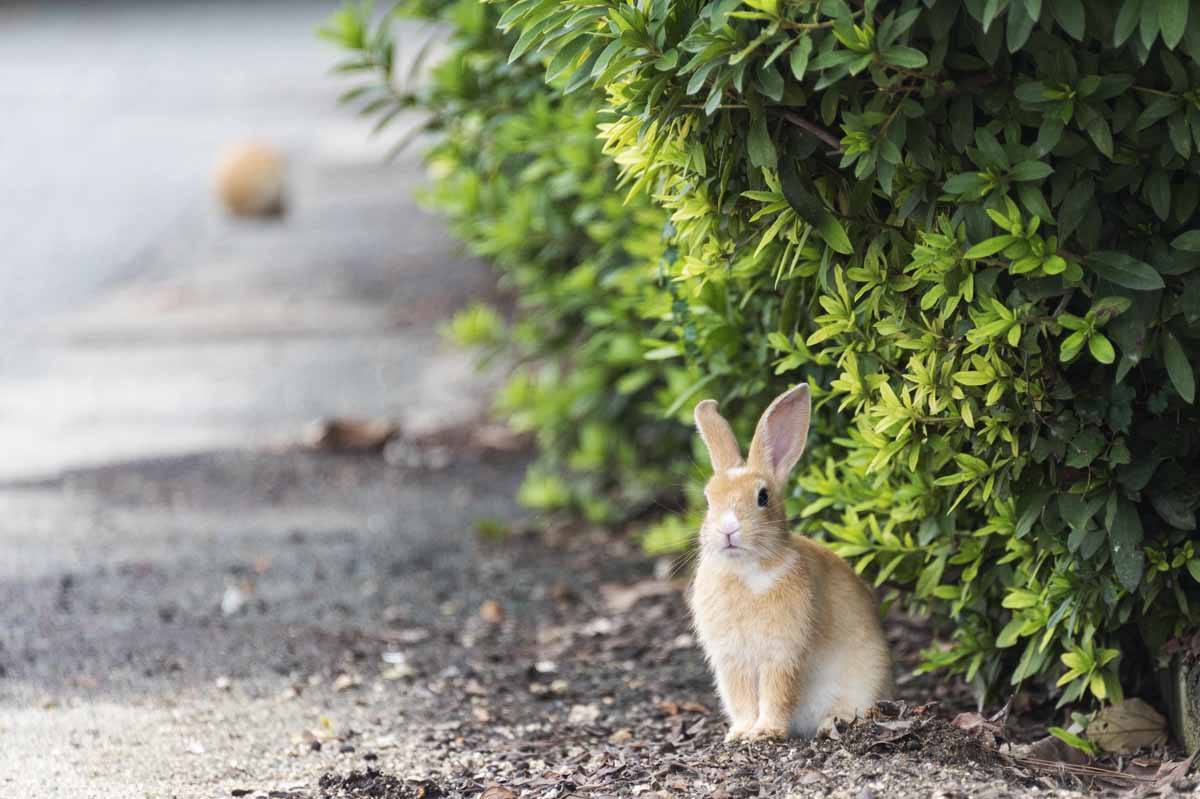
To know more about offbeat places in Japan, have a look at our 2 weeks alternative Japan itinerary!
Visiting Okunoshima aka Rabbit Island
However, we found out that there was another super- kawaii (cute) place – Okunoshima, also known as Usaga Jima , or Rabbit Island , because of the 1000+ cute furry critters that call it home. Okunoshima is about 50 km from Hiroshima , easy to reach with a bullet train and ferry combo and making for a perfect day trip from the city.
The popularity of Okunoshima is hardly a secret , made famous by viral videos of ‘rabbit stampedes’ and articles from major newspapers – but when we got off the ferry and set foot onto the island, there were only another dozen or so people. It was a rainy day in late September, with mist and low clouds hanging over the Inland Sea, hiding the island from sight until we had it right in front of us.
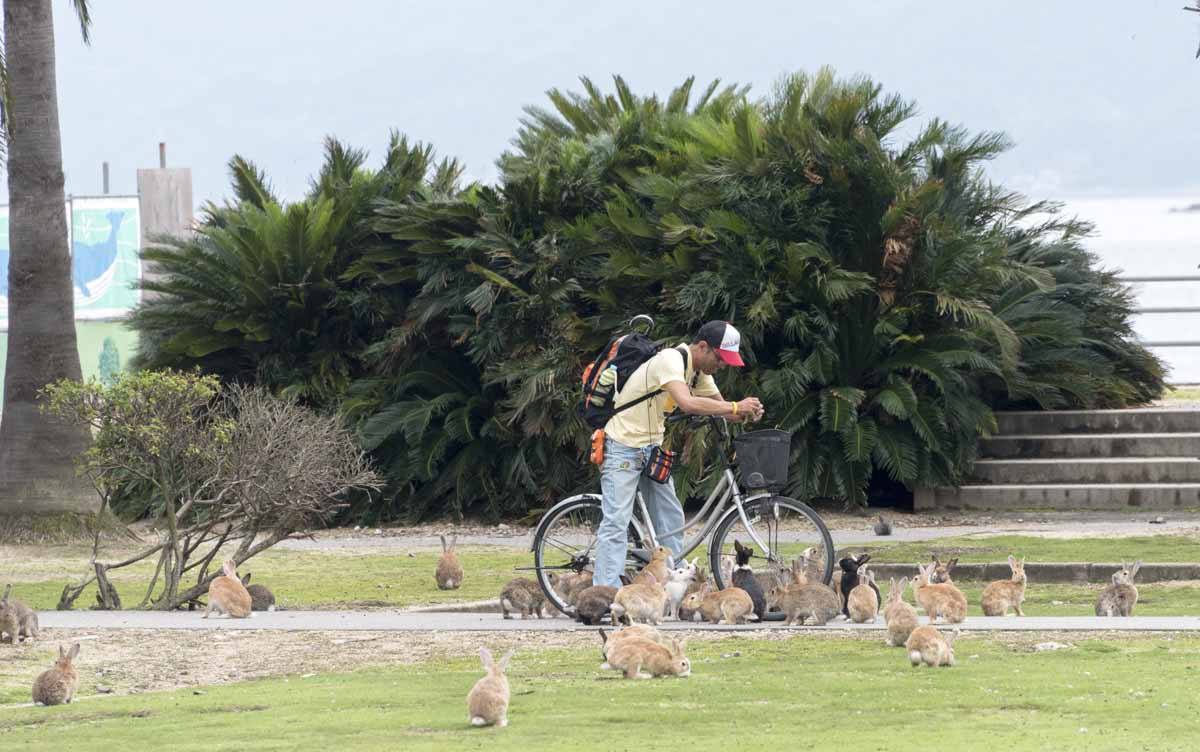
Soon, we were surrounded by bouncing bunnies of all different shapes and sizes – babies looking like cotton fluff, black rabbits, orange rabbits, rabbits with mottled brindle fur, even some huge alpha rabbits bearing battle scars. A furry, bobbing crowd hounding visitors for treats – and losing interest as soon as they realised you didn’t have any.
The Poison Gas Factory, the dark side of Okunoshima
Yet, Okunoshima is not just cute – it’s a dark and mysterious place , with a history shrouded in secrecy. If you looked at at a map of the Inland Sea prior to 1945, there would be no trace of the island. Okunoshima was a top-secret military location , housing a poison gas factory that produced chemical weapons.
Production of poison gas on what is now Rabbit Island started in 1929 and continued until the end of the war. The main agents produced were yperite (mustard gas) and lewisite , causing blistering to the skin and lungs after exposure. Not many people were aware of the existence of the Okunoshima poison gas factory while it was still functioning, besides factory workers and upper military echelons.
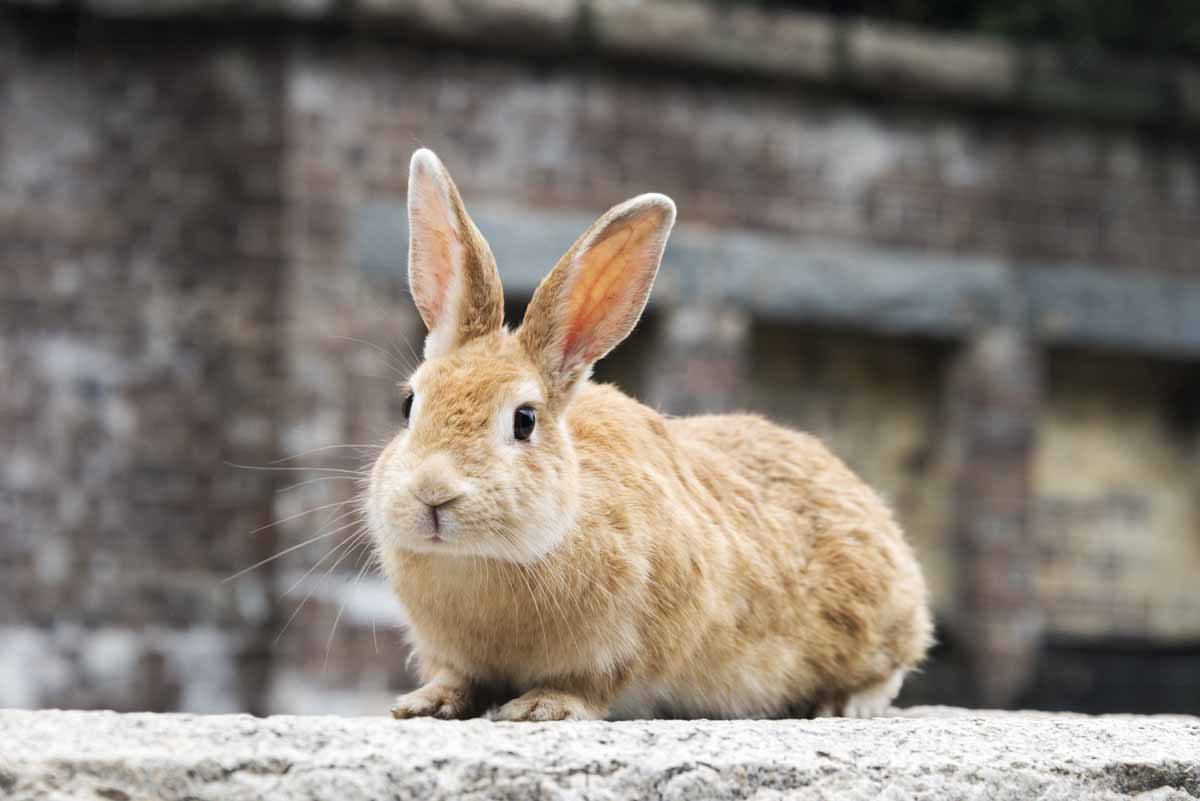
Japan was one of the signatories of the 1925 Geneva Protocol, banning the use of chemical and biological weapons. Yet, it was estimated that over 80,000 people, mainly civilians, died during the Japanese occupation of China from poison gas produced on Okunoshima.
Not many people are aware of Okunoshima’s dark secrets nowadays – remnants of the poison gas factory still stand, amid the bouncing bunnies and bucolic scenery of Okunoshima, but they’re largely ignored by day trippers. Most people visit Okunoshima for the rabbits, to get that kawaii overdose that is the perfect antidote to the harsh reality of working in Japan – as we saw during our otaku tour of Akihabara.

As the day went on and the weather improved, more people descended from the ferry – not just children and tourists, but also lone middle-aged men and women, all clutching a transparent plastic umbrella and bag of rabbit food.
Yet, we were the only ones visiting the Okunoshima museum , opened in 1988 to share the horrors of what happened on the island. The museum is small and mostly aimed at Japanese visitors – but you don’t need to speak Japanese to see the horrific pictures of poison gas victims, exhibited in one of the two rooms of the museum.
Hiroshima and Okunoshima
Visiting the Okunoshima Poison Gas factory was even more meaningful considering that the day before we had joined crowds of tourists and Japanese schoolchildren visiting the huge Hiroshima Peace Memorial Museum , detailing the apocalyptic effects of the atomic bomb that hit Hiroshima on Aug 6th, 1945. About half a million visitors cross the doors of the Hiroshima museum every year, and barely 50,000 make it to Okunoshima.
Yet, in the words of Hatsuichi Murakami , the former curator of the Okunoshima Museum who worked in the poison gas factory as a teenager, ‘if you ask why America dropped the atomic bomb, Japan should also ask why it made chemical weapons at Okunoshima’.
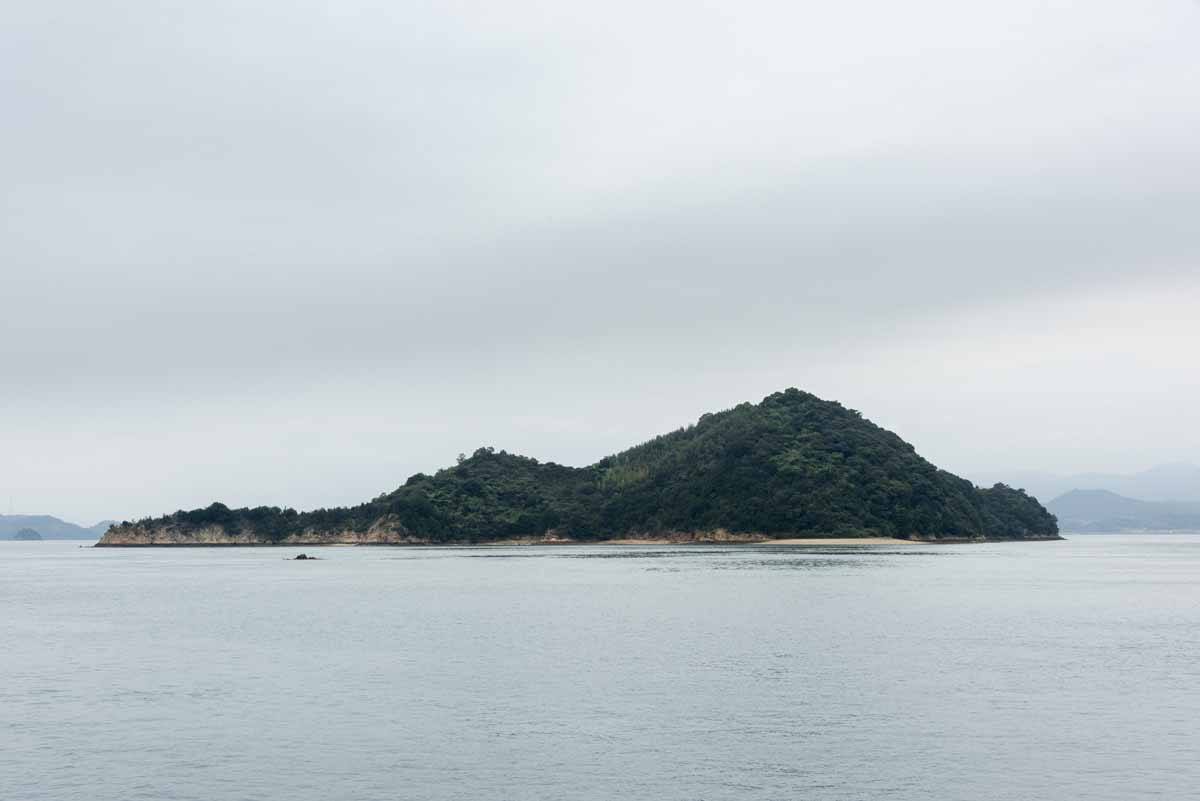
Much has been written about Japan’s victim consciousness – war remembrance in Japan seems to turn victims into heroes, focusing on atomic bomb remembrance but neglecting to acknowledge the horrors perpetrated by the Japanese during the war.
The Okunoshima Museum confirms and denies this at the same time . On one hand, the museum is small and rarely visited – with only a fraction of those coming for the bunnies actually paying a visit. On the other hand, there is a museum, and the effects of poison gas are portrayed in a raw, eye-opening way.
Once again, Mr. Murakami explained that very eloquently. ‘My hope is that people will see the museum in Hiroshima City and also this one, so they will learn that we were both victims and aggressors in the war. I hope people will realise both facets and recognise the importance of peace.’
So, How did Okunoshima Become Rabbit Island?
When the poison gas factory was in function, rabbits were used to test the effects of poison gas. Some have claimed that the rabbits now roaming Okunoshima are the descendants of the same test rabbits, freed by workers when the end of the war was approaching.
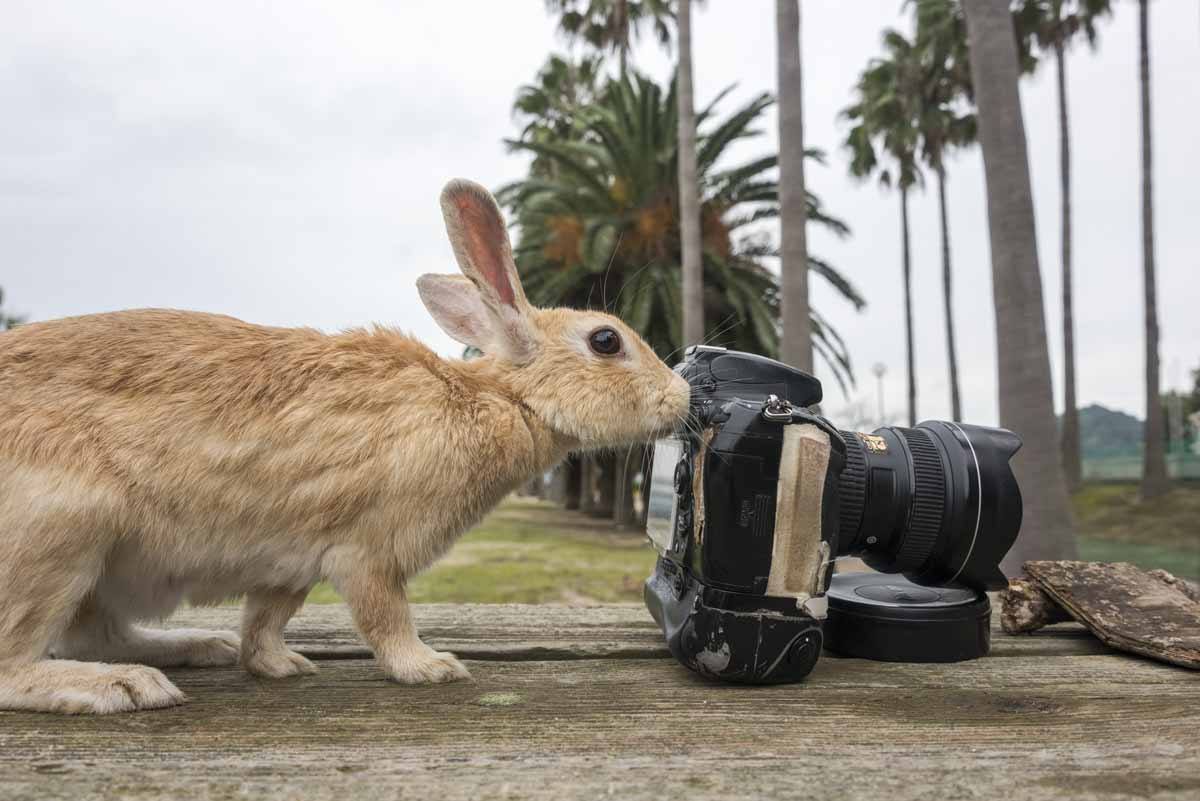
In fact, it is more likely that all rabbits were euthanised by US soldiers when the factory was dismantled after Japanese capitulation. A new rabbit colony was brought onto the island in 1971 by a group of schoolchildren – they bred and thrived, as the island was completely predator-free. Were the rabbits taken to Okunoshima as a way to exorcise what the island meant in the collective memory, using ‘cute’ to escape horror? No one knows for sure.
Nowadays, the rabbit population exceeds a thousand , even though the exact numbers are unknown. Ever since the island gained popularity, and tourists started visiting in increasing numbers, bearing food and treats from the mainland, the rabbit population has been growing at an unsustainable rate.

Researchers that spoke with takepart.com have reported that the ‘rabbit boom’ on Okunoshima as a result of viral articles and videos may actually damage the rabbits. The situation is complicated – on one hand, it’s impossible for the rabbits to fend for themselves. Okunoshima is still severely polluted – so much so that visitors are warned not to stray from official paths – and there isn’t enough food and space for so many rabbits on an island that is only two square miles.
However, instead of purchasing rabbit food, many tourists bring cabbage or vegetable peelings causing potentially deadly bloating. Moreover, reliance on tourists for food means that rabbits end up gorging themselves on sunny days when lots of people visit the island, and virtually starve when it’s cold and rainy and no-one visits. As a result, the lifespan of rabbits on Okunoshima island is only two years , while usually wild rabbits live between three and five years.
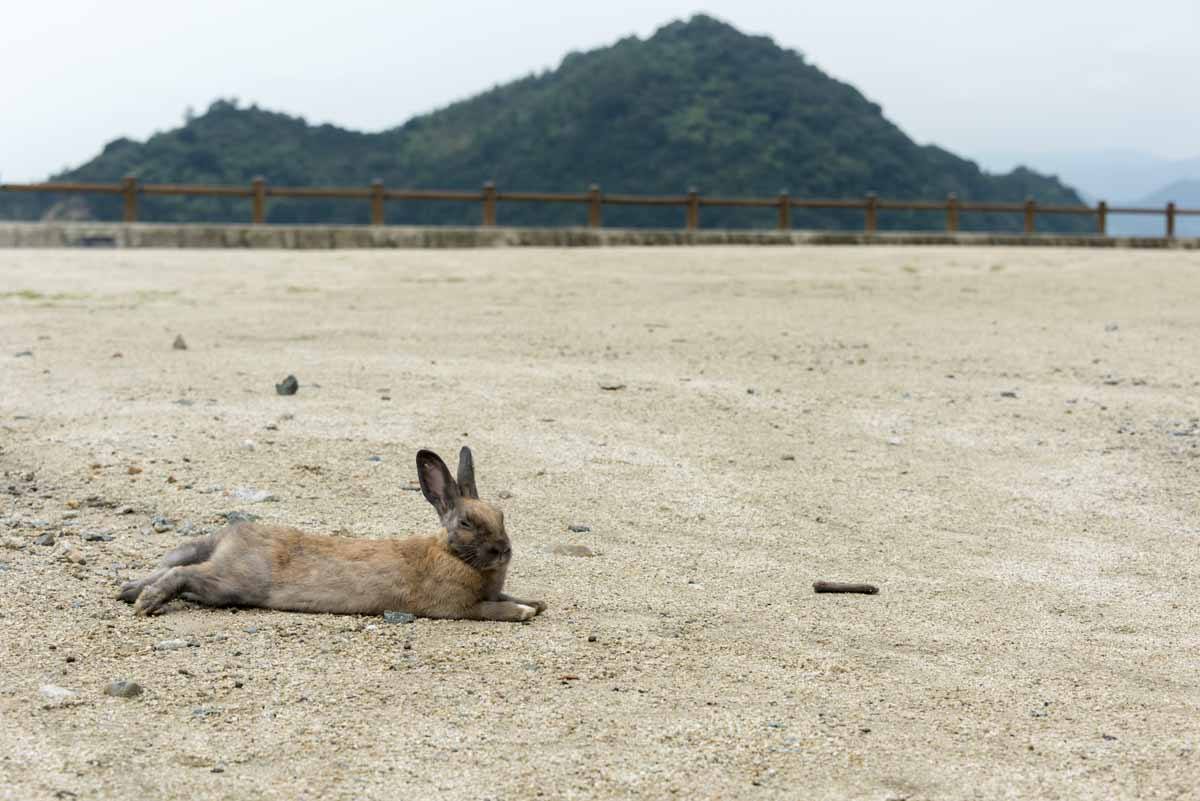
Visit Okunoshima Responsibly
Yet, the survival of Okunoshima rabbits relies on tourists. The rabbits are classified as wild animals, and no one feeds them when tourists don’t come. Yet, if the government caught wind that the increase in visitors is harming the rabbits, access to the island would be restricted and hundreds of rabbits will no doubt die.
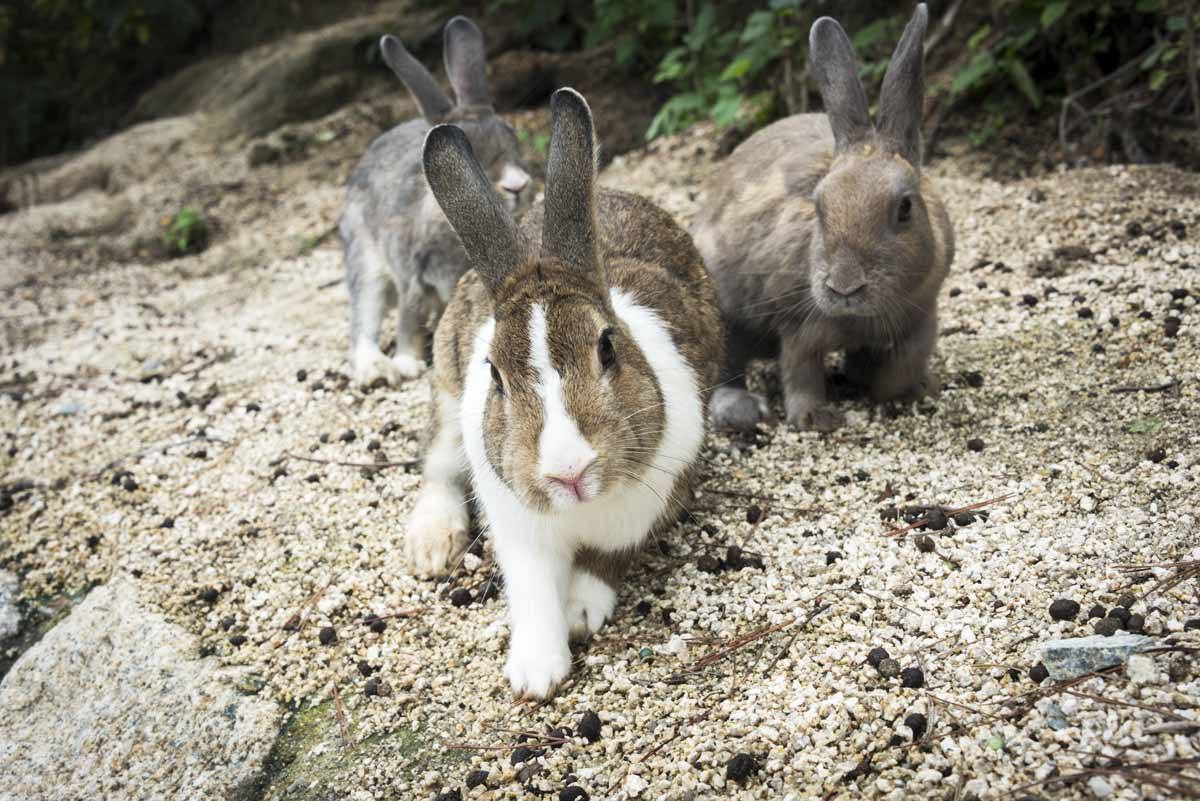
So, do we recommend visiting the Rabbit Island? Yes. It’s a fascinating place, both because of the kawaii rabbits (I don’t think anyone can deny that), and because of the island’s dark wartime secrets . Yet, please don’t visit the island carrying cheap, unsuitable food, in the hope to get a rabbit selfie or a ‘smothered by rabbits’ photo. Instead, stock up with rabbit food on the mainland (remember, it’s not sold on the island) and wander around – don’t just feed the rabbits gathering around the ferry landing or near the hotel.
Take time to learn about the place, about its history and contradictions, and do your part to take care of its cute inhabitants, that make Okunoshima the rabbit island such a special, unique place.
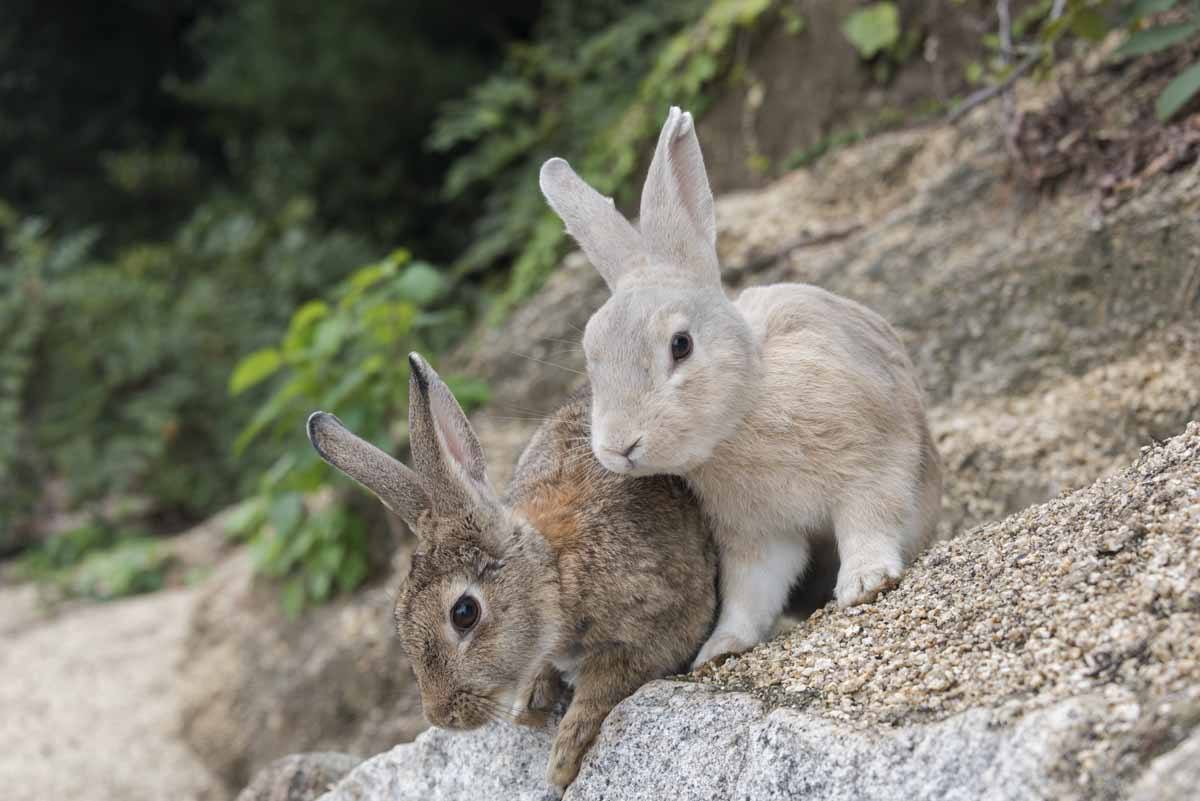
Okunoshima/Rabbit Island FAQ & Practical Info
Getting to okunoshima/rabbit island from hiroshima.
Getting to Okunoshima from Hiroshima is reasonably straightforward and absolutely doable as a day trip. Just follow this step by step guide:
- Take the Shinkansen from Hiroshima to Mihara station . Travel time is about 25 minutes.
- In Mihara, change for the Kure line to Tadanoumi , taking a further 25 minutes. There are wonderful views over the Inland Sea from the left-hand side of the train.
- Check train timetables on Hyperdia.
- The train journey is covered by the JR pass if you have one.
- Once you get to Tadanoumi, the ferry terminal is just a short walk away – you can get tickets and rabbit food there.
- This is the ferry timetable – the table on the left includes the time leaving Okunoshima Island, 大久野発, and the table on the right is for departure times from Tadanoumi, 忠海着, to Okunoshima.
- Round trip ferry fares are ¥320 for adults, ¥160 for children.
Getting to Okunoshima/Rabbit Island from Mihara
After our visit in 2016, a new direct ferry service called ‘The Rabbit Line’ from Okunoshima to Mihara was introduced during weekends and public holidays, saving visitors the hassle of changing to the local train from Mihara to Tadanoumi.
There are five daily departures each way , and tickets cost ¥1500 each way, and ¥2400 return. Travel time is about 30 minutes. You can get more info on prices and timetables on the Rabbit Line English page !
Getting to Okunoshima/Rabbit Island from Osaka
From Osaka, there’s a 6.59 Shinkansen departure, reaching Mihara at 8.55. From there, you can hop on the 9.30 departure of the Rabbit Line ferry if you’re visiting during the weekend, or make your way to Tadanoumi and catch one of the ferries from there – there’s a local train at 9.47, reaching Tadanoumi in 22 minutes, in time for the 10.25 ferry.
To get back to Osaka in time for dinner, hop on the 14.25 ferry to Tadanoumi, and catch the 15.16 train to Mihara, where you’ll change to the Shinkansen via Okayama or Fukuyama. Always refer to Hyperdia as timetables change regularly!
Getting to Okunoshima/Rabbit Island from Kyoto
From Kyoto, hop on the 7.20 Shinkansen train reaching Mihara at 9.39, then either catch the ferry or make a dash for the Tadadoumi local train as explained above.
To get back, the 15.16 local train is also the best bet – after catching the Shinkansen connection in Mihara, you’ll reach Kyoto around 18.
Getting to Okunoshima from Tokyo
Tokyo is really way too far to visit Okunoshima as a day trip. It is doable if you’re willing to fork out for a Nozomi train, which cost about €200 each way and is not included in the JR Pass, but really… why would you? Break up your journey in Kyoto or Osaka instead and continue your trip to Japan’s Rabbit Island from there!
Where Can I Buy Rabbit Food?
Remember, you cannot buy rabbit food on the island, you’ll have to get it in Tadanoumi before you board the ferry. Food is sold in paper bags that cost ¥100 each – don’t forget that fruit and veggies may not be suitable for the rabbits, so please make sure you only feed them rabbit food.
How Much Does it Cost to Visit Okunoshima?
There is no entrance fee to visit Rabbit Island. The only costs are the ferry ticket, rabbit food (of you want to buy some) and ¥100 ticket for the poison gas museum.
Are there Hotels in Okunoshima?
There’s one hotel in Okunoshima if you miss the last ferry or just want to explore further.
Are there Restaurants in Okunoshima?
There only restaurant in Okunoshima is located inside the hotel, and there’s also a small convenience store inside. Alternatively, you can stock up with food and snacks at Tadanoumi – there’s a FamilyMart right next to the ferry terminal.
Pin it for later?
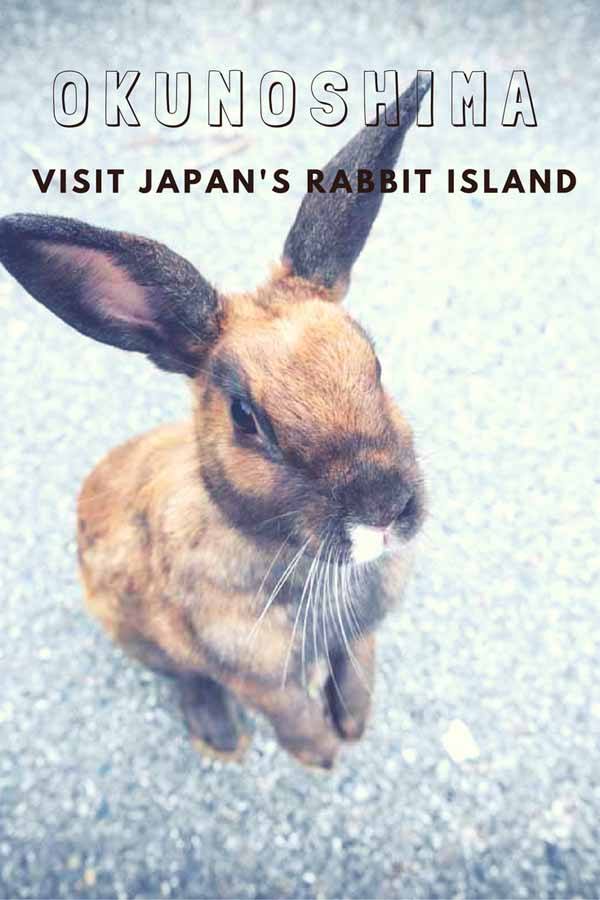
2 thoughts on “The Dark Secrets of Okunoshima, Japan’s Rabbit Island”
Wonderful blog and great information about visiting Rabbit Island! I just went there this week and had a lovely time meeting the rabbits and exploring the island’s dark past (abandoned buildings). I find the history incredibly fascinating as well as sad. Thanks for all the great information! I hope you don’t mind but I linked your blog on my own about Rabbit Island.
Tam @ http://freshcoffeestains.com/rabbit-island/
Thank you so much Tam and thanks for the link! Heading to check out your blog post right now 🙂
Comments are closed.
- Tours & Experiences
- Tailor-made Trips
- Bahasa Indonesia
We are happy to see you again!
Continue with
Or use email.
No Account? Create one
Create account
Already have an account? Sign in
Quickly Sign up with
I agree to Japan Travel's Terms of Service and Privacy Policy . Terms of--> and acknowledge that Japan Travel's Privacy--> applies to me.-->
Email reset password link
Please check your inbox and click the link we will send to you.
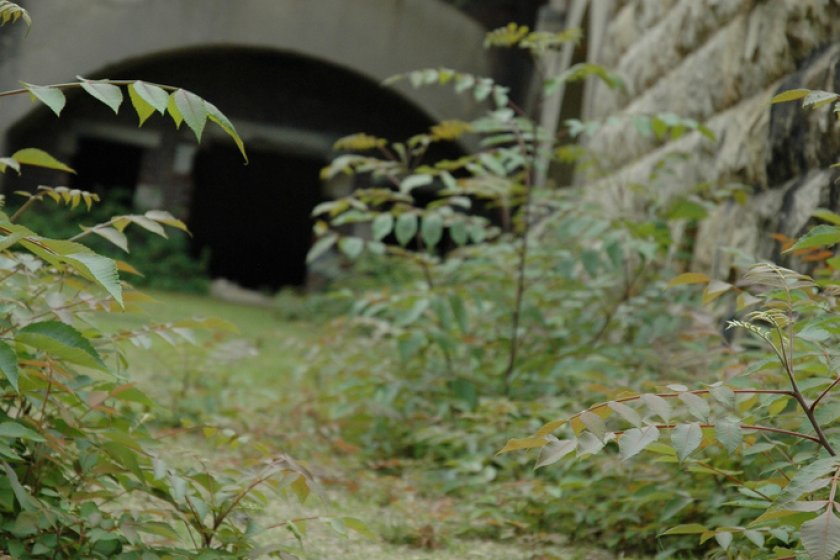
Okunoshima "Rabbit Island"
Great family fun- easy walks, activities & bunnies

It's not due to the shape of this island that it got the nickname of "rabbit island" but because it is completely overrun with the cute, fluffy bunnies. The reason for the healthy population dates back to WWII when the island was used to produce chemicals to be used in combat like poison gas. The rabbits were brought to the island to test the effects of the poison, but once the war ended they were freed by the workers. The rabbits you now see around the island may be many generations down the line from these test bunnies. Some reports say the bunnies are descendants of rabbits released by elementary school kids- maybe the truth is a combination of both stories. Regardless, the presence of the rabbits has created a popular attraction to the island.
Located about an hour's drive past Kure from Hiroshima city is the island of Okunoshima. The island is now a popular day-trip destination or weekend or holiday vacation spot. There is a good sized hotel (resort) with hot spring bath, restaurant, pool (in summer) cycle and walking paths, kid-friendly museum and it is also possible to visit the abandoned site of the chemical factory if you are interested.
Despite the beautiful, family-friendly view of the island and its surroundings. The island's wartime history was quite different. For the 16 years it was operating, the island was kept off maps and residents told to keep its poison gas factories secret. According to this Japan Times article , the island produced 5 types of chemical gas which was mostly used in warfare in China. While working at the factory, many workers (including children) also died during manufacturing. Some argue the island might not be completely safe as there has never been any major decontamination of the whole island and there are apparently some sealed locations remaining which may have poison stored at the end of the war. So, perhaps best to stay on the official walkways and paths on the island. The hotel, museum staff, tourist information and local government do not mention any remaining problems and advertise the island as completely safe. I guess this is another reason to enjoy all the healthy bunnies jumping around the island.
Walking around the lush island enjoying the beautiful Seto inland sea views is a day you will enjoy. There is a family friendly nature museum full of fun activities for the kids. There is also a more serious poison gas history museum full of facts, details and wartime relics (unfortunately very little is written in English).
The main Okunoshima resort is a good resource while on the island. The lobby has a restaurant, cafe, small shop with snacks and souvenirs and the front desk can arrange a variety of activities on the island to enjoy from walking trails to sports.
Pellets of rabbit food are sold in the hotel lobby, although we found the rabbits preferred cabbage leaves and carrots which we had brought from home. It was fun for all of us to feed the fluffy little bunnies, not annoying like the deer on Miyajima island that are only cute until you have food in your hand. They seem very well fed and protected by the residents and visitors to the island.
The National Park Resort Okunoshima 'resort' hotel website (japanese) has information about walk tours and rentals available on the island as well as hotel rooms, food deals and other services.
This Japan Times article on wartime history of the island by Eric Johnston outlines the history of the chemical making during wartime and poses questions on the current safety of the island. Another interesting piece on the island comes from a traveler writing for Coilhouse . A favorite is a beautifully written travel review by a travel writer for Metropolis online magazine.
- Share on Facebook
- Share on Twitter
- Copy link to share
By JJ Walsh
Community writer

Information
Hiroshima ken, Takehara city Tadanoumi Okunoshima ( Directions )
0846-26-0321
rabbit-island.info
Book your trip
Find a nearby hotel, explore nearby.

Okunoshima: Rabbit Island!
By Andrea Kahlow

Visiting the Rabbits of Okunoshima
By Anne Lauenroth

Omishima Island

Omishima Art Museum
Top articles.
- Recommended

Guide to Golden Week

2024 Grand Sumo Tournaments

Haneda Airport Ranked World's Cleanest

Tokyo Takes 2nd Place on Top Coffee Cities List

Kurobe Unazuki Canyon Route to Link with Tateyama Kurobe Alpine Route

Tokyo One of the World's Most Walkable Cities

Mount Omuro

Valley of Witches: a New Ghibli Park Attraction

Sapporo Beer Opens New Brewery in Tokyo’s Ebisu

Guide to Bringing Medicines Into Japan

Your Name: Real-Life Locations in Tokyo

Hachiko Statue in Shibuya

Iwatayama Monkey Park

Shibuya Crossing

Daikoku Car Meet

Kanamara Penis Festival

Guide to Suica Cards

Japanese Urban Legends

Guide to PASMO Cards
More from this category.

Gunma Top 10: Attractions & Things..
By Serena Ogawa

Nishiyama Park and Red Pandas..
By Geoff Day

A Walk Along Kamo River
By Erika Arceo

Adachi Fireworks
By Michael Groen
Leave a comment
Let us know how we can help.
Help us improve JapanTravel.com
We welcome any suggestions regarding this content. Your feedback is confidential and will be used to help improve this page.
Suggest an edit
https://en.japantravel.com/hiroshima/okunoshima-rabbit-island/1269
Thank you for your support!
Your feedback has been sent.
- Media & Industry
- Meetings & Events
- Select Language 简体中文 繁體中文(香港) 繁體中文(臺灣) India (English) Bahasa Indonesia 한국어 ภาษาไทย Tiếng Việt Singapore (English) Philippines (English) Malaysia (English) Australia/New Zealand (English) Français Deutsch Italiano Español United Kingdom (English) Nordic countries(English) Canada (English) Canada (Français) United States (English) Mexico (español) Português العربية Japan(日本語) Global (English)
- India (English)
- Bahasa Indonesia
- Singapore (English)
- Philippines (English)
- Malaysia (English)
- Australia/New Zealand (English)
- United Kingdom (English)
- Nordic countries(English)
- Canada (English)
- Canada (Français)
- United States (English)
- Mexico (español)
- Global (English)
- Fujiyoshida
- Shimonoseki
- Ishigaki Island
- Miyako Island
- Kerama Island
- Tokyo Island
- Koka & Shigaraki
- Hida Takayama
- Ginza, Nihonbashi
- Beppu & Yufuin (Onsen)
- Ginzan Onsen
- Nagasaki Islands

- Kumano Kodo
- Shikoku Karst
- Amami Oshima
- Hachimantai
- Omihachiman
- Aizuwakamatsu

- Diving in Japan
- Skiing in Japan
- Seasonal Flowers in Japan
- Sustainable Outdoors
- Off the Beaten Track in Japan
- Scenic Spots
- World Heritage
- Home Stays & Farm Stays

- Japanese Gardens
- Japanese Crafts
- Temple Stays
- Heritage Stays
- Festivals and Events
- Theater in Japan
- Japanese Tea Ceremony
- Cultural Experiences in Japan
- Culture in Japan

- Local Cuisine Eastern Japan
- Local Cuisine Western Japan
- Local Street Food
- Japan's Local Ekiben
- Japanese Whisky
- Vegetarian and Vegan Guide
- Sushi in Japan Guide
- Japanese Sake Breweries

- Art Museums
- Architecture
- Performing Arts
- Art Festivals
- Japanese Anime and Comics
- Japanese Ceramics
- Local Crafts

- Scenic Night Views
- Natural Wonders
- Theme Parks
- Samurai & Ninja
- Iconic Architecture

- Wellness Travel in Japan
- Japanese Ryokan Guide
- A Guide to Stargazing in Japan
- Relaxation in Japan
- Forest Bathing (Shinrin-yoku)

- Experiences in Japan
- Enjoy my Japan
- National Parks
- Japan's Local Treasures
- Japan Heritage
- Snow Like No Other
- Wonder Around Japan

- Visa Information
- Getting to Japan
- Airport Access
- COVID-19: Practical Information for Traveling to Japan
- Anime Tourism
- Countryside Stays
- Accessible Tourism
- Hokkaido Great Outdoors
- Scenic World Heritage in Tohoku
- Shikoku’s Nature and Traditions
- Southern Kyushu by Rail

- Traveling by Rail
- How to Travel by Train and Bus
- JR Rail Passes
- Scenic Railways
- Renting a Car
- Sustainable Travel in Japan
- Travel Brochures
- Useful Apps
- Online Reservation Sites
- Eco-friendly Accommodation
- Luxury Accommodations
- Traveling With a Disability
- Hands-free Travel
- How to Book a Certified Tour Guide
- Volunteer Guides
- Tourist Information Center

- Japanese Manners
- Spring in Japan
- Summer in Japan
- Autumn in Japan
- Winter in Japan
- Cherry Blossom Forecast
- Autumn Leaves Forecast

- Japan Visitor Hotline
- Travel Insurance in Japan
- Japan Safe Travel Information
- Accessibility in Japan
- Vegetarian Guide
- Muslim Travelers
- Safety Tips

- JAPAN Monthly Web Magazine
- Arts & Cultures
- Nature & Outdoor
- Festivals & Events
- Insider Blog
- Things to do
- Local Guides
- Food & drink
- Traditional
- Hokuriku Shinetsu

My Favorites
${v.desc | trunc(25)}
Planning a Trip to Japan?
Share your travel photos with us by hashtagging your images with #visitjapanjp
- Rabbit Island (Okunoshima)
Rabbit Island (Okunoshima) 大久野島
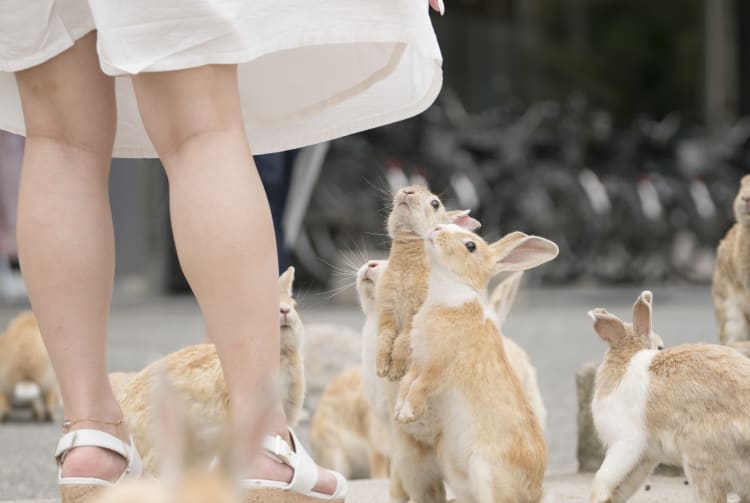
Takehara-shi, Hiroshima-ken
- View on Google Maps
- Get Transit Info
An island of cute animals with a dark history
- Southwest of the beach resort is the Hill of the Evening Sun, a great spot to see the sunset
- Look for the picturesque lighthouse on the southern tip of the island (off-limits)
- The island also has Japan's tallest electricity pylon, 226 meters high
How to Get There
Okunoshima is accessible by ferry from Tadanoumi.
From the mainland, you can take a ferry from Tadanoumi, on the JR Kure Line. Another ferry to the island leaves from Omishima.
Fluffy bunnies everywhere
There is no way of knowing exactly how many rabbits currently live on the island, but with no natural predators and cats and dogs barred from entry, the numbers will continue to grow.
There are conflicting stories as to where the rabbits came from. Some believe they are descended from a small batch of eight rabbits released by school children in 1971, while others say the original rabbits were test subjects released after World War II. Either way, they are now the island's biggest draw, and they are very well cared for.
Guests to the island are encouraged to buy food and feed these docile creatures, who are so used to human contact at this point that they are all but domesticated. Just be ready to run when you run out of food, as they are prone to chase.
Other Attractions
The island has many beautiful beaches to enjoy, and there are campgrounds. But no matter where you go, the rabbits are a constant factor, adding a healthy serving of cuteness to almost anything you can do on the island.
A Dark History
While the island is a very popular tourist spot, it does have a tragic past. The island does not shy away from its history, even exploring it for the sake of a brighter future. So even if you are not an animal lover, but are rather a history buff, Okunoshima is still well worth a visit.
Although Japan was a signatory to the 1925 Geneva Protocol prohibiting chemical warfare, just four years later in 1929, a secret chemical weapons factory was built on Okunoshima. By the end of World War II, mustard gas and tear gas were being made at this one factory.
Isolated yet still relatively accessible, Okunoshima was the perfect location for these secret activities. At the time, the government went to great lengths to keep the factory a secret, even removing the island from some maps and keeping the locals in the dark as to what was being produced.
As the war ended, documents were destroyed and the Allied forces disposed of the stockpiled chemicals. It was only decades later that the government admitted to any wrongdoing and offered financial and medical support to those in the area whose health had been damaged by the factory.
A museum of sadness
In 1988, a museum was opened on Okunoshima to present the island's secret past of poison gas manufacturing in unflinching detail. There are ruined military outposts scattered around the island, which without context seem extremely out of place on the island.
* The information on this page may be subject to change due to COVID-19.
- Wildlife Watching
Recommended for You

Please Choose Your Language
Browse the JNTO site in one of multiple languages

🐇 Rabbits’ island
Okunoshima or Okuno-jima is a small island located in Japan’s Inland Sea, attached to Takehara city in Hiroshima Prefecture. Its surface is 70,000 m². It is known for its numerous free rabbits and belongs to Setonaikai National Park.
Cute was not always the best adjective to describe the island. Indeed, it used to be an industrial site, housing an electronic and a chemical plant, producing weapons during WWII. From this not-so-glorious past, only abandoned rabbits stayed on the island. They naturally quickly reproduced, and more rabbits were introduced in the 1970s, so that they are now the main attraction and inhabitants of this small island. About 1,000 rabbits live on the island.
It is possible to stay on the island in a Japanese room with tatami in the unique Kyukamura Hotel 🏨 . Then, wander across urban ruins looking for these cute little animals, which quickly appear. We advise visitors to rent an electric bike 🚲 to easily tour the island. However, the access to the heart of the island, and especially its peaks from which visitors can observe a pretty coastal panorama, is closed for an undetermined duration (probably due to the bad weather in 2018). There are no cars 🚙 , and only one bus tours very slowly to prevent accidents.

Rabbits are everywhere: They wander on roads, in forests, or inside abandoned buildings. They are wild yet tamed thanks to humans feeding them. The main activity of the island consists of selling food to visitors before they take the ferry ⛴️ back so that they can feed the rabbits, providing the possibility for photos and selfies with the furry friends.
There are strict rules regarding rabbits and the whole island:
- No hunting or transporting rabbits;
- No touching rabbits on roads, on sidewalks, or in front of the main entrance;
- No approaching rabbits’ mouths with fingers;
- No giving rabbits human food;
- No littering;
- No releasing domestic rabbits on the island.
Moreover, only authorized food can be given to rabbits so that they do not become sick (and to help the local economy). It is sold at ferry jetties, on the continent side. A pack of food costs about 100 to 200 yen 💴 .
Okunoshima can be defined as a pleasant visit between an animal park and walk along the sea, appreciated by families and animal lovers. It is also an interesting destination for sea bathing and camping in summer .
- Flights and Airports
- Accommodation
- Transportation
- Internet & Phones
- Budget and money
- Japanese Food
- Visit with Kids
- Seasons: spring / summer / autumn / winter
- Weather forecast
- Time in Japan
- Holidays & Festivals
- Natural Disasters
- Customs and Duties
- Works and Closures
- From April 29 to 5 May -- Japanese Golden Week
- May 12 -- Mother's Day in Japan
- June 6 -- Beginning of the rainy season (Tsuyu) in Japan
- June 21 -- Summer starts in Japan
- From July 1 to 31 -- Gion Matsuri Festival in Kyoto with float processions on July 17 and 24
- July 1 -- Season start for climbing Mount Fuji
- Tokyo : Shinjuku , Shibuya , Harajuku , Asakusa , Akihabara , Odaiba , Ikebukuro , Ueno , Roppongi , Chiyoda , Ryogoku ...
- Around Tokyo: Kamakura , Nikko , Hakone , Mount Fuji , Mount Takao , Yokohama ...
- Kansai: Kyoto , Nara , Osaka , Mount Koya , Himeji , Kobe , Kinosaki , Kumano Kodo , Ise ...
- Japanese Alps: Kanazawa , Matsumoto , Takayama , Shirakawa-go , Nakasendo ...
- West: Hiroshima , Miyajima , Shikoku , Onomichi , Naoshima , Izumo , Kurashiki , Matsue ...
- South: Kyushu , Okinawa , Yakushima ...
- North: Hokkaido , Tohoku ...

- Temples and Shrines
- Gardens and Parks
- Hiking and Trekking
- Observation Decks
- Public Baths (Onsen and Sento)
- Festivals (Matsuri)
- Amusement Parks
- Visit on a Budget / Luxury

Keikaku is a travel agency specialist of Japan and providing different kind of services:
- Japan Rail Pass
- English speaking Guides
- Pocket Wi-fi
- Japan Nightlife
- Working in Japan
- Religion and Spirituality
- Arts and History
- Movies / Animated Movies
- Japanese Music
- Studio Ghibli
- Photos / Videos
- Weird Japan
- Translations
- Kana & Kanji
- Japanese Swear Words
- Honorific Suffixes (san, kun, chan...)
- Introducing yourself
- Thank you / Apologize
- Count / Say Your Age
- Say the Date / Tell the Time
- Happy birthday
- Enjoy Your Meal
- Writing your name

Kanas are the much-needed basic characters of written Japanese language. Memorize them at a fast pace with our method.

Ask any kind of question and share your knowledge about Japan in Kanpai’s community space, our Q&A section Kotaete.

Isshoni means "together" in Japanese: share your trip details (dates, places you would like to visit) and find companions to travel in Japan.

Create your Kanpai account to manage your profile and view your participation history (questions, answers).
Okunoshima Island

Top ways to experience Okunoshima Island and nearby attractions

Most Recent: Reviews ordered by most recent publish date in descending order.
Detailed Reviews: Reviews ordered by recency and descriptiveness of user-identified themes such as waiting time, length of visit, general tips, and location information.

Also popular with travellers

OKUNOSHIMA ISLAND: All You Need to Know BEFORE You Go (with Photos)
- (0.42 km) Kyukamura Ohkunoshima
- (6.56 km) Sawaki
- (6.23 km) Fujimien
- (6.39 km) WAKKA
- (12.37 km) Hotel Seifukan
- (0.40 km) Kyukamura Okunoshima Restaurant
- (0.44 km) Usanchu Cafe
- (3.06 km) Nagaya Cafe Rabbit Paradise
- (10.96 km) Dolce Setoda Honten
- (3.36 km) Tadaumiko Ferry Terminal Matsumoto Kaiso
- (0.13 km) Southern Fort Remains
- (0.18 km) Ocean Water Tank Remains
- (0.21 km) Power Plant Ruins
- (0.23 km) Okunoshima Island Poison Gas Museum
- (0.21 km) Gunpowder Storehouse Remains

What is Okunoshima ?

- # Recommendation
- # History/ Culture

It is about 15 minutes by boat from Tadano-umi Port in Takehara City. Okunoshima is a small island with a circumference of about 4 km, a little west of the Shimanami Kaido that connects the islands of the Seto Inland Sea. It is a Seto Inland Sea National Park, and you can enjoy the change of nature every season. A swimming beach, a campsite, a lawn plaza decorated with South Sea plants and a ground spread out, and you can enjoy meals, lodging, and hot springs at “Kyukamura Okunoshima,” which is the only accommodation spot on the island. In addition, there are more than 700 wild rabbits inhabiting the island, and it is crowded with tourists throughout the year.
Access to Okunoshima

Shinkansen, trains, ferries. Transfer various vehicles to Okunoshima
We will introduce the means of transportation from major cities in Hiroshima prefecture (Hiroshima city, Miyajima, Onomichi, Fukuyama, Mihara). Plan well and enjoy a variety of spots.
【From Hiroshima city】 ■ Hiroshima Station → (Shinkansen, about 30 minutes, 72 km, 2,290 yen for unreserved seats) → Mihara Station → (JR Kure Line Hiroko, about 22 minutes, 17 km, 320 yen) → Tadano-umi Station → (7 minutes on foot) → Tadanoumi Port → (Kyukamura Passenger Ship or Omishima Ferry , about 15 minutes, 310 yen) → Okunoshima pier ■ Hiroshima Station → (JR Kure Line, about 2 hours, 76 km, 1320 yen) → Tadano-umi Station → (7 minutes on foot) → Tadano-umi Port → (Kyukamura Passenger Ship or Omishima Ferry, about 15 minutes, 310 yen) → Okunoshima Pier ■Hiroshima Bus Center → (Geiyo Bus, about 100 minutes, 1490 yen) Tadanoumi Station → (7 minutes on foot) → Tadanoumi Port → (Kyukamura Passenger Ship or Omishima Ferry, about 15 minutes, 310 yen) → Okunoshima Pier
【From Miyajima】 Miyajima → (Miyajima route, 10 minutes, 1 km, 180 yen) → Miyajimaguchi station → (JR Sanyo Main Line bound for Hiroshima, about 30 minutes, 22 km, 410 yen) → Hiroshima station → (bullet train, about 30 minutes, 72 km, unreserved seats 2,290 yen) → Mihara station → ( JR Kure Line Hiroko, about 22 minutes, 17 km, 320 yen) → Tadano-umi Station → (7 minutes on foot) → Tadano-umi Port → (Kyukamura Passenger Ship or Omishima Ferry, about 15 minutes, 310 yen) → Okunoshima Pier
【From Onomichi】 Onomichi Station → (JR Sanyo Main Line for Iwakuni, about 13 minutes, 11 km, 240 yen) → Mihara Station → (JR Kure Line Hiroko, about 22 minutes, 17 km, 320 yen) → Tadanoumi Station → (7 minutes on foot) → Tadano-umi Port → (Kyukamura Passenger Ship or Omishima Ferry , about 15 minutes, 310 yen) → Okunoshima pier
【From Fukuyama】 Fukuyama Station (JR Sanyo Main Line for Iwakuni, about 30 minutes, 31.6 km, 580 yen) → Mihara Station → (JR Kure Line Hiroko, about 22 minutes, 17 km, 320 yen) → Tadano-umi Station → (7 minutes on foot) → Tadanoumi Port → (Kyukamura Passenger Ship or Omishima Island) (Ferry, about 15 minutes, 310 yen) → Okunoshima pier
【From Mihara】 Mihara Station → (5 minutes on foot) → Mihara Port (Habu Merchant Marine, about 13 minutes) → Suna Port (Habu Merchant Marine, about 17 minutes) → Okunoshima Pier *Operates only on Saturdays, Sundays, and public holidays *Mihara Port to Okunoshima 1,500 yen, Suba Port to Okunoshima 1,000 yen ※There is a free parking lot at Suwa Port. Limited to Saturdays, Sundays, and holidays! Mihara Port/Suwa Port ⇔ Okunoshima Expressway Route “ Rabbit Line ” On Saturdays, Sundays, and holidays, where Tadanoumi Port is particularly crowded, the gateway to Okunoshima Island, there are 6 high-speed boats a day from Mihara Port, which is about a 5-minute walk from JR Mihara Station to Okunoshima. It takes 30 minutes one way, and Mihara Station stops on the Kodama Shinkansen, the Kure Line, and the Sanyo Main Line. There is also a route from Hiroshima Airport to Mihara Station that takes 38 minutes by limousine bus, or you can take the bus to JR Hakuichi Station and transfer to the Sanyo Main Line. If you are driving, it is convenient to use the free parking lot at Suwa Port.

[Featured column] Regular round-trip route from Takehara Port to Okunoshima “Usagi no Omoide Route”
There is a regular ship connecting Hara Port (Takehara City Minato-cho) and Okunoshima Island. It takes about 25 minutes one way. It is possible to tour together with Takehara City Important Preservation Districts for Groups of Historic Buildings. It is about 7 minutes by bus from JR Takehara Station to Takehara Port. If you are driving, it is convenient to use the free parking lot at Takehara Port.
Dining and accommodation information on Okunoshima

Kyukamura Okunoshima reminiscent of a resort
The only accommodation on Okunoshima is Kyukamura Okunoshima. There are also restaurants and hot spring facilities that can be used for day trips (the last flight from Tadanoumi Port is 18:30). If you want to taste seafood well, we recommend staying at the buffet. You can also buy souvenirs such as rabbit goods and local sake from Takehara at the shop. How about a memory of your trip?
How to get around Okunoshima

Let's take a walk around the island by renting a bicycle
The means of transportation on Okunoshima is basically walking, but if you rent a bicycle at Kyukamura Okunoshima, you can comfortably walk around the island by bicycle (there are normal, stepped, electric assisted bicycles, and there are also children's bicycles). The rental fee for regular bicycles is 400 yen for guests every 2 hours and 600 yen for day trips. The electric assist is 600 yen for guests every 2 hours, and 800 yen for day trips. A deposit of 1000 yen is required for day trips (there is a refund after using a rental bicycle). By the way, there is a free shuttle bus from Okunoshima pier to Kyukamura Okunoshima.
Leisure in Okunoshima

You can also enjoy camping, swimming, and tennis!
Okunoshima is known as a rabbit island, but you can also enjoy leisure. Rental tents, BBQ stoves, blankets, cooking utensils, etc. are also available. Also, for beginners, you can enjoy a “hands-free camp” with a set of camping equipment and an evening and breakfast buffet, as well as a tennis court with 11 omni courts and hard courts. Of course, it is surrounded by the sea, so it is also popular as a beach in summer. An outdoor pool will also be open.
Scenery from Okunoshima

Be sure to see the beauty of the many islands of Setouchi that changes from morning to day to night
Okunoshima is famous not only for rabbits but also as a place with beautiful scenery. In particular, the beautiful islands of Setouchi and the sunset that can be seen from the ferry crossing to Okunoshima are excellent. It is also recommended to watch the sunset while soaking in the hot springs of Kyukamura Okunoshima.
Related articles

“EDION PEACE WING HIROSHIMA” A new soccer stadium in downtown has opened!

Let's go on a pilgrimage to real-life “Slam Dank” locations in Hiroshima!

[G7 Hiroshima Summit] Special Feature on Hiroshima's Traditional Culture Used the Partners Program

[HIT Editorial Department] Attention is also being paid at the G7 Hiroshima Summit! Hiroshima Food, Local Sake, and Traditional Culture
Share this article
Travel bookmarks.
All spots / experiences
This website stores cookies on your computer. nThis cookie is used by this site and other media to improve the website experience and to provide more personalized services. n For more information about our cookies, please see our Privacy Policy . This site does not track the personal information of visitors.
Everything you need to know about visiting Okunoshima: Japan’s rabbit island

Forget Disneyland. I’ve found the happiest place on earth, and there’s not a Mickey Mouse in sight. I’m talking about Japan’s rabbit island; Okunoshima. This island is overrun with cute fluffy bunnies, waiting for visitors to come armed with treats. I challenge anyone to leave there at the end of the day without warm fuzzy feelings!
Okunoshima is often referred to by its nickname, usagi jima (rabbit island in English). If you have a couple of days in Hiroshima prefecture I would put this in my top three places to visit! Read on to find out everything you need to know to plan a trip to Japan’s rabbit island.

Free Japan Travel Planner

Sign up now to get this awesome free 10 page travel planning journal that will help you to plan your next Japan trip like a pro! Includes day by day itinerary planner, packing checklist and countdown calendar.
Success! Now check your email to confirm! (This may take a few minutes so don't panic!)
There was an error submitting your subscription. Please try again.
How to get to Japan’s rabbit island
I visited Okunoshima by car, but it’s just as easy to get there by train. To access the island from Hiroshima city you can go via two routes:
Option one:
The cheaper (but longer) route is to take the JR Kure Rapid Line train from Hiroshima to Hiro and change at Hiro station (around 45 minutes journey). From there change for the JR Kure line bound for Mihara and get off at Tadanoumi station (around 60 minutes).
Option two:
If you have a Japan rail pass, you can get the Shinkansen (bullet train) from Hiroshima to Mihara (25-30 minutes), then change at Mihara for the JR train to Tadanoumi as mentioned above. This route will save you about 25 minutes on your journey. However, if you don’t have the rail pass it will cost a lot more to go this way.
Once you arrive at JR Tadanoumi station the ferry pier is a short 5-minute walk away. Before you get in line for the boat, purchase your tickets first from the machine next to the shop.
Travel tip: If you didn’t bring any rabbit food with you, buy some here at the ferry port when you get your tickets.

Taking the ferry
The ferry schedule varies according to the day and season. As a general rule, they seem to run every 60 minutes with a longer break over lunchtime. I would highly recommend checking out the times in advance through the official website . It’s in Japanese, so if you can’t read it do a Google page translation.
Travel Tip: I recommend trying to get the ferry back before 4 pm. I took a 4.30 pm ferry which was one of the last ones of the day, and the queue was huge even though I got there 30 minutes before!

Things to do on rabbit island
Once you arrive at Okunoshima, there a few interesting spots to discover, or you can just stroll around and interact with the bunnies like I did.
1. Visit the museum
Despite their protected status life wasn’t always so good for the island’s inhabitants. During the Second World War, Okunoshima was used to test poison gas, with the poor bunnies as the test subjects. If you are interested in the history of the island, you could pay a visit to the museum.
2. Have a picnic
If you are visiting during the warmer months, I recommend stocking up on bento boxes from a convenience store and setting up a picnic lunch. You may find that you have a few extra guests joining you!
3. Mooch around the hotel
There is a hotel on the island called Kyukamura Okunoshima . For day visitors it is worth visiting the gift shop for some interesting souvenirs. For example, I bought some cute chocolate bunny cookies for my colleagues, and some not so cute but funny rabbit poop shaped chocolates.
4. Hire a bike
It takes around an hour to walk around the whole island, but another nice way to see it is by bicycle. You can rent bikes from the hotel.

My top tips for best bunny viewing:
- If you can, bring your own food for the rabbits. You can buy some pellet food on the island but the rabbits will love you more if you bring fresh vegetables for them to munch on. I took a bag of freshly chopped cabbage and carrots which the rabbits loved. Carrots seem to go down particularly well!
- Let the rabbits approach you. If you go bounding after them, chances are they’ll take one look at you and bolt. Instead let them approach you. Which they will. Particularly if they see you holding food…
- Don’t pick the rabbits up. These are wild animals and they do not like to be man handled or petted.
- Don’t feed them by the road. There are occasionally buses going to and from the hotel so don’t leave rabbit food lying on the road or feed them somewhere which could prove to be dangerous for them.

Estimated day out cost:
JR train from Hiroshima: around 4,000 yen (free with Japan rail pass)
Ferry cost: 320 yen per adult
Lunch: Budget around 1000 yen for convenience store bentos and drinks
Souvenirs: 1000 yen for 2 small boxes of chocolates or cookies
TOTAL APPROXIMATE COST: 6,320 yen(without Japan rail pass) (day trip)
2,320 yen (with Japan rail pass) (day trip)
Where to stay in Hiroshima:
If you are staying in Hiroshima city, I can recommend the centrally located Ark Hotel. As I visited during the week and booked a couple of months out, I got an amazing deal online for around 7,000 yen for a double room. The hotel is comfortable and the staff are very friendly. The hotel also has a number of public baths for guests to use if you want to try a onsen experience.
[tp_hotel_widget hotel_id=258879 responsive=true subid=””]
What to eat in Hiroshima:
If you’re after Japanese food, try Hiroshima style okonomiyaki. It’s a delicious savoury pancake and the Hiroshima variety also has noodles on top. If you want western food I love Graffity – a really cool Mexican restaurant with amazing tacos and super friendly owners!
Need more inspiration?
Combine a trip to rabbit island with the nearby Shimanami Kaido, a beautiful cycle path that spans the world’s longest collection of suspension bridges. You could do the whole cycle route and overnight on Okunoshima in 2 days. For more information on the cycling route, check out this article .
Share this:
About author.
Related Posts

Japan in September – 14 Things to See and Do in 2024!

Japan in August – 16 Things to See and Do in 2024

Japan in May – 17 Things to See and Do in 2024
It can be my reference. Cause I’ll be there soon ^^
Please don’t recommend carrots for bunny island as they’re high in sugar and too much intake can be really bad for them so suggesting them on a forum like this isn’t recommended. Otherwise, great post !!!
Leave a Reply Cancel reply
- Sapporo (22)
- Jozankei (1)
- Abashiri, Monbetsu, Kitami, Shiretoko (8)
- Kurshiro, Akan, Kawayu, Nemuro (4)
- Obihiro, Tokachi (13)
- Erimo, Hidaka (1)
- Furano, Biei, Tomamu (13)
- Asahikawa, Sounkyo, Asahidake (12)
- Chitose, Shikotsu, Tomakomai, Takikawa, Yubari, Sorachi (10)
- Otaru, Kiroro, Shakotan, Yoichi (6)
- Rusutsu, Niseko, Kutchan (5)
- Hakodate, Yunokawa, Onuma, Okushiri (25)
- Toya, Muroran, Noboribetsu (4)
- Aomori, Asamushi Onsen (2)
- Hirosaki, Kuroishi (1)
- Hakkoda, Lake Towada, Oirase (3)
- Hachinohe, Misawa, Shichinohe-Towada (4)
- Shimokita, Oma, Mutsu (1)
- Morioka (3)
- Appi Kogen, Hachimantai, Ninohe (4)
- Miyako, Kuji, Iwaizumi (2)
- Kamaishi, Ofunato, Rikuzentakata (1)
- Hiraizumi, Ichinoseki, Oshu (1)
- Sendai, Tagajo, Natori (13)
- Matsushima, Shiogama, Ishinomaki, Minami-Sanriku, Kesennuma (7)
- Noshiro, Oga, Shirakami (6)
- Kakunodate, Omagari, Lake Tazawa (1)
- Yamagata, Zao, Tendo, Kaminoyama (5)
- Obanazawa, Shinjo, Murayama (2)
- Sakata, Tsuruoka, Yunohama, Atsumi (5)
- Fukushima, Nihonmatsu (3)
- Aizu-Wakamatsu, Kitakata (1)
- Inawashiro, Omote-Bandai (1)
- Bandai Kogen, Ura-Bandai (2)
- Iwaki, Minami-Soma, Soma (3)
- Mito, Kasama (2)
- Oarai, Hitachinaka (3)
- Tsukuba, Tsuchiura, Toride (4)
- Utsunomiya, Sakura (1)
- Nikko, Lake Chuzenji, Oku-Nikko, Imaichi (18)
- Nasu, Itamuro, Kuroiso (8)
- Koyama, Ashikaga, Sano, Tochigi (1)
- Maebashi, Akagi (1)
- Ikaho Onsen, Shibukawa (5)
- Kusatsu Onsen, Shirane (1)
- Shima Onsen (2)
- Minakami, Sarugakyo, Numata (57)
- Oze, Marunuma (2)
- Isesaki, Ota, Tatebayashi, Kiryu (2)
- Fujioka, Annaka, Tomioka, Isobe Onsen (3)
- Soka, Koshigaya, Kasukabe, Hanyu (4)
- Kawagoe, Higashi-Matsuyama, Shiki, Wako (16)
- Tokorozawa, Sayama, Hanno (4)
- Chichibu, Nagatoro (11)
- Maihama, Urayasu, Funabashi, Makuhari (1)
- Matsudo, Kashiwa (2)
- Narita Airport, Sakura (8)
- Choshi, Asahi, Kujukuri, Togane, Mobara (3)
- Kamogawa, Katsuura, Onjuku, Yoro Valley (7)
- Minami Boso, Tateyama, Shirahama, Chikura (6)
- Ichihara, Kisarazu, Kimitsu, Futtsu, Kyonan (5)
- Tokyo Station, Ginza, Akihabara, Toyocho, Kasai (81)
- Shinbashi, Shiodome, Odaiba, Hamamatsucho (35)
- Akasaka, Roppongi, Kasumigaseki, Nagatacho (52)
- Shibuya, Ebisu, Meguro, Futakotamagawa (57)
- Shinagawa, Haneda Airport, Kamata, Oimachi (23)
- Shinjuku, Nakano, Ogikubo, Yotsuya (52)
- Ikebukuro, Akabane, Sugamo, Otsuka (17)
- Tokyo Dome, Iidabashi, Ochanomizu (34)
- Ueno, Asakusa, Kinshicho, Shin-Koiwa, Kita-Senju (111)
- Tachikawa, Hachioji, Machida, Fuchu, Kichijoji (65)
- Okutama, Ome, Hamura (19)
- Hachijojima (7)
- Yokohama (50)
- Kawasaki (2)
- Odawara (3)
- Lake Sagamiko, Tanzawa (2)
- Yamato, Sagamihara, West Machida (2)
- Shonan, Kamakura, Enoshima, Fujisawa, Hiratsuka (56)
- Yokosuka, Miura (16)
- Niigata (2)
- Nagaoka, Tsubame-Sanjo, Kashiwazaki, Yahiko, Iwamuro, Teradomari (1)
- Uonuma, Tokamachi, Tsunan, Muikamachi, Oyu (2)
- Echigoyuzawa, Naeba (2)
- Joetsu, Itoigawa, Myoko (2)
- Kofu, Yumura, Shosenkyo (1)
- Yamanashi, Isawa, Katsunuma, Enzan (2)
- Otsuki, Tsuru, Doshikeikoku (8)
- Lake Yamanaka, Oshino (17)
- Lake Kawaguchi, Fujiyoshida, Lake Motosu, Lake Sai, Lake Shoji (42)
- Shimobe, Minobu, Hayakawa (2)
- Nagano, Obuse, Shinshu-Takayama, Togakushi, Iizuna (7)
- Madarao, Iiyama, Shinanomachi, Lake Nojiri, Kurohime (2)
- Nozawa Onsen, Kijimadaira, Akiyamago (6)
- Shiga Kogen, Yudanaka, Shibu (2)
- Tokurakamiyamada, Magarifuchi (1)
- Sugadaira, Hachinohara (1)
- Karuizawa, Saku, Komoro (4)
- Yatsugatake, Nobeyama, Fujimi, Haramura (3)
- Tateshina, Lake Shirakaba, Kirigamine, Kurumayama (3)
- Ina, Komagane, Iida, Hirugami (7)
- Matsumoto, Shiojiri, Asama Onsen, Utsukushigahara Onsen (2)
- Kamikochi, Norikura, Shirahone (1)
- Azumino, Hotaka, Omachi, Toyoshina (38)
- Hakuba, Happo-One, Tsugaike Kogen, Otari (5)
- Toyama, Yao, Tateyama (4)
- Takaoka, Himi, Tonami (1)
- Kanazawa (36)
- Kaga, Komatsu, Tatsunokuchi (34)
- Nanao, Wakura, Hakui (2)
- Awara, Mikuni (8)
- Tsuruga, Mihama (4)
- Gifu, Kakamigahara (10)
- Okuhida, Shinhotaka (2)
- Takayama, Hida (15)
- Gero Onsen, Nigokawa Onsen (5)
- Nakatsugawa, Tajimi, Ena, Minokamo (12)
- Gujo-Hachiman, Mino, Seki (28)
- Shirakawa-go (7)
- Ogaki, Gifu Hashima (4)
- Shizuoka, Shimizu (8)
- Izu Kogen (22)
- Higashi-Izu, Kawazu (7)
- Shimoda, Minami-Izu (13)
- Nishi-Izu, Toda, Doi, Dogashima (4)
- Izunagaoka, Shuzenji, Amagiyugashima (2)
- Fuji, Fujinomiya (9)
- Gotemba, Numazu, Mishima (13)
- Yaizu, Fujieda, Omaezaki, Sumatakyo (3)
- Hamamatsu, Lake Hamana, Tenryu (21)
- Nagoya (105)
- Toyohashi, Toyokawa, Gamagori, Irago (2)
- Toyota, Kariya, Chiryu, Aki, Okazaki (3)
- Ichinomiya, Inuyama, Komaki, Seto, Kasugai (3)
- Centrair, Tokai, Handa, Chita (14)
- Minamichita, Himakajima, Shinojima (1)
- Tsu, Suzuka, Kameyama (20)
- Yokkaichi, Kuwana, Yunoyama, Nagashima Onsen (2)
- Iga, Nabari (9)
- Matsusaka (1)
- Ise, Futami (9)
- Shima, Kashikojima (4)
- Kumano, Owase, Kihoku (2)
- Otsu, Ogoto, Kusatsu, Ritto (30)
- Kosai, Takashima, Makino (5)
- Nagahama, Yonehara (2)
- Hikone, Omihachiman, Moriyama, Higashiomi (5)
- Kyoto (165)
- Uji, Nagaokakyo (8)
- Kameoka, Yunohana, Kyotamba, Miyama (5)
- Amanohashidate, Miyazu, Maizuru (9)
- Osaka (187)
- Itami Airport, Takatsuki, Ibaraki, Minoo (4)
- Hirakata, Moriguchi, Higashi Osaka (4)
- Kansai International Airport, Sakai, Kishiwada, Izumisano (19)
- Kobe, Mt. Rokko, Arima Onsen (44)
- Takarazuka, Nishinomiya, Koshien, Mita, Sasayama (20)
- Akashi, Kakogawa, Miki (6)
- Himeji, Aioi, Ako (15)
- Kinosaki Onsen, Toyooka, Izushi, Kannabe (4)
- Awajishima (19)
- Nara, Yamato Kogen (14)
- Kashihara, Yamatokoriyama, Tenri, Ikoma (1)
- Yoshino, Totsukawa, Tenkawa, Gojo (8)
- Wakayama, Kada, Wakaura (7)
- Koyasan, Hashimoto (2)
- Nanki-Shirahama, Kii Tanabe, Ryujin (21)
- Tottori, Iwami, Hamamura (14)
- Kurayoshi, Misasa Onsen (2)
- Yonago, Kaike Onsen, Oyama (5)
- Matsue, Tamatsukuri, Yasugi, Oku-Izumo (8)
- Izumo, Ota, Iwami Ginzan (1)
- Okayama (4)
- Ushimado, Setouchi, Bizen (5)
- Tsuyama, Yunogo, Mimasaka, Okutsu (1)
- Yuhara, Hiruzen, Niimi, Takahashi (6)
- Kurashiki, Soja, Tamano, Kasaoka (8)
- Hiroshima (12)
- Higashi-Hiroshima, Takehara, Mihara, Hiroshima Airport (1)
- Fukuyama, Onomichi, Shimanami Kaido (3)
- Miyoshi, Shobara, Taishakukyo (1)
- Miyajima, Miyahama Onsen, Hatsukaichi (3)
- Yamaguchi, Yuda Onsen, Hofu (1)
- Hagi, Nagato, Akiyoshidai (2)
- Oboke, Iya, Kenzan, Yoshinogawa (12)
- Anan, Hiwasa, Shishikui (14)
- Takamatsu, Sanuki, Higashi-Kagawa (3)
- Shodoshima, Naoshima (1)
- Matsuyama, Dogo (1)
- Imabari, Shimanami-Kaido (2)
- Saijo, Niihama, Shikoku-Chuo (1)
- Uwajima, Yawatahama (11)
- Kochi, Nankoku, Konan, Ino (15)
- Ashizuri, Shimanto, Shukumo, Suzaki (4)
- Hakata, Canal City, Uminonakamichi, Dazaifu, Futsukaichi (35)
- Tenjin, Nakasu, Yakuin, Fukuoka Dome, Itoshima (30)
- Kitakyushu (3)
- Munakata, Miyawaka, Iizuka (1)
- Omuta, Yame, Yanagawa, Chikugo (2)
- Saga, Furuyu Onsen (4)
- Ureshino, Tara, Imari, Arita, Takeo (3)
- Karatsu, Yobuko (3)
- Nagasaki (3)
- Huis Ten Bosch, Sasebo, Hirado (7)
- Goto Islands (1)
- Kumamoto (12)
- Uto, Yashiro, Minamata (6)
- Hitoyoshi, Kuma (14)
- Amakusa, Hondo (7)
- Beppu, Hiji (13)
- Usuki, Saeki, Bungo-Ono (2)
- Yufuin, Yunohira (2)
- Miyazaki (3)
- Miyakonojo, Ebino, Nichinan, Aya (4)
- Kagoshima, Sakurajima (9)
- Ibusuki, Makurazaki, Minami-Satsuma (5)
- Yakushima (24)
- Amamioshima, Kikaijima, Tokunoshima (62)
- Okinoerabujima, Yoronjima (3)
- Onna, Nago, Motonobe, Nakijin (349)
- Ginowan, Chatan, Yomitan, Okinawa City, Uruma (190)
- Itoman, Tomigusuku, Nanjo (27)
- Kerama, Tokashiki, Zamami, Aka (45)
- Kumejima (6)
- Miyakojima, Irabujima (147)
- Ishigaki, Iriomote, Kohamajima (298)
- All Destinations (4149)
- Central Area (3)
- Sentosa (2)
- Ho Chi Minh (1)
- Hong Kong (2)
- Netherlands (1)
- Valletta (3)
- Portugal (1)
- New York (8)
- All Categories (4149)
- Same-Day Bookings Available (68)
- Castles & Palaces (3)
- Historical Buildings (8)
- Gardens & Parks (5)
- Theme Parks & Amusement Parks (58)
- Water Parks (7)
- Aquariums (38)
- Botanical Gardens (16)
- Observatories (58)
- Museums & Exhibitions (89)
- Cable Car (10)
- Ski Lifts (6)
- Air Tours (1)
- Diving (302)
- Snorkeling (303)
- Kayaking & Canoeing (197)
- Rafting (65)
- Canyoning (41)
- Surfing (56)
- Banana Boat (61)
- Parasailing (45)
- Caving (18)
- Hiking, Trekking, & Climbing (86)
- Cycling (27)
- Adventure Travel (11)
- Ziplining (3)
- Skydiving (1)
- Skiing & Snowboarding (26)
- Segways (8)
- Buggy Driving & Athletics (18)
- Paragliding (17)
- Bouldering (10)
- Rock Climbing (3)
- Horse Riding (2)
- Hot Air Balloon (5)
- Camping & Glamping (12)
- Fishing (42)
- Fruit Picking (2)
- Go-Kart (22)
- Airsoft (2)
- Cruises (79)
- Shows & Performances (70)
- Sports Matches (2)
- Animal Cafes (19)
- Mystery Solving & Escape Games (3)
- Helicopter Cruising (2)
- Pottery Class (155)
- Blacksmithing & Knife Making (4)
- Accessory Making (75)
- Glass Art (59)
- Herbarium Making (15)
- Flower Arrangement (19)
- Engraving (11)
- Perfume Making (6)
- Pop Culture (19)
- Manga & Anime (10)
- Kimono & Yukata (141)
- Tea Ceremony (23)
- Rickshaw (3)
- Maiko Experience (13)
- Ninja & Samurai Experience (28)
- Cultural Experiences (126)
- Traditional Crafts (110)
- Photoshooting (57)
- Cooking Classes (38)
- Spas, Salons, & Massages (21)
- Hot Spring & Foot Bath (28)
- Fortune Telling (1)
- Meditation & Zen (6)
- Shrines, Temples & Historic Sites (77)
- Walking Tours (103)
- Bus & Car Tours (62)
- Multi-Day Tours (4)
- Night Tours (52)
- Sake & Wine Tours (16)
- Food Tours (48)
- Meet the Locals (39)
- Seasonal Events (37)
- Trains & Shinkansen (95)
- Private Transfer (3)
- Airport Transfer (17)
- Transportation Passes (63)
- Ferries (8)
- Japanese Cuisine (23)
- Other Cuisine (12)
- Tourist Passes (2)
- Pocket Wi-Fi & SIM Cards (8)
- Luggage Storage (6)
- Online Experiences (9)
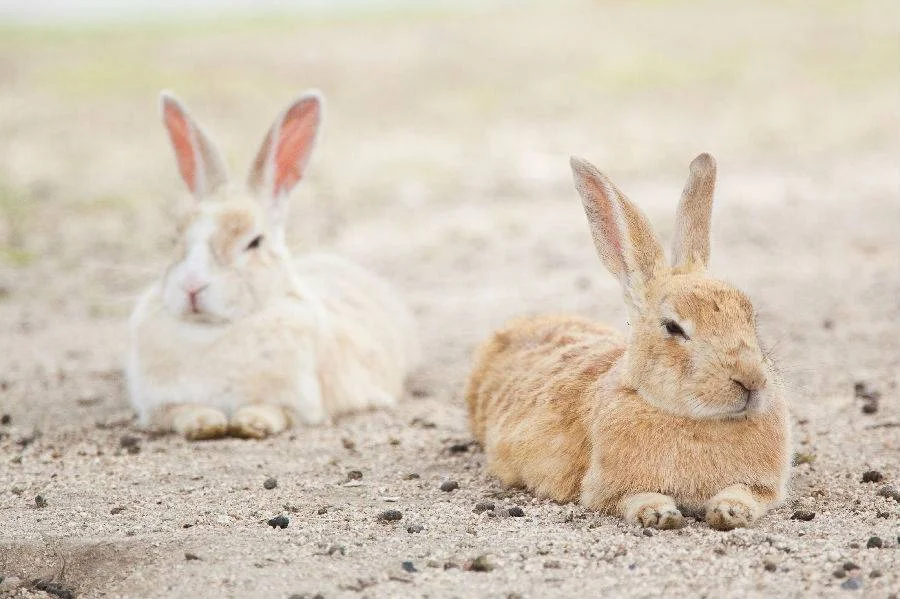
1-Day Guided Tour of Okunoshima Rabbit Island & Takehara
Like rabbits? Visit Okunoshima, Japan’s rabbit island! As well as frolicking with the island’s residents, you’ll make your own bamboo pinwheel in the historic city of Takehara, famous for its samurai residences and bamboo crafts.
- Visit Okunoshima, home to hundreds of wild (but friendly!) rabbits
- Explore the historic city of Takehara, with numerous well-preserved residences and buildings
- Make a bamboo pinwheel at a traditional workshop
- Guide and transport to and from Hiroshima Station included
Key Information
Description.
In the Seto Inland Sea, south of Hiroshima Prefecture, lies a secret. Okunoshima Island didn’t even appear on maps during the Second World War, as it was used to test chemical weapons. Nowadays, you’ll find something very different if you visit: rabbits! Hundreds of wild bunnies now call the island home, and are known for being calm and friendly around humans. On this guided tour, you’ll visit Okunoshima — Japan’s rabbit island — as well as Takehara City on Hiroshima’s mainland. This historic city is home to many well-preserved buildings from the Edo period (1603–1867), including aristocrats’ residences and warehouses that attest to its history as a port town. The city is also well known for its bamboo crafts, making everything from tableware to delicately engraved lampshades. When you visit, you’ll experience this culture firsthand as you make your own pinwheel out of local bamboo in a traditional workshop. This guided tour includes transport by coach to and from Hiroshima, as well as a ferry to and from Okunoshima Island. Get ready for the perfect combination of traditional culture and fluffy friends!
How it works
1. Once your booking is confirmed, you will receive an email with a QR code, which will serve as your e-ticket 2. Your ticket is fixed-date; once you receive it, you cannot request for cancellation or a change of date 3. On the day of your tour, please arrive at least 10 minutes before the bus departs. Present your QR code (printed or displayed on your smartphone) at the bus ticket office just outside Hiroshima Station’s Shinkansen Exit
- [email protected]
SHIKOKU TOURS
Travel and adventure, okunoshima island.
Home » Okunoshima Island
Okunoshima is a small island in the Seto Inland Sea, 13 minutes by ferry from Omishima Island. Okunoshima is known for its rabbits, its poison gas museum, and its ruined gun emplacements. The island makes a good day-trip, and is an attractive destination for photographers.
Okunoshima is often called Usagijima (“Rabbit Island”) because of the hundreds of tame rabbits that live here. As soon as you get off the ferry, you can find them close to the dock. They approach visitors without fear, and if you bring vegetables with you, the rabbits will eat from your hand. The rabbits living on the island are unrelated to testing of the poison gas.
Okunoshima played a role during World War II as the location of a factory for the poison gas that was used in China. Today there’s a small museum with various equipment used for producing the poison gas, and a collection of photographs showing how the gas was made and its effects on people. The ruins of the gas manufacturing plant and the power station that supplied it are still there today. The power station building is a particularly dramatic sight.
Okunoshima is also home to other relics of military history. The mountain in the middle of the island is dotted with sturdily-built gun emplacements from the time of the Russo-Japanese war in the Meiji period. It takes an effort to climb up to them, but it’s worth it. The views from the top of the mountain over the Inland Sea are also spectacular.
The island now has a hotel, a six-hole golf course and a small camping ground. In the summer, you can swim in the clean water around the island. In terms of size, you can walk around the island in about 40 minutes, although a more leisurely pace is recommended to take in the sights and to enjoy the company of the rabbits.
The island is dominated by the massive pylons of the Choshi Powerline Crossing, the tallest powerline in Japan.
Information
Name in Japanese: 大久野島
Pronunciation: ōkunoshima
Address: Okunoshima, Hiroshima
Related Tours

Best of Shikoku Pilgrimage
Experience the most beautiful and interesting temples of the Shikoku Pilgrimage in seven days.

Best of Shikoku Taxi Tour
Experience the best that Shikoku has to offer in five days.

Unique Accommodation of Shikoku
A tour for families or friends, staying in the most characterful kominka and ryokan of Shikoku.

Shikoku Pilgrimage with Walks
Visit the most beautiful and interesting temples of the Shikoku Pilgrimage and walk the toughest trails.

Related Points of Interest
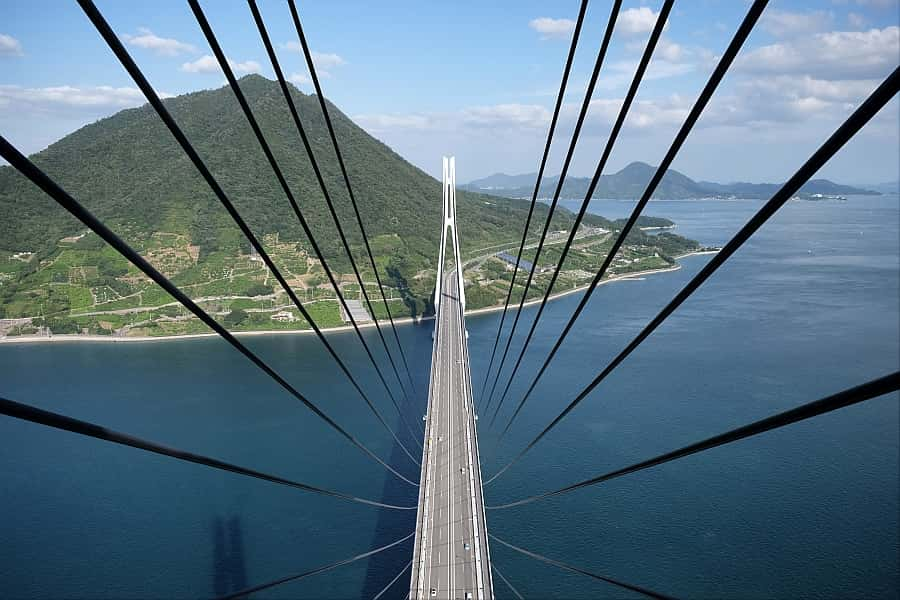
Ikuchi Island
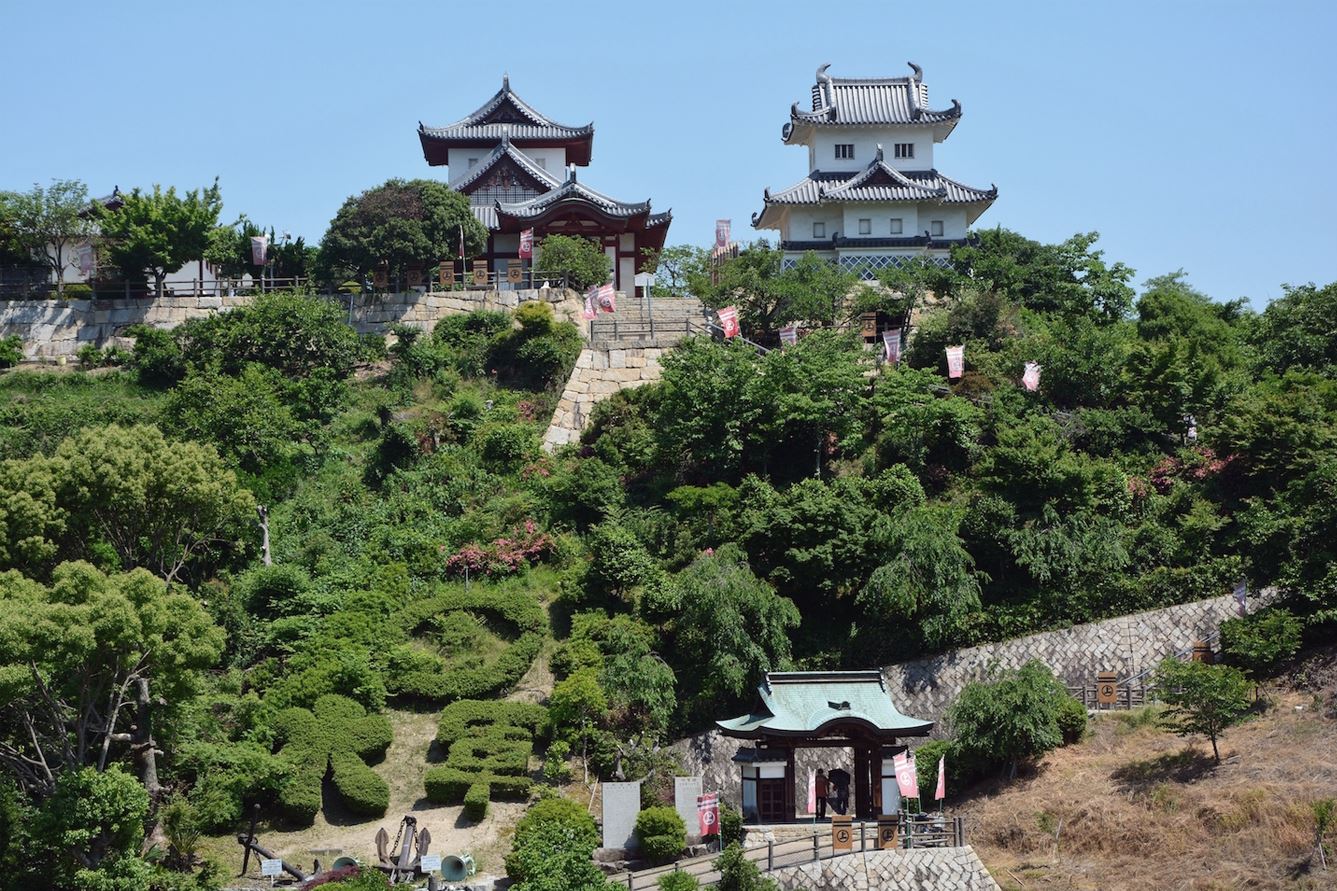
Innoshima Suigun Castle
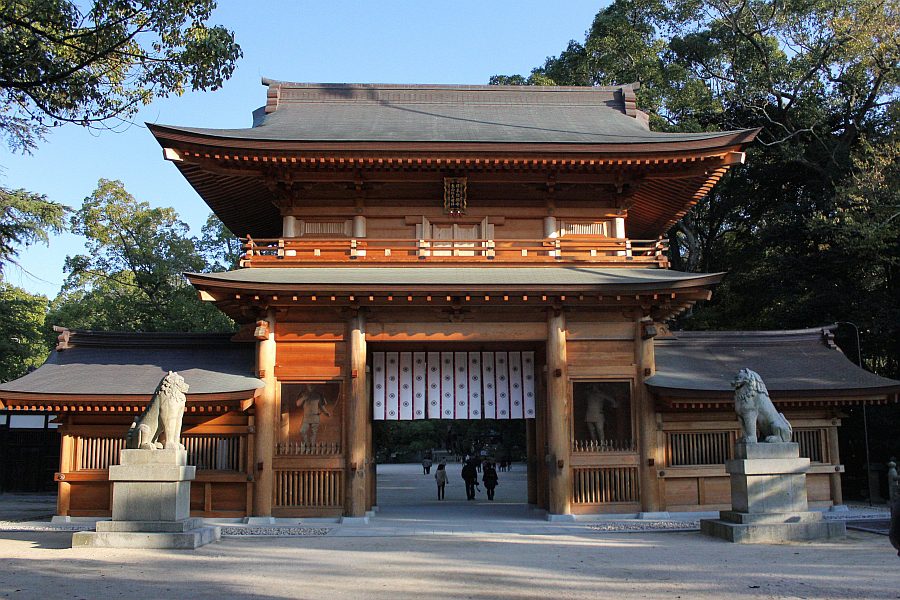
Ōmishima Island


This site introduces a easiest way to get sightseeing spots in japan to you.
Highlights and how to get to Okunoshima Island.
- Update Date: Monday December 24th, 2018
- Post Date: Monday April 18th, 2016
- Chugoku region
- Plants and Animals
- Tourist Facilities
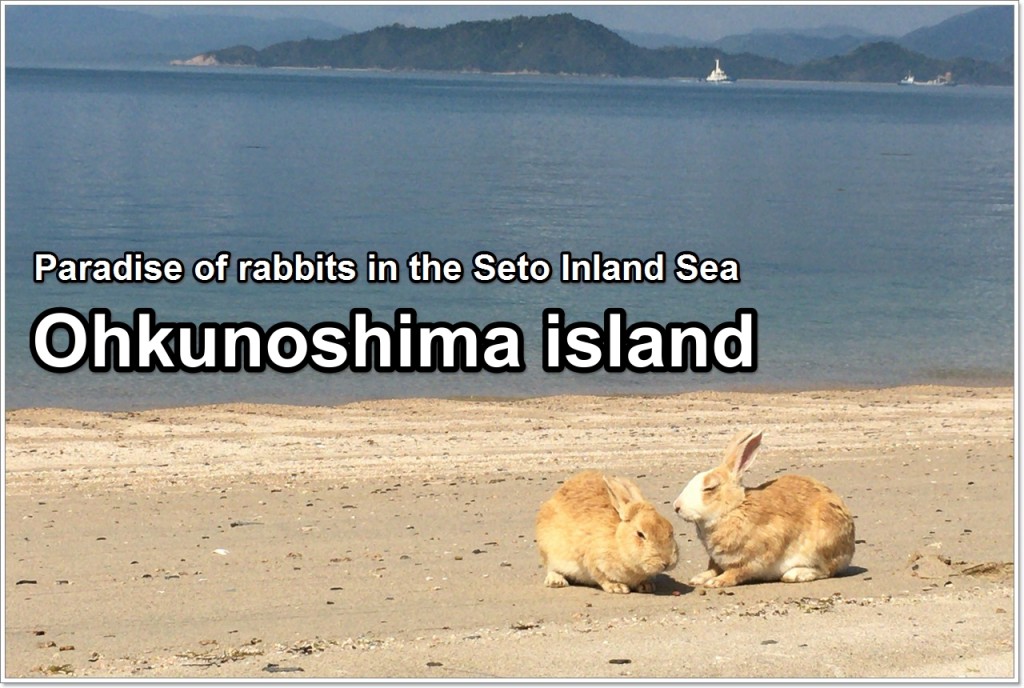
There is a paradise of rabbits in Seto Inland Sea in Japan!
The name of the island is “Ohkunoshima”.
This island is famous for the video on the Web surrounded by very many rabbits when you search it in YouTube.( *´艸`) I’m visiting every year to watch a rabbit from five years ago when Ohkunoshima was not so famous.
The number of rabbits inhabiting the island is more than 700 now! Why don’t you go to “Ohkunoshima” which is the paradise of rabbits?
- Complete guide map of Ohkunoshima
- Preparations in advance
- Video on the Web of each spot
- Picture of each spot
- Other pictures
- How to get to “Ohkunoshima”
- About staying of “Kyukamura-Ohkunoshima”
1.Complete guide map of Ohkunoshima
2.preparations in advance.
I will introduce the key points that must be prepared before going to Ohkunoshima.
- Let’s bring Rabbit food and vegetables.
- Method to purchase a bait of rabbits at local shop.
- Let’s take a raincoat on a rainy day.
- Let’s reserve the hotel (Kyukamura-Ohkunoshima).
- Spring or autumn is recommended if you want to watch a child rabbit.
・Let’s bring Rabbit food and vegetables.
In the past, the accommodations of the island sold the bait of the rabbit, but do not sell it now. (Under the guidance of the country) Thus, there is no means to obtain the bait of the rabbit in “Ohkunoshima”. You purchase it beforehand, and let’s bring it. (It is best if there is a tool to cut the vegetables.)
When you buy the bait of the rabbit, let’s choose “soft type” that child rabbit is easy to eat.
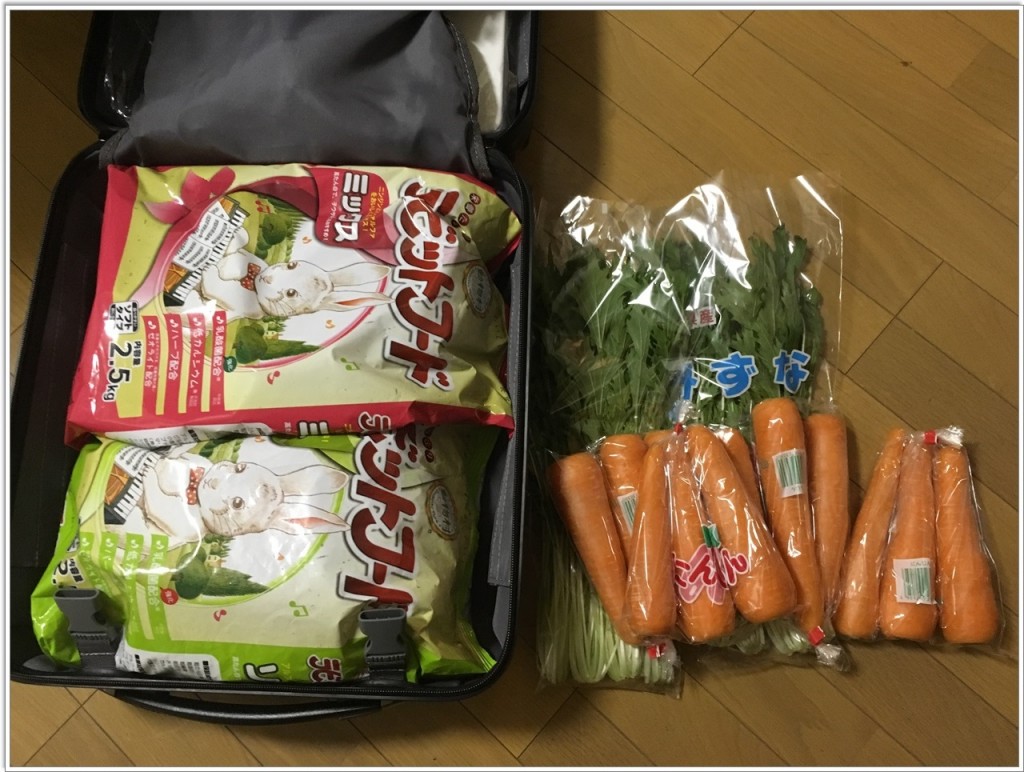
・Method to purchase a bait of rabbits at local shop.
Rabbit food and the vegetables are considerably heavy. Thus, in the case that you want to buy it in travel destination, it can be purchased at the following locations. d(*゚ー゚*)
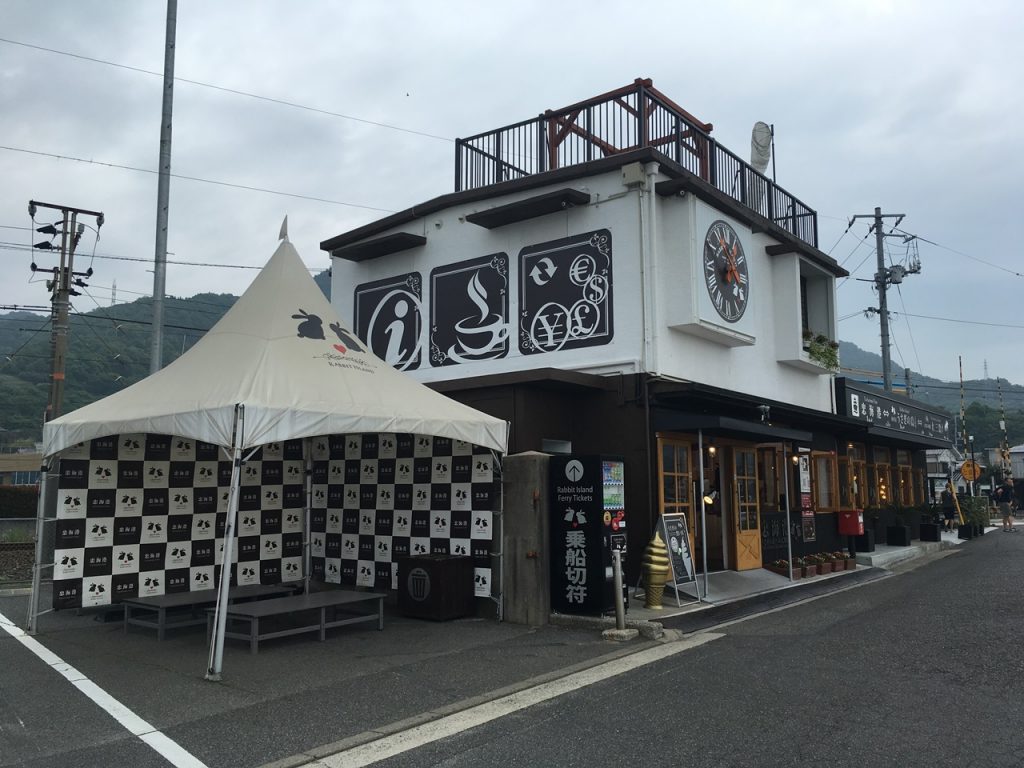
■Supermarket “Mamii”
There is a supermarket in a 5-minute walk from Tadanoumi station. Here you can buy vegetables.
Supermarket “Mamii” Open 9:00~19:00 Holiday Sunday,Monday of the holiday Adress 2-4-15, Tadanominakamachi, Takehara-shi, Hiroshima, 729-2316, Japan Phone Number +81-846-26-0820
■Family Mart JR Tadanoumi
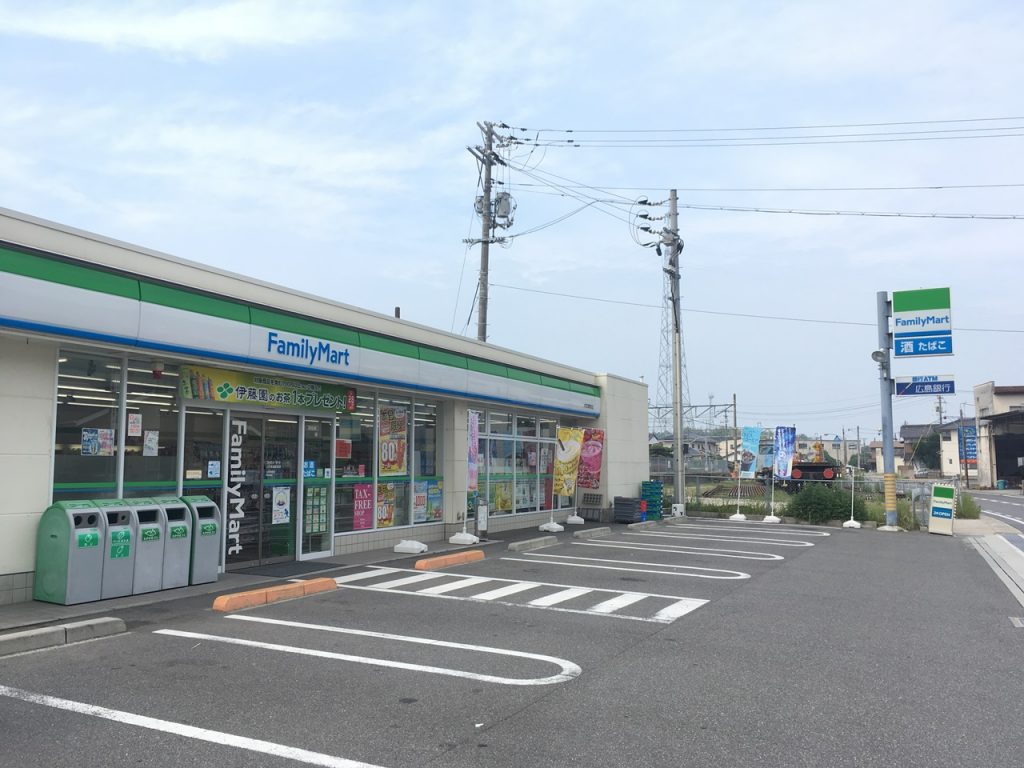
・Let’s take a raincoat on a rainy day.
The rabbit is often playing outside on the rainy day. Let’s take a raincoat on a rainy day.
・Let’s reserve the hotel (Kyukamura-Ohkunoshima).
You can enjoy Okunoshima in a day-trip, but if you stayed at the hotel, you can enjoy more. Because there is not the person other than a hotel guest early in the morning at night in particular, a rabbit is very active.
・Spring or autumn is recommended if you want to watch a child rabbit.
Spring (April~May) and autumn (October~November) is born a lot of child rabbit. If you want to see the child rabbit, Let’s go to the island in spring or autumn.
・YouTube:大久野島(うさぎ島)の子うさぎたち :Cute bunnies in Ohkuno-shima Island
3.Video on the Web of each spot
4.Picture of each spot
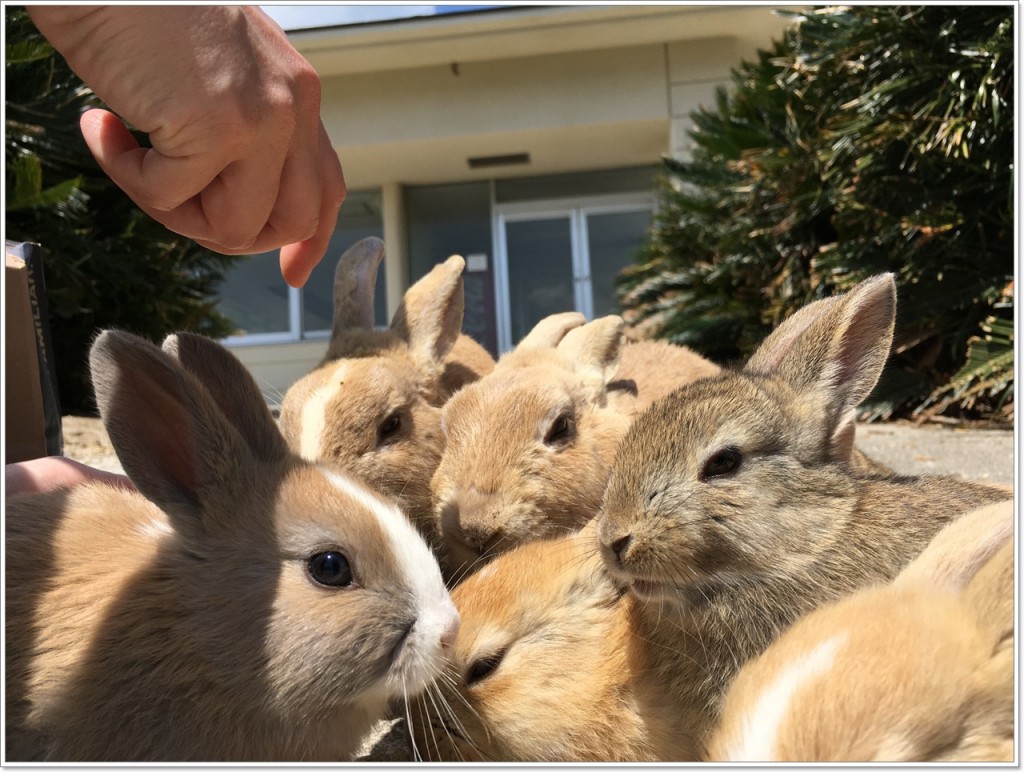
5.Other pictures
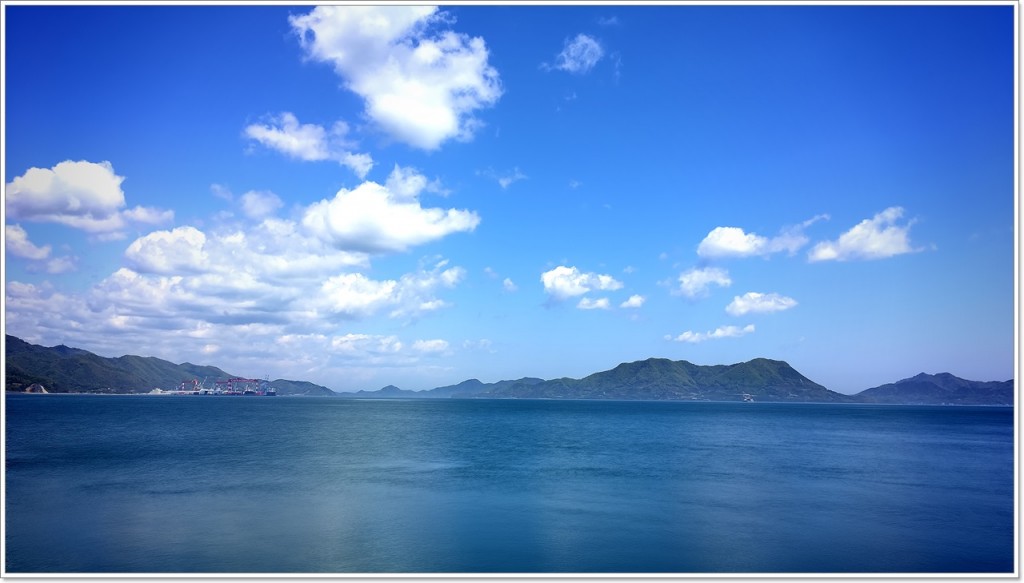
There are rabbits of various personality and patterns in this island. (○´艸`) You should try going there at least once too!
6.How to get to “Ohkunoshima”
- Access method
- Way to go cheaply by train. (From Osaka area)
- From Mihara Station to Tadanoumi Station
- From Tadanoumi Station to Tadanoumi Port
- Timetable of ferry
- Purchase of the ferry ticket
・Access method
・Way to go cheaply by train. (From Osaka area)
If you go by a train, you go to Mihara Station by Shinkansen, and transfer to the JR Kure Line in Mihara Station, and go to Tadanoumi Station.
Timetable and Route Search
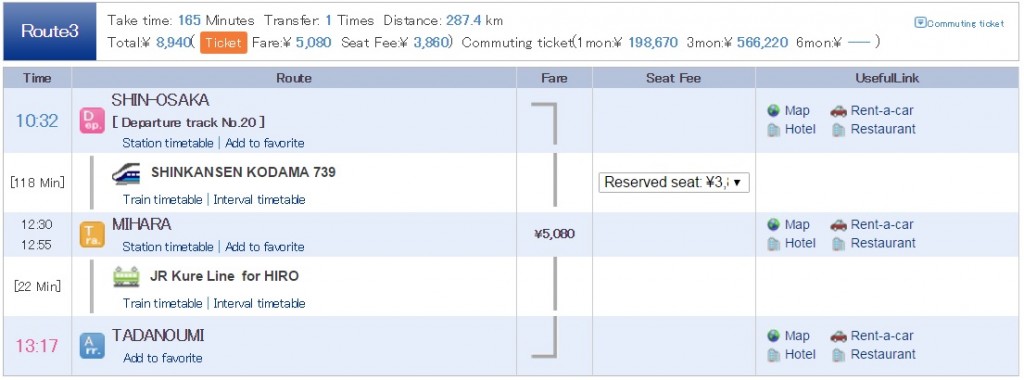
If you go from Osaka area to Mihara Station, there is a very deals ticket of JR. Ticket name is Kansai-Hiroshima Area pass.
・From Mihara Station to Tadanoumi Station
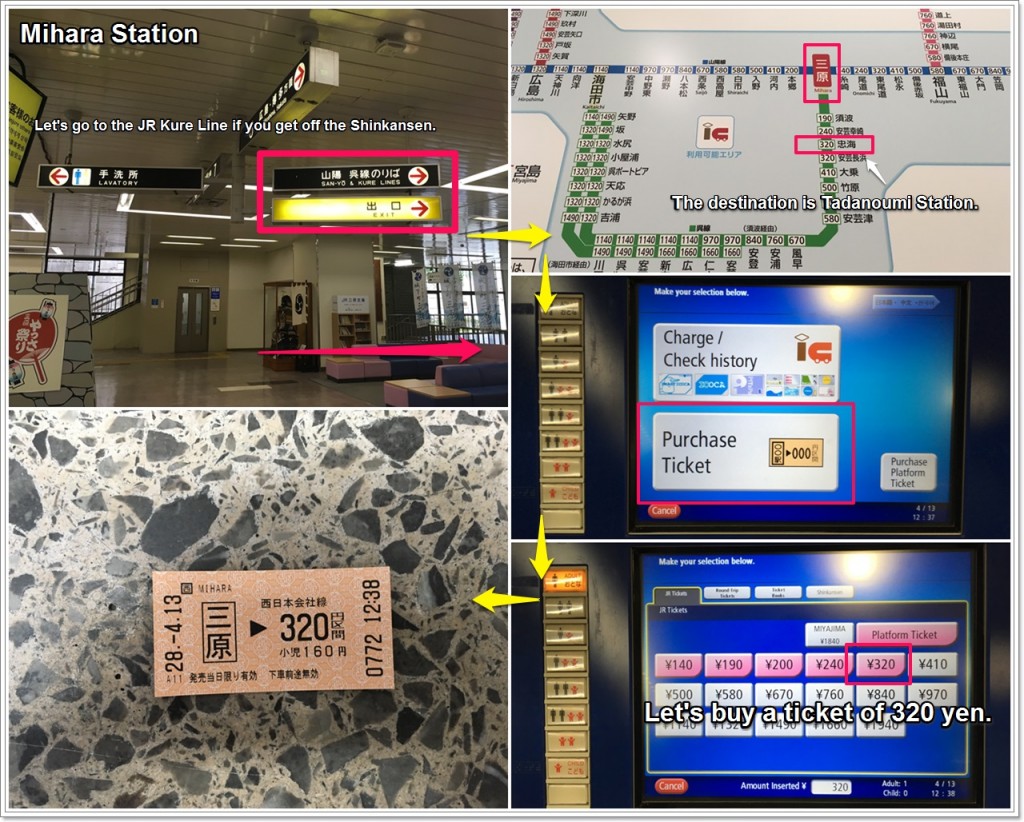
・From Tadanoumi Station to Tadanoumi Port
・Timetable of ferry
・Purchase of the ferry ticket
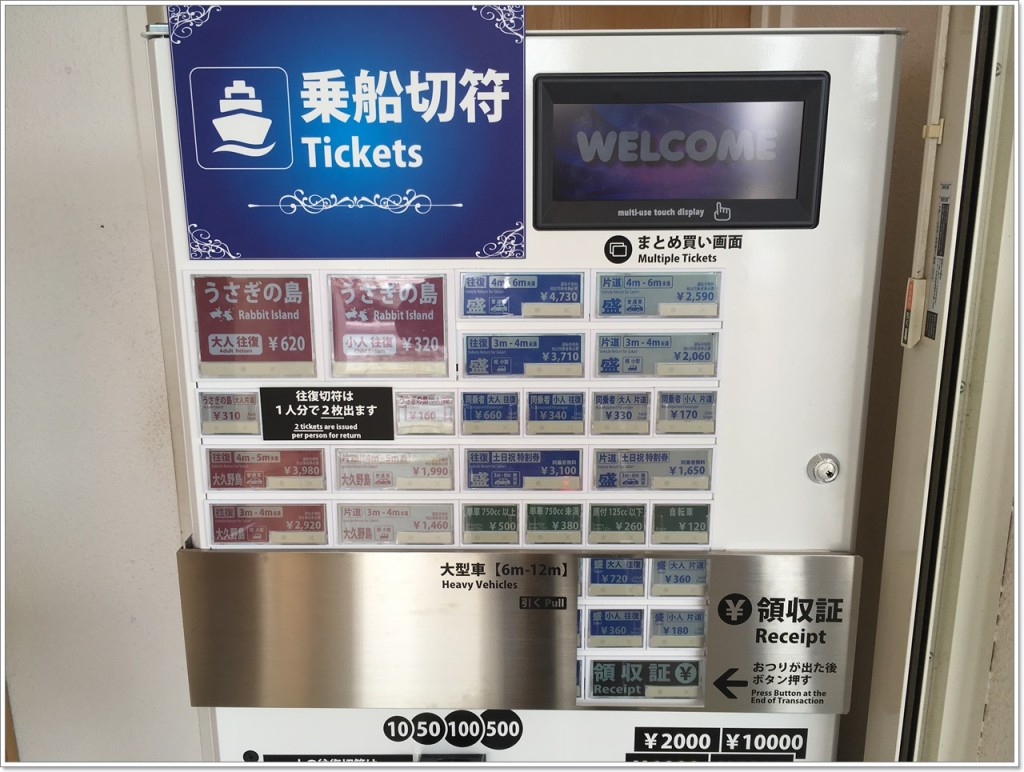
7.About staying of “Kyukamura-Ohkunoshima”
For accommodation in “Kyukamura-Ohkunojima”, I recommend the “ 24-hour Stay Plan “. (This plan is 12:00 check-in and check-out is 12:00. You can spend very slowly for this plan.)
How did you like it? Ohkunoshima is a very wonderful island that can touch rabbits and feel nature. Why don’t you go to “Ohkunoshima” which is the paradise of rabbits?
Have a nice trip! XD
<Let’s search the sightseeing information of Kansai in Japan on ‘ Japan’s Travel Manual ‘!!> <This site introduces the easiest way to get Japanese (Kansai) sightseeing spots to you.>
- Zoos & Botanical Gardens Aquariums
About Auther

JP Manual owner
Auther's Posts
Related Posts
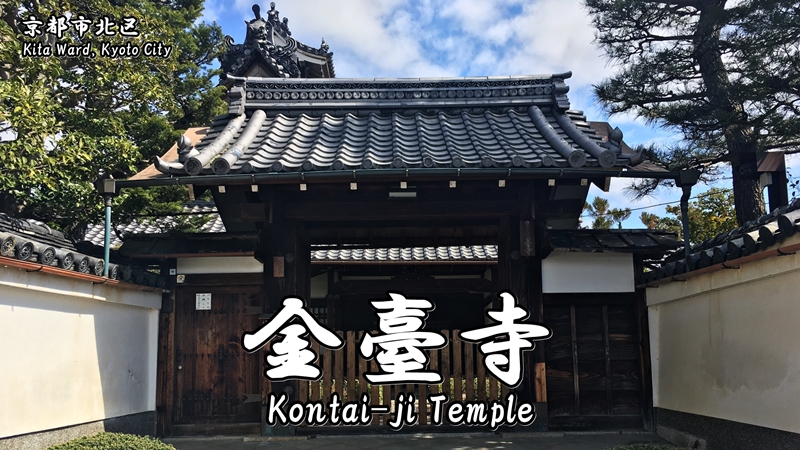
Directions and highlights of Kontai-ji Temple.
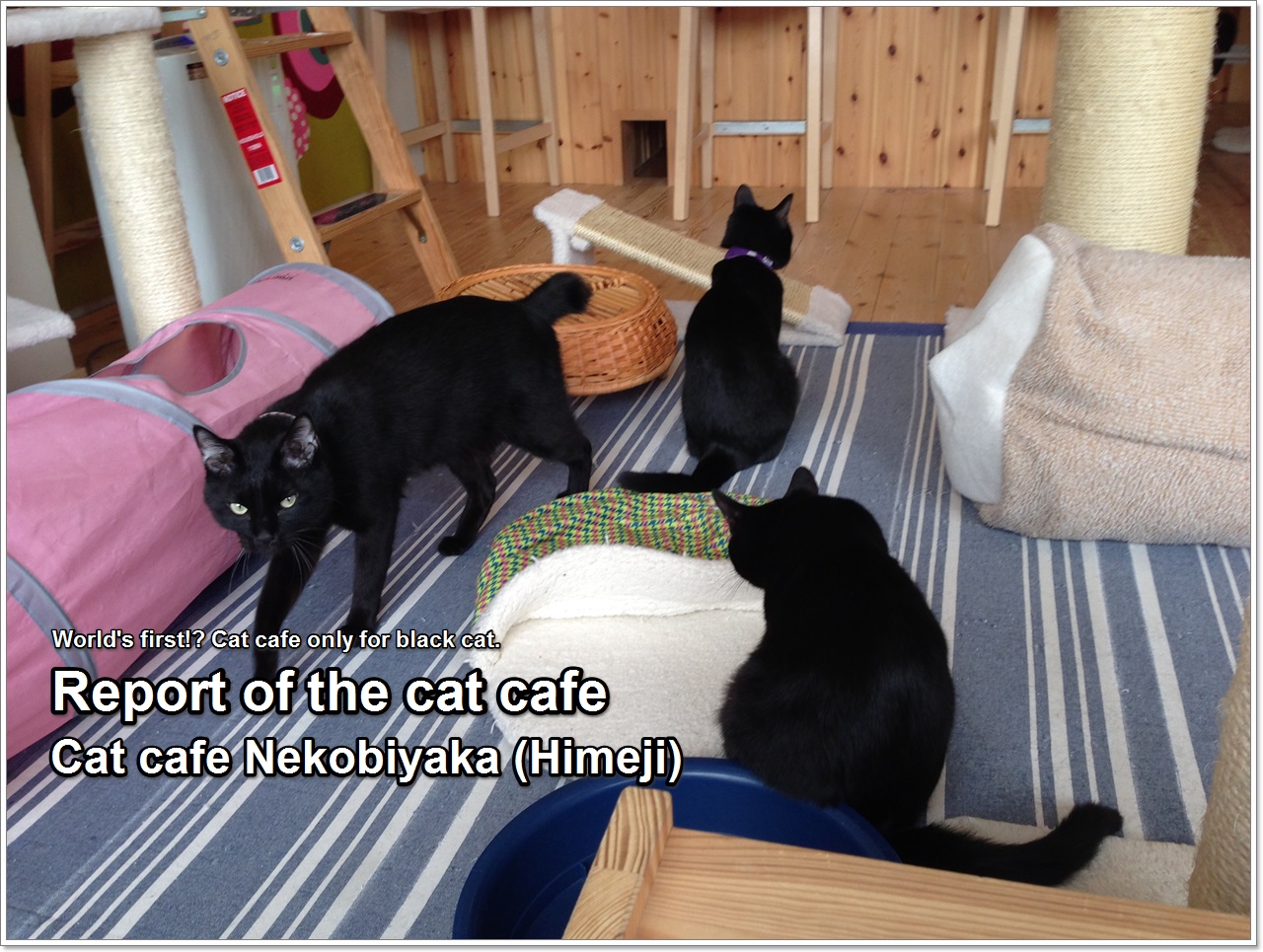
Highlights and how to get to Cat Cafe Nekobiyaka.
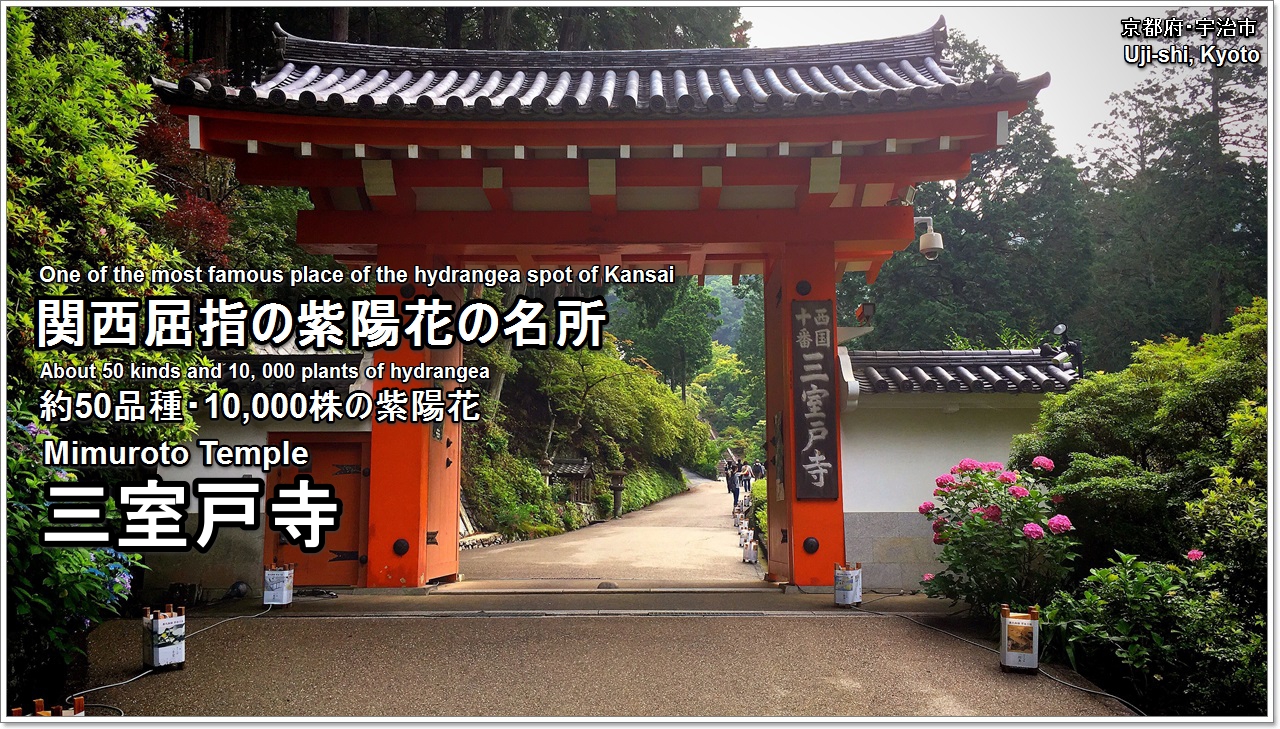
Highlights and how to get to Mimuroto-ji Temple.
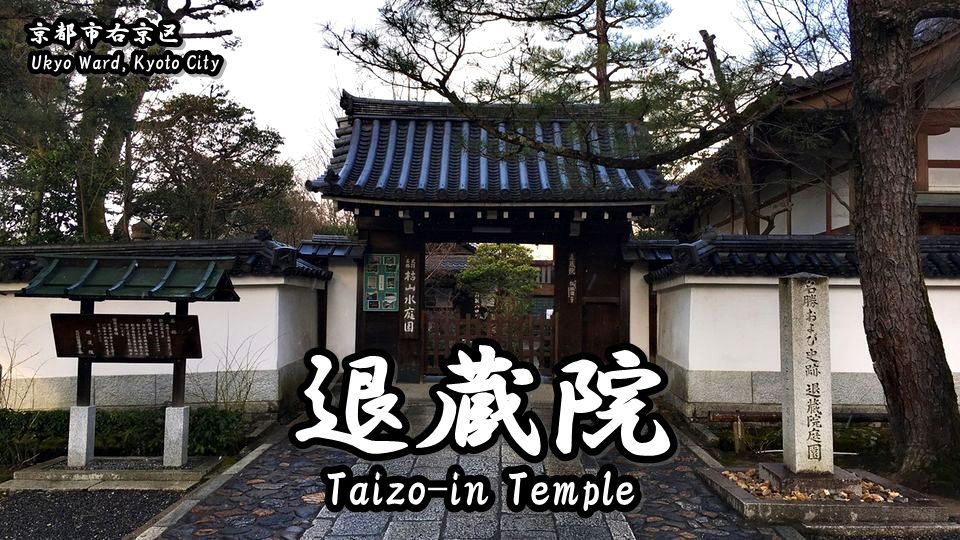
Directions and highlights of Taizo-in Temple.
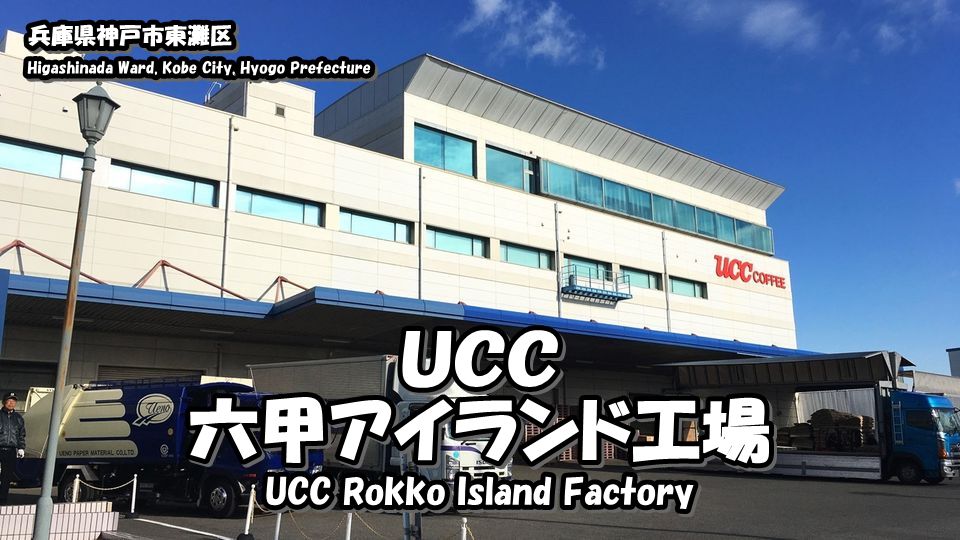
Directions and highlights of UCC Rokko Island Factory Tour.
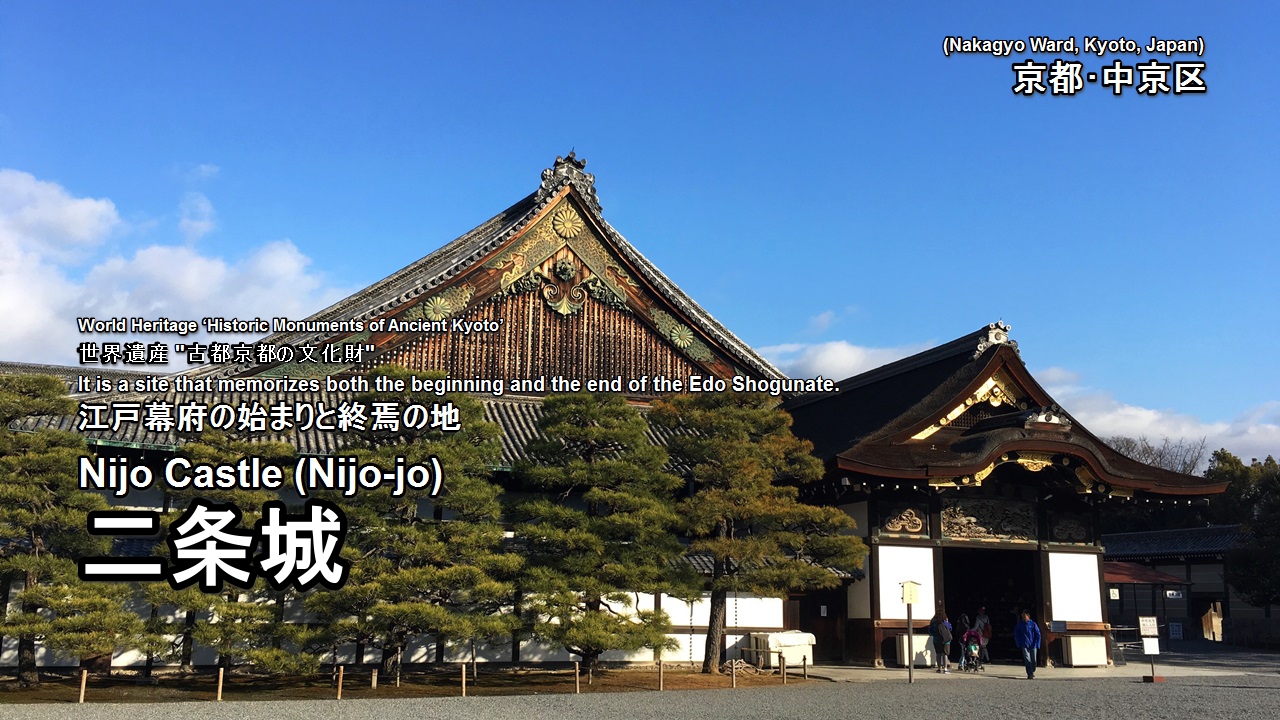
Highlights and how to get to Nijo-jo Castle.
Leave a Reply Cancel reply
Email(公開されません) 必須

Please input characters displayed above.
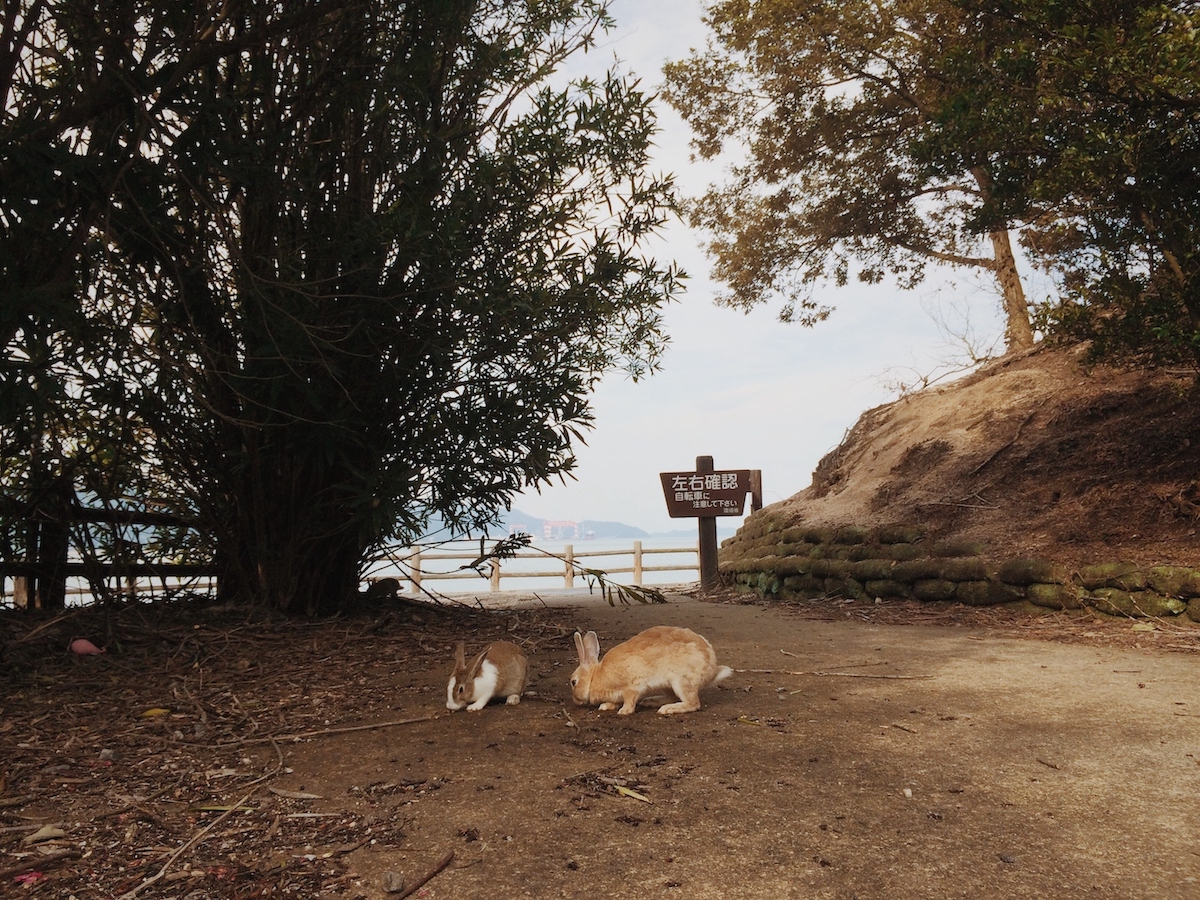
Everything You Need to Know About Visiting Okunoshima Rabbit Island
You may have heard of this furry destination by a variety of names: Usagi Shima, Okunoshima, Rabbit Island, or Bunny Island.
Okunoshima (大久野島) is Japan’s famous rabbit island where these fluffy creatures have taken over the mostly uninhabited land.
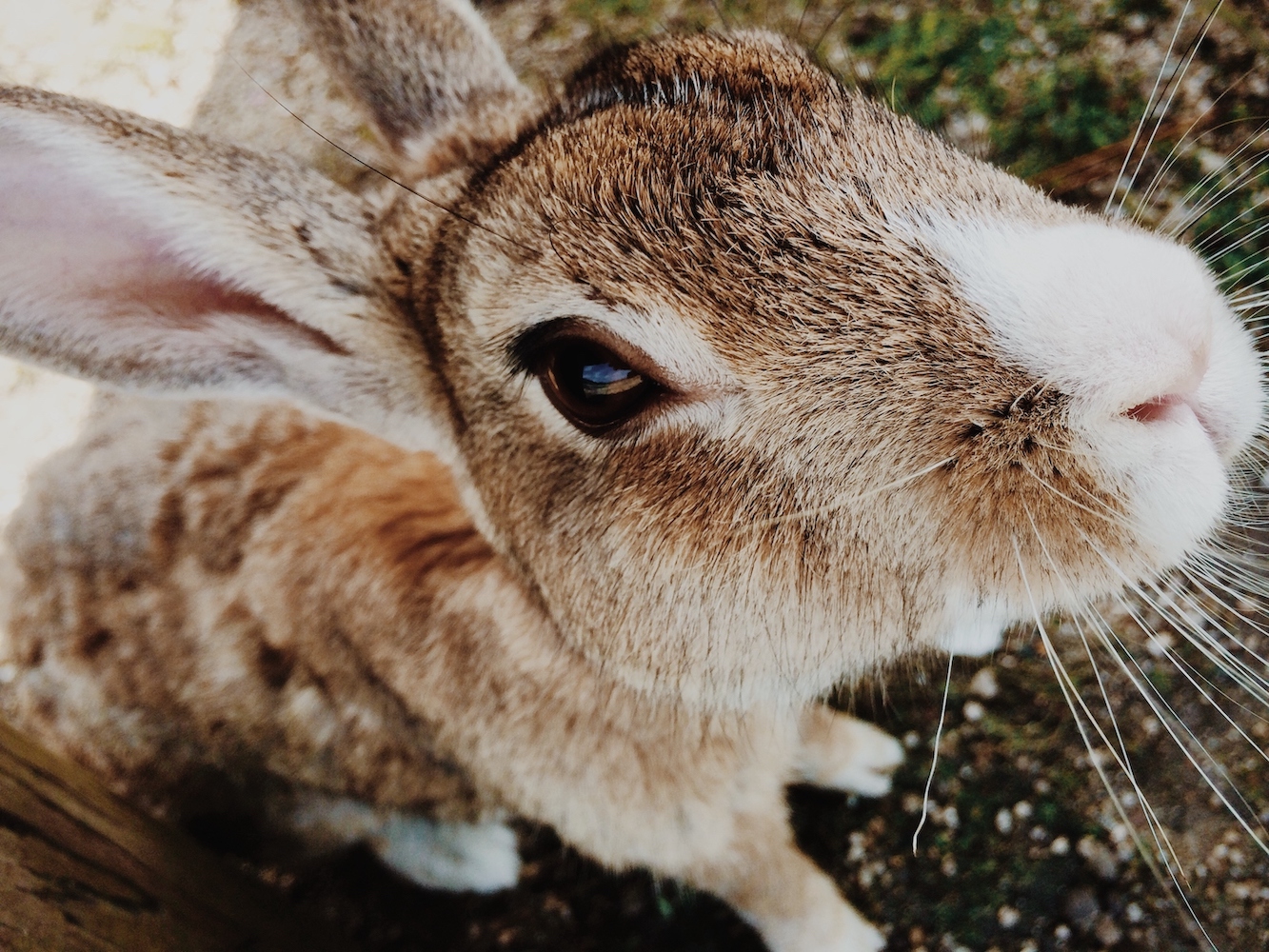
Despite the island’s dark origins as a poisonous gas factory during World War II, these wild bunnies have brought tourists from all over the world to the little island off the coast of Hiroshima.
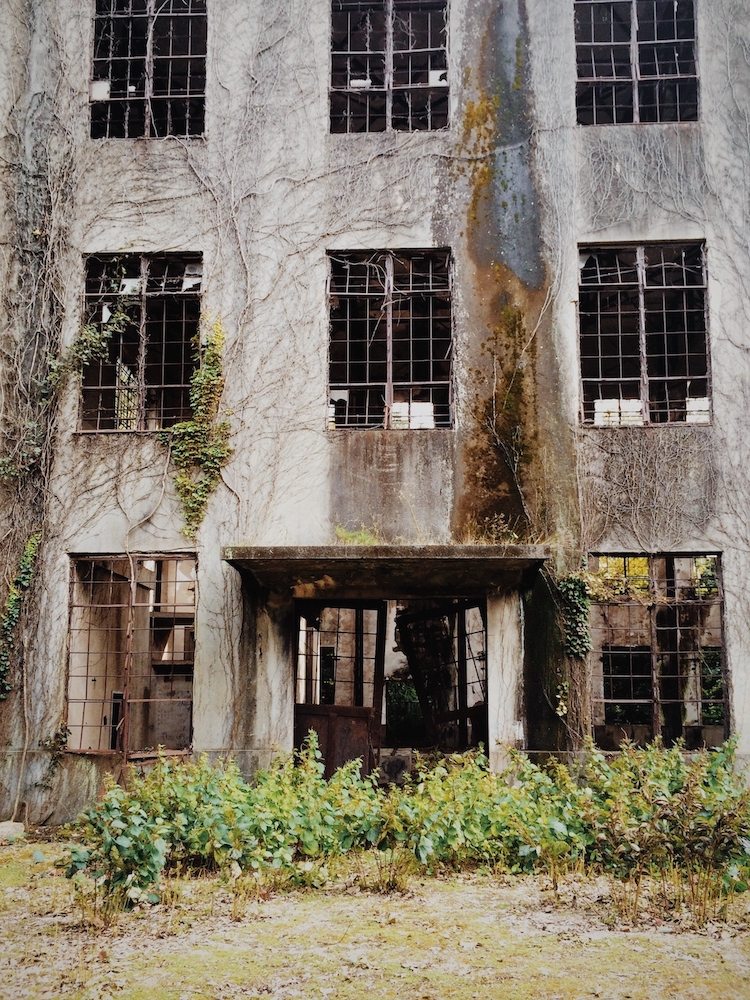
I visited Okunoshima when I was living and working in Japan and found that getting to the island can be a little tricky, especially if you don’t speak Japanese.
With this guide, you’ll find everything you need to know about visiting Japan’s Okunoshima Rabbit Island in one place.
Disclosure: This post contains affiliate links. By making a purchase through one of the links, I may receive a small commission at no extra cost to you. Thank you for your support and for helping me keep this blog up!
Where is Okunoshima?
Okunoshima is a small island located in the Inland Sea of Japan, approximately 70 km (43 miles) east of the city of Hiroshima.
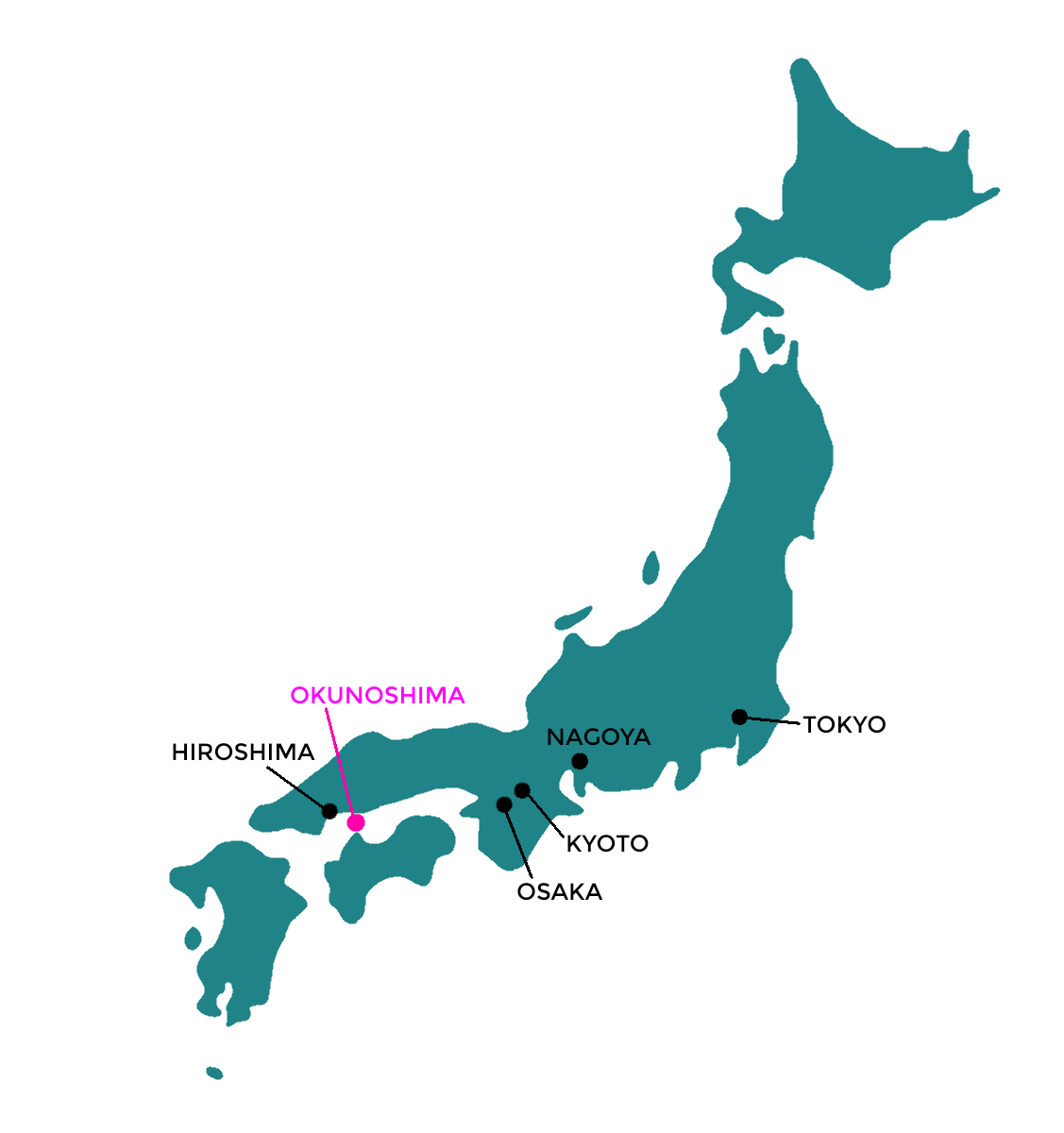
Where did the rabbits come from?
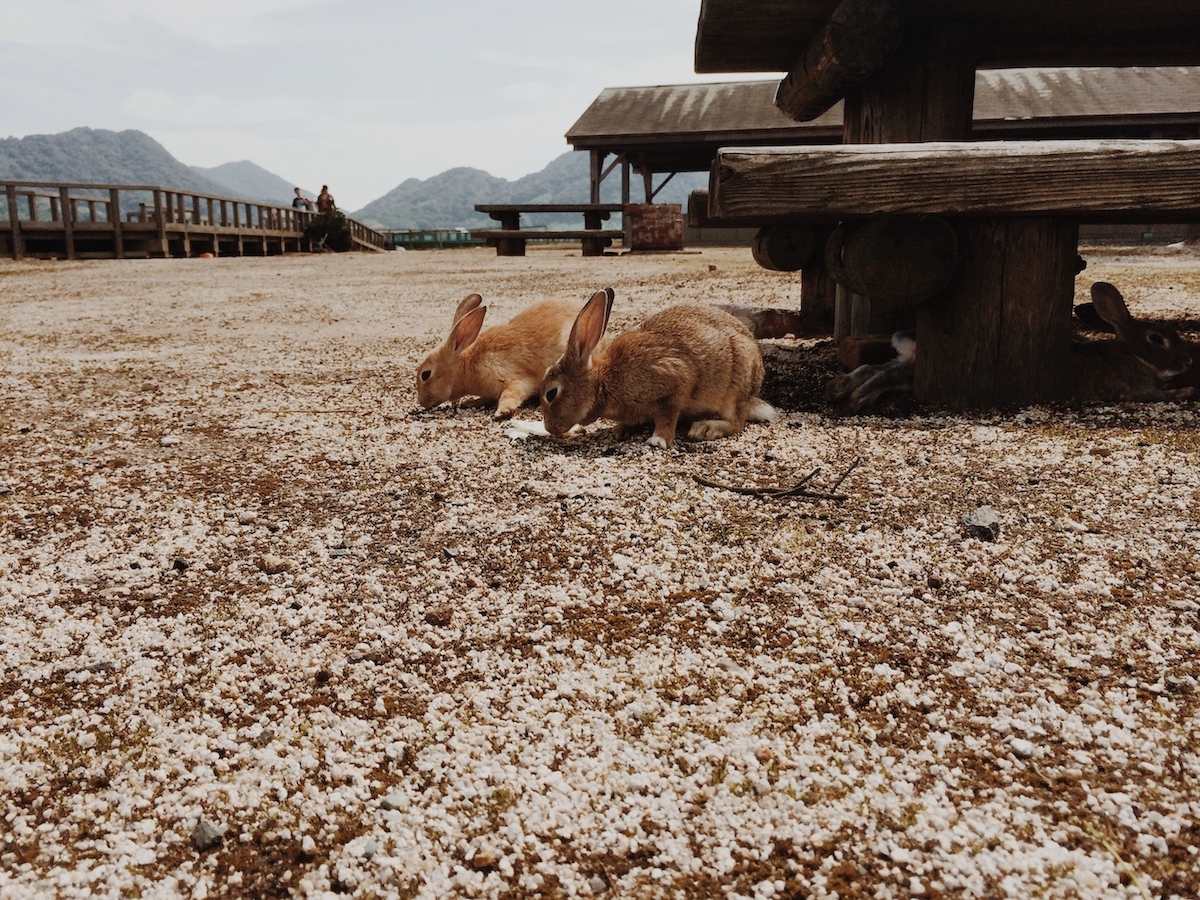
Originally, rabbits were brought to Okunoshima as test subjects in 1929 when the military began producing chemical weapons secretly on the island.
While rumors have circulated that the rabbits were released after the war and populated the island with their direct descendants, most experts believe that the original rabbits were most likely euthanized.
So if the test bunnies weren’t responsible for all of the rabbits on Okunoshima today, then where did the rabbits come from?
It’s believed that several rabbits were brought over and released by schoolchildren around 1971.
And because there are no natural predators on the island, the rabbits quickly populated and turned Okunoshima into the fascinating tourist attraction that it is today.
How many rabbits are on Rabbit Island?
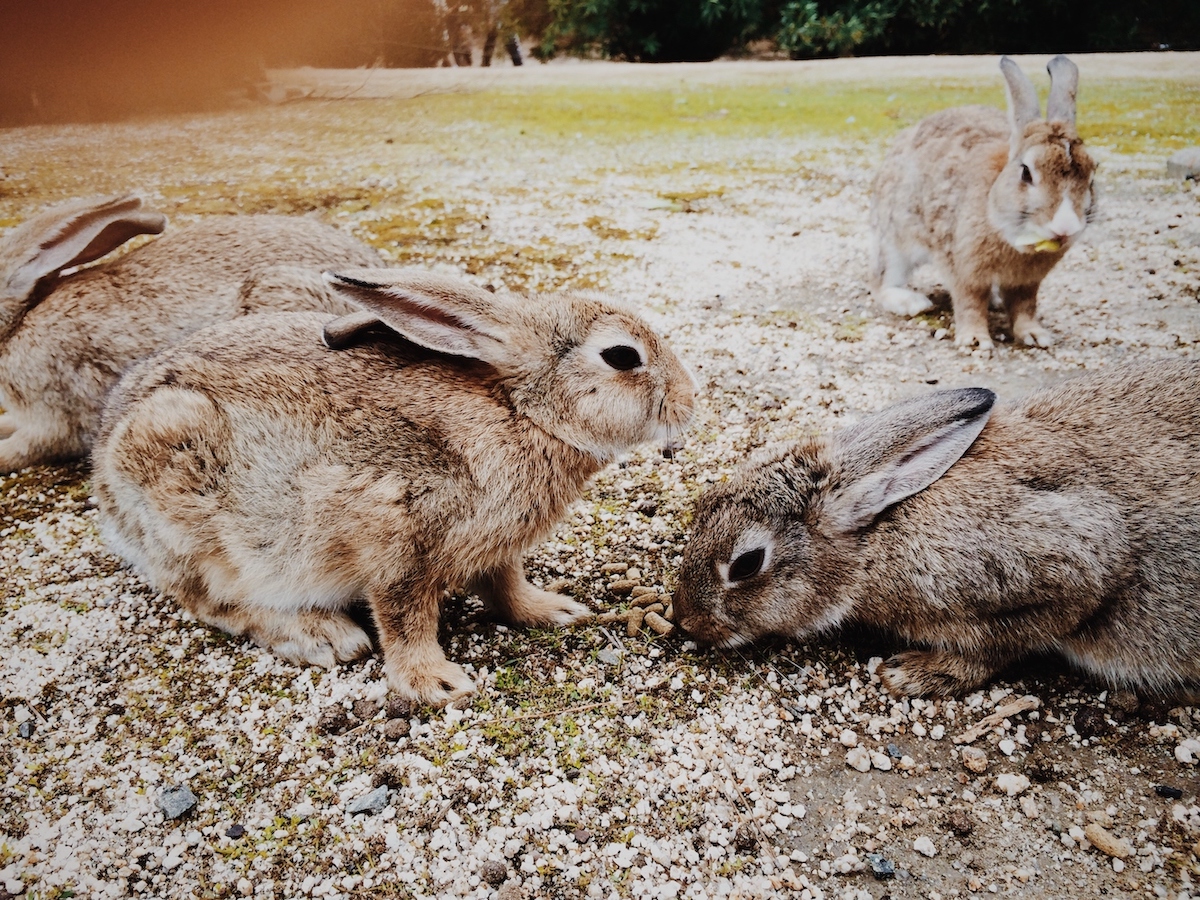
Today it’s estimated that there are around 1,000 rabbits on the Japanese island.
Is Rabbit Island worth visiting?

Okunoshima is a beautiful island to bike around while learning about its significant history during World War II— and its lasting effects— alongside furry friends.
The ruins of the former buildings still remain and the signage that explains each of the abandoned sites provides for an educational experience.

For those visiting with the sole purpose of interacting with the rabbits, be prepared for a bit of a different experience than planned.
The island is currently overrun by the mammals and as a result, there is a lack of vegetation for them to feed on.
The rabbits have ended up depending on tourists for food, which is often not appropriate or nutritious for the animals.
The scarcity of proper food has led to health issues, illnesses, and injuries from fighting amongst the other rabbits.
Unfortunately, it’s not uncommon to see rabbits with lacerations or severe wounds.

Can you feed the rabbits?
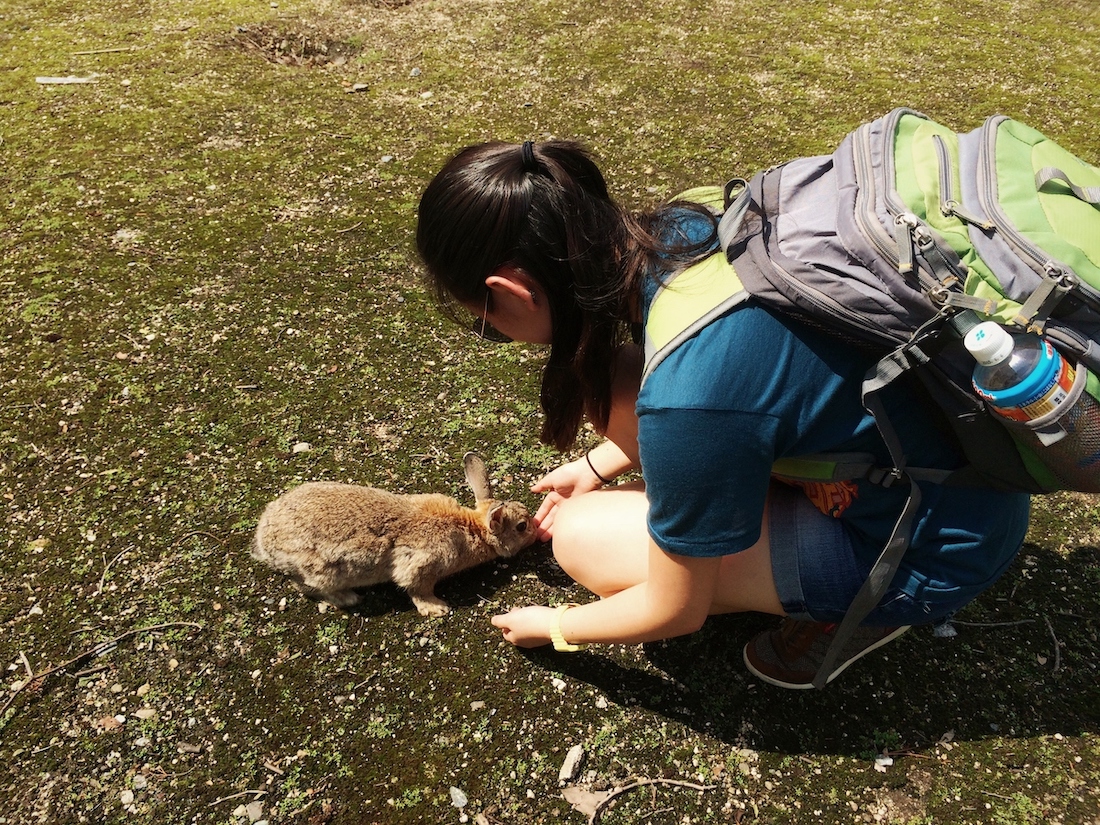
While wildlife experts don’t recommend feeding wild animals, the practice is wildly accepted and encouraged on Okunoshima.
If you do choose to feed the rabbits, it’s better to either purchase proper rabbit food from the visitor’s center (about ¥100 for a small bag) or you could always bring your own.
Other important things to remember that will help the rabbits
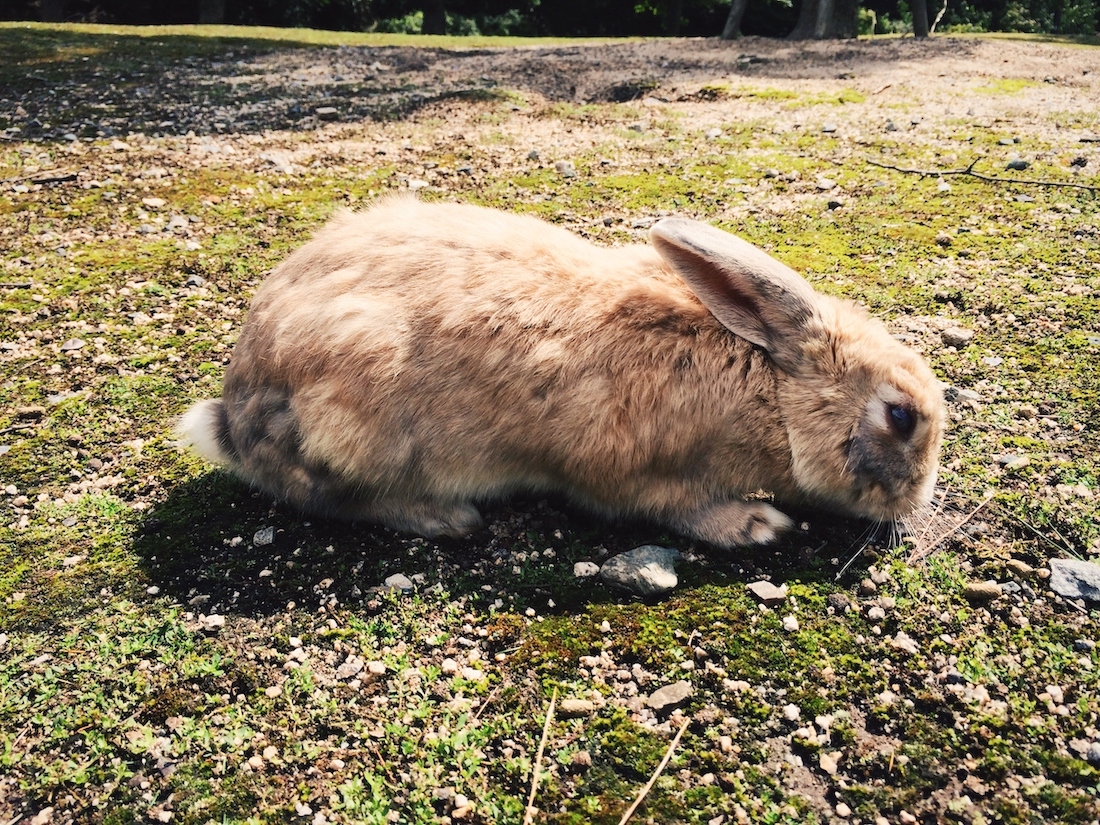
- Don’t feed them any human foods or snacks.
- Don’t feed them cabbage or lettuce. Although many tourist and blog sites say you can buy vegetables from the convenience store before you hop on the ferry, these leafy greens are extremely innutritious for rabbits and even harmful for their digestive system, often causing bloating.
- Don’t pick them up, chase them, or try to force interaction with them. While they might look friendly, they can become aggressive if stressed.
Can you live on Okunoshima Rabbit Island?
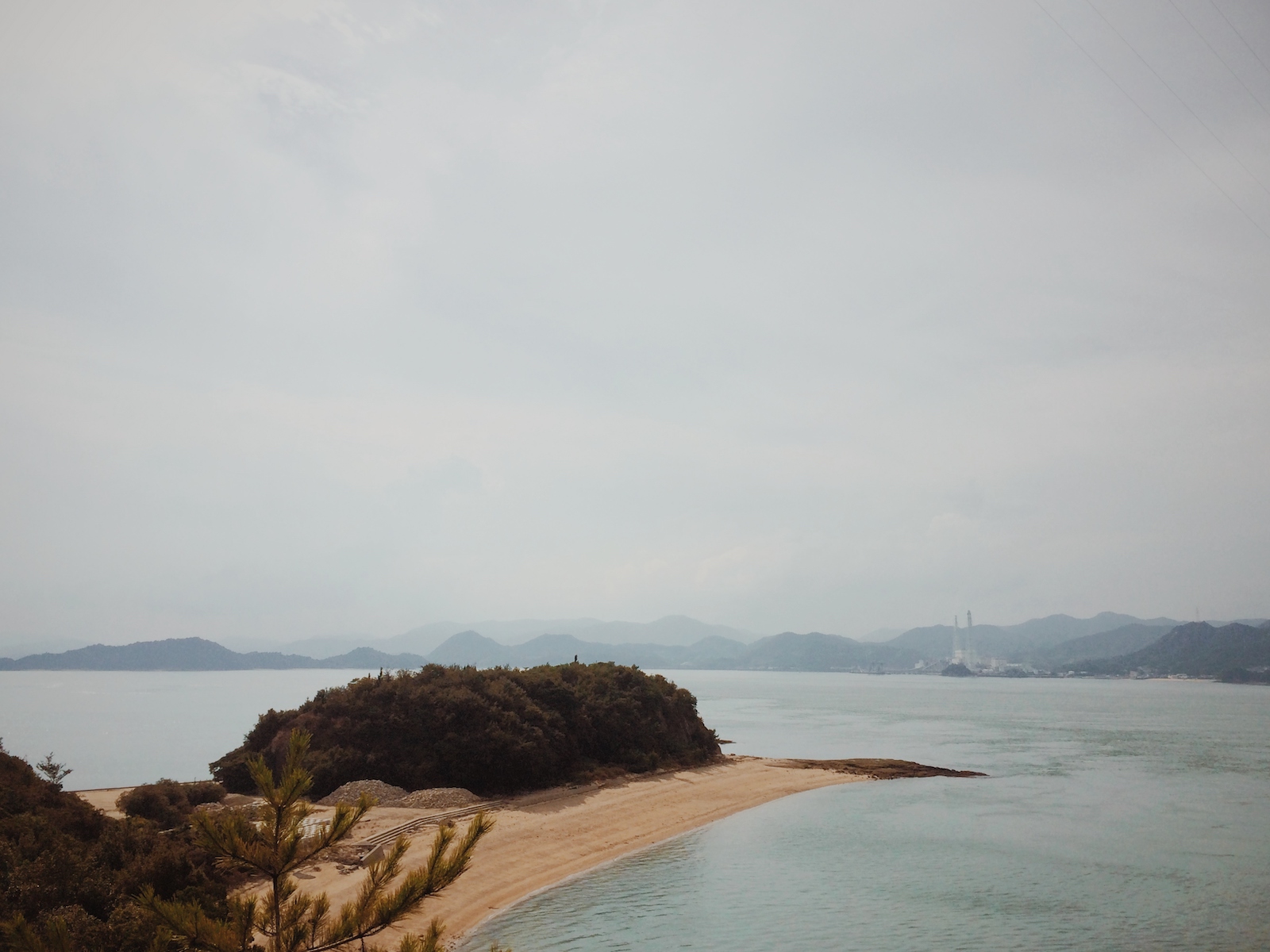
No, the only people who live on the island are those who work at the island’s resort.
What else is there to do on Okunoshima?
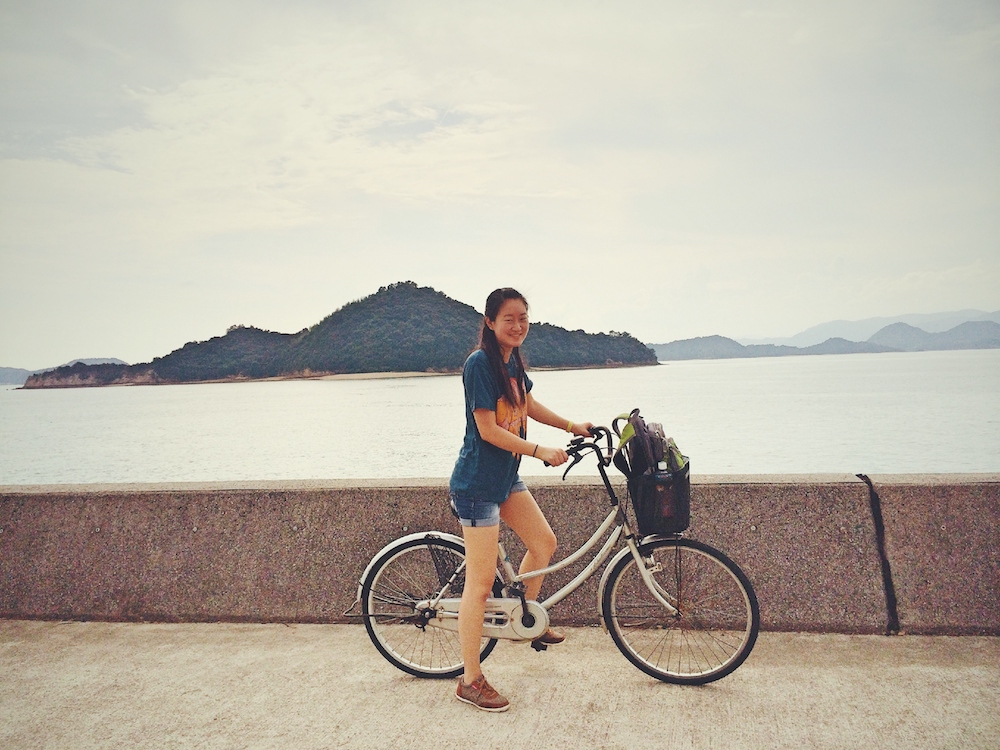
While the main attraction of the island is of course the rabbits, Okunoshima offers a small selection of activities, including the following:
- Poison Gas Museum
- Abandoned sites throughout the island with explanations
How do you get to Rabbit Island from Hiroshima?
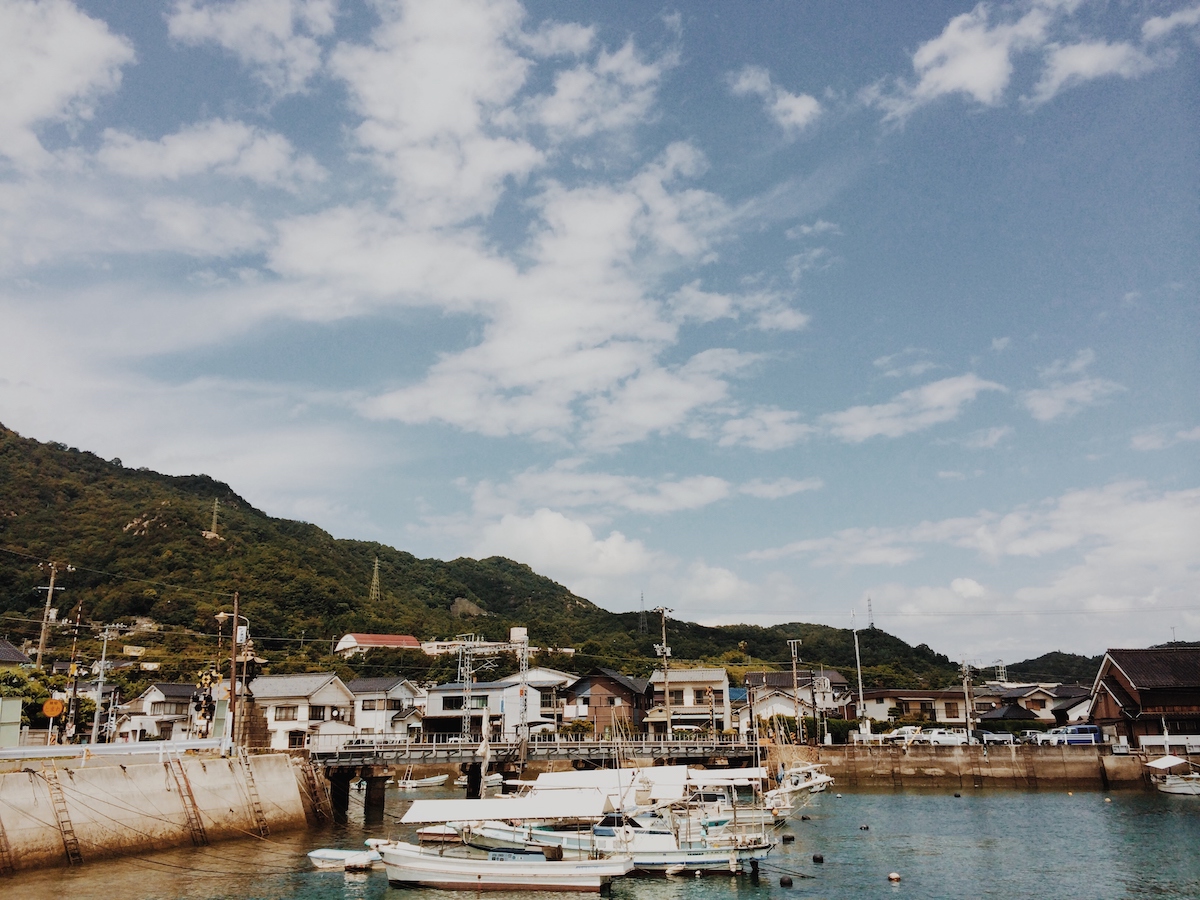
Here’s the easiest way to get to Rabbit Island Okunoshima from Hiroshima:
1. Take the Tokaido-Sanyo Shinkansen (bullet train) to Mihara Station (~30 minutes)
2. At Mihara Station, transfer to the Kure Line (a local train) bound for Hiro (3 stops, ~25 minutes)
3. Get off at Tadanoumi Station
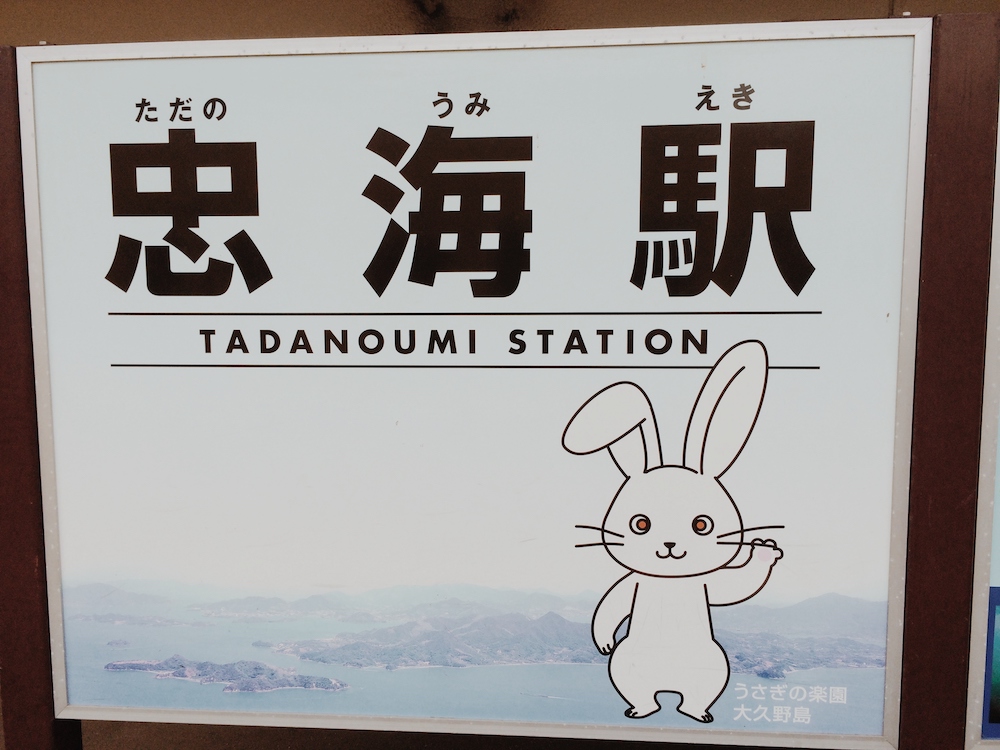
4. Turn right and walk down the street until you hit the bridge
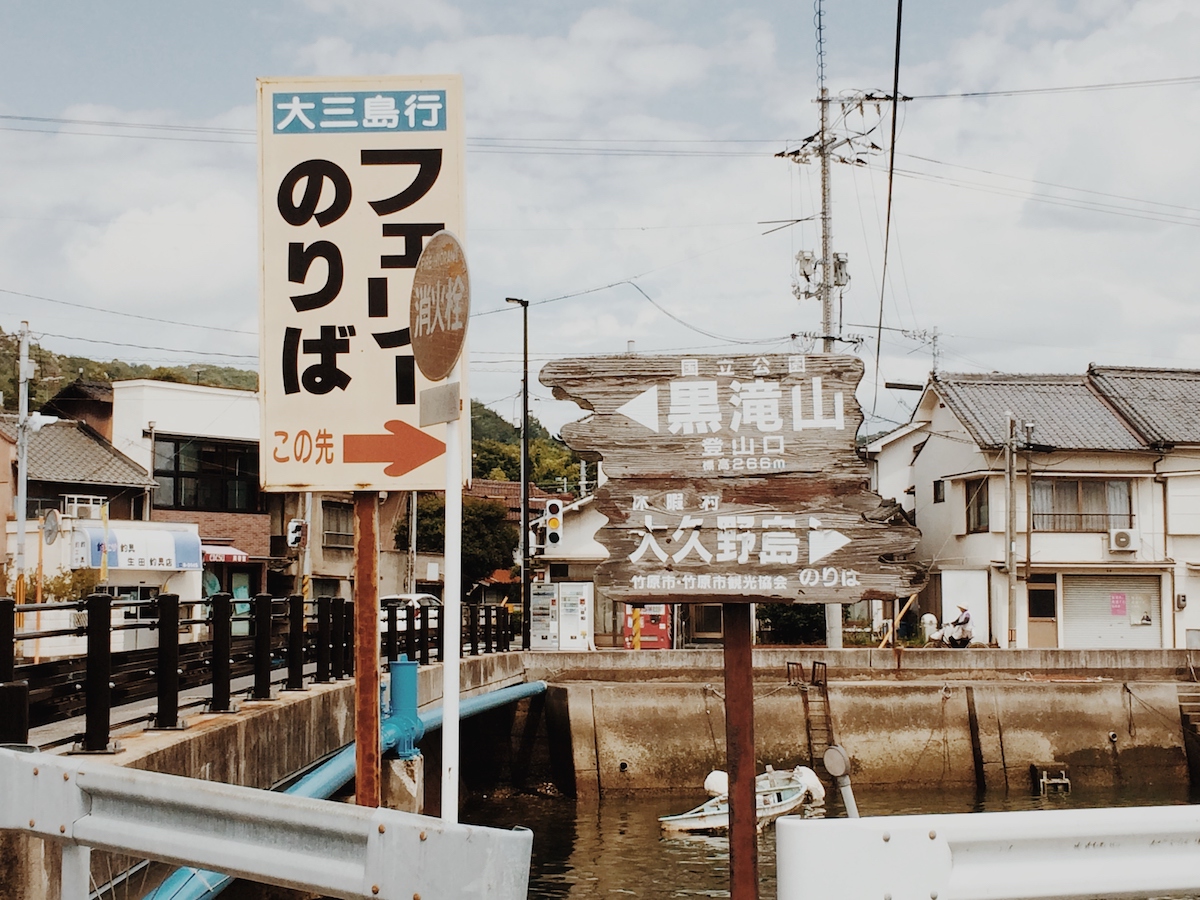
5. Follow the road to the right which will take you to the ticket office and pier (~10 minutes’ walk from the station to the ferry)
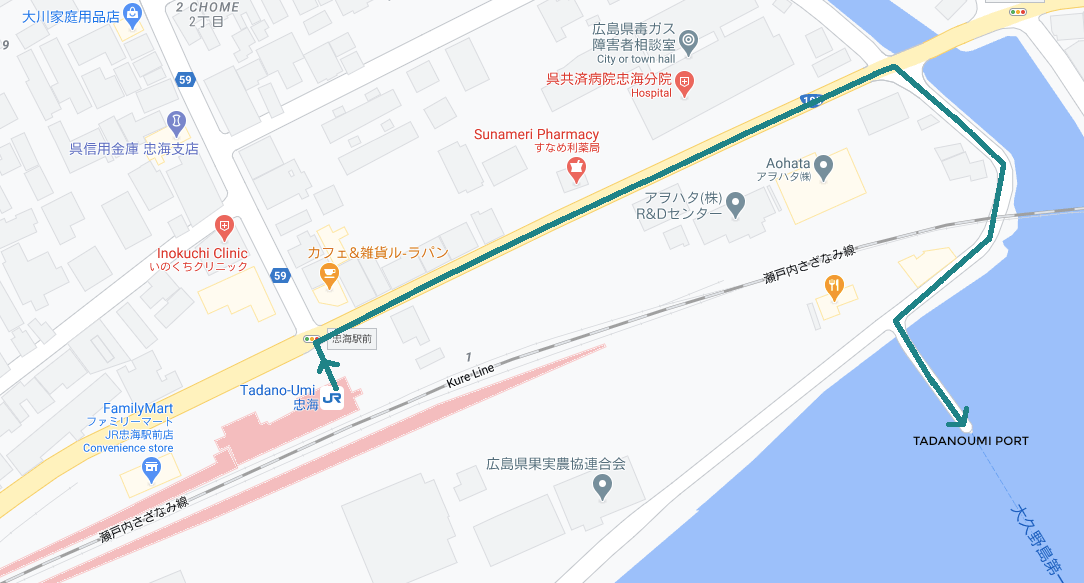
In total, from Hiroshima to the ferry, it’ll take about an hour and 15 minutes and more or less ¥3810.
For a cheaper option that takes a bit longer, instead of the shinkansen you can take the regular JR Sanyo/Kure Line from Hiroshima to Hiro Station, then the local Mihara Line to Tadanoumi which will take approximately 2 hours in total to reach the ferry and about ¥1520.

How much does it cost to go to Rabbit Island?
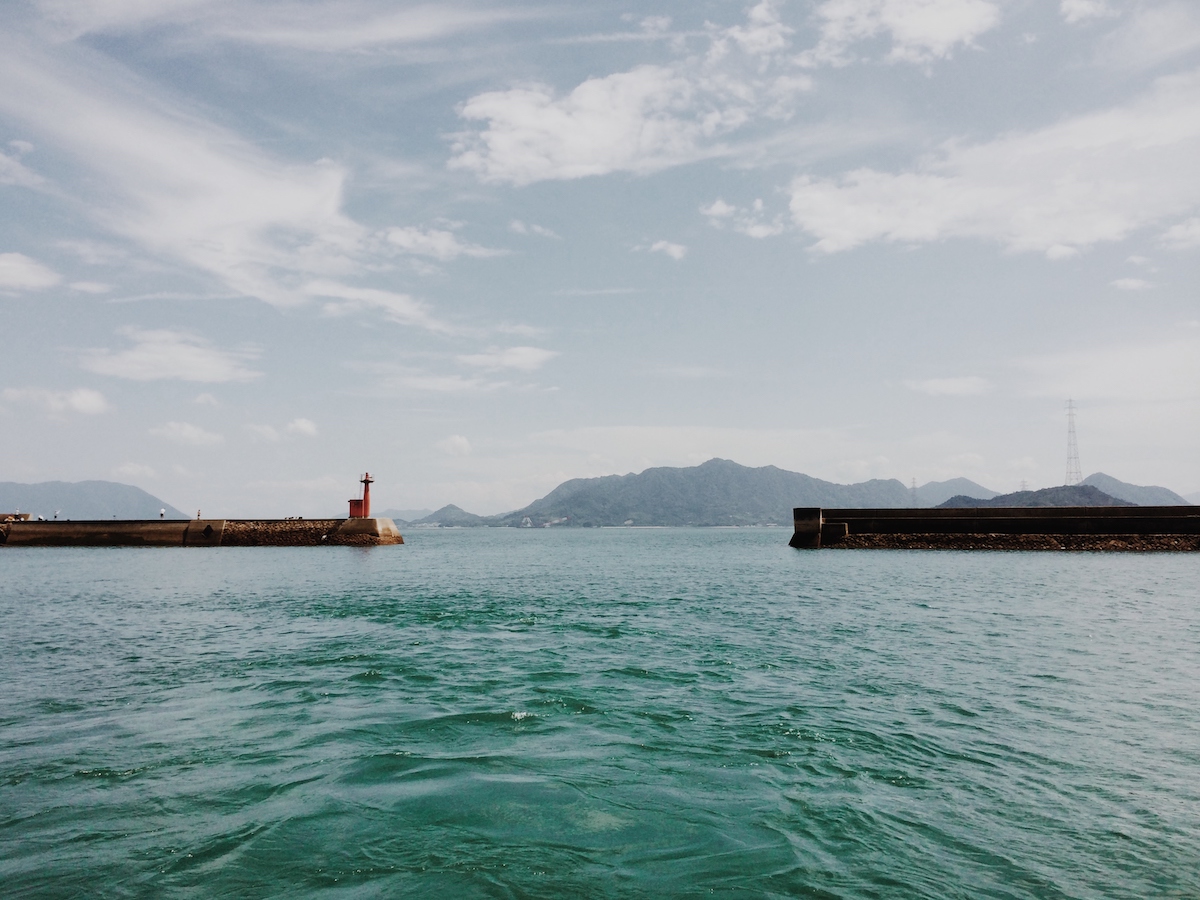
There’s no entrance fee for visiting Okunoshima, so your costs will include transportation fees to Tadanoumi Station and the ¥620 round trip ferry ride.
What time does Rabbit Island open?
The island does not close, but the ferries to Okunoshima from Tadanoumi port begin at 7:40 in the morning with services running approximately once per hour until 7:15 p.m.
This was the most recent schedule as of January 2021. You can find and verify the latest ferry timetable here .
Pin and Save for Future Adventures!
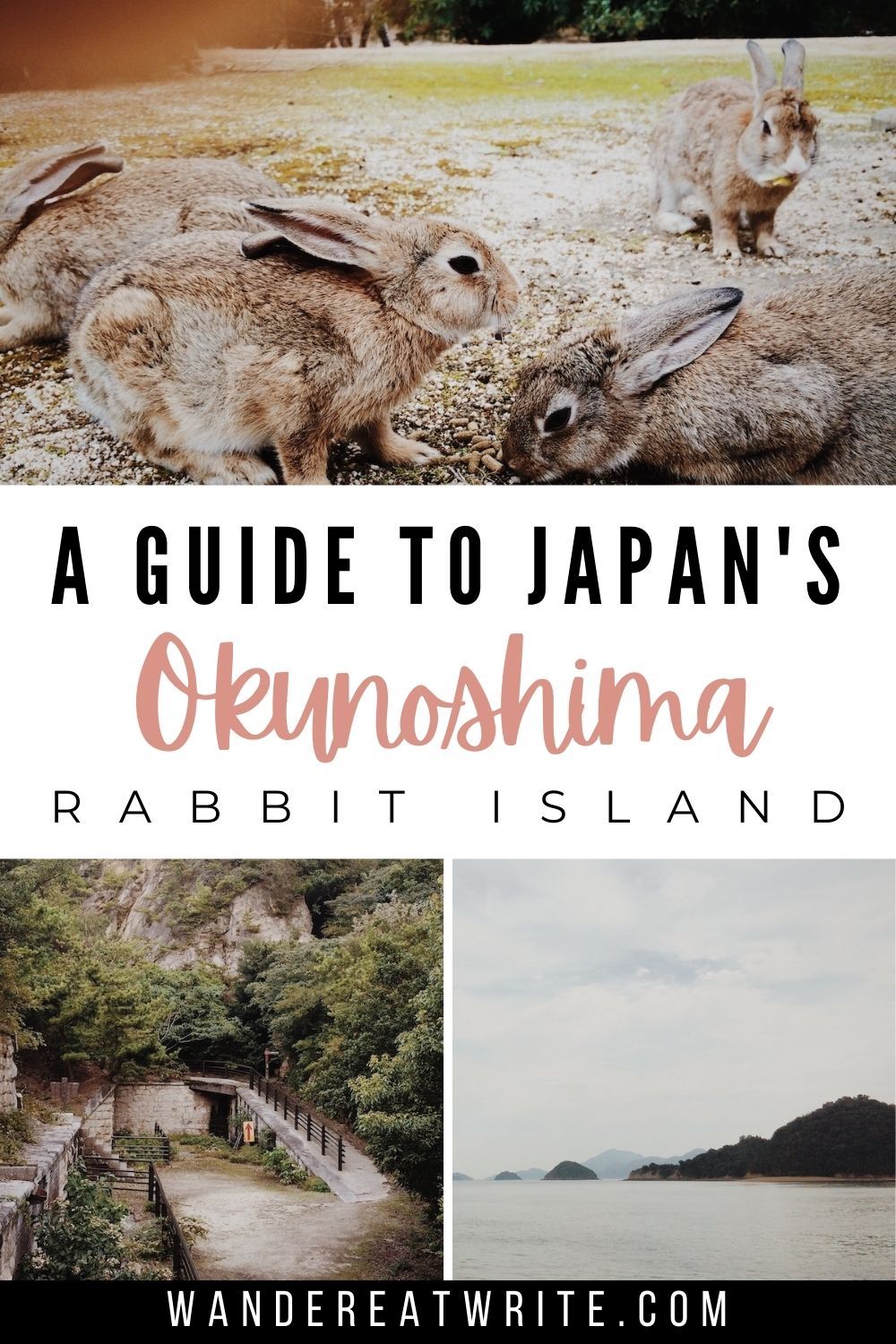
Michelle is a freelance writer who has traveled to all seven continents and 60+ countries through various forms of employment. Over the last ten years, she’s worked as an ESL teacher in Japan, a youth counselor aboard cruise ships, and a hospitality manager in Antarctica.
Related posts
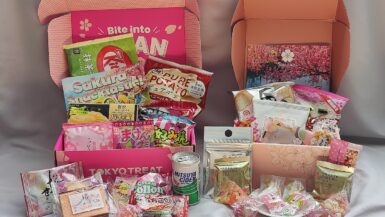
Sakuraco vs Tokyo Treat [2024]: What’s the Difference?
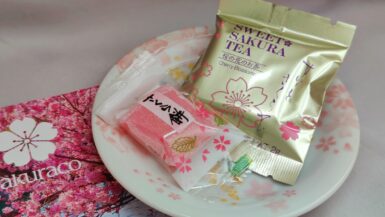
Sakuraco Review: Is It Worth It? [2024]
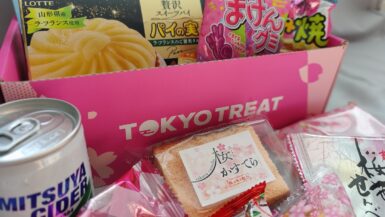
Tokyo Treat Review: Is It Worth It? [2024]
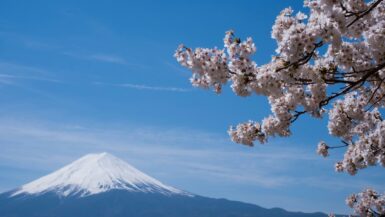
Is It Worth Going to Japan in Cherry Blossom Season? Tips from a Local
Leave a reply cancel reply.
Your email address will not be published. Required fields are marked *
I’ve never heard of this island before but it’s so cute! Definitely adding this one to my bucket list.
What an adorable place! I have so much left to explore out in Japan. Adding this to the list!
Wow! I would love to visit Rabbit Island one day. They are adorable!
Oh, Okushima and Aoshima (cats) islands where places I wanted to go while I was in Shikoku. I am planning to go back when it’s safe again to travel, so will definitely save this post. These rabbits are so cute!
Aoshima is on my list too!
This has been on my bucket list for years! I so want to go and visit the bunnies. Though you have given me food for thought on the ethics of the place… If the rabbits are so populated that they rely on humans for food as they have eaten everything, that is not a good thing. If they are going to be used as a tourist attraction they are no longer completely wild and so should be cared for by someone. I also didn’t realise that there was so much history to the island.
Yes, it’s a tricky problem. It would be great if natural vegetation could be revitalized in the area but officially no one is responsible for the rabbits or their wellbeing. However, I do think the poison gas museum alone is reason enough to check out the island as the impact from learning about the atrocities that occurred during the war hits different when you see its effects rather than just reading about it.
I can’t believe I’ve never heard about this place! So amazing!
Privacy Overview
Privacy Policy - Terms and Conditions

Rabbit Island Japan: Okunoshima

Hiroshima Prefecture is a popular tourist destination, well-known for the Atomic Bomb Dome , the Peace Memorial Museum in Hiroshima City and the sacred island, Miyajima . Very few people know that there’s another “treasure” to explore: Okunoshima also known as “Rabbit Island Japan”.
Yes, that’s right! There’s an island full of rabbits here in Japan. Well, if there’s “ Cat Island ” and even a “JR Station Master” who is actually a cat , then why not also have an island inhabited mostly by rabbits?
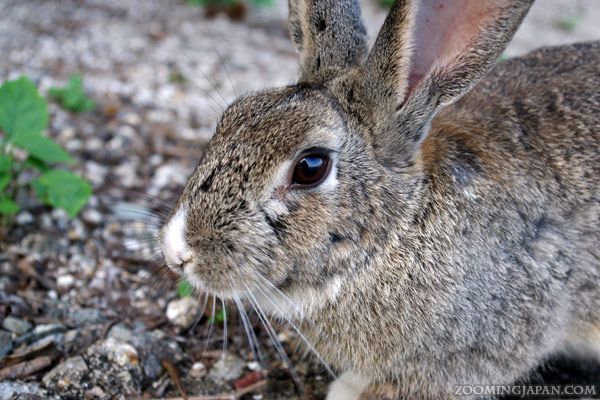
How to get to Rabbit Island Japan
Okunoshima (大久野島) is located in the Seto Inland Sea and belongs to Takehara City, not too far from Hiroshima City, in Hiroshima Prefecture ( map ).
The small island, which is also known as “Rabbit Island” (ウサギ島), can be reached by ferry from Tadanoumi (Hiroshima) or Omishima (Ehime).

Access via Hiroshima
The vast majority will approach “Rabbit Island” from Hiroshima. Just take a train or a bus to get to JR Tadanoumi Station .
From JR Hiroshima Station it takes less than 2h, from JR Mihara Station (with Shinkansen stop) only about 20 mins to get to JR Tadanoumi Station. There are also buses, but usually less frequent than trains.

The ferry terminal is literally around the corner from the JR Station. I managed to walk there in 2 mins, but I’m quite fast. As long as you have about 5 mins, that should be enough. A one-way ticket from Tadanoumi (忠海) to Okunoshima (大久野島) costs 310 yen . The ferry ride only takes about 12 mins .
The ferry schedule is in Japanese, but Google Translate will help.
Your 1st Stop: Hotel Kyukamura
Once your arrive on Rabbit Island there will be a free shuttle bus (normal-sized bus) waiting for everyone. It will bring you to the only hotel on the small island “ Kyukamura ” (休暇村大久野島). If you have a lot of luggage you can store it there. I’m sure they’ll take it even if you’re not a staying guest.
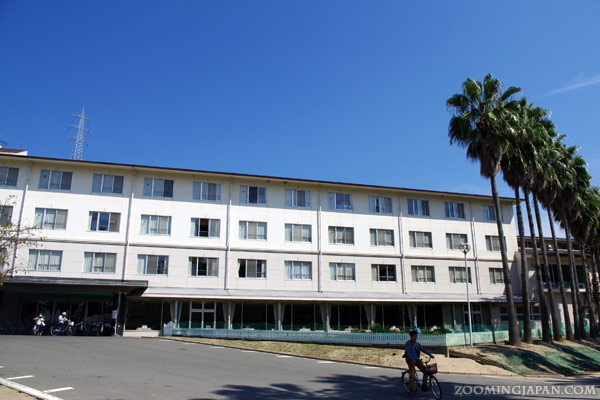
You can rent a bicycle there. They have a lot, even smaller ones suited for children and motorized ones for older people. The island is quite small with a circumference of 4.3km , so I recommend walking instead! After all, you’ll have to get off the bicycle a hundred times to feed the rabbits. It’s just going to be in the way – and there are a few slopes as well. Cars are not allowed – only the people working on the island and the bus can drive around at a VERY slow pace in order to protect the rabbits.
As it’s a hotel, you can of course stay overnight. There’s also a small (souvenir) shop and a restaurant – pretty much your only chance to get food on the island.

That’s also where I ate lunch, trying the local speciality called “ Takoten Zaru Udon ” (タコ天ざるうどん). Delicious!
The restaurant is only open during lunch time, not in the evening!

The hotel is also the place where you can buy dry food for the rabbits . One plastic cup for 100 yen . I bought one and it was enough for the whole day. The cups have no lid, so if you’re alone it might be difficult to hold the cup and take photos at the same time. I prepared a little plastic bag that I could wrap around the cup / the food and put it into my bag when I didn’t need it.

Of course, you can also bring food suited for rabbits from back home such as cabbage or carrots . There are pamphlets in the ferry telling you how to treat the rabbits and what kind of food they can and can’t eat. If you’re unsure, definitely read it. Even if your Japanese is not so good, they have a lot of pictures in the pamphlet, so you’ll understand.
The “Dark” History of Okunoshima

Okunoshima has not always been a tourist destination. In fact, it has a very dark past.
A few fishermen families used to live there, but everything changed when the Imperial Japanese Army decided to develop chemical weapons on the small island. From 1927 to 1929 a plant was built where poisonous gas was produced.
As Japan had signed the Geneva Protocol it wasn’t allowed to use chemical weapons. The production and storage were not forbidden, though.
Okunoshima was chosen as the place of production for poisonous gas because they wanted to keep it a secret. The remote island was far away from Tokyo and other major cities in case there was an accident while experimenting with the chemical weapons.
Okunoshima Poison Gas Museum
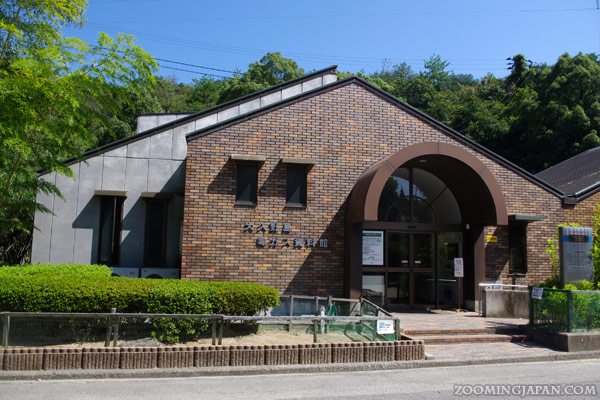
The “ Okunoshima Poison Gas Museum ” (毒ガス資料館) opened in 1988 . For 100 yen you can go inside (open 9:00 – 16:30). Photos inside were not allowed.
You’ll find a lot of shocking photos and information about what has been kept secret for a long time:
Residents and potential employees were not told what was being produced in the factory. Working conditions were extremely hard and the “protection suits” were a joke. The workers wore rubber uniforms, anti-poison gas masks, gloves and long boots, but that was not enough to keep the gas completely away from them. Many got sick after being exposed to poisonous chemicals every single day with diseases such as conjunctivitis , respiratory illness .
In the plant, balloon bombs, signal barrels, pipes and different kinds of toxic gases were produced. However, the priority was given to the production of Yperit gas . The latter can cause severe pain and skin blistering within 2-3h. When inhaled it can lead to injuries all over the body.
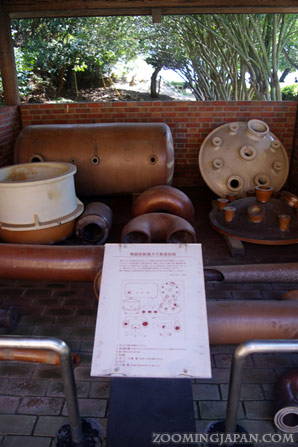
After the war the Allied Occupation Forces got rid of the gas by dumping, burying or burning it. They got rid of related documents and all the people involved were asked to keep silent about the fact that kilotons of poisonous gas were produced there from 1929 until 1945 . Okunoshima was even erased from WWII-era maps at that time.
It was not until 1984 (!!) that it became public that Japan had carried out chemical warfare.
Ruins of the Former Power Plant
In the photo below you see the ruins of the former power plant of Okunoshima.
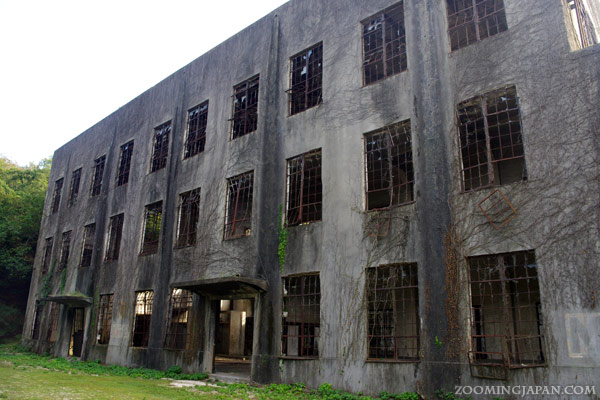
A very spooky atmosphere that is disrupted by the cute rabbits that hop around everywhere nowadays. As it is a ruin, you’re not allowed to get too close to it, let alone to go inside.
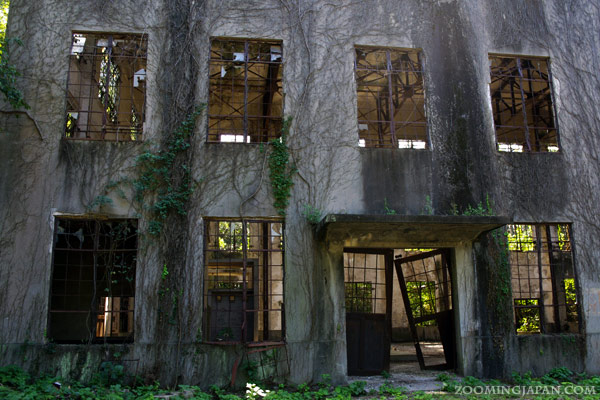
It’s a great spot for “haikyo” (廃墟, ruin) fans!
Ruins of Former Batteries
Besides the power plant you’ll find some other remains on “Rabbit Island”.
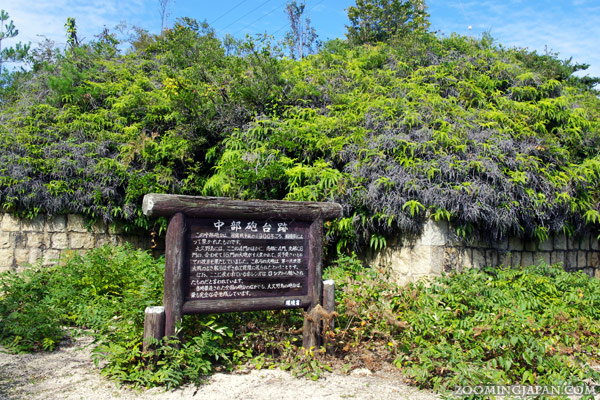
Here’s a map of the small island, so if you have a bit if time and can bring yourself to get away from the rabbits for a second, there’s more to explore.

There are ruins of former batteries. Here you see the ones of the “ Middle Battery ” (中部砲台跡).
Even there were rabbits! Can you spot one?
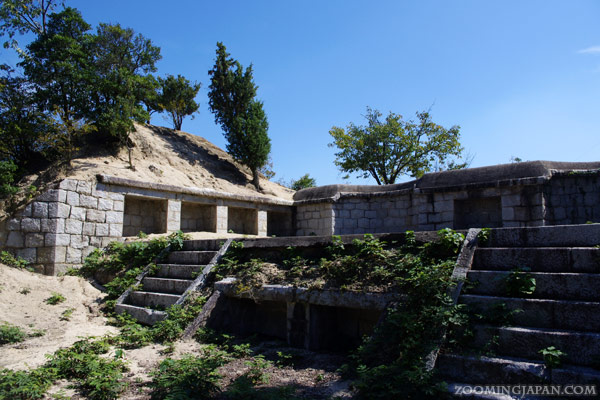
This also belongs to the “Middle Battery”. From there you can walk to the “ Northern Battery ” which is close to the shore while the middle one is on a hill.
From “Toxic Island” to “Rabbit Island”
We learned a lot about Okunoshima’s dark history. Of course, it doesn’t sound like a place people would want to visit, right?
Furthermore, it’s a super tiny island, so why even bother?

Yet it’s a tourist destination nowadays. There’s a hotel, a golf and tennis court, a camping site, beautiful beaches, an observation deck offering views of the Seto Inland Sea and of course the uber-cute rabbits.
But how come there are all these rabbits in the first place?
There are actually two theories about the origin of the rabbit population on Okunoshima.
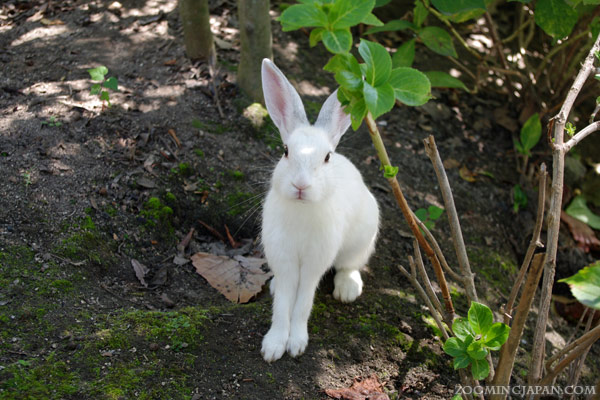
Theory 1: The guinea pigs were freed after the war.
It is said that rabbits were kept as guinea pigs to test the effects of the poisonous gas. After WWII when the factory was closed, workers freed the remaining rabbits.
However, the former director of the “Okunoshima Poison Gas Museum swears that no rabbits were used to test the effects of the chemical weapons.
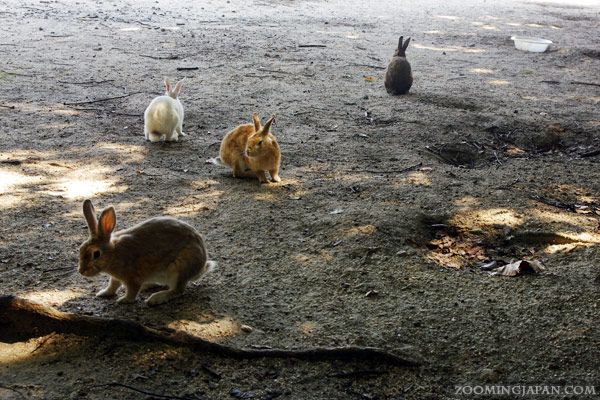
Theory 2: School children on a field trip brought them.
According to a second theory a group of elementary school kids, who were on a field trip, brought 8 bunnies with them in 1971 and left them on the island.
It seems nobody knows what really happened, but it’s a fact that the island is populated by a few hundred rabbits now.
Rabbit Island Japan Nowadays
It’s great to see that an island with such a dark past could turn its fate into something good after all. The image of the island has certainly changed – although some people think that it’s still dangerous as there has never been a thorough decontamination operation and poisonous gas might still be buried somewhere.
According to Oddity Central the water supply was found to contain arsenic in 1996. The Environment Ministry reported in 2005 that the level of arsenic in the atmosphere was 49 times the environmental standard.
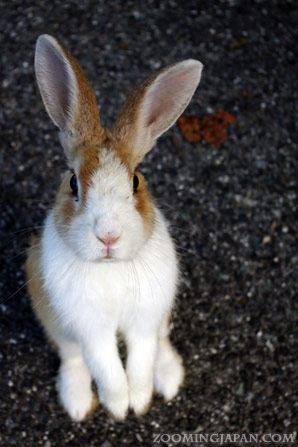
As for the cute bunnies, they are wild, but used to people. They’ll even hop onto your lap or eat out of your hand.
However, I noticed that none of them wanted to be petted.
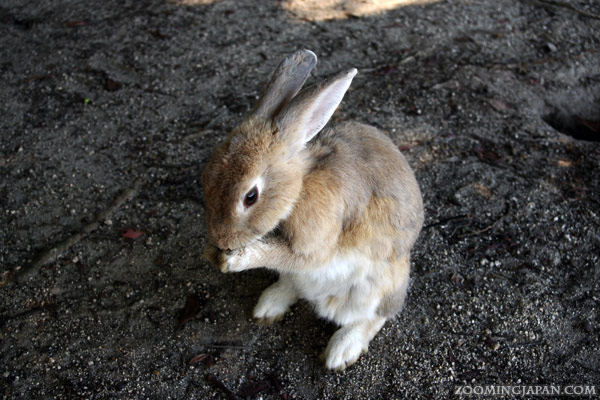
You’ll get to see very cute scenes if you are patient. This rabbit was cleaning itself.
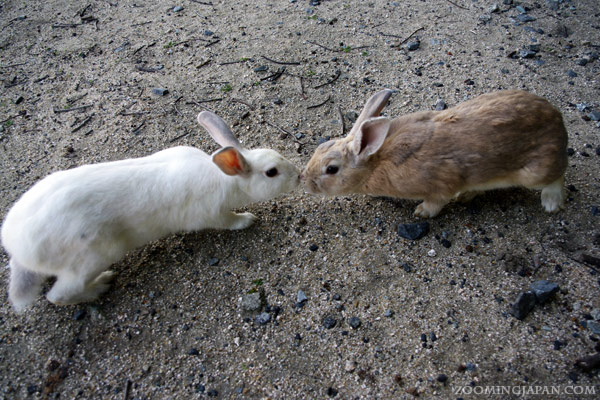
A “rabbit kiss”. So adorable! ^___^

As it’s still very hot at the end of September (we had 30°C that day), most rabbits were dozing somewhere in the shadow.

And wherever I went, a lot of expectant stares were awaiting me: “ You have food for us, right? RIGHT??!! ”

Oh, well. Who can resist those adorable bunnies?

I think we have a winner for the most stupid (and yet cute) stare! *g*

Let me introduce “ Grumpy Rabbit “. Size-wise it was one of the most adorable rabbits on the whole island and from far away it really looked cute, but once you got closer, it gave you this “ Piss off or die ” glare. What a shame!
Rabbit Island’s Visitor Center
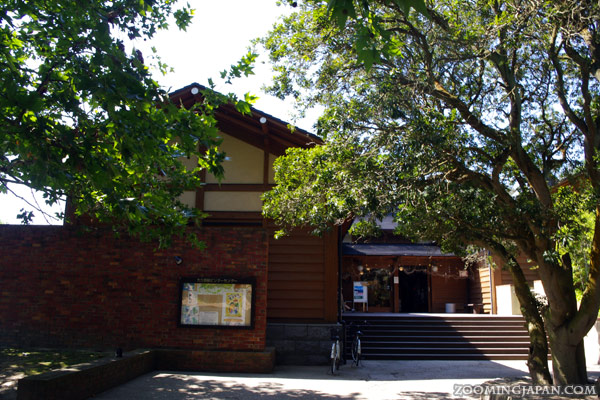
If you manage to get away from all the rabbits, you can check out the “ Visitor Center “. It’s free of charge and open from 9:00 to 16:00 (closed on Wed, Jan-Feb: also on Thu).

There’s some information about Okunoshima and also cute photos of the rabbits.
It’s just a short walk away from the hotel and across from the “Poison Gas Museum”.

The visitor center is facing the Seto Inland Sea, offering a great view. You can sit outside and just relax or play around with the rabbits (that were sitting nearby in the shadow).
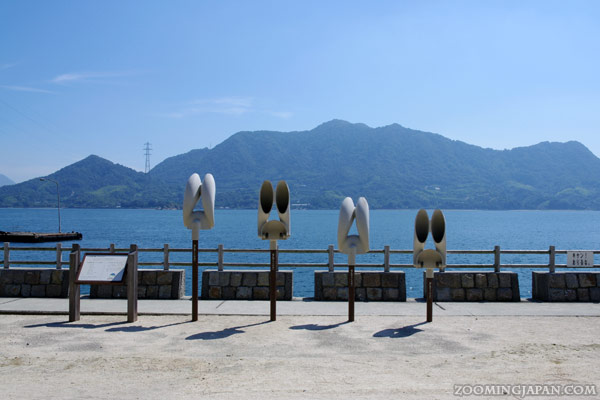
Or you can squeeze your head between those “rabbit ears” and listen to the sound of the ocean.

A few steps away from the visitor center on the way to a small lighthouse (see below), there’s also a little shrine .
It’s another good spot to find a bunch of rabbits, so check it out!

There’s a small lighthouse from where you’ll have a breathtaking view on the beautiful ocean. It’s not too far from the visitor center, the hotel and the museum.

If you walk a little bit beyond the small lighthouse, you’ll get an even better view of the Seto Inland Sea.
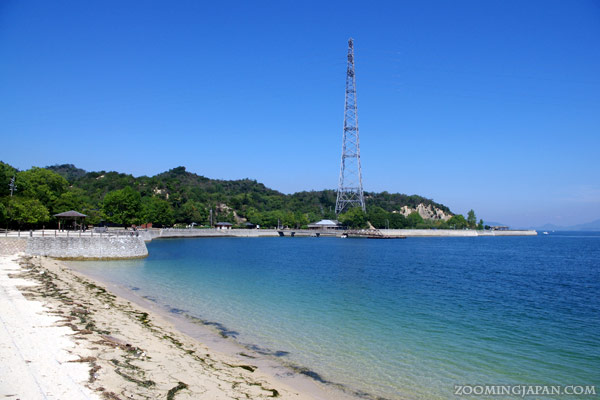
Back from the lighthouse walking towards the visitor center and the camping site, there’s a beach .
In late September swimming season seemed to be over, although it was still very hot.
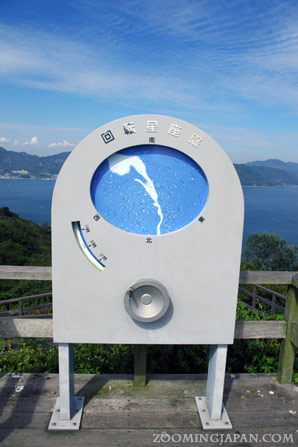
Another highlight is the observation platform , but it’s quite a walk from the rest of the attractions. If you go there without stopping even once (which is impossible with all the rabbits along the way), it’ll take about 20 mins.
It doesn’t matter if you have a bicycle as the slope is really steep. Most likely you’ll have to get off and walk up.
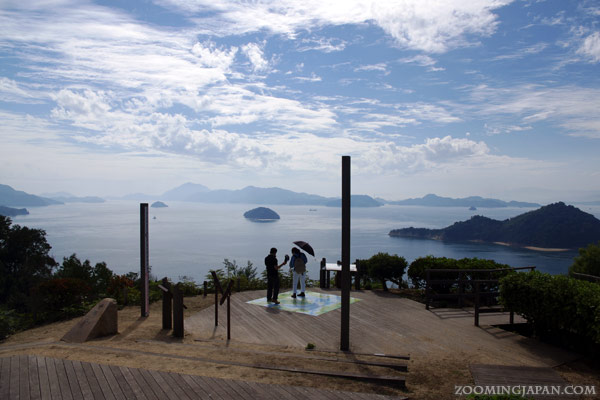
Once up there, you’ll have a great view, so it’s definitely worth it – if you have enough time.
On the way you’ll also run into a few ruins from WWII and older.

There are several ways that lead up to the observation platform. I went up from the camping site near the visitor center and went down to see the “ Middle Battery Ruins ” and descending to finally check out the “ Northern Battery Ruins “.
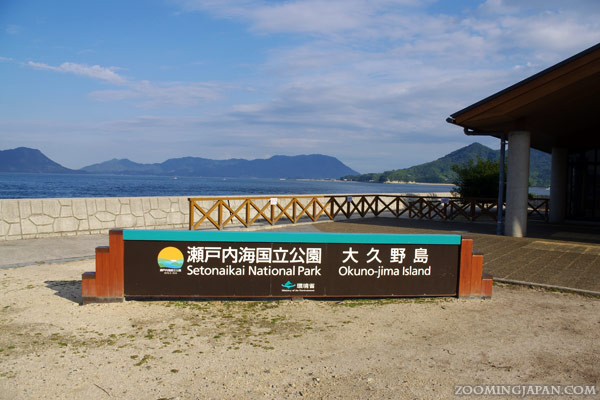
Back at the ferry terminal. Actually there are two: Sanbashi #1 (which is close to the hotel) and Sanbashi #2 (which is the one above).
Usually the last ferry leaves from #1. If in doubt, just ask at the hotel lobby. They’re very helpful and friendly.
As you can see Okunoshima is part of the Seto Inland National Park which contains about 3000 islands , including Awaji Island , Miyajima and Naoshima .
Travel Tips For Okunoshima:
- Try to come during the week, so you have all the rabbits mainly for yourself.
- Best rabbit spots are: visitor center, hotel, observation platform, ferry terminals and the little shrine.
- You can easily do this as a day trip from Hiroshima . You can spend as much time there as you want. If you’re short on time then even 1-2h are sufficient.
- It’s a great destination for families with young kids who can stay overnight at the camping site .
- Onomichi with lots of temples, cats and the starting point for the cycling tour to Imabari as well as Fukuyama with its nice castle are nearby – just in case you want to check them out.
- There are enough vending machines on the island, so you don’t have to worry about drinks. However, you might want to bring snacks for yourself (not only for the rabbits).
You may also like

Tashirojima – Japan’s Awesome Cat Island

Ainoshima – Yet Another Cat Island in Japan

Shiratani Unsuikyo (Yakushima Day 3)
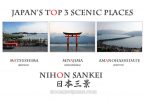
Have You Seen The Top 3 Views in Japan Yet?

Kinojo Castle in Okayama – The Demon’s...

Kerama Islands – Okinawa’s Snorkeling...
70 comments.
I’m always envious on how you managed to find unique spots like this :)
I’m not really a fan of rabbit, in contrary to my birthyear Year of the Rabbit though. But seeing your pictures here might make me fall for them.. a little.. hehehe
Hehe! ^__^’
I guess Rabbit Island is not for you then, huh? But wait, maybe I’ll find “Dog Island” or something like that next! ;) If there’s Cat Island and Rabbit Island, who knows what else we can find. Monkey or Deer Island is more likey, though. :D
There’s a monkey island in Kyushu, in the South-East if I remember correctly. Access is only for scientists though :)
Not going to go there.. Monkeys can be very very scary you know. They’ll snatch things from you, without a sound they’d sneak behind you and BAM you got mugged.
I’ve been around monkeys here in Japan and always really enjoyed it. If you stick to a few rules, it’s usually ok! :D
That sounds interesting! Too bad it’s only for scientists. But Kuyshu has some things to offer for monkey lovers. There’s also a mountain full of monkeys in Oita Prefecture, near the onsen of Beppu. And Kyushu also has Yakushima with its monkeys (though I haven’t seen a single one when I visited).
Heading there today. Thanks for the great insights!!
Awesome! Have fun! :)
Still it’s interesting to visit the island :)
Combine dog island and monkey island, then you go find pheasant island. I’ll be the momotaro :)
This post is awesome…I have to send this to my rabbit-loving friend Kyle.
Actually just visited Monkey Mountain in southern Taiwan last weekend. It was a blast, monkeys everywhere and mostly indifferent to people: http://www.youtube.com/watch?v=nm_LHiQfhfs
Hope to make it to Japan ASAP :D -Zach
Great post, I think theory (1) is most likely to be true :( all chemicals isn’t still dangerous to stay or to visit this island? I really love those rabbits they are cute but I wonder why they don’t like to be petted :teary: hence why I feel theory (1) is correct :( Hope to read more of your journeys….
I also fear that theory #1 is more likely to be true. :( I don’t think it’s dangerous at all if you just visit the island for a few hours. I don’t know about the rabbits, though. They all looked healthy to me and they’ve all been on the island for many years, so …
i just loved your fantastic article and wanted to know if I could reprint some of it in my pet rabbit magazine here in the UK as my readers would love to read this.if so would you please email as i would like to use some of your photos too if possibel. many thansk lisa
Alright. I got your e-mail and will reply soon. ^_^
Interesting. I heard about the island, but it’s new to me that it was used for chemical warfare experimentation as well.
There’s also a bunny island in the Yaeyamas. It’s close to Kohama. A really tiny island uninhabited except for rabbits.
Oh, I didn’t know about the one on the Yaeyama Islands. Or maybe I did and forgot about it. Now, I have a good reason to visit again. *g* The question is if tourists can easily get there.
My friends went there during a diving trip. Think is that you can’t or shouldn’t go onto the island as it’s so riddled by rabbit holes that you’re bound to break something. But you can see them while diving/snorkeling around the island. I don’t think it’s worth it’s own visit though :) It’s mentioned here . The name is Kayama Island.
Thanks for the link! :D Yeah, it sounds like snorkeling nearby would be more fun then! ^^
Well, I think the views from the island are very nice. Personally, as I have mentioned, I am not particularly fond of rabbits, so I don’t think I’ll make the trip! Nice photos and interesting information, though.
I guess if you don’t like rabbits, it doesn’t make much sense to visit the island! ;)
What an informative, interesting and uplifting posting, it really made my day. It was so peaceful looking there and the rabbits seemed so content. Its a miracle that they haven’t over-run the place with no predators. It’s like some God has a hand in their lives. Your pictures remind me of that anime about making photography meaningful through emotional connections: “Tamayura: More Aggressive”. Those rabbits also reminded me of the aloof and mysterious cat-critter (Momoneko) in that series.
P.S. Hope you don’t mind, I sort of told Ken that he could benefit from collaborating with you on writing a book, and letting you set up the illustrations or photographs. :thumbup:
Never heard of that anime but it sounds interesting. Thanks for mentioning it! I hope you get a chance to visit Rabbit Island. It’s a beautiful nice island.
Of course, I don’t mind at all, but I doubt anybody would want to use my photos. I’m sure Ken has a lot of great shots and there are so many great Japan photographers out there! ;) I’m flattered that you recommended me, though! :D Thanks!
That Anime just ended last week and it had a very touching farewell episode. BTW, the main characters father, that had passed away just a year earlier in the story-line was a photographer for travel agencies and after he died, his daughter spent a year of discovery (by using his old camera to take pictures and travelling to the areas her father visited), which led her to many interesting discoveries about small places similar to rabbit island. Her story also takes place around the Seto inland sea and this posting reminded me of that, so you might really enjoy seeing this anime as the main character seems to be interested in the same things you are.
There are 12 episodes for the current season and a previous season of this series that deals with her fathers death and her struggle to overcome her sadness.
Don’t sell yourself short on the quality of your photography skills, your eye for photo’s is extremely sharp and you tell a story with your content in the photos that many people can’t see when they are behind the lens. Ken agrees with me on that and said something about a marriage proposal, though he is so lazy that I’m sure he expects you to do all the work…LOL! :heart:
I haven’t watched any anime in many years (I think), but this one sounds REALLY interesting. I hope they’ll make a drama out of it! (*____*)b Thanks so much for the summary.
And thank you for your nice words. :luvit:
Deer island is Nara. In Nara you can see lots of Deer
Nara certainly has a lot of deer, but Nara is not an island. If we’re talking about islands, then “Deer Island” could be Miyajima or Yakushima. I’ve seen other very remote islands with lots of deer and monkeys. Just one that I remember was close to Uwajima City in Ehime Prefecture (Shikoku). ^__^
Looks like a very interesting place to visit. I think I would be more interested in the history of the island rather than the rabbits, but the family might get a kick out of it.
You can find out more about the history in the museum and you can also ask at the visitor center to get more details. I’m sure your family would love it! ;)
So cute…
Most people go to Hiroshima, then Miyojima, this looks like it should be on itineraries too.
You mean Miy a jima. Yes, that’s right! :)
As always, great info, Jasmine! Cute rabbits and pics! And the “rabbit ears”! Would love try those :)
Thanks! Yes, those rabbit ears were a great idea! ^___^
[…] how I found places that no typical guidebook would ever mention. Or have you ever heard of the Rabbit Island” […]
thanks for sharing, we are going to this place in Apr 14!
You’re welcome, Karen. Oh, that’s great. I hope you’ll enjoy it as much as I did! ^__^
Hello, I’ve read about rabbit island and I’m planning to go there around Apr 2014. There’s a small cup of rabbit pellet on sale for 100 yen on the island. I wonder if there’s some vegetable shop around Tadanoumi station? I’d rather choose feeding the rabbits with natural food first. :)
I haven’t had time to check if there’s any shop or supermarket near Tadanoumi Station when I visited. If there isn’t, you don’t want to lose precious time searching for one. Why don’t you just buy some cabbage the day before you plan to go in a supermarket near your hotel? That way you can be sure you get what you want without wasting any time. :D
[…] my way down to Osaka, then make a beeline to Hiroshima, after which I’ll take an excursion to insane “Rabbit Island” and then continue on to the island of […]
I am DYING of jealousy over here. Wow. That looks like a really amazing and interesting experience!!!!
You really should go as soon as you get a chance to visit. ;) I’m sure you’d love it!
Leave a Comment X
Notify me when new comments are added.
I agree to the storage and handling of my data requested in this form. Read the privacy policy for more information. *
This site uses Akismet to reduce spam. Learn how your comment data is processed .
Privacy Overview

- Adventure & Experience

- Art & Culture

- Sea & Nature

- Food & Drink

- Relaxing Stay

- For First-Time Visitors

- Getting to Setouchi

- Getting Around Setouchi

- Travel Tips

- Itineraries
- TRAVEL TRADE & MEDIA
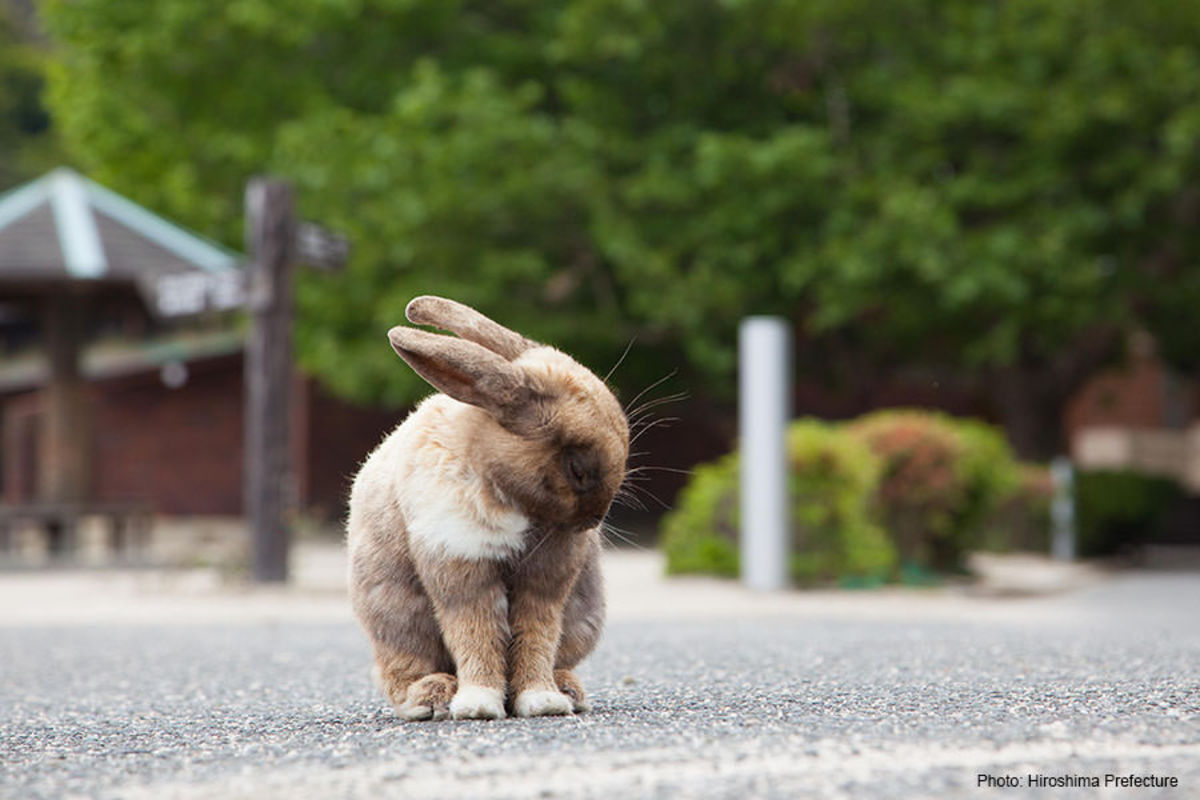
Hiroshima Okunoshima
Only a fifteen minute ferry ride from Tadanomi Port in Takehara City, this small isolated island offers 4 kilometers of beaches and campgrounds. Visitors can enjoy meals and a day trip to the hotsprings in "Kyukamura Okunoshima," which is the island's only lodging. Visitors have the chance to see the wild rabbits which inhabit this island up close. There are about 700 rabbits currently living on the island, and because of the rabbits the island has become well known as "Rabbit Paradise."
Basic Infomation
- Address Tadanoumi-cho, Takehara-shi, Hiroshima
- Tel +81-846-22-4331(Takehara City Tourism Association)
- Website Click here
Related Tags
Adventure & Experience
- Experiences
- Hot Springs
Nearby Spots
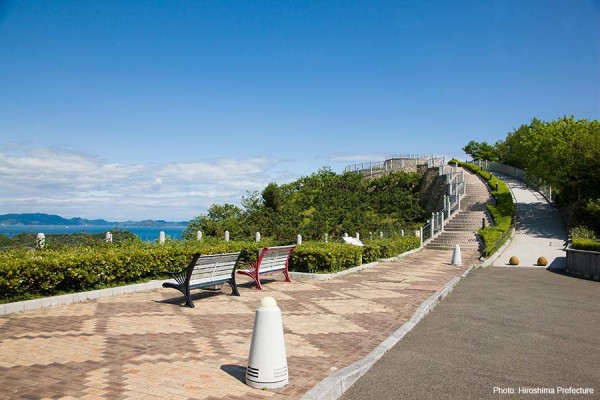
Rekishi-no-mieru-oka-koen Park

Sea & Nature
Farm Suzuki (Farmer's Kitchen)

Atomic Bomb Dome (Hiroshima Peace Memorial)

Townscape of Mitarai
You May Also Like
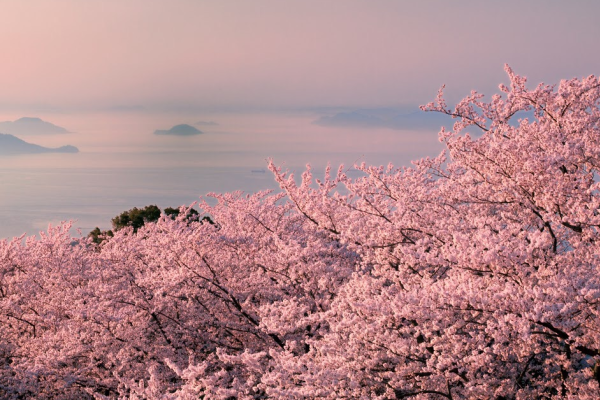
National Park Kankakei Gorge
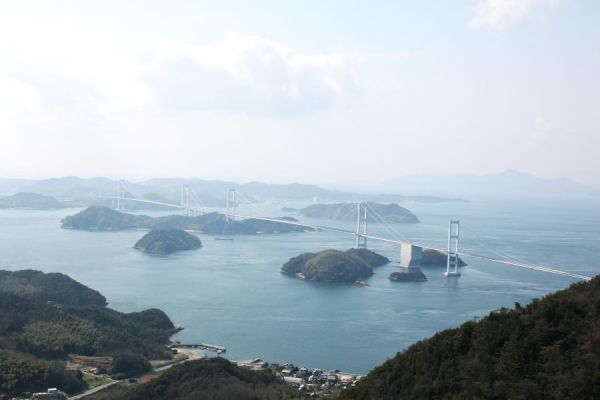
Art & Culture
Kirosan Observatory Park
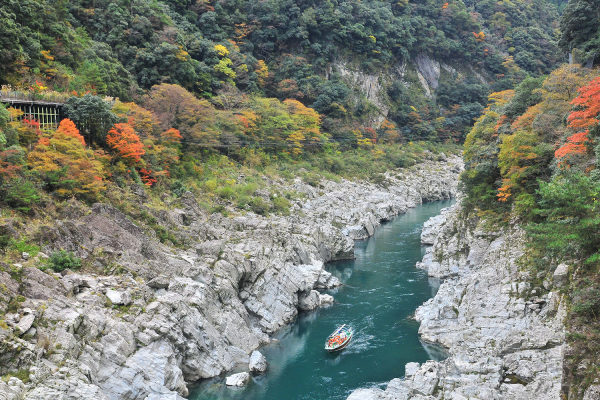
Oboke and Koboke Gorges
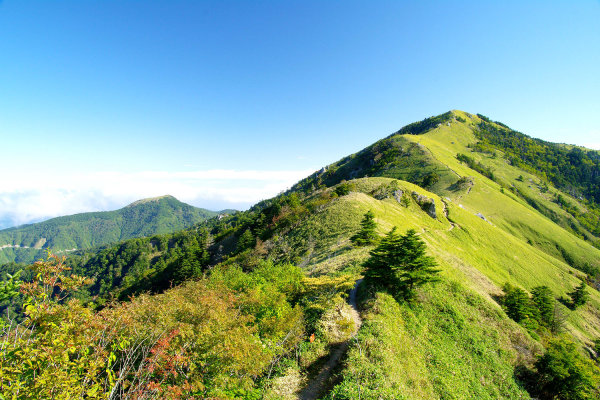
Mt. Tsurugi

Mt. Yamainu
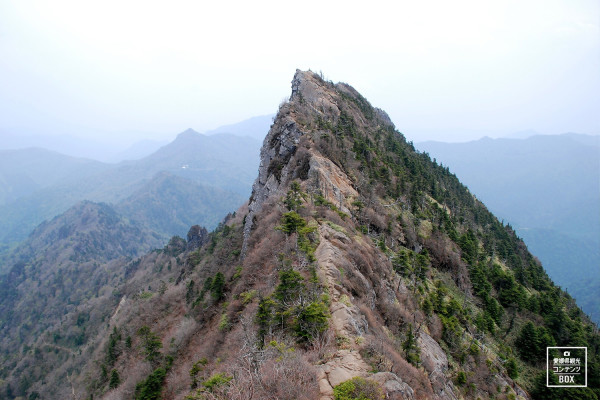
Mt. Ishizuchi
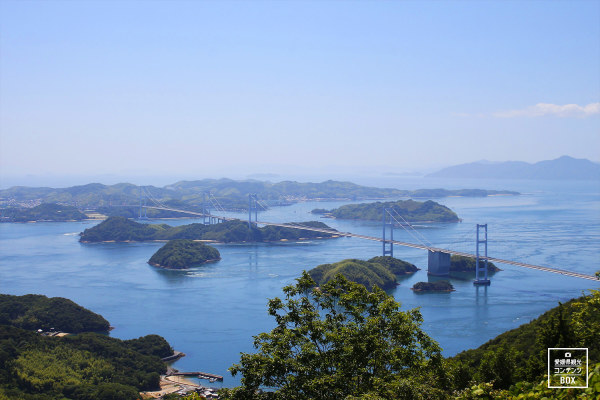
Plan Your Trip

Rabbit Island: The Cutest Day Trip from Hiroshima on a Budget
If you’ve heard about Okunoshima , more widely known by its popular name of Rabbit Island ( official website ), you can thank YouTube. Before a 2014 YouTube video of a woman being “attacked” by a horde of friendly bunnies went viral, most visitors to Okunoshima were either elderly Japanese coming to enjoy the local onsen hot springs or school children on a field trip. Few foreign visitors would have ever been interested in coming to the island for reasons other than the hundreds of adorable rabbits who live here, mainly because the real history of the island is extremely dark.
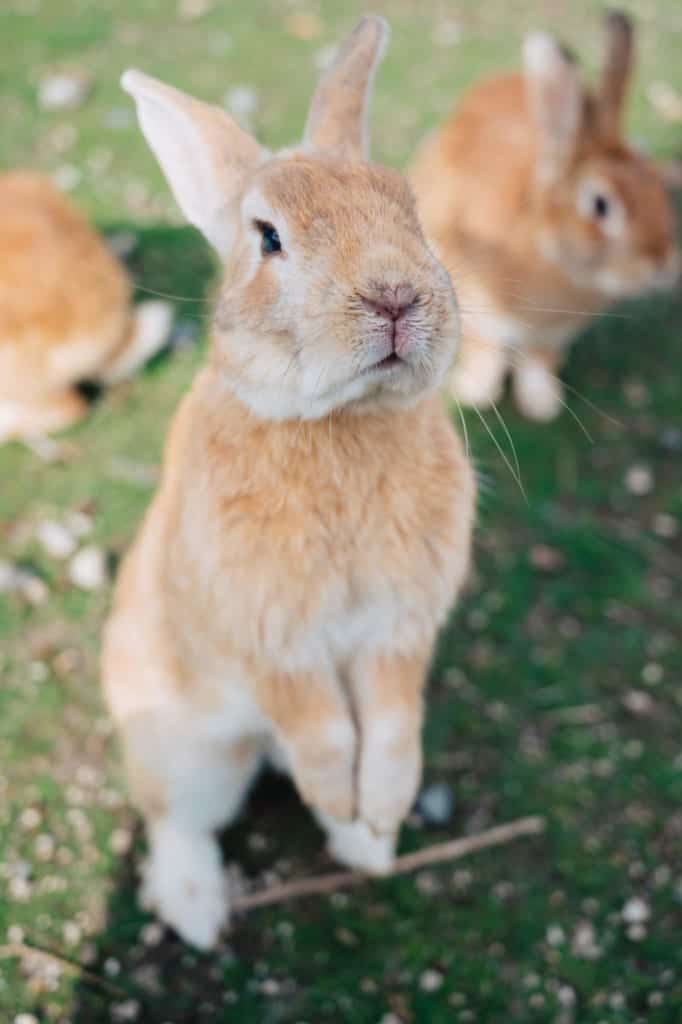
Nobody knows precisely how the rabbits ended up here in the first place, but it was certainly a change of fortune for an island whose history is far from cute. For many years before and during World War 2, Okunoshima didn’t even exist on a map; it was a secret military test site where the Imperial Army was creating and testing poison gas to be used on Japan’s enemies. After the war, all the facilities were destroyed; however, the local government did not want this disgraceful piece of Japanese history to become forgotten or covered up. They created the Poison Gas Museum as a memorial to remind people what horrible things can be done to others in the name of war.
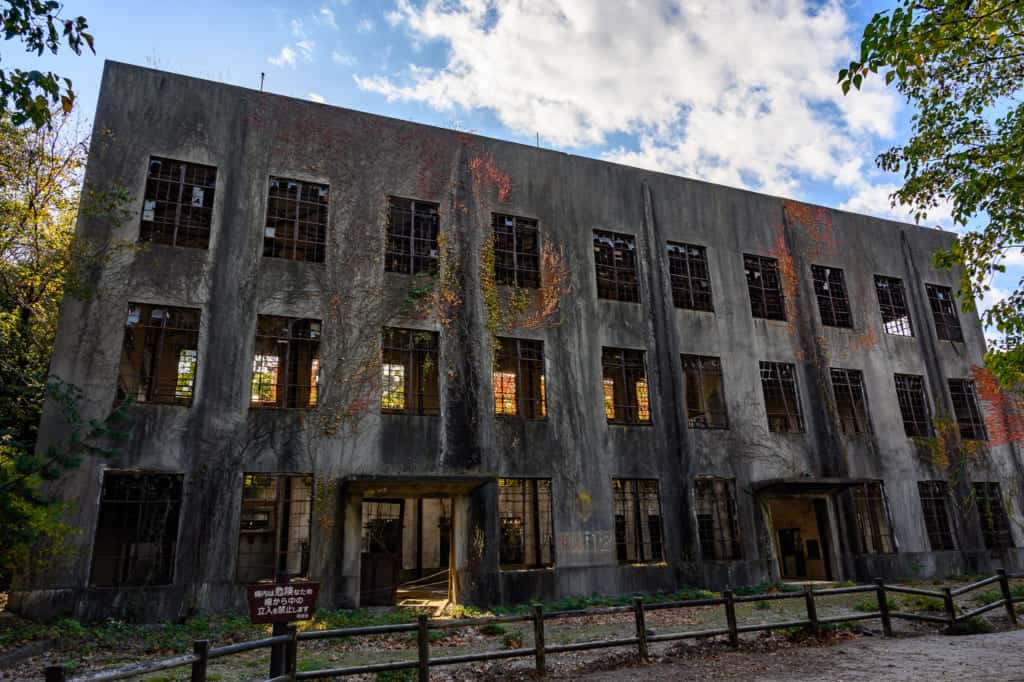
Yet somehow, around 40 years ago, rabbits were introduced to the island. It could have been a prank by a group of visiting school children or a distraction created by someone who wanted to make Okunoshima a happier place to visit. Whatever the reason, today about 800 to 1,000 rabbits live on the island without any natural predators. However, that doesn’t make Okunoshima a paradise for the rabbits. They are utterly reliant on humans for food and water, just like any other pets. And like the deer in Nara Park, sometimes the food they receive from visitors isn’t always the healthiest for them.
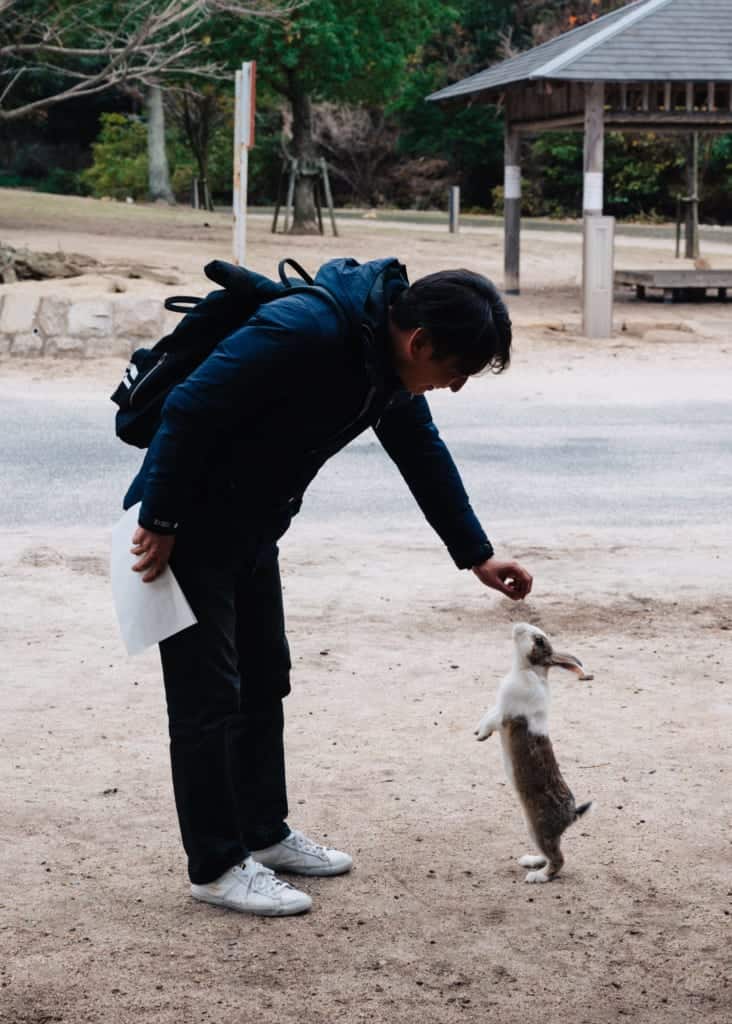
There is a delicate balance on Rabbit Island with regards to human interaction with the rabbits. On the one hand, visitors are not encouraged to feed the rabbits, and you cannot purchase rabbit food on the island. On the other hand, the rabbits are relying on humans for food, so there cannot be a ban on feeding them either. From my understanding, the best foods you can feed the rabbits would be the type of rabbit food you would purchase at a pet store, made mainly of alfalfa pellets. Feeding the rabbits any other kinds of food, including vegetables, would be unhealthy and could cause them to become sick. Also, take care when feeding the rabbits as in their excitement to greet you, they might accidentally bite your fingers.
To get to the island, you can take one of two types of ferries from Tadanoumi Port , one that accepts only passengers and the other, which can also carry motorized vehicles. It doesn’t matter which ferry you take; the cost is the same, so take the next departure. The 15-minute ferry ride back and forth on the Seto Inland Sea is a chance to take in the fantastic views of this beautiful part of Japan.
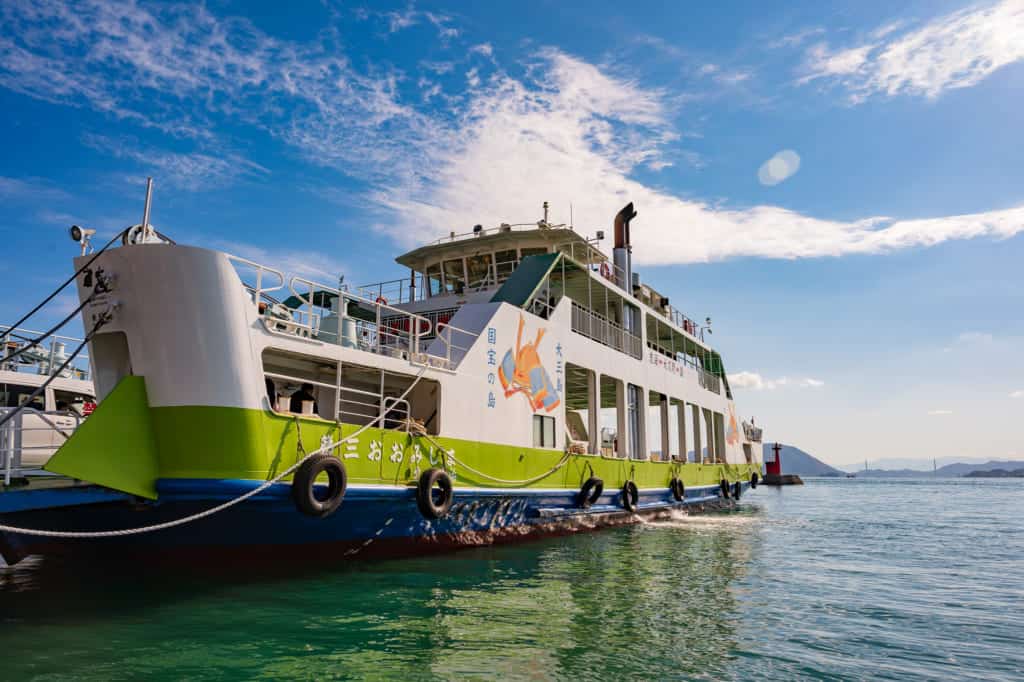
Arriving at the island and stepping off the ferry, you will be rushed by a group of rabbits like the Backstreet Boys by preteen girls in 1999. This is not because they think you are cute. It’s because they believe you have food. If you do not have food, their keen little noses will sniff you out, and they will move on, like preteen girls did to the Backstreet Boys in 2013.
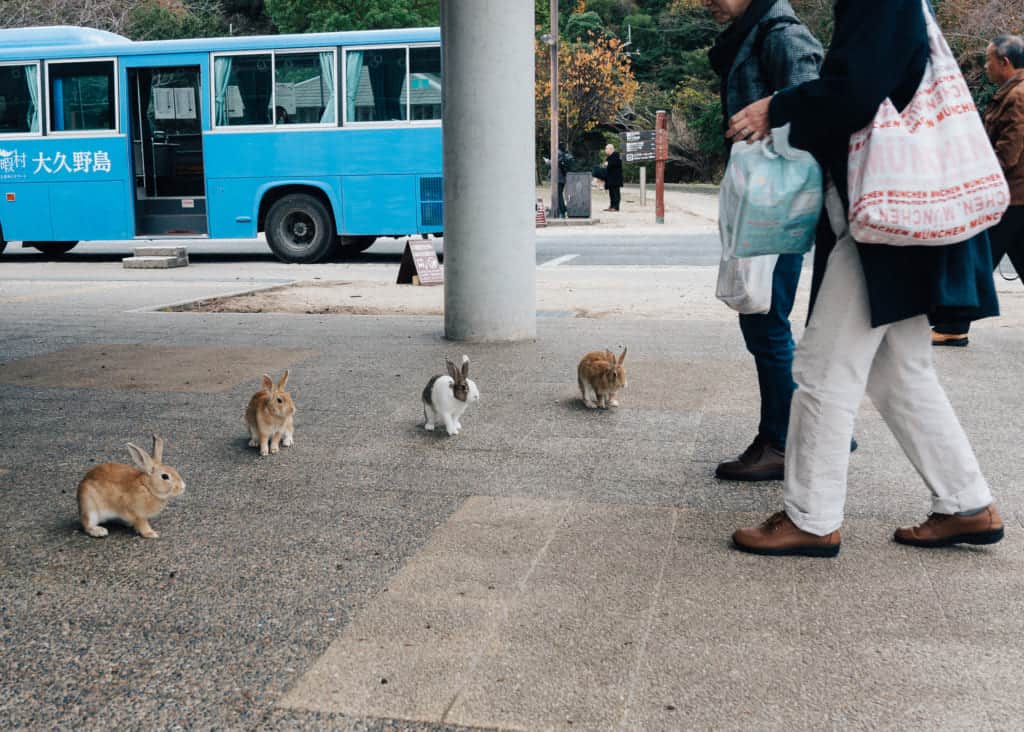
To the right of the pier is the remains of the power station once used for the buildings supporting the poison gas research. But did you come here to see the ruins of a poison gas factory or cute little bunny rabbits? I will assume the latter, so let’s go left, toward the island’s hotel, Kyukamura Okunoshima .
Walking along this road with rabbits, you will pass a small beach with rabbits, a boardwalk with rabbits, and a camping area with a fence designed to keep out rabbits, but with rabbits in it because they dug a hole under it. Then you will reach Kyukamura, the hotel with rabbits around it.
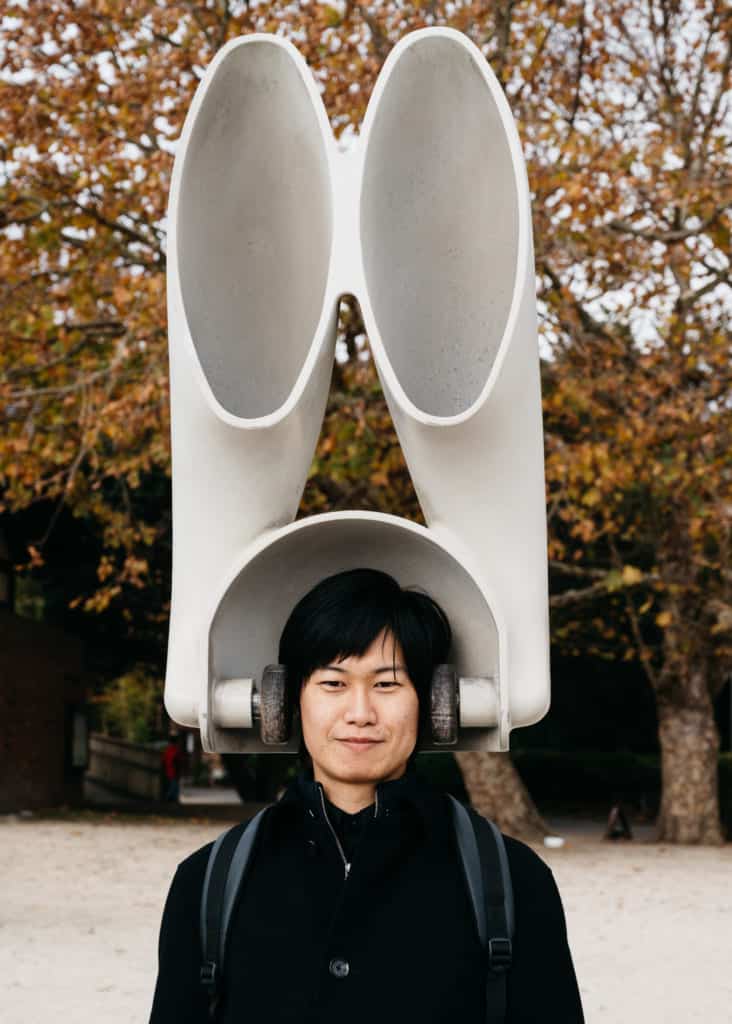
Kyukamura is the only hotel on the island and allows you to spend the night on the island. Why would you want to do that, you might ask? Some people cannot get enough of the rabbits, and because rabbits are nocturnal, you can enjoy them even at night. But another great reason to stay over would be to enjoy the incredible scenery from the scenic viewpoints of the island. In fact, the landscapes here are the only thing that can rival spending time with the adorable bunnies. The sunset here can be breathtaking and the night view of the sea filled with islands under the stars, indescribable. Kyukamura is a fine, reasonably priced hotel with Japanese and Western-style rooms, a public onsen bath, and buffet breakfast and dinner included.
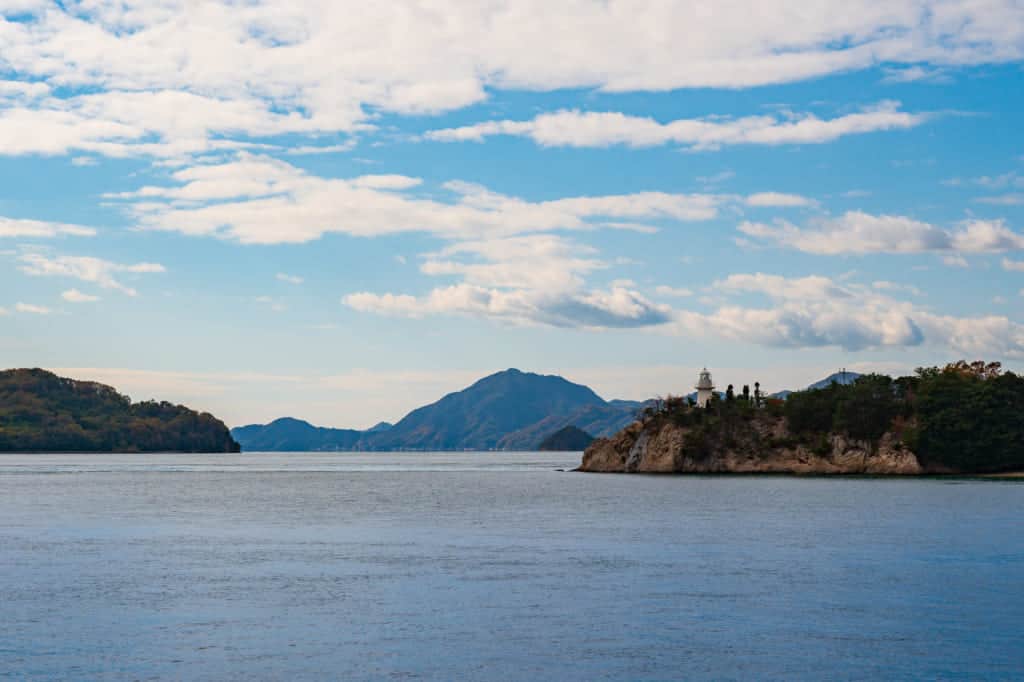
Eating Okunoshima’s Local Specialty for Lunch
We weren’t spending the night, but we were hungry, so we decided to have lunch at Kyukamura’s restaurant, where they serve the local specialty of the island . Can you guess what it might be? Here’s a hint: it’s abundant in this area, and it comes prepared in a variety of ways, including fried!
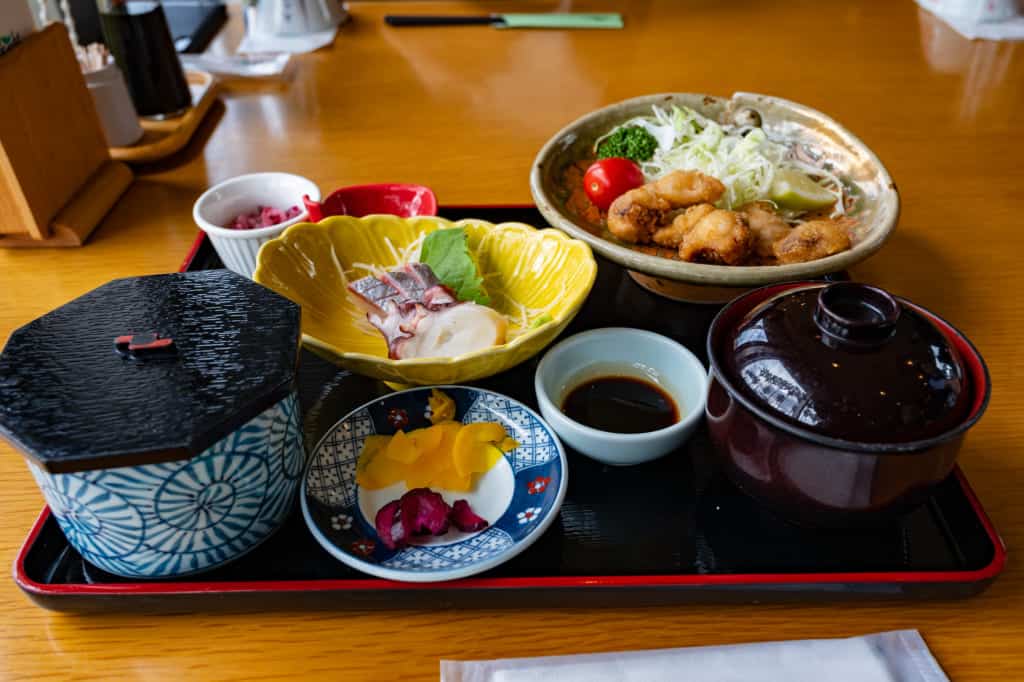
The answer, of course, is octopus! Wait, what were you thinking anyway?
The waters of the Seto Inland Sea are generally very calm, but off the coast of Okunoshima, you will notice a few whirlpools forming in the still waters. These are the hunting grounds of octopus, and in turn, become the spots where local fishermen hunt them in the early hours of the morning. Fresh octopus is something you usually love or hate, but Kyukamura serves an octopus set lunch prepared in several ways, so perhaps you can find a dish that suits your taste. For me, it was fried – yummy!
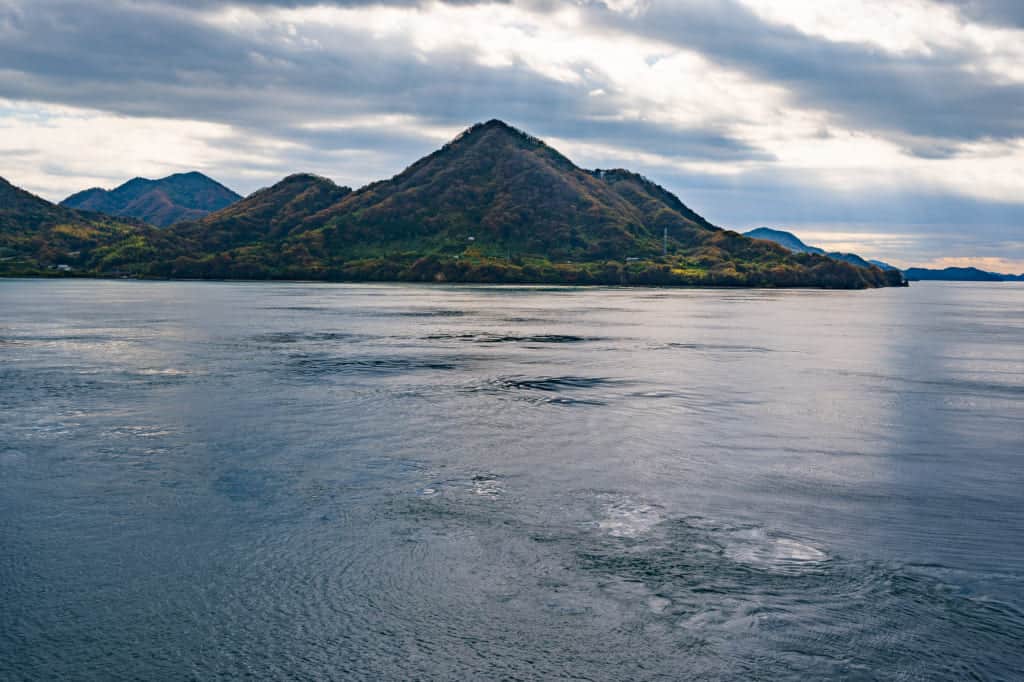
After lunch, we returned to the ferry and headed back to the mainland. There was still one more place on my itinerary: an Edo-era neighborhood so well preserved, Japan’s superstars of pop, Arashi, recently filmed a travel commercial there!
Getting to Okunoshima (Rabbit Island)
Not only is it simple to get to Tadanoumi Port from Hiroshima by bus, if you purchase the Visit Hiroshima Tourist Pass , it is also free! Tadanoumi (Takehara) is one of the destinations covered by the Middle or Wide area pass. From the Hiroshima Bus Terminal, it takes about an hour and 45 minutes to reach Tadanoumi Port, where you will purchase a ferry ticket for the 15-minute ride over to Rabbit Island.
Sponsored by Chugoku Region Tourism Promotion Association / Chugoku District Transport Bureau
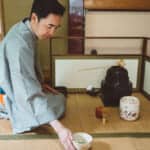
Freelance writer, photographer, and mentor. Japan-based, Oaktown (Oakland, California) born. Freelance writing and photography work includes Lonely Planet, Voyapon, Metropolis Japan, and many regional tourism websites around Japan.
https://www.toddfong.com
Most Popular Articles

Experience Kyoto at Night with JINS

Discover Akita in 6 Gourmet Cities and a Smiling Train Ride
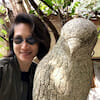
Leave a Reply Cancel Reply
Save my name, email, and website in this browser for the next time I comment.
I have read and accepted the Privacy Policy *

About Voyapon
- Privacy Policy
Affiliate Links
Some of our articles contain affiliate links. Whenever you use these links to buy something, we earn a commission to help support our work at Voyapon. Please read our disclosure for more info .
- Sightseeing
- Accommodation
- Things to Know
Destinations
Japan travel guide.
- Transportation
- Money in Japan
- Connectivity
- Getting Help
© 2024 VOYAPON. The images and contents of this site may not be used, reprinted or reproduced without permission.
- Destinations
5 Fun and Easy DAY TRIPS from HIROSHIMA (How to Get There+Things to Do+Where to Stay)
This site uses affiliate links, meaning that if you make a purchase through our links, we may earn an affiliate commission.
There is a lot to do in Hiroshima. And, you could easily spend a few days exploring the city.
However, sometimes it is nice to a break from the busy city life and discover some places around it. There are plenty of rewarding and easy day trips from Hiroshima that will help you discover another side of Japan.
Find Out More About Hiroshima:
Things to Do in Hiroshima (10 Amazing Things to Do on Your First Visit)
Hiroshima Peace Memorial Park Self-Guided Walking Tour (8 Easy Steps)
Perfect Day Trip to Miyajima from Kyoto, Osaka, or Hiroshima (9 Things to Do)
One Perfect Day in Hiroshima (5 Things You Can’t Miss+Useful Tips)
How to Visit Hiroshima and Miyajima in One Day (Easy 3-Step Guide)
You Might Also Like:
275 Best QUOTES About JAPAN (JAPANESE Culture, Nature, Food, Anime, Proverbs)
- 1. Map of Day Trips from Hiroshima
- 2. Day Trip from Hiroshima to Naoshima (Japan's Art Island)
- 3. Day Trip from Hiroshima to Miyajima (The Island of Gods)
- 4. Day Trip from Hiroshima to Sandankyo Gorge
- 5. Day Trip from Hiroshima to Takehara (Hiroshima's Little Kyoto) and Okunoshima (Rabbit Island)
- 6. Day Trip from Hiroshima to Iwakuni
- 7. Intrepid Scout's Tips for Day Trips from Hiroshima
Map of Day Trips from Hiroshima
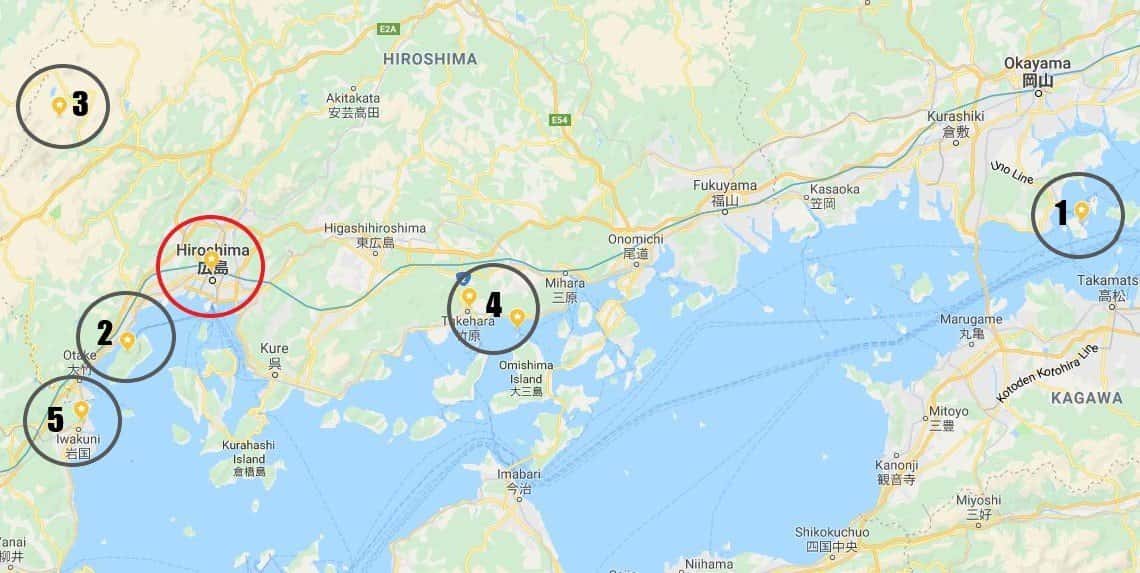
Legend: 1. Naoshima Island, 2. Miyajima Island, 3. Sandankyo Gorge, 4. Takehara, 5. Iwakuni
Day Trip from Hiroshima to Naoshima (Japan's Art Island)
Naoshima Island, also known as ‘Japan’s Art Island’ is an art lover’s paradise. It is definitely one of a kind experience.
However, even if you are not an art or architecture buff, you should still visit the island for the breathtaking views, stunning landscapes, and charming island atmosphere.
It is one of my favorite day trips from Hiroshima!
Intrepid’s Tip:
There is a private guided tour that you might want to look into Naoshima Art Island Guided Tour . It is worth the extra money, in my opinion. The guides are excellent. You will visit Benesse House and Chichu Art Museum. Transport around Naoshima is included as well as a ferry ride from Uno Port to Miyanoura.
How to Get from Hiroshima to Naoshima
First, take Shinkansen from Hiroshima Station to Okayama Station. Next, from Okayama Station , take the local train (JR Uno Line) to Uno, and finally, from Uno take a ferry to Miyanoura .
Once you are on the island, you can practically walk everywhere, or you can rent a bike . There is a local bus that you can take as well. Finally, there is a free shuttle that operates between Miyanoura and Chichu Art Museum.
Make sure to buy JR Pass ! It will save you a lot of money on transportation in Japan. You can buy JR Pass here .
Things to Do in Naoshima
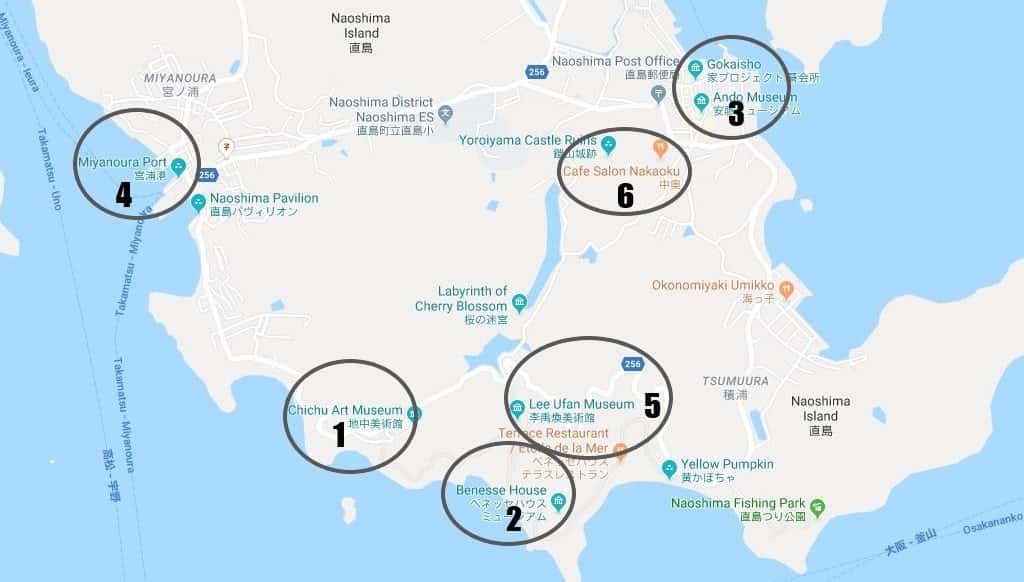
Legend: 1. Chichu Art Museum, 2. Benesse House, 3. The Art House Project, 4. Akakabocha 5. Lee Ufan Museum, 6. Cafe Salon Nakaoku
Chichu Art Museum
When I first visited Chichu Art Museum I was in awe by the building’s unique space designed by Tadao Ando.
First of all, the museum is mostly underground. However, a lot of natural light beautifully filters into each room. Depending on the time of the day and the season of the year, the natural light changes the appearance of the artwork and the ambiance of the space.
On permanent display are selected pieces from three masters: Claude Monet, James Turrell, and Walter De Maria.
My favorites are five paintings from the Water Lilies series produced by the great Impressionist painter Claude Monet. In my opinion, this alone is worth going to Naoshima.
Walter De Maria’s artwork is stunning and thought-provoking. It features a sphere and gilded geometric forms.
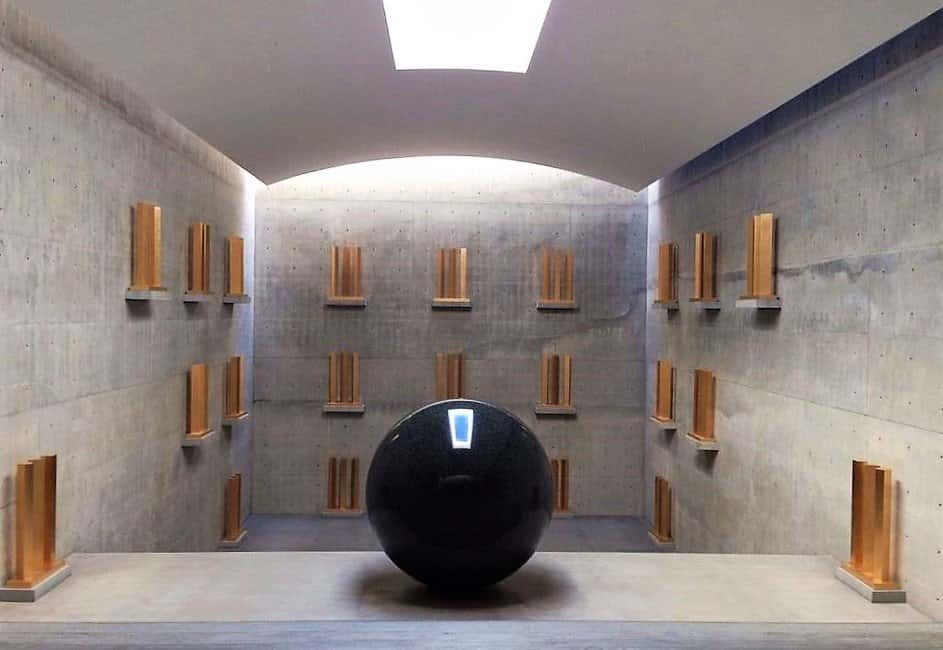
Chichu Art Museum / Day Trips from Hiroshima
Don’t miss James Turrell ‘s play on space and light. It is stunning.
If you are visiting during springtime, make sure to stroll by a recreation of Monet’s garden .
For opening hours and entrance fees click here . You can book your tickets online . Make a note that the museum is closed on Mondays.
Benesse House Museum
Benesse House Museum is my favorite museum on Naoshima Island.
The entire facility was designed by Tadao Ando and it houses a modern art museum as well as an exquisite hotel (read about the hotel in Where to Stay in Naoshima section right below).
The complex sits on high ground and overlooks the Seto Sea. Needless to say, the views are simply breathtaking!
The art displayed in and around the museum is a variety of paintings, sculptures, photography, and installations.
The fans of Yayoi Kusama will not be disappointed. Yes! If you are a fan of her giant pumpkins then you are for a treat.
Perfectly positioned and overlooking the Seto Sea is the famous Yayoi Kusama’s ‘Yellow Pumpkin’.
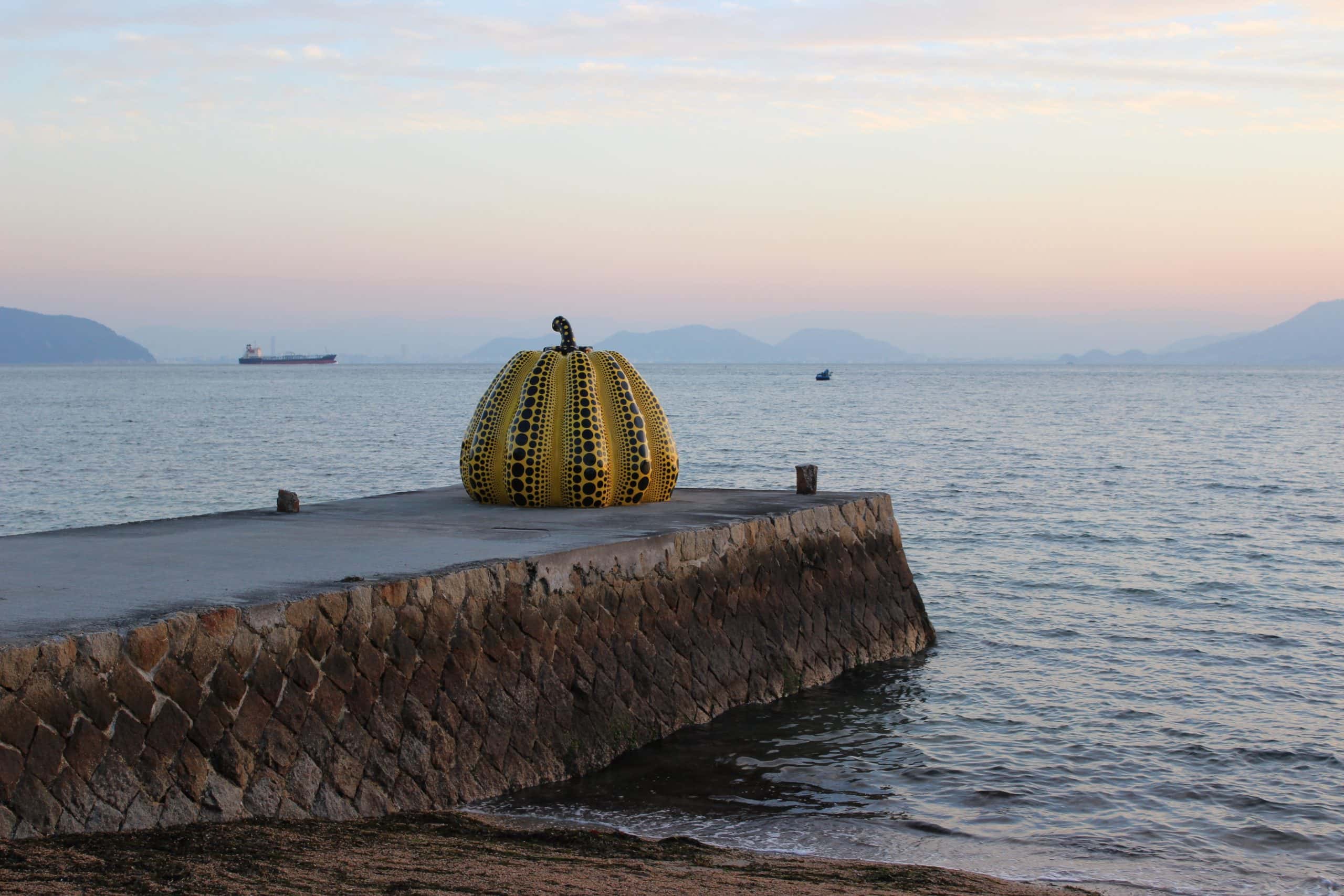
Yayoi Kusama’s ‘Yellow Pumpkin’ / Day Trips from Hiroshima
For hours and admission click here .
The Art House Project
The Art House Project is a collection of old houses and workshops that have been converted into art installations and venues for contemporary art by artists and architects from Japan and abroad.
The art houses are scattered throughout Honmura village (located on the east side of the island).
By the way, once you get to Honmura Village head straight to The Honmura Lounge. It is located just a few steps away from the bus stop!
The Honmura Lounge serves as an information center for the Art House Project. Here, you will be able to get all the details regarding the artists and architects who are part of the Art House Project.
My three favorites of the Art House Project are Go’o Shrine, Kadoya, Minamidera, and Ishibashi.
- Go’o Shrine – Go’o Shrine was designed by Hiroshi Sugimoto . An interesting glass staircase connects the worship hall with an underground chamber and represents unity between heaven and earth.
- Kadoya – Kadoya is a restored residence that houses the artworks of Tatsuo Miyajima.
- Minamidera – Minamidera is a structure designed by Ando Tadao. It houses the artwork by James Turrell.
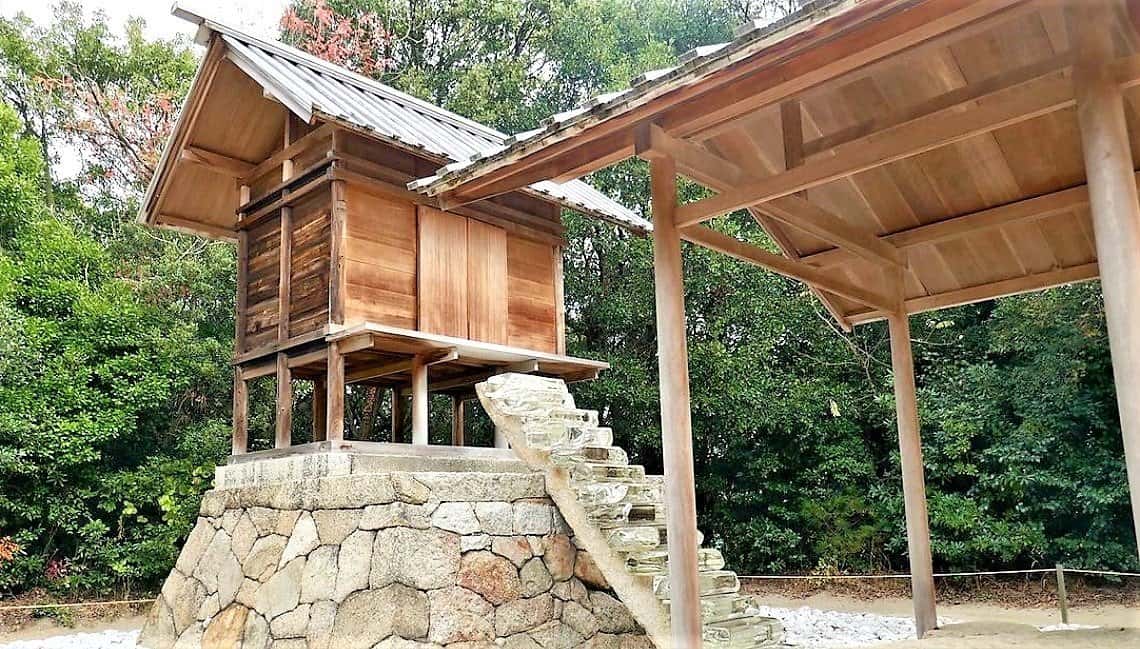
Go’o Shrine was designed by Hiroshi Sugimoto / Day Trips from Hiroshima
Akakabocha, the ‘Red Pumpkin’ is one of the two installations by famous Japanese artist Yayoi Kusama on Naoshima Island.
The ‘Red Pumpkin’ can be found at Miyanoura Port. Actually, when you step out of the ferry, ‘The Red Pumpkin’ will be right in front of you.
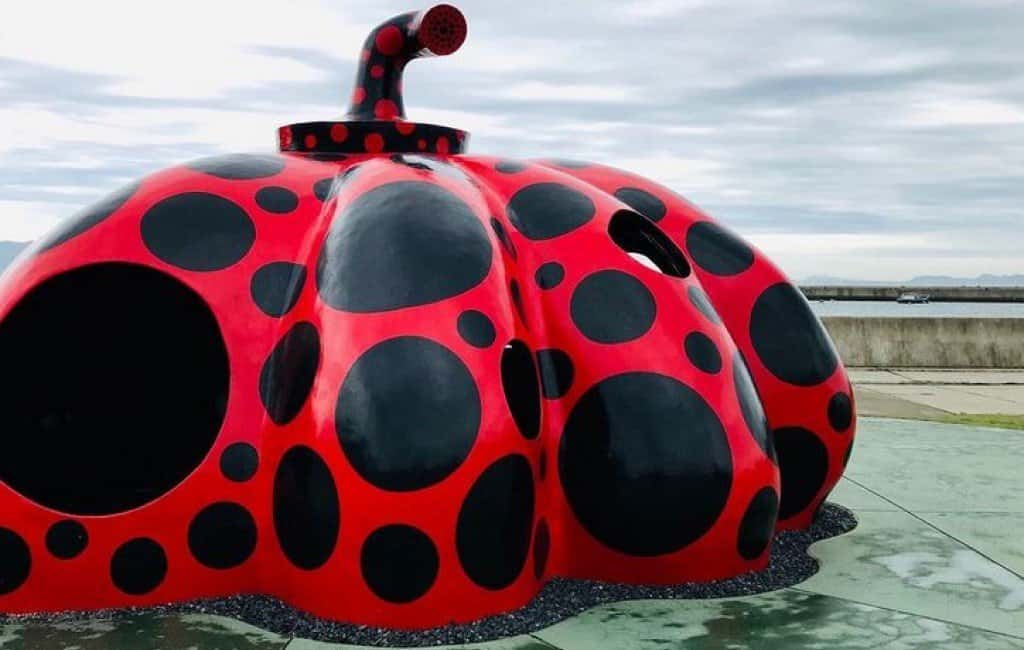
Akakabocha, the ‘Red Pumpkin’ / Day Trips from Hiroshima
Lee Ufan Art Museum
The incredible structure of the museum designed by Tadao Ando houses a collection of only 7 items. The 7 items are by one artist – Lee Ufan .
Be the judge yourself, however, in my opinion, the building and the art pieces are coherent. The entire complex invites you to look in new ways at the surrounding nature and presented art, light, and shadow.
Where to Stay in Naoshima
Benesse House Museum Hotel is my top choice for an overnight stay.
It has Western-style rooms in the Museum, Oval, Park, and Beach buildings. It is expensive, however totally worth it. You get to enjoy magnificent views and furthermore, you can wander around and explore the museum after the closing hours.
For prices and availability click here .
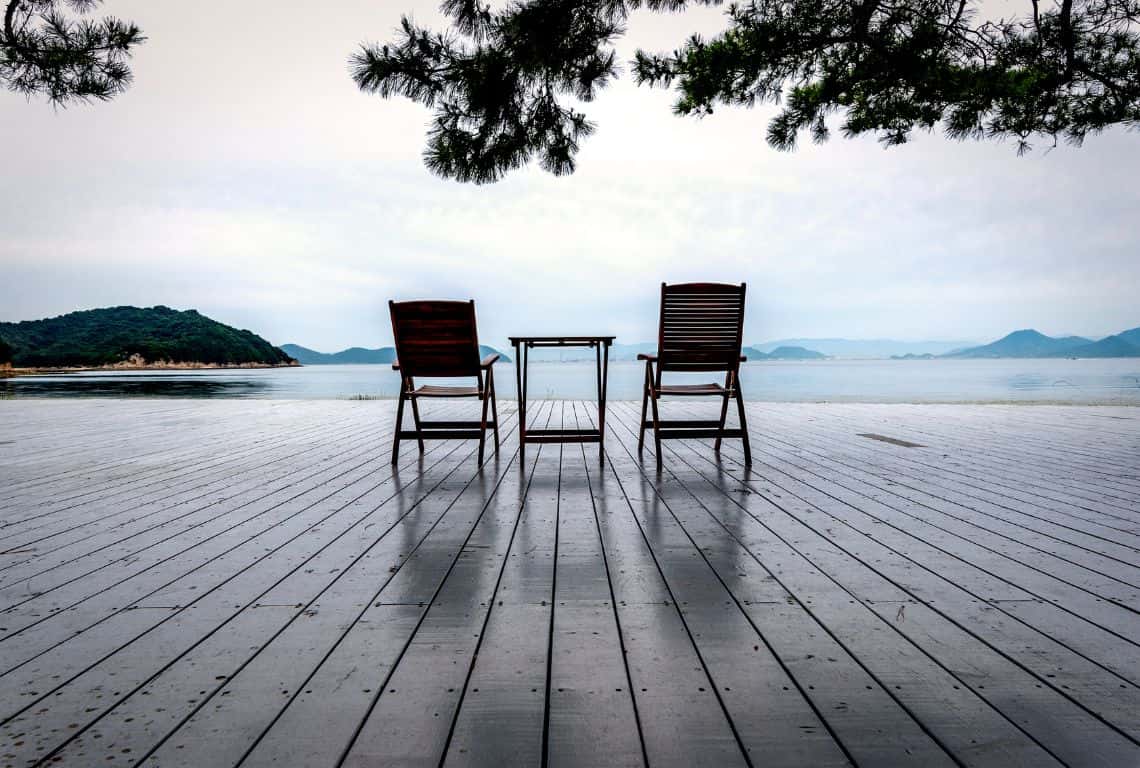
Where to Stay in Naoshima / Day Trips from Hiroshima
Where to Eat in Naoshima
The best choices are either Honmura village or Miyanomura village.
My recommendation is to head straight to Cafe Salon Nakaoku located in Honmura Village .
I have to say that everything I tried at Cafe Salon Nakaoku was delicious. I am recommending that you try miso soup, omurice with tomato sauce, and sauteed octopus. These dishes are my favorites! However, they always have specials of the day, and they are great as well!
The inside is very attractive and cozy with lots of wood elements and quiet places to enjoy your meal.

Where to Eat in Naoshima / Day Trips from Hiroshima
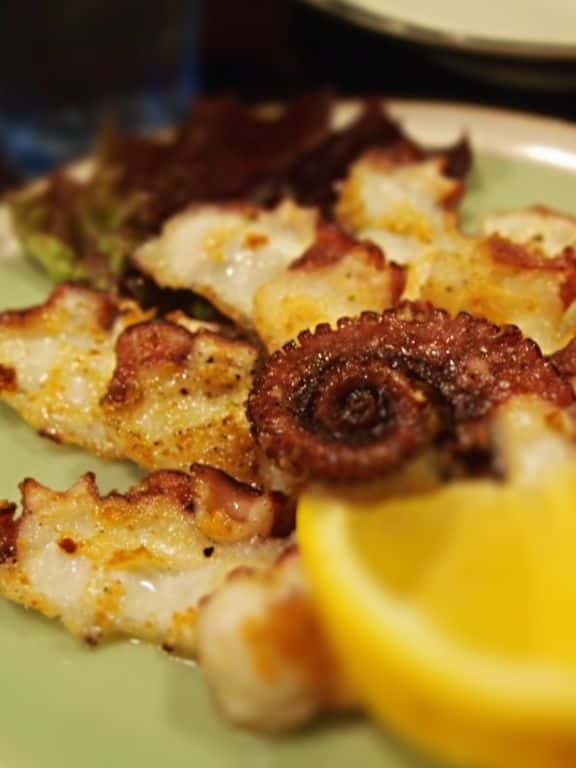
Day Trip from Hiroshima to Miyajima (The Island of Gods)
If you are looking for a perfect day trip and a little adventure, then Miyajima Island , the “Island of Gods” is a perfect day trip from Hiroshima.
Miyajima is located less than an hour away from Hiroshima and has an overwhelming range of things to do. In addition, Miyajima Island is one of my favorite day trips from Hiroshima.
How to Get from Hiroshima to Miyajima Island
Let’s start with how to get to Miyajima Island. The good news is that it is super easy! In no time you will be on your way to Miyajima Island day trip.
Trains depart from Hiroshima Station every 15 minutes and will take you to Miyajimaguchi Station . It is about a 30-minute ride from Hiroshima to Miyajimaguchi Station. Once you arrive at Miyajimaguchi Station, follow the signs for the Miyajima Island ferry .
By the way, the ferry is located no more than a 10-minute walk from the station.
Things to Do in Miyajima
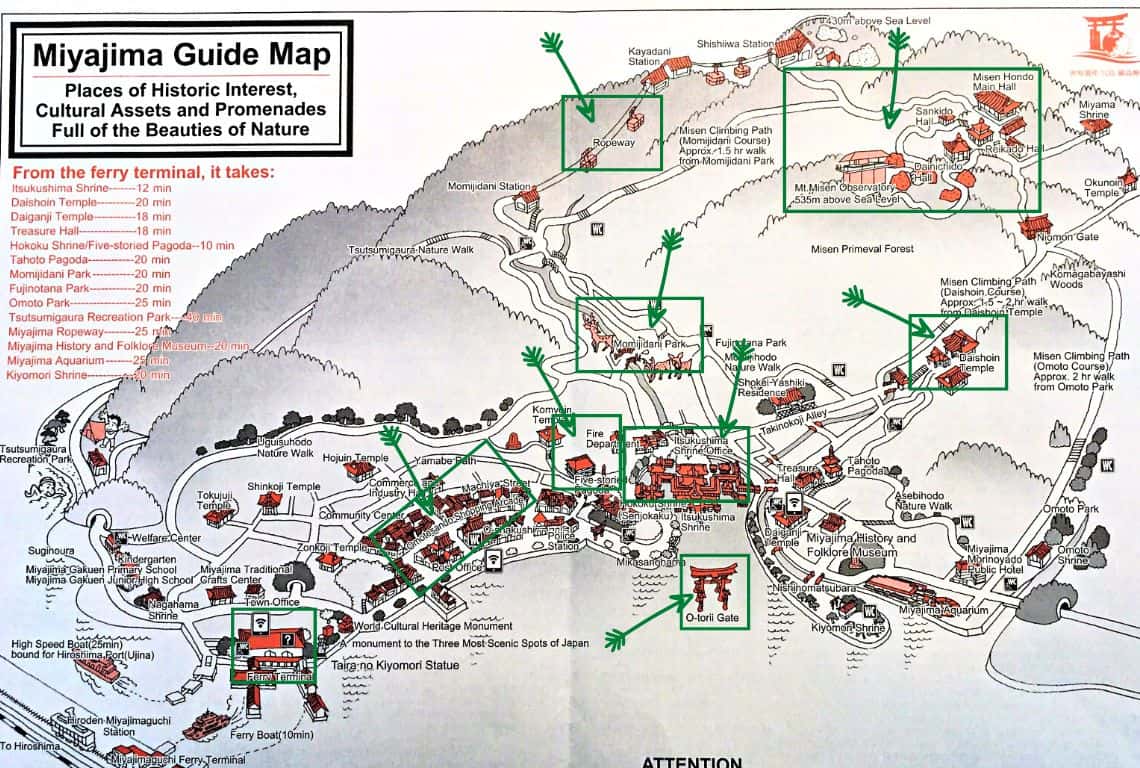
Map of Miyajima Island / Day Trips from Hiroshima
Miyajima Island Floating Torii
The number one attraction as well as the symbol of Miyajima Island is a giant torii (gate) . During the high tide, it appears as if the torii is floating out in the sea.
My recommendation is to rent a kayak for a couple of hours and go around and under the torii. You can check Paddle Park for prices and availability. The website is in Japanese. However, if you scroll down, you will get to the English section.
If you are visiting the island during the low tide , you can walk up all the way to the torii and really get the feel of how enormous this structure is.
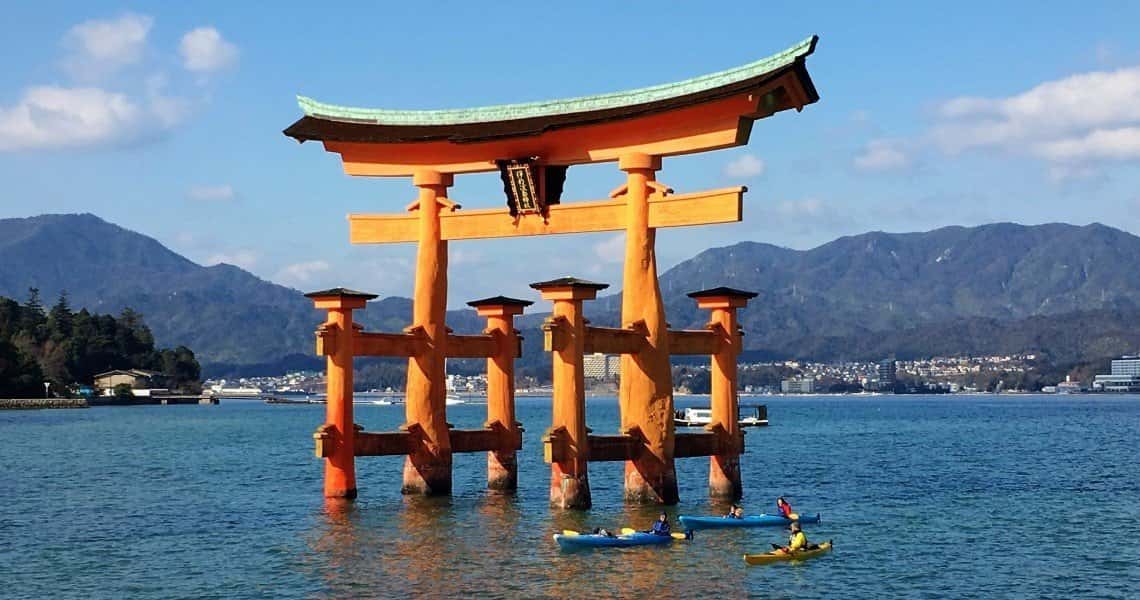
Miyajima Island Floating Torii / Day Trips from Hiroshima
Itsukushima Shrine
Next, head on to Itsukushima Shrine . The shrine was built in 593 and became an important place of worship in about 1168. In 1996 the World Heritage Committee officially inscribed Itsukushima Shinto Shrine as a World Cultural Heritage.
Itsukushima Shrine is well known for its unique construction . It consists of four main areas: the Holy Hall where the gods live (Heiden), the inner part where only the priests enter (Haiden), the external area for worship (Haraiden), and the noh theater stage.
All the sections are connected by numerous boardwalks and supported by pillars above the sea. During the high tide, the shrine looks as if it is floating in the Seto Sea .
Interestingly enough, the reason why the shrine was built out in the sea was that the island was originally thought to be too sacred for commoners to set foot upon.
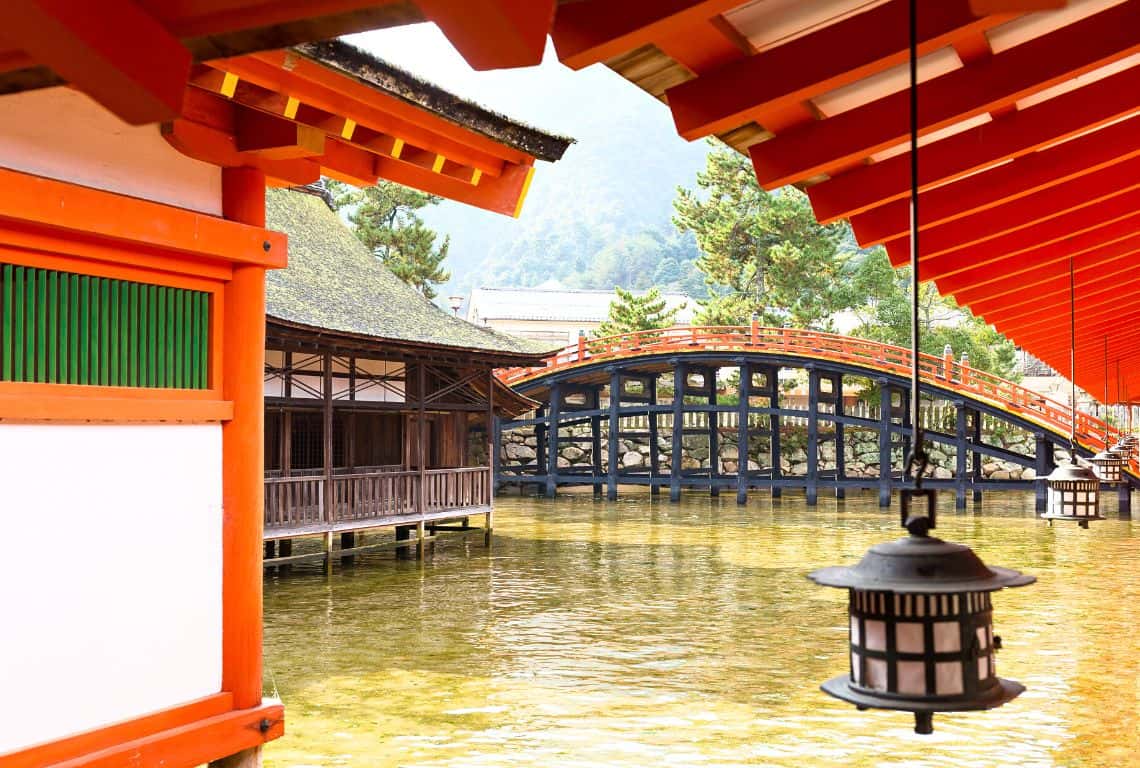
I tsukushima Shrine / Day Trips from Hiroshima
Daishoin Temple
Daishoin Temple i s about a 10 to 15-minute walk from Itsukushima Shrine and it is well worth the visit.
Founded by Kobo Daishi in 806, Daishoin Temple is the headquarters of the Omuro branch of the Shingon Buddhists.
The path leading to the temple is adorned with thousands of Buddha statues.
These are the statues of the disciples of the historical Buddha, Shaka Nyoria. They all look adorable wearing different colored beanies.
Next, follow the path, which will gradually climb through a beautifully designed garden . The design is so perfect that at the first sight, it is not possible to determine whether it is a man-made garden or a scenery crafted by nature.
Eventually, the path will take you to Daishoin Temple . Make sure to step inside the temple.
The ceiling of the temple is studded with lanterns emitting low warm light. My recommendation is to linger inside the temple for a few minutes and enjoy this peaceful and meditative atmosphere.
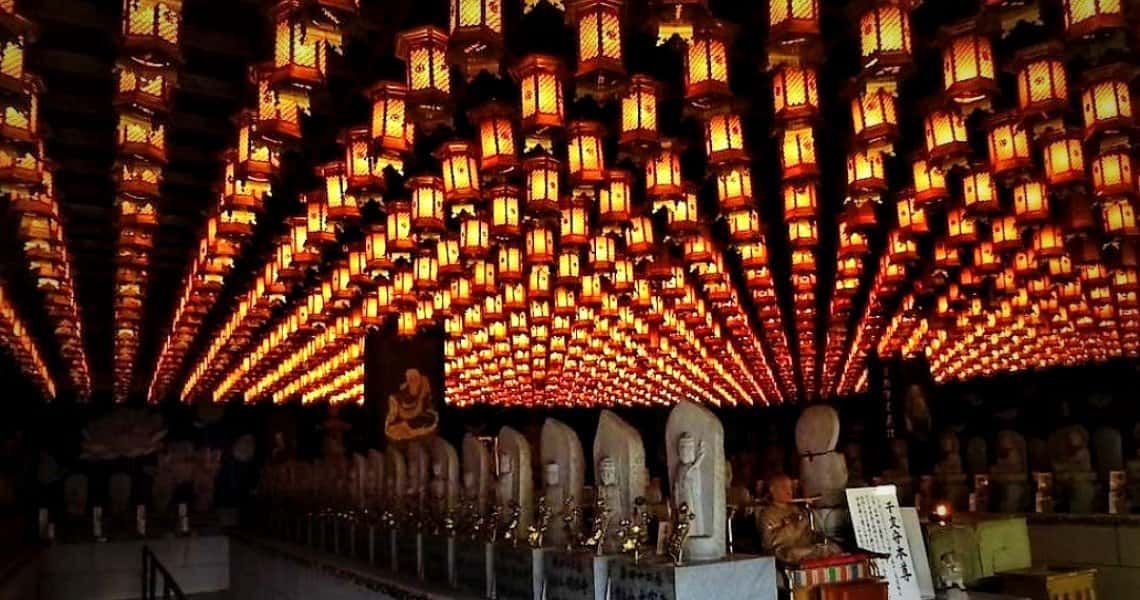
Daishoin Temple / Day Trips from Hiroshima
The Ropeway
Next, take the ropeway to catch the magnificent views of the island.
The ropeway leaves from Momijidani Station . You can take a bus or you can walk to the station. My recommendation is to walk to Momijidani Station. It is no more than a 10-minute hike up a slight incline. Simply, take the path leading from Itsukushima Shrine to Momijidani Park.
On the way to Momijidani Station, you will pass through Momijidani Park .
Momijidani Park is a hang-out place for the famous Miyajima Island deer . They will be happy to see you and eager to find out if you have any treats. In addition, if you are planning your day trips from Hiroshima during the fall months, then keep in mind that Momijidani Park is one of the most famous maple leaf parks in Japan.
The ropeway goes from Momijidani Station to Kayadani Station . Once you reach Kayadani Station, you will take a second ropeway to your final destination which is Shishiwa Station.
The Shishiwa Station is 430 meters above sea level. The views of the Seto Sea from the station are breathtaking.
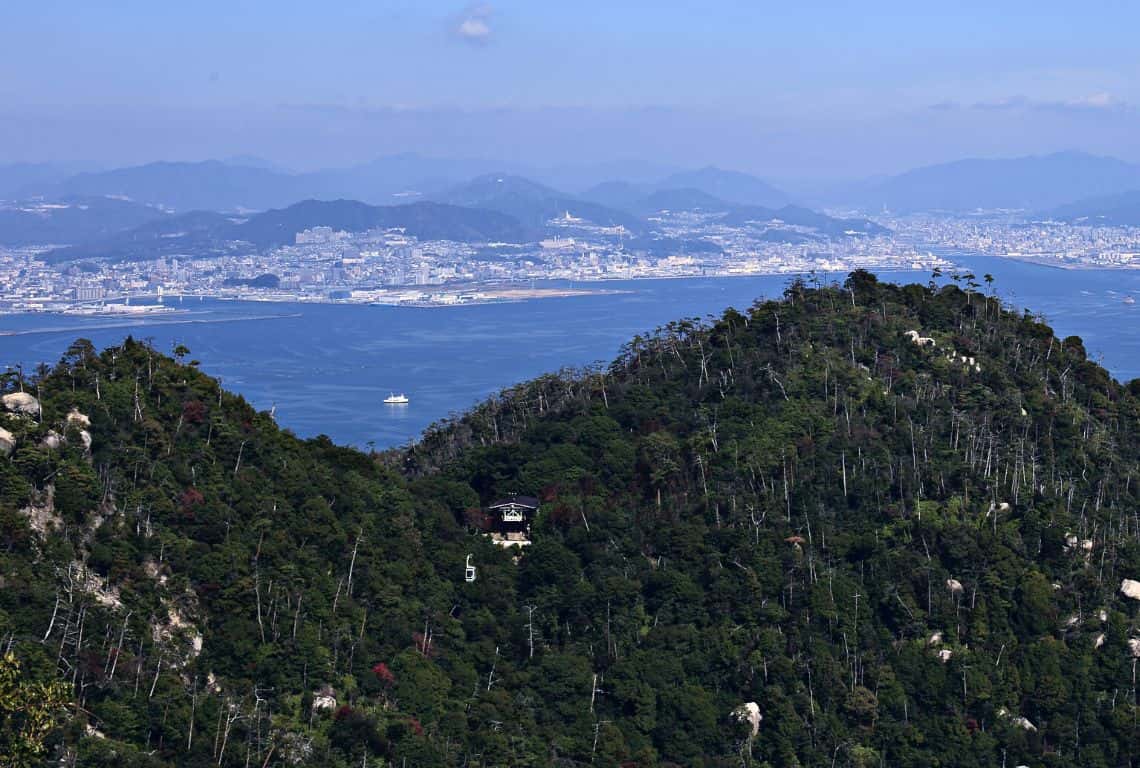
The Ropeway on Miyajima Island / Day Trips from Hiroshima
Where to Stay in Miyajima
If you decide to spend a night on Miyajima Island, then I am recommending Iwaso Hotel
It is one of the places that I keep coming back to. It is a luxurious Japanese-style hotel. The service is superb and the cuisine is outstanding.
The Iwaso Hotel occupies a traditional wooden building as well as some cottages dating back to 1900. It is situated no more than a 5-minute walk from Itsukushima Shrine and from the Giant Floating Torii.
My recommendation is to experience a traditional kaiseki meal, which is served in your room!
Where to Eat in Miyajima
If you are an oyster lover, then head straight to Yakigaki No Hayashi Restaurant . You will not miss it! First of all, there is always a small line of people waiting for a table, secondly, the smell of the grilled oysters will lead you right to this place.
They have the best selection of fresh oysters. You can choose from boiled, grilled, deep-fried, or raw oysters. All delicious!
Intrepid’s Tip:
Learn more about Miyajima
Read: DAY TRIP to MIYAJIMA (9 Things to Do)
Day Trip from Hiroshima to Sandankyo Gorge
A day trip to Sandankyo Gorge is a perfect choice for nature lovers and hikers. It is one of the day trips from Hiroshima that will let you completely escape the busy city life.
How to Get to Sandankyo Gorge from Hiroshima
First, get to Hiroshima Bus Center and purchase a bus ticket bound for Sandankyo Gorge . Next, head to Platform # 7 . Finally, board the bus and get off at the last stop.
The express buses will get you to Sandankyo in about 80 minutes; the local bus will take about 2 hours before you get to Sandankyo.
My recommendation is to take the 8:18 am express bus. It will get you to Sandanyo Gorge by about 9:30 am.
And, take the return express bus at 3 pm. It will get you back to the Hiroshima Bus center at about 4:20 pm.
Things to Do in Sandankyo Gorge
Sandankyo Gorge runs through the mountains northwest of Hiroshima City. It is 13 km long.
The hike runs along the gorge and takes you through the most beautiful natural scenery around Hiroshima.
Personally, I loved this hike. The trail has plenty of ups and downs and the breathtaking scenery changes at every turn.
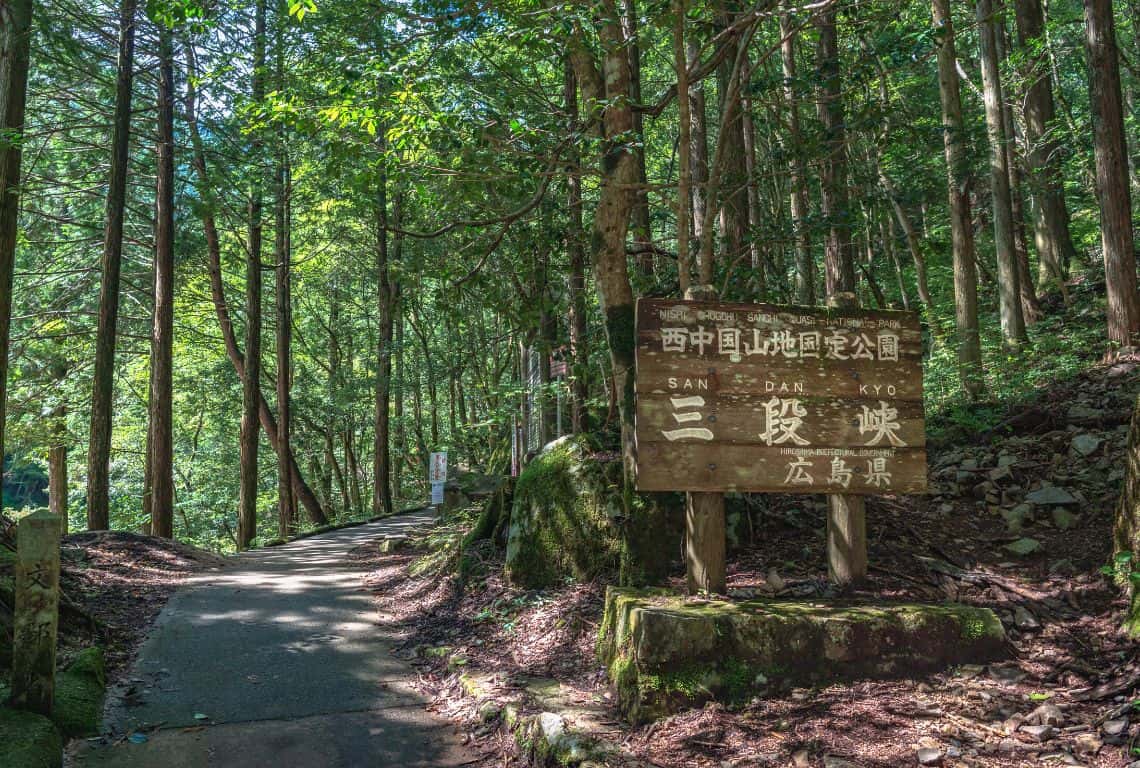
Sandankyo Gorge / Day Trips from Hiroshima
Now, what you need to know is that you can take it as a leisurely stroll and turn back when you had enough of trekking.
Or you can take a full hike , which takes about 5 hours one way and leads up to Hijiri Lake.
The gorge contains five famed scenery spots and it is one of the Top 5 Special Valleys of Scenic Beauty in Japan .
- Shimaidaki Waterfall (Sister Falls)
The first viewpoint that you will reach is Shimaidaki Waterfall (Sister Falls) . It takes no more than 10 minutes to reach this point.
Shimaidaki Water is actually two waterfalls that flow parallel to each other.
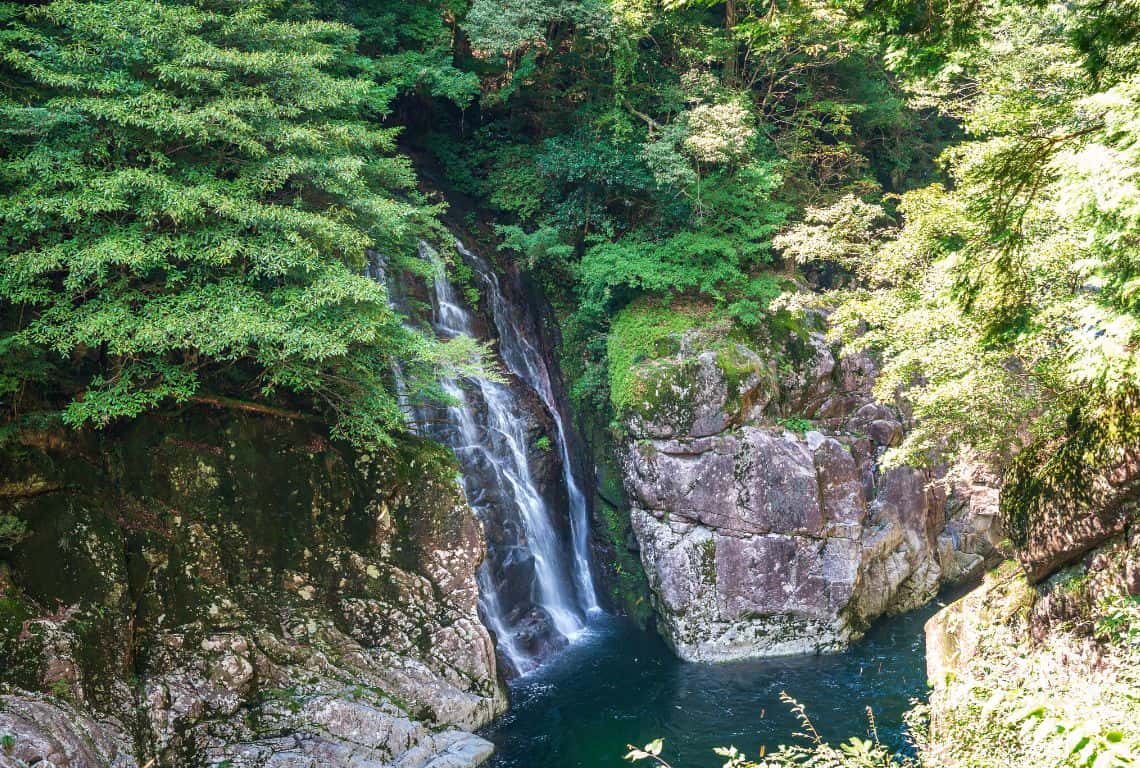
- Tatsunokuchi (Dragon Mouth Torrent)
Next, after about 30 minutes, you will reach Tatsunokuchi (Dragon Mouth Torrent). Here, the water picks up some speed and creates a few rapids.
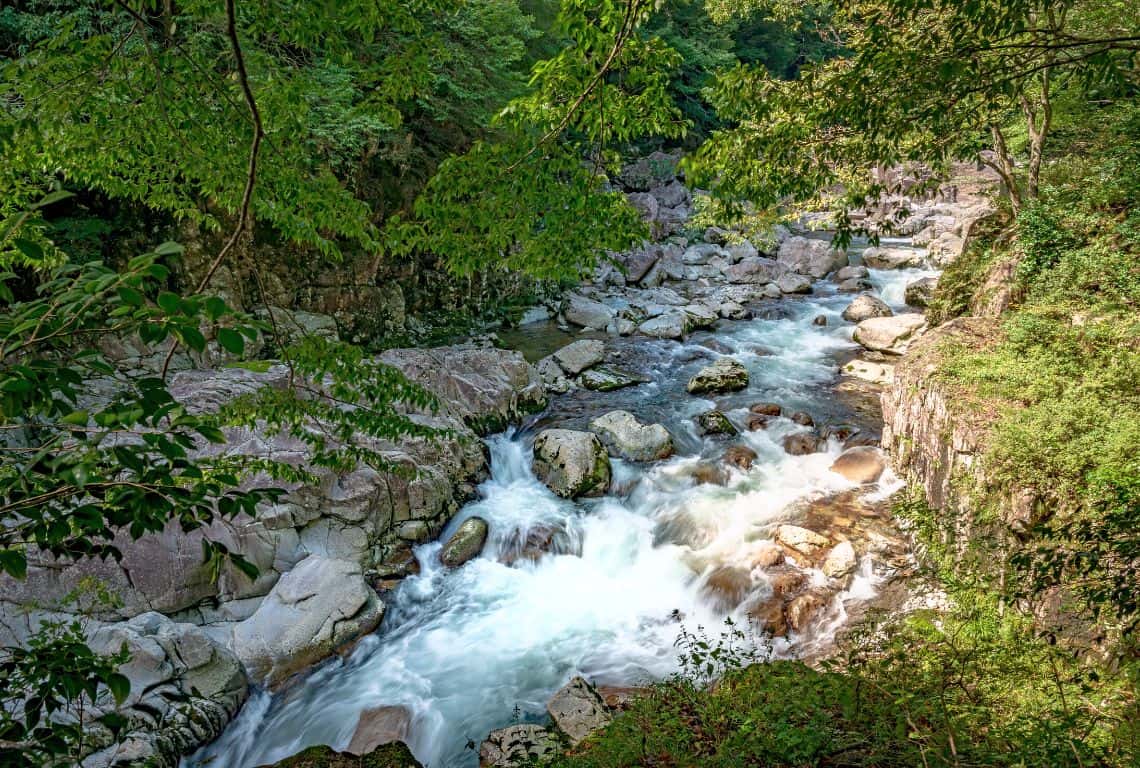
- Akadaki (Red Falls)
Continue on, and maybe after 10 minutes, and on your right, you will spot a smaller waterfall called Akadaki (Red Falls) . It is a really beautiful waterfall with red soil showing through the cascading water.
After about 1-hour hike from the entrance of the gorge, you will arrive at Meotobuchi.
Meotobuchi is a pool and it is famous for its blue water. It is one of the most scenic spots on the hike. Furthermore, it is also known as one of the most romantic places on this hike.
There is an elevated platform, which gives great views and it is a perfect spot to take some pictures.
Next, you will reach Ishidoi. Here the walls of the gorge narrow, creating a breathtaking point with the river pushing through among high rocks on either side.
Kurobuchi (Black Abyss)
Kurobuchi is one of the most famous spots along this trail. It is a deep pool surrounded by 100–meter-tall rocks.
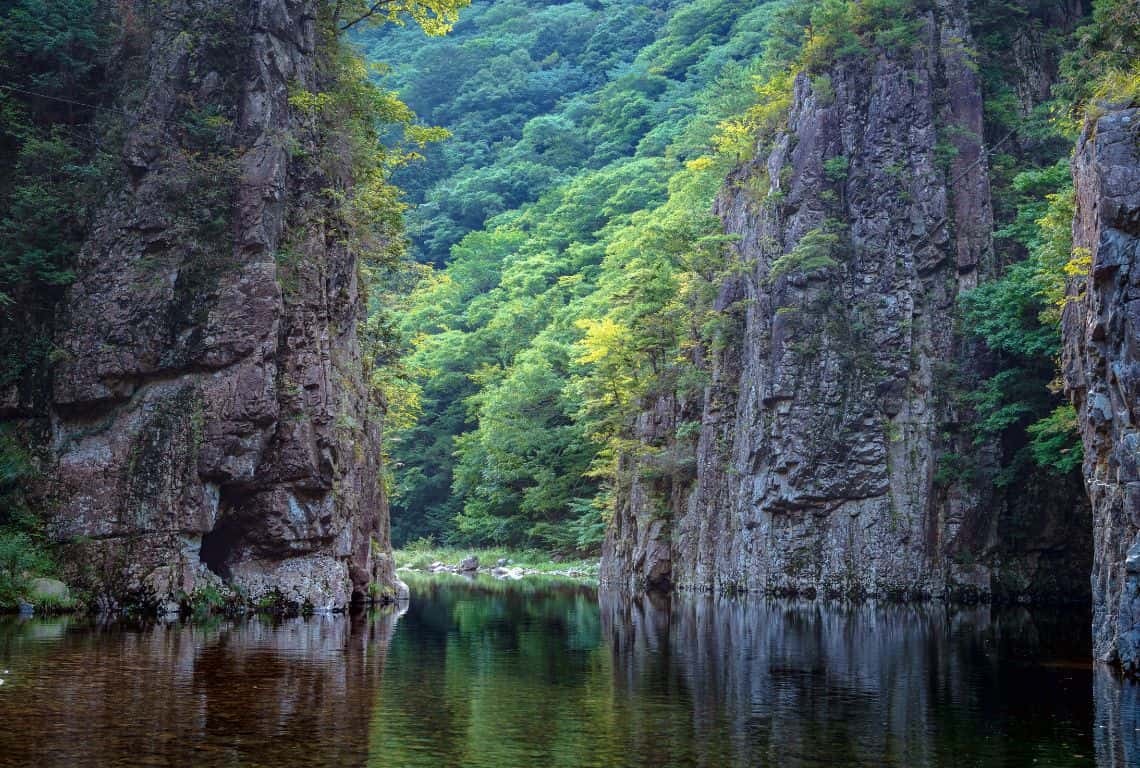
My recommendation is to take a boat ride to Kurobuchiso . It costs 300 yen, and it is totally worth it! The boats run from the end of April through the end of November.
When you reach Kurobuchiso , you should stop for lunch. There is a restaurant Kurofuchi-so where you can taste famous grilled yamame (landlocked salmon) and rice balls cooked in the super soft water of Sandankyo Gorge. The views of the ravine are absolutely splendid here!
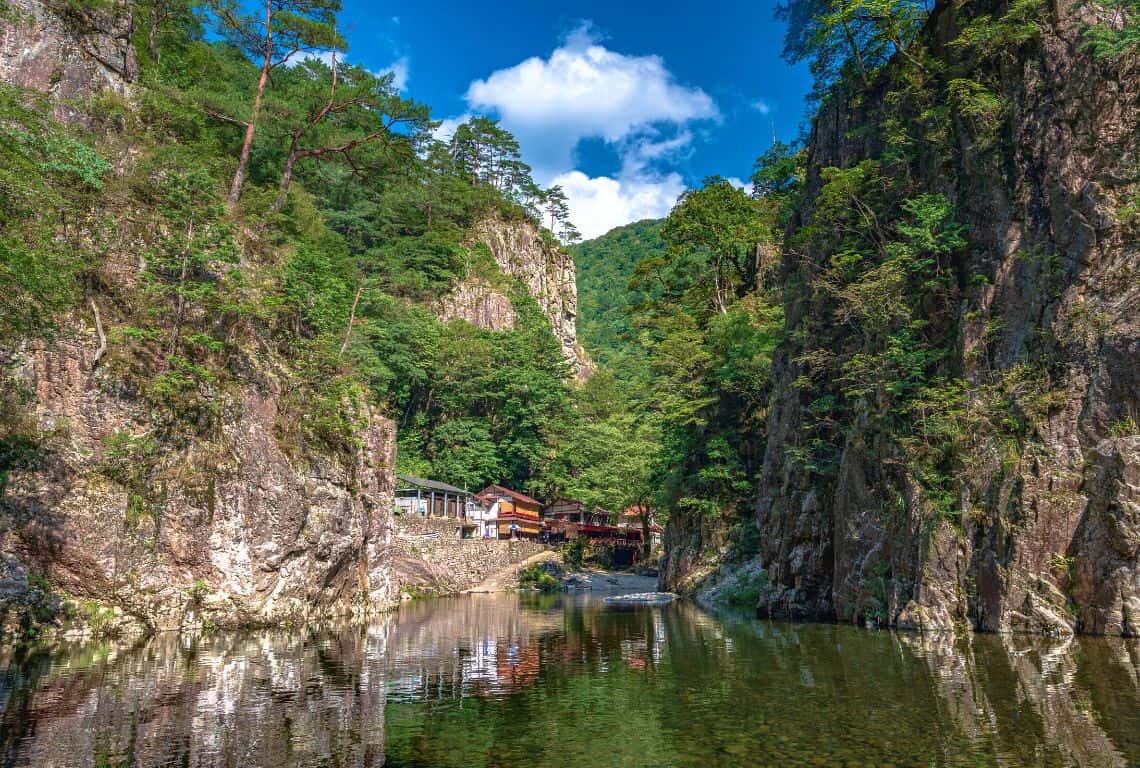
Next, it all depends on how much time you have! You can continue on the trail up to the remaining key sights of Sarutobi, Nidandaki, and Sandandaki, or head back to the bus stop.
Day Trip from Hiroshima to Takehara (Hiroshima's Little Kyoto) and Okunoshima (Rabbit Island)
Take a stroll back in time at Takehara, also known as ‘Hiroshima’s Little Kyoto’, and then visit Okunoshima Island, also known as ‘Rabbit Island’. It is one of the most diverse day trips from Hiroshima.
How to Get from Hiroshima to Takehara and Okunoshima
First, get to Hiroshima Bus Center. Next, take the bus to Takehara . It is about an 1hour and 20 minutes ride. And, then walk to the town center, which is no more than a 15-minute walk.
If you prefer to take the train, then head to Hiroshima Station. Next, take either a bullet or a regular train to Mihara Station . Finally, transfer to the JR Kure Line for Hiro and get off at Takehara Station .
Once you are done visiting Takehara, it is time to head to Okunoshima.
First, take a train from Takehara Station to Tadanoumi Station . It is about a 15-minute train ride. Next, from Tadanoumi Station walk to Tadanoumi Port to catch the ferry. It is no more than a 5-minute walk to where the ferry is located. Finally, board the ferry and enjoy the views. You will reach Okunoshima in about 15 minutes.
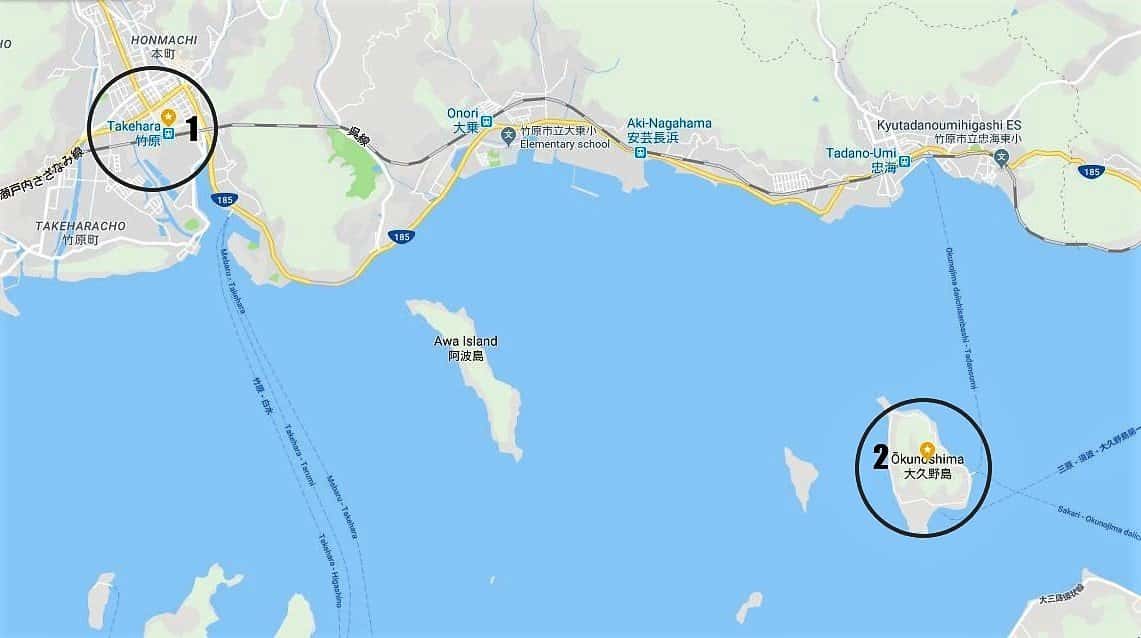
Map of How to Get from Hiroshima to Takehara and Okunoshima / Day Trips from Hiroshima
What to See in Takehara
Takehara preserved historical town.
Takehara achieved its modest fame and Edo-era prosperity from sea salt cultivation and sake making . At present, the area is famed for its preserved historical townscape.
The streets of Takehara are lined with traditional wooden buildings going back to the Edo period (1603-1867).
While you are taking a stroll, take a closer look at the buildings and notice the paper-art-like panel lattice . It is called ‘Takehara Lattice’ and it is adorning many buildings.
You should know that Takehara’s old town is designated as an important preservation district of historic buildings.
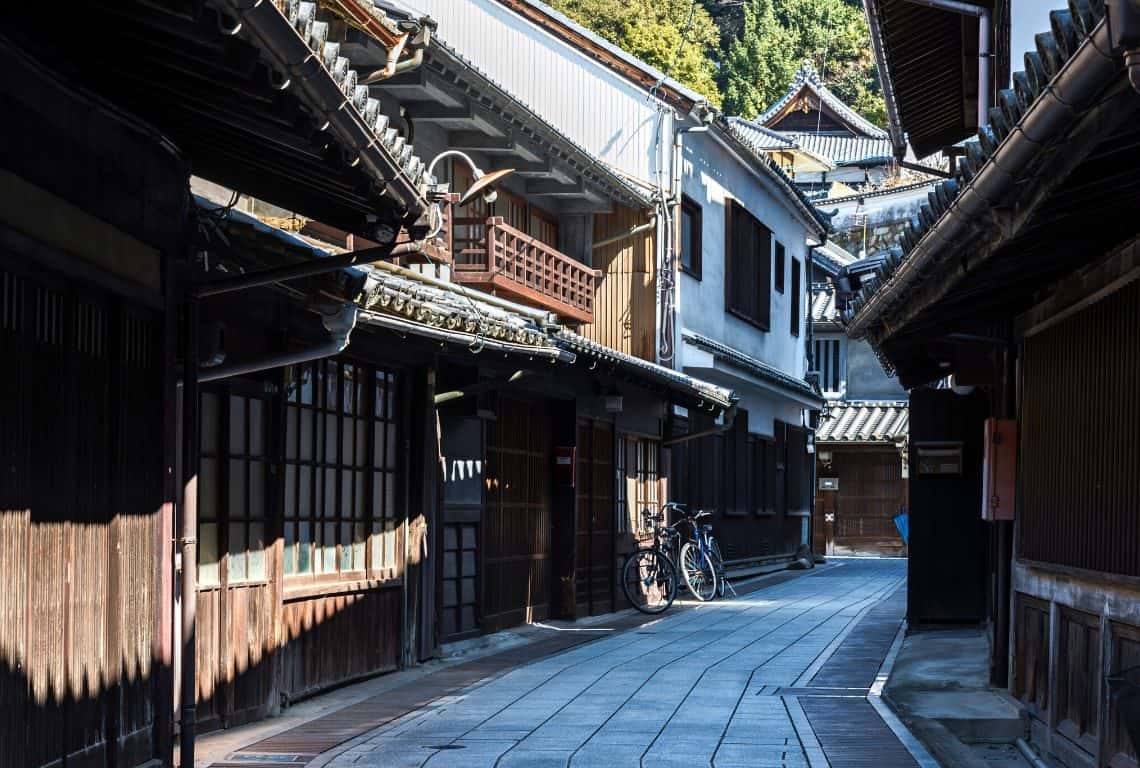
Takehara Preserved Historical Town / Day Trips from Hiroshima
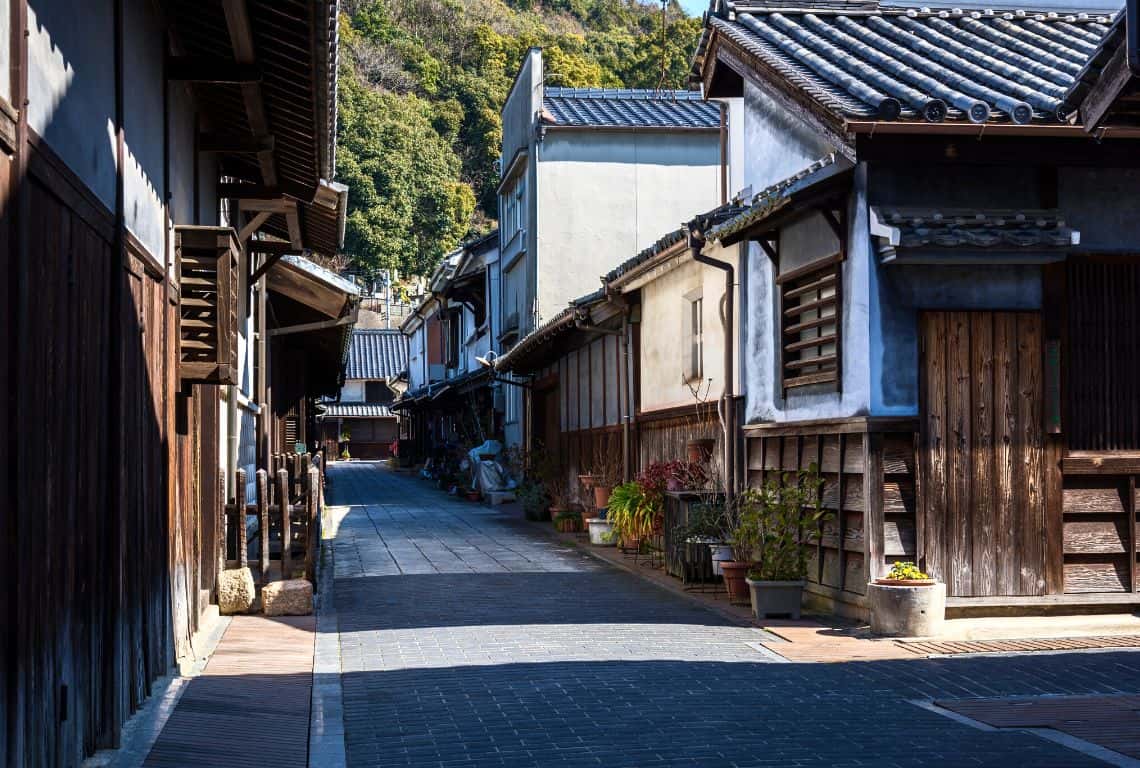
Taketsuru Sake Brewery and Ozasaya Sake Museum
Next, visit the Taketsuru Sake Brewery and Ozasaya Sake Museum to learn about how sake is brewed.
In addition, find out about Masataka Taketsuru who was born in Takehara and who is the founder of The Nikka Whisky , one of the renowned whisky brewers in Japan.
What to See on Okunoshima Island
Once you are done visiting Takehara, head to Okunoshima Island.
Okunoshima Island is a small island, with a circumference of about 4 km.
At present, it is known as a home to a bunch of roaming rabbits .
However, Okunoshima was formerly a secret island producing poison gas for the Japanese military. Make sure to visit the Poison Gas Museum to learn about the effects of the deadly gas and to remember the victims of the attacks.
See and Feed the Rabbits
It is just fun and relaxing to see all these rabbits roaming around.
Make sure to buy some carrots and cabbage before heading to the island.
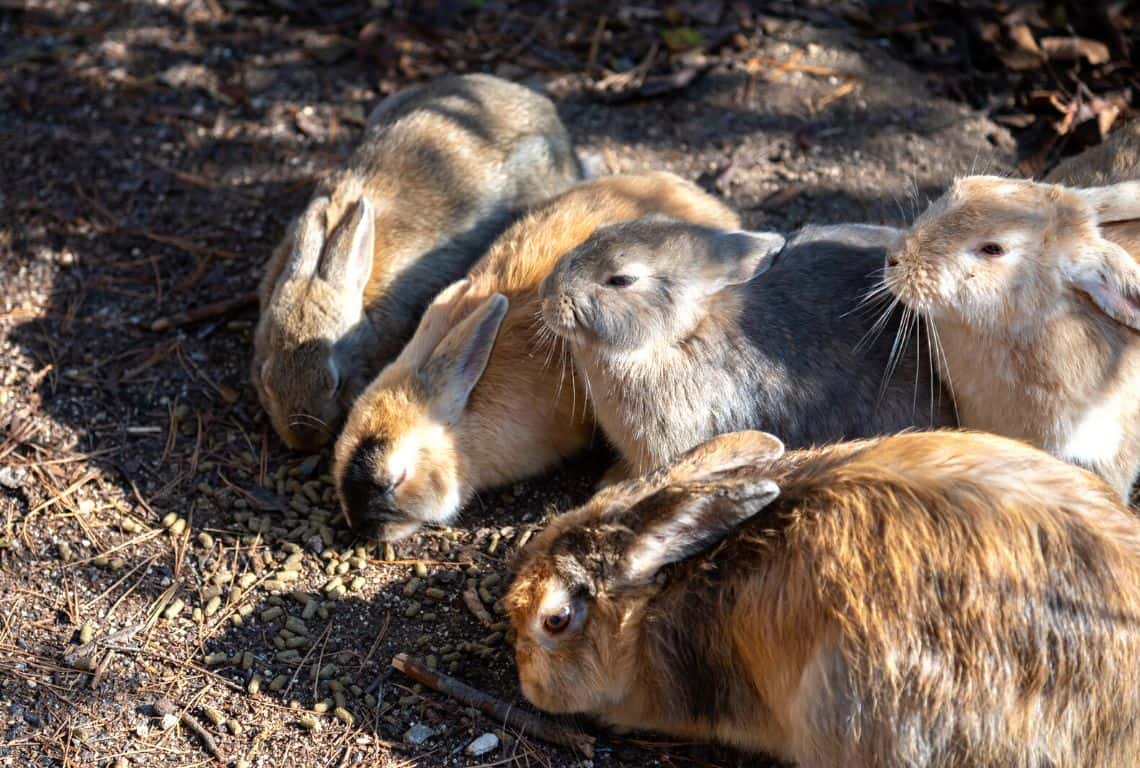
See and Feed the Rabbits on Okunoshima Island / Day Trips from Hiroshima
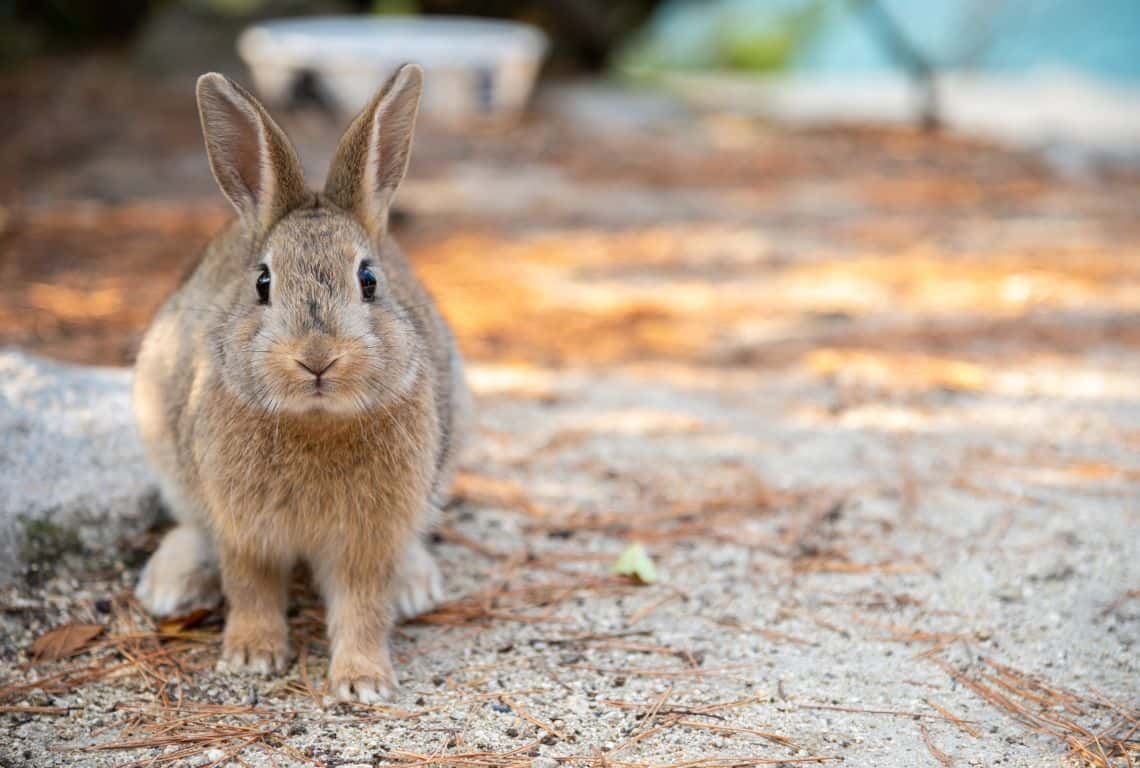
Poison Gas Museum
Poison Gas Museum was created in 1988 to remind us about the deadly gas that was manufactured on the island. It displays the materials from that time and explains the misery brought by the gas.
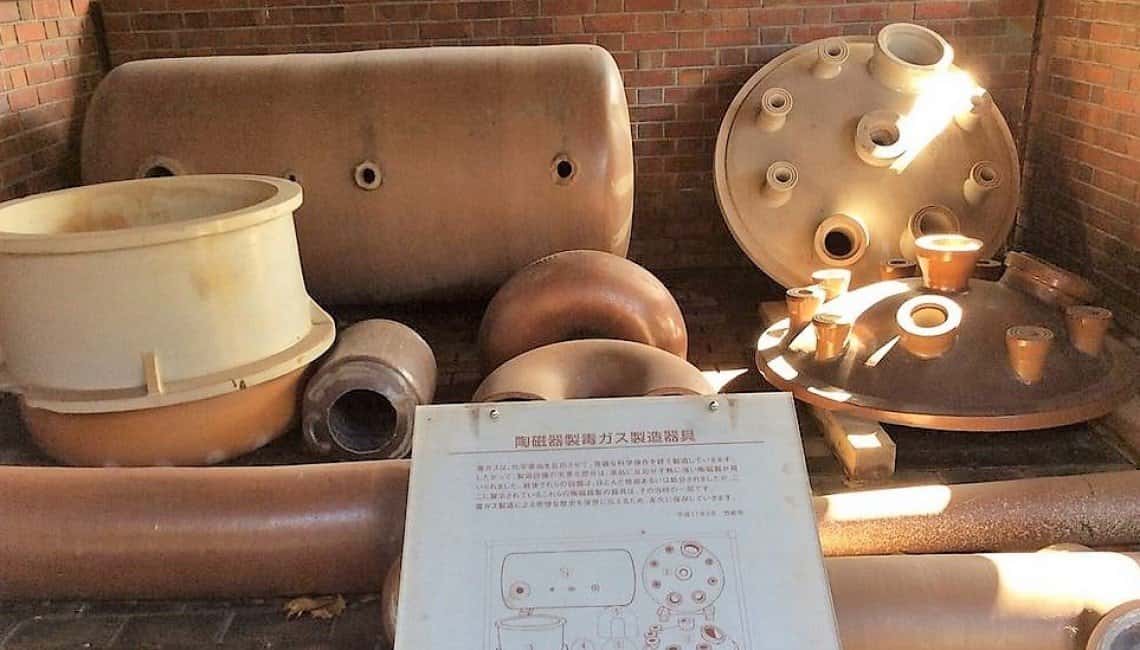
Poison Gas Museum / Day Trips from Hiroshima
Hike Around the Island
Finally, go for a hike around the island and stop once in a while to feed the rabbits and take some pictures of them
The views from the island are breathtaking!
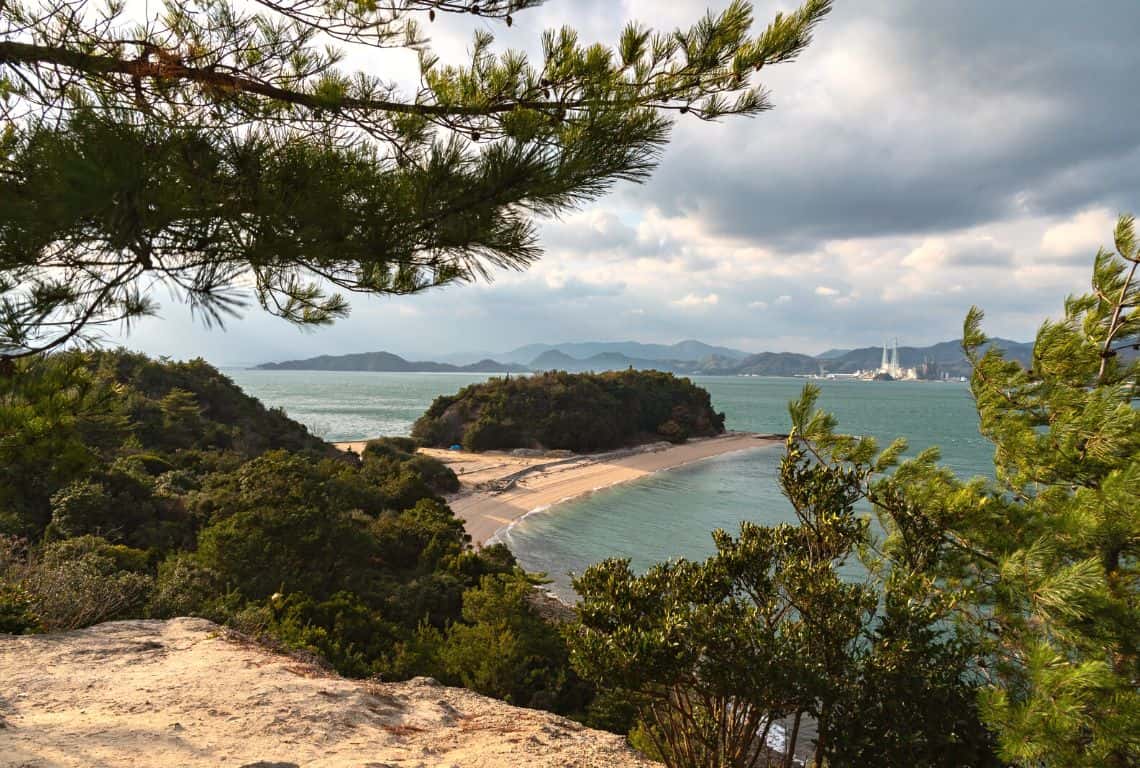
Hike Around Okunoshima Island / Day Trips from Hiroshima
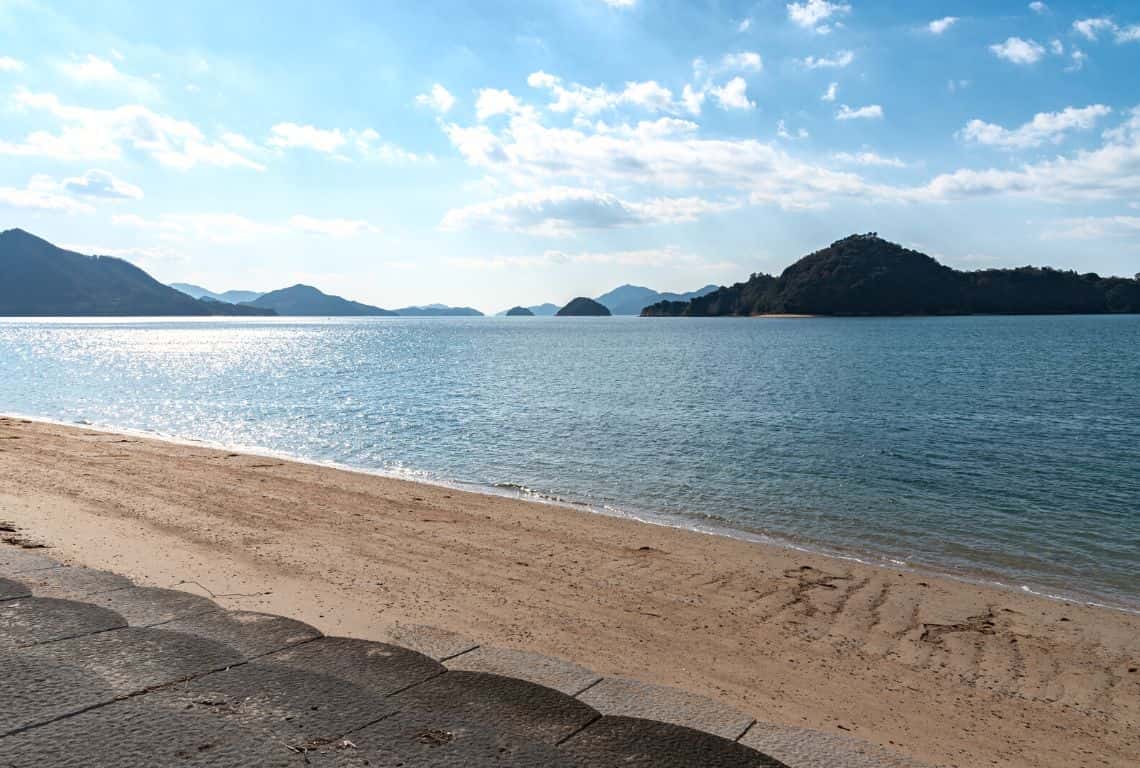
Day Trip from Hiroshima to Iwakuni
The Kintaikyo Bridge has been Iwakuni’s most distinguished landmark and a subject of admiration for hundreds of years.
However, there is so much more to explore in Iwakuni. Visiting Iwakuni is another of my favorite day trips from Hiroshima.
How to Get from Hiroshima to Iwakuni
Take JR Sanyo Line from Hiroshima Station to Iwakuni Station . It takes about 1 hour to reach Iwakuni from Hiroshima.
Next, take a bus from Iwakuni Station to Kintaikyo Bridge . The bus stop is right outside the station. The trip on the bus takes about 20 minutes.
Once you arrive at Iwakuni Station , make sure to purchase a combination entrance ticket which will include:
- entrance to cross the bridge
- ropeway to and from Iwakuni Castle
- Iwakuni Castle castle admission ticket
What to See in Iwakuni
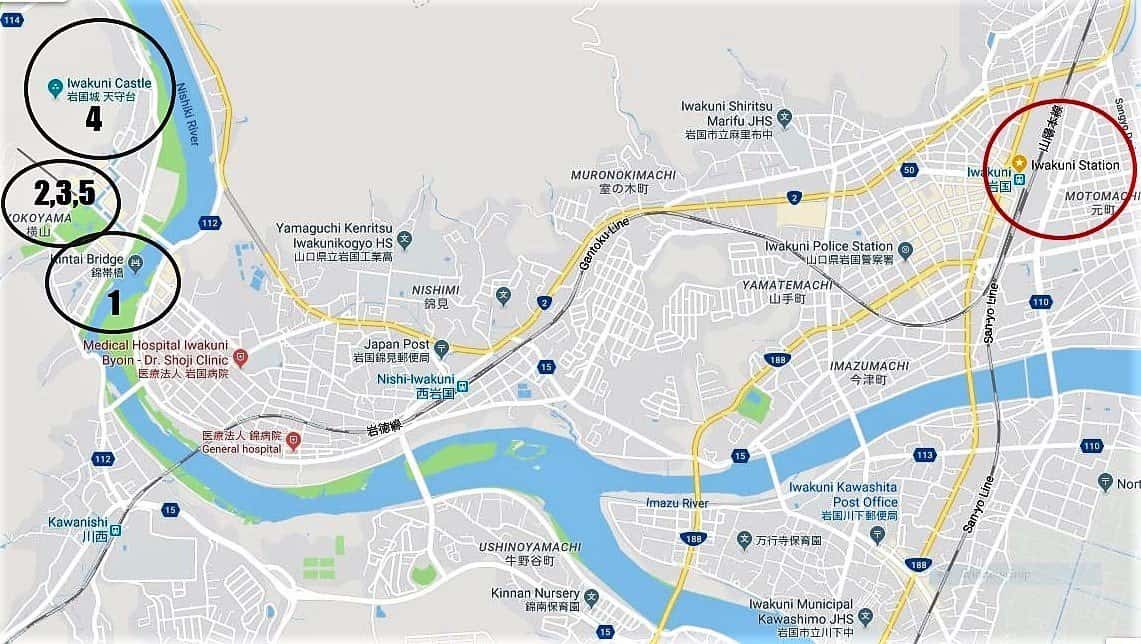
Legend: 1. Kintaiko Bridge, 2. Kikko Park, 3. The Ropeway, 4. Iwakuni Castle, 5. The White Snake Museum
Kintaikyo Bridge
Kintaikyo bridge is a magnificent pedestrian wooden bridge. It is made of five massive arches standing atop four stone piers.
Kintaikyo was built in 1673 using only wood ( no metal pins or nails were used in the construction ). Five different types of wood were used in the construction of the bridge – Japanese zelkova, pine, chestnut, oak, and cypress.
Interestingly enough, only samurai were allowed to cross the bridge.
Kintaikyo Bridge kept standing until 1950 when it was destroyed by a typhoon. The reconstruction of the bridge was completed in 1953.
In the early 2000s, Kintaikyo underwent extensive renovations, which cost over two billion yen.
The admission cost to the bridge (round trip over the bridge) is 300 yen. However, if you are continuing to explore the area, then make sure to purchase a combo ticket that includes the bridge, castle, and ropeway.
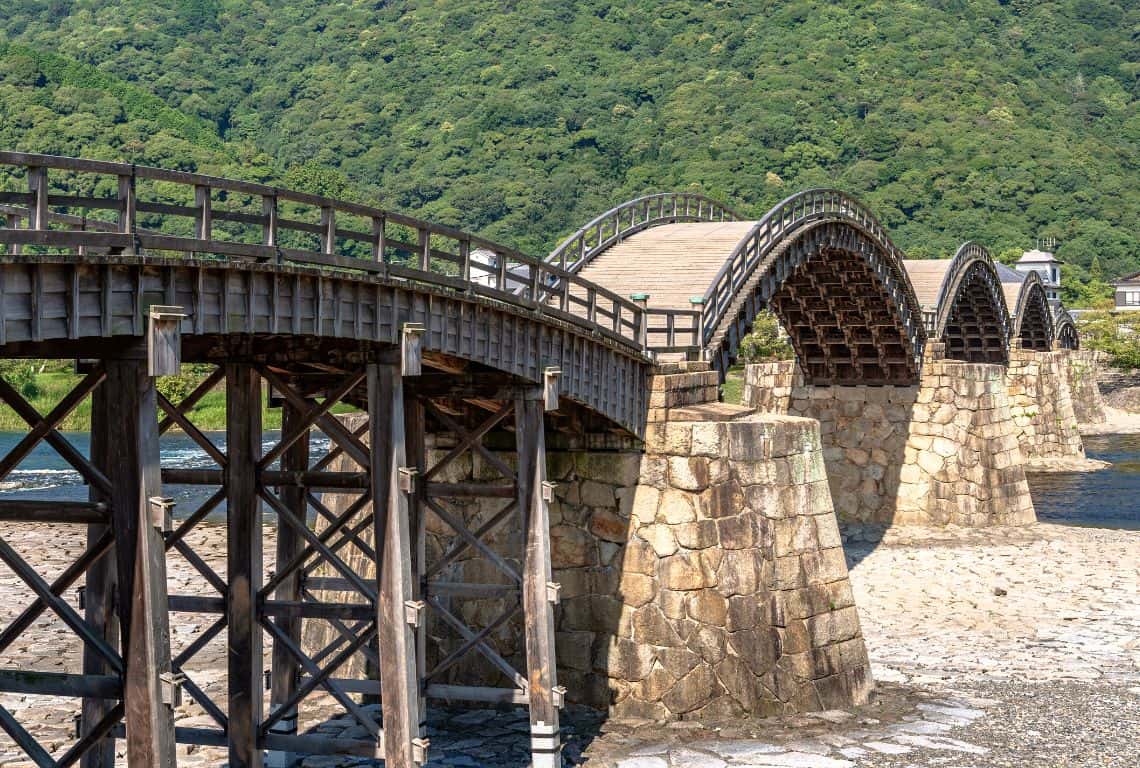
Kintaikyo Bridge / Day Trips from Hiroshima
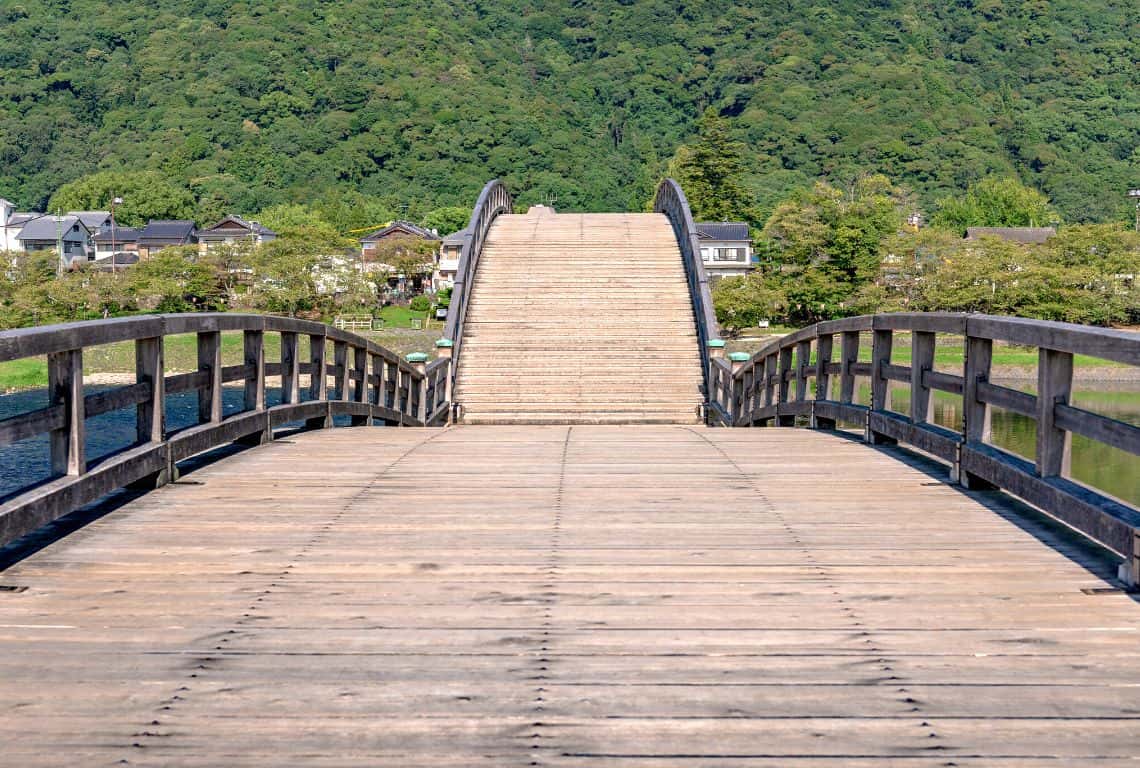
If you are planning your day trips from Hiroshima during springtime , then Kikko Park is a place to be!
Kikko Park is one of the top best cherry blossom viewing spots in Japan!
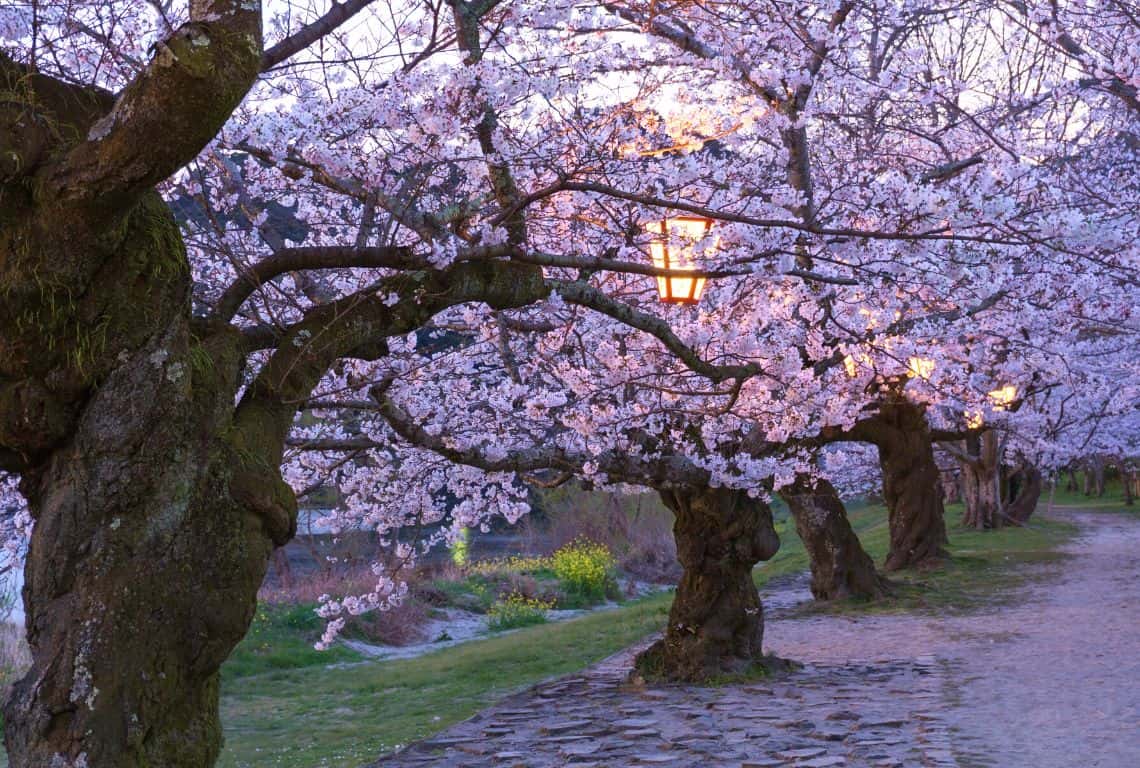
Cherry Blossoms in Iwakuni / Day Trips from Hiroshima
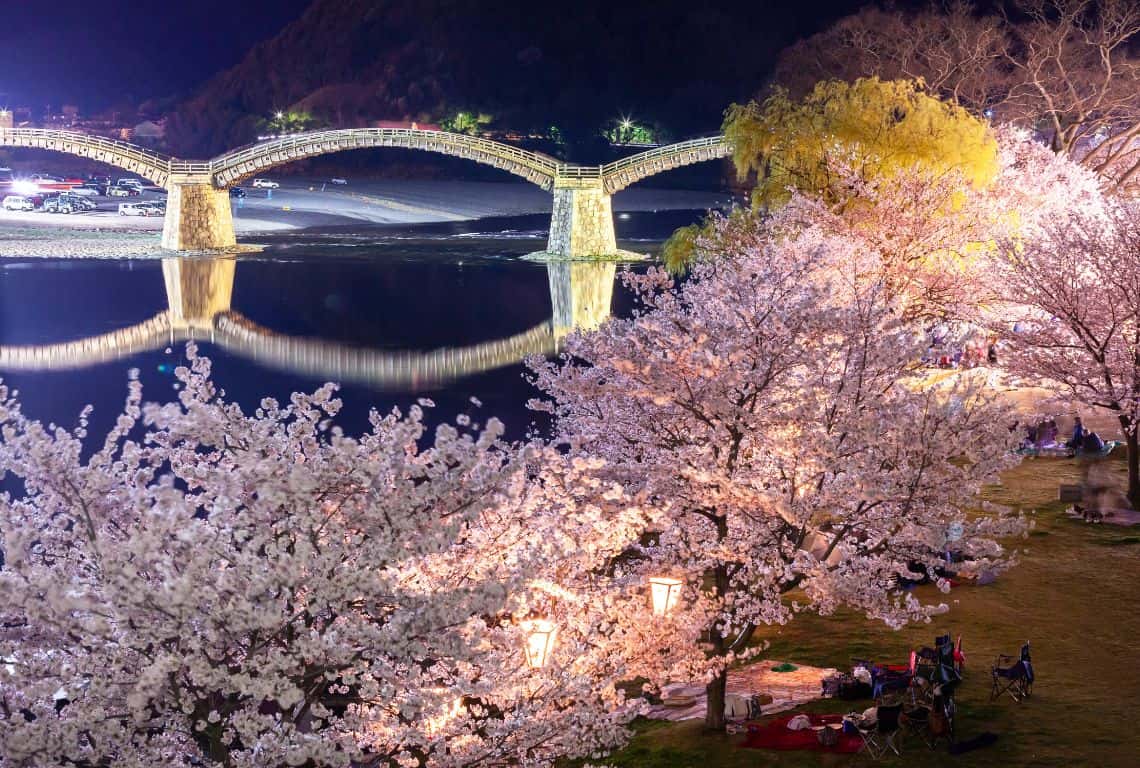
The entrance to the park is overseen by a statue of Hiroyoshi Kikkawa, the feudal lord who directed the construction of the Kintaikyo.
Inside the park, there are several samurai family-owned houses, however, they are used as private residences and it is not possible to tour them.
As you are strolling through the park, there are places where cormorant birds are housed. If possible, be there around noon when it’s feeding time.
If you happen to be visiting in the summertime, check out the ancient Japanese art of cormorant fishing .
The fishermen dressed in traditional costumes use trained cormorant birds to catch fish. The birds have a ring around their necks that keeps them from swallowing the fish.
It is quite a spectacular event. It takes place in the evening and into the night. The fishermen use torches to lure the fish. You can watch from ashore, or you can join the boat.
The cormorant fishing boats start leaving at around 6:30 pm from a spot next to Kintaikyo Bridge and the fishing starts at around 8 pm.
In addition, there are two museums worth checking out:
- the Choko-ka – is a library with historical documents and scroll paintings
- the Kikkawa Museum – is dedicated to the family of warlords, and includes some of their weapons
Next, take the cable car up Shiroyama mountain to the Iwakuni Castle. The views along the way to the top are pretty spectacular !
The top of Shiroyama mountain is a nature preserve. If you have time, then go for a short hike as well.
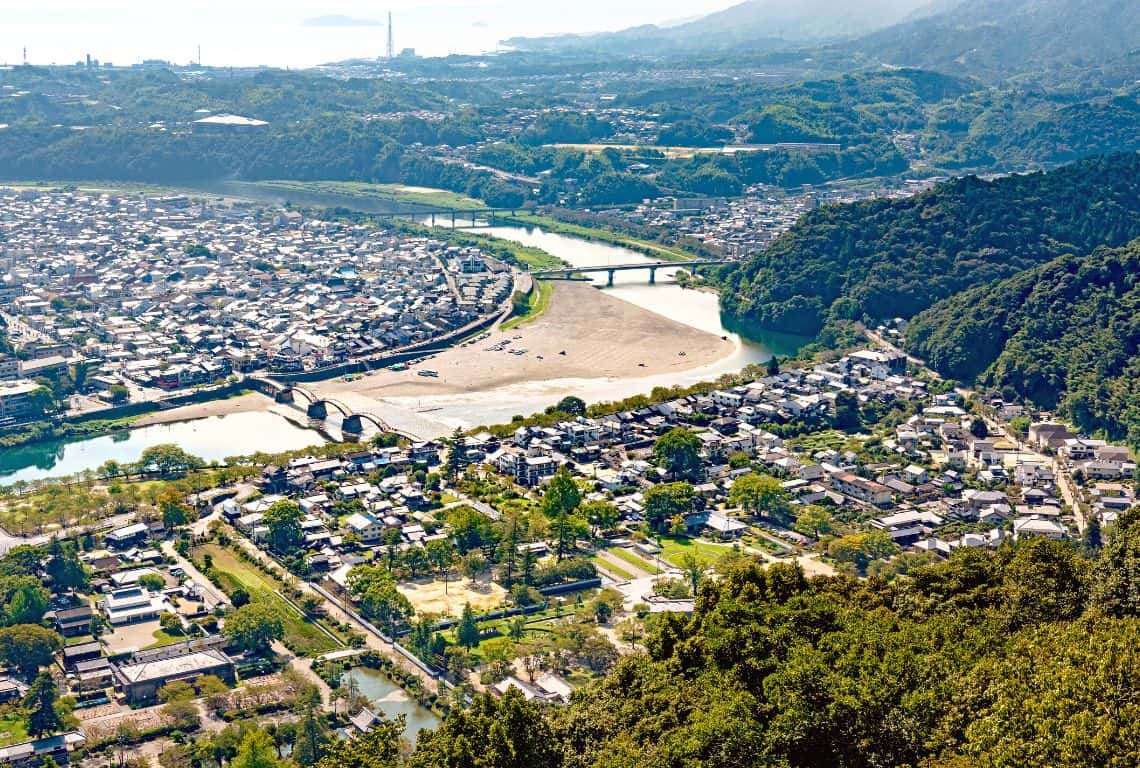
Views of Iwakuni / Day Trips from Hiroshima
Iwakuni Castle
Iwakuni Castle was built in 1608. The site of the castle was chosen for its natural defensive advantages. It is perfectly positioned on top of Mount Shiroyama and half surrounded by a natural moat, the Nishiki River.
Interestingly enough, the castle lasted only about 7 years when it was torn down by the decree of Tokugawa Ieyasu .
The present castle was reconstructed in 1962.
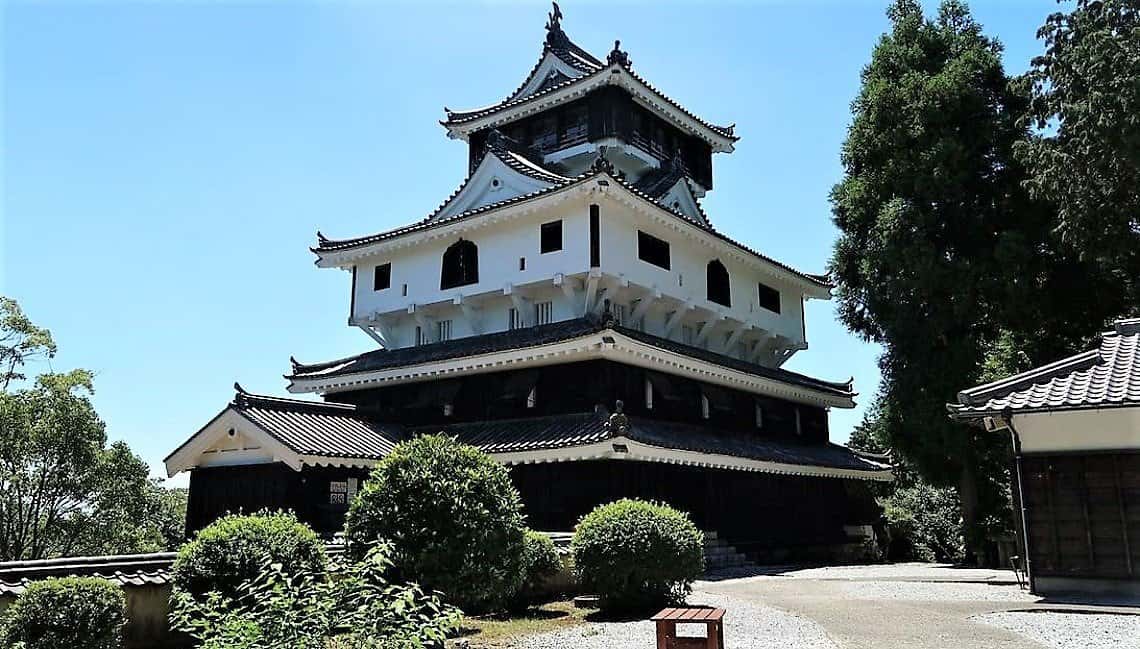
Iwakuni Castle / Day Trips from Hiroshima
Inside the castle, you will find a great display of samurai swords, armor, and other items related to the castle’s history.
In addition, there is a very informative display on Kintaikyo Bridge, as well as other famous bridges across Japan.
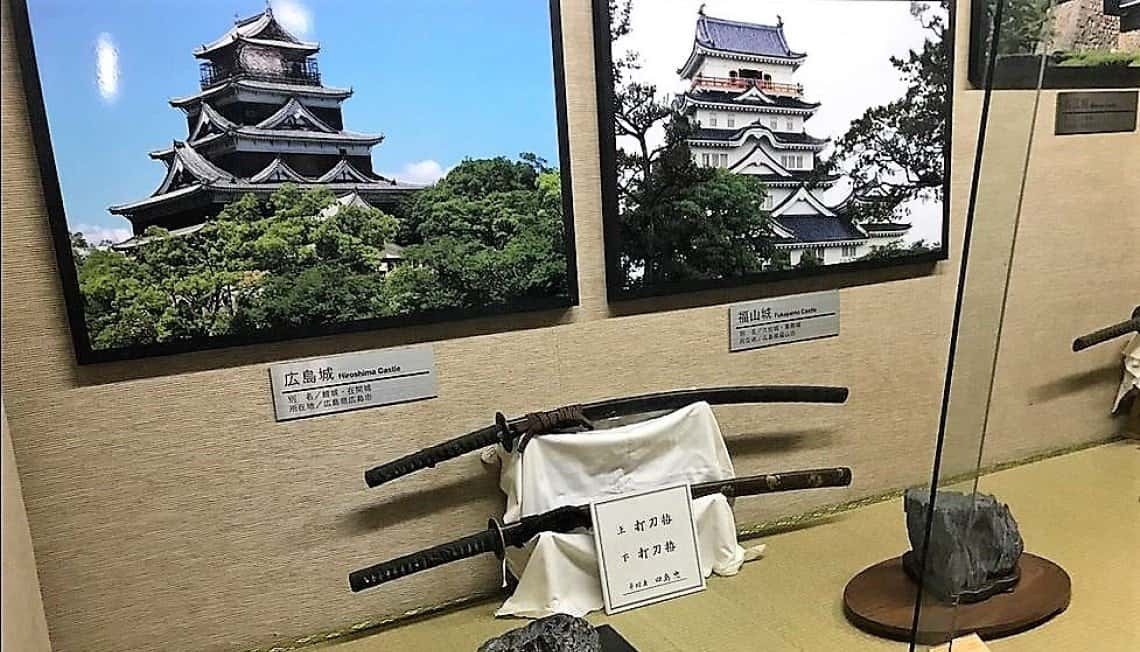
The White Snake Museum
The White Snake Museum has a collection of white snakes , which are native to the Iwakuni area.
Interestingly enough, white snakes can grow to around 1.8 meters in length. They are quite beautiful with red eyes and white or ivory-yellow scales.
White snakes have been designated as national treasures .
By the way, the Japanese revere these animals and believe that they are messengers of Beten, the Japanese goddess of wealth. Also, they are considered a sign of good luck
Admission to the museum is free and for opening hours click here .
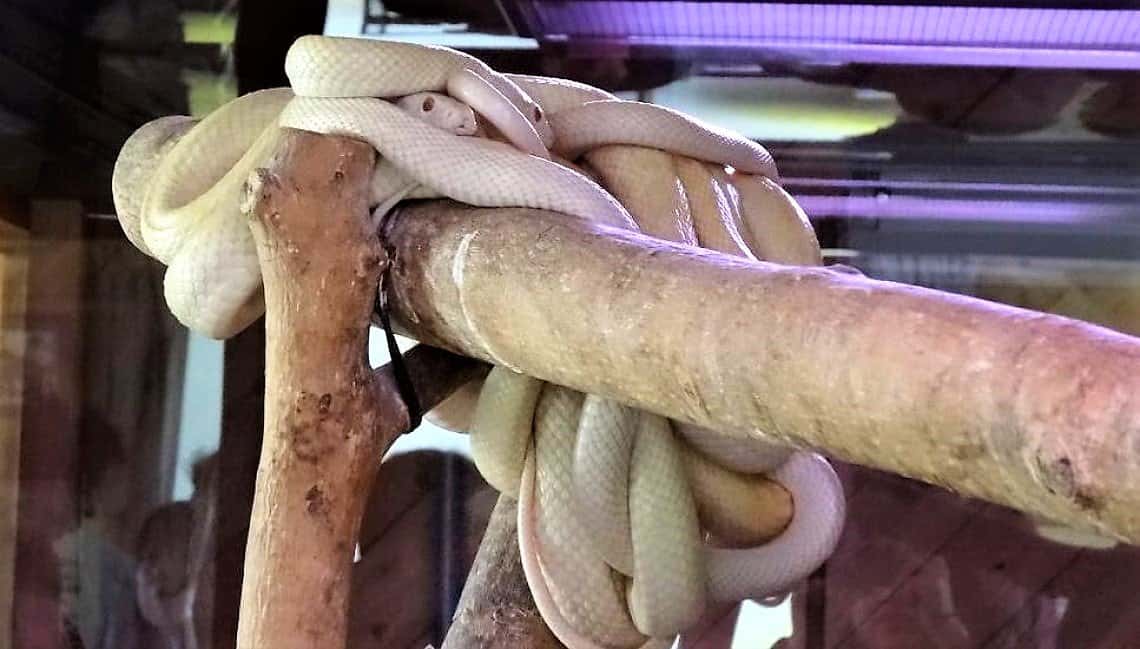
The White Snake Museum / Day Trips from Hiroshima
Where to Stay in Iwakuni
If you decide to stay the night in Iwakuni, I would recommend that you check out Iwakuni Kokusai Kanko Hotel .
First of all, the hotel is located right by all the main attractions in Iwakuni. Actually, you will be able to see the stunning Kintaikyo Bridge right from your room!
Where to Eat in Iwakuni
Iroro Sanzoku ‘Chicken Shack’ is one of the most popular places to grab a bite while you are visiting Iwakuni.
It is a large sprawling restaurant on the side of a mountain. There is inside dining, as well as open-air dining. If you are visiting during the summer months, then grab a seat under the trees.
They serve grilled chicken on a stick. I recommend that you add a miso soup, rice, or some other accompaniments to complete your meal. My favorite is their Sanzoku Yaki and most definitely their gyoza!
For location, hours, and how to order click here .
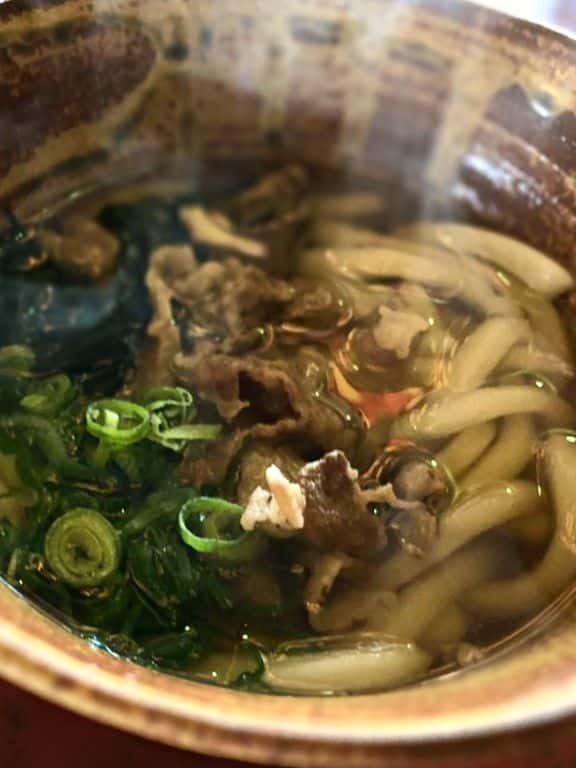
Where to Eat in Iwakuni / Day Trips from Hiroshima
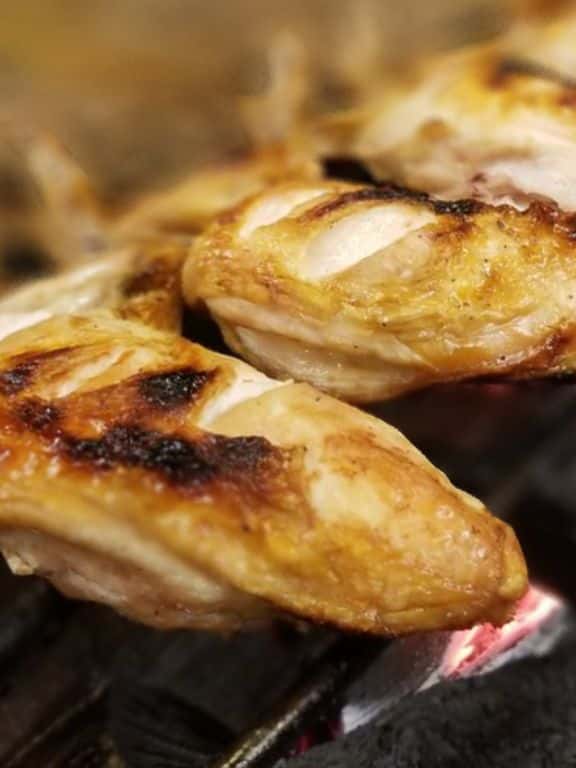
Intrepid Scout's Tips for Day Trips from Hiroshima
That is quite a list, right? What if you only have time for one day trip from Hiroshima? Where should you go?
- Hands down, if you like art then head to Naoshima ! And make sure to spend the night at the Benesse House Museum Hotel.
- If you like nature and hiking, then head to Sandankyo Gorge . The scenery is breathtaking.
- My favorite day trip from Hiroshima is Miyajima Island . it has it all… history, nature, and great places to eat and stay. You can’t go wrong with a day trip to Miyajima! Before you start planning make sure to read Day Trip to Miyajima (9 Things You Can’t Miss) .
More Information About Japan:
14 Amazing Things to Do in Arashiyama (Map+Useful Tips)
What to See at Nijo Castle in Kyoto (10 Top Things to Know)
Stunning Golden Pavilion in Kyoto (How to Visit and What to See)
Amazing Fushimi Inari Taisha in Kyoto (8 Things to Know Before You Visit)
First Visit to Kyoto – How to Visit and What to See (11 Things You Can’t Miss)
Perfect Day Trip to Miyajima from Kyoto, Osaka, or Hiroshima
10 Amazing Things to Do in Hiroshima You Can’t Miss of Your Visit
Read All the Posts About Japan in:
Japan Travel Guide
Did You Find Day Trips from Hiroshima Useful?
Why not save it to your pinterest board.
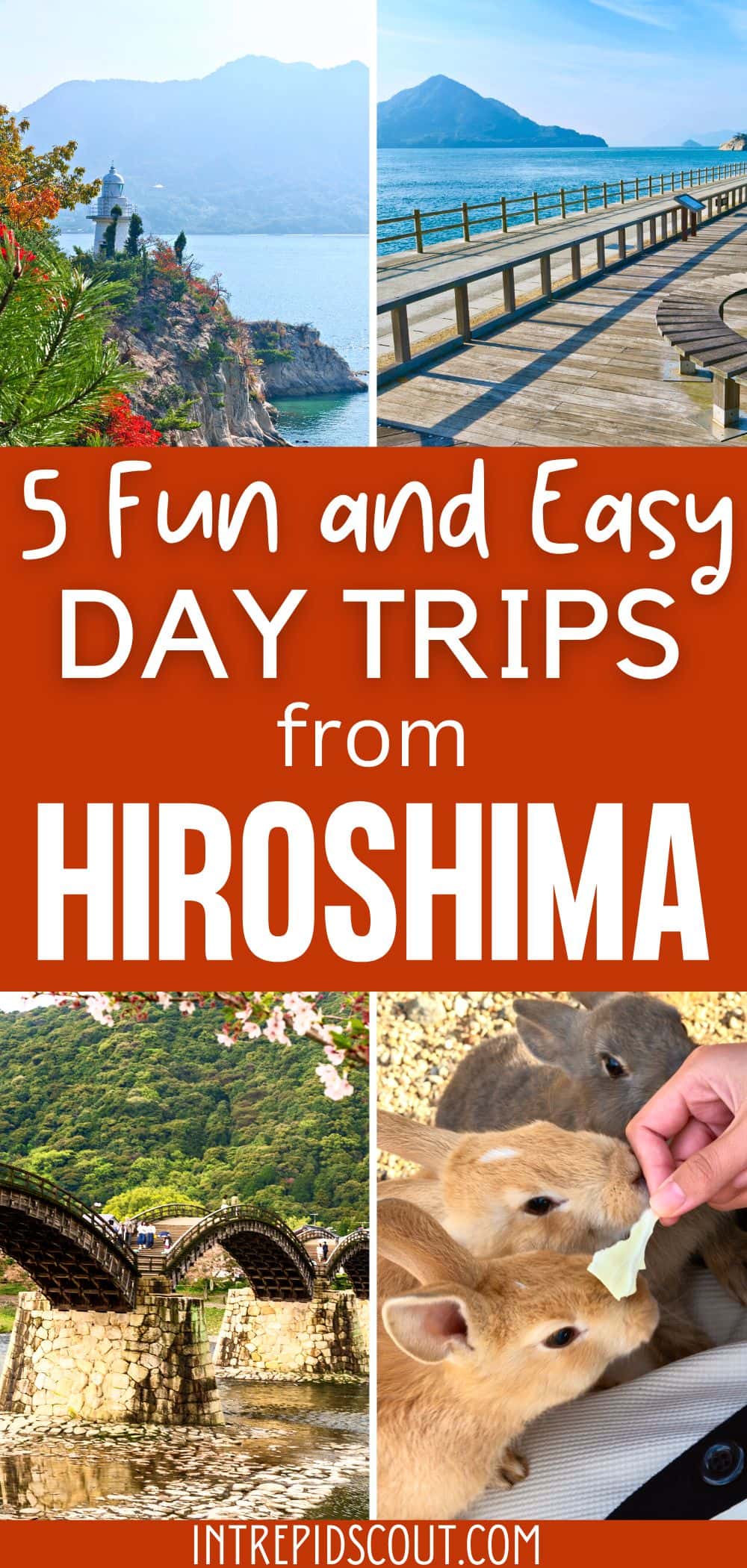
2 Days in Kyoto: The Perfect Kyoto Itinerary
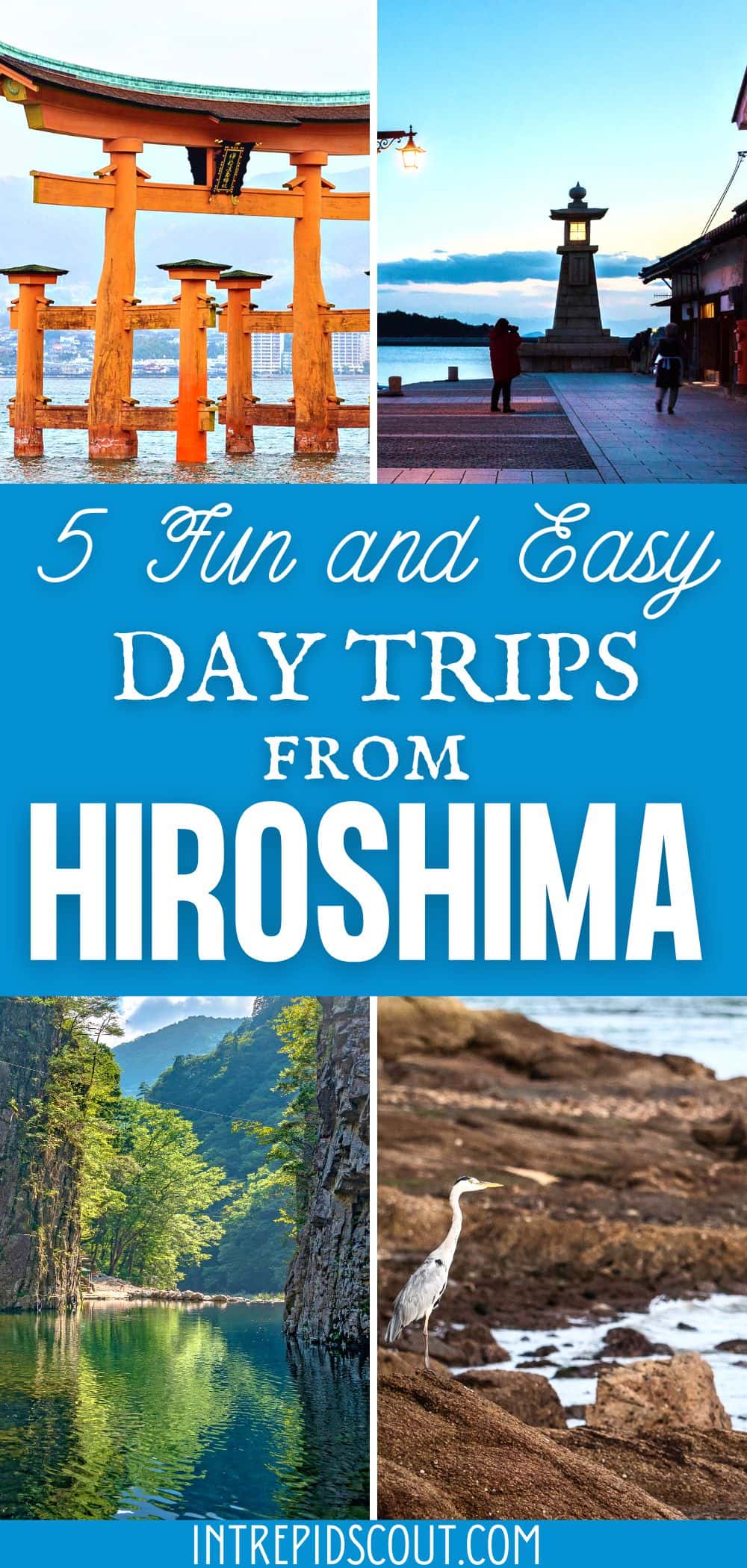
- alert('URL copied to clipboard.')).catch(err => console.error('Unable to copy to clipboard.', err))">
Share via Email
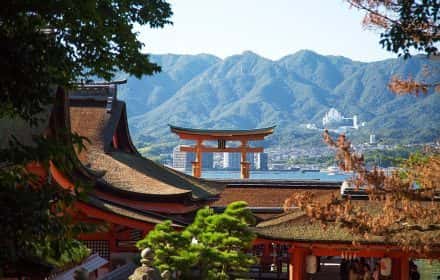
How to Visit HIROSHIMA and MIYAJIMA in ONE DAY (3 Easy Steps Guide)
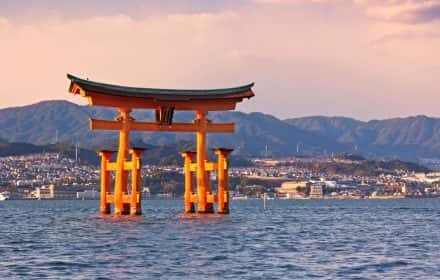
Perfect DAY TRIP to MIYAJIMA from Kyoto, Osaka, or Hiroshima (9 Things to Do)
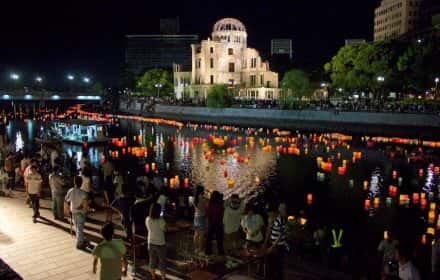
Hiroshima Peace Memorial Park SELF-GUIDED WALKING TOUR (8 Easy Steps)
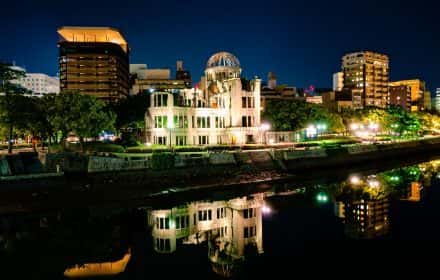
THINGS to DO in HIROSHIMA (10 Amazing Things to Do on Your First Visit)
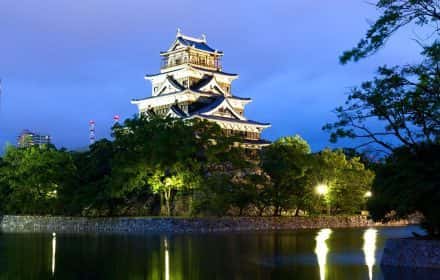
Perfect ONE DAY in HIROSHIMA (5 Things You Can't Miss+Useful Tips)
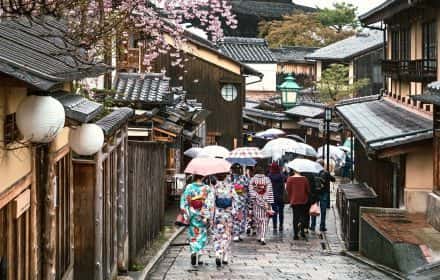
8 THINGS You Can't Miss - Perfect 2 DAYS in KYOTO
@intrepid.scout
13 thoughts on “ 5 Fun and Easy DAY TRIPS from HIROSHIMA (How to Get There+Things to Do+Where to Stay) ”
Fab post Anna! You found sooo many fantastic things to do near Hiroshima.
I am most interested in Sandankyo Gorge. I have been to Hiroshima quite a few times, but somehow that never came onto my radar. It looks beeeautiful though! I would love to visit Bunny Island and Naoshima too. Dammit, Japan has sooo much to see!
Thank you, Josy! I apologize if I misspelled your name in my previous responses. You know, you are so right, I have traveled the world, yet I am still writing about Japan. And, if you asked me: where would you like to go next? I would say, I need to go back to Japan to explore some more.
Lol I am exactly the same. I keep needing to go home to the UK (to visit new babies) but I want to visit Japan again and again!! I really miss living there. <3
Wonderful post – thank you for sharing. Sadly, we did not have time to visit Hiroshima on our trip to Japan a few years ago.
I see! Well, maybe next time?
Unbelievably fascinating! I didn’t know Hiroshima would be this interesting. I love the yellow pumpkin most of all. So definitely Naoshima Island for me. But the Iwakuni bridge is also special. Never mind the white stankes.
Hi Carol! Thank you for your comment! Hiroshima and the area around Hiroshima is definitely worth exploring.
I heard a lot about how Japan is a great country to visit! I really wish to go there someday and this island sounds a great place to spend time with family. I love how their are lots of things to do here and the foods you mentioned here is to die for. I love Japanese foods and their healthy options!
Thank you for your comment, April! I am sure you will go to Japan one day!
wow very informative post! Cant wait to go in Japan <3
Hello! Oh, plan your trip! you will love it!
Superb! thanks for all the information.
I am glad you found it useful!
Leave an answer Cancel reply
Your email address will not be published. Required fields are marked *
The company processes your data to facilitate the publication and management of comments. You can exercise your rights of access, rectification, deletion and objection, among others, according to our Privacy policy .
On day trip to Venice, resilient Pope hails art and hope

Pope Francis meets inmates at the Giudecca women’s prison in Venice on Sunday, April 28, 2024. (Credit: Vatican Media.)
ROME – Pope Francis made a day trip to Venice Sunday to attend a famed annual cultural event, meeting prisoners, artists and young people, stressing the role that art can play in shaping culture for the better and the importance of maintaining joy and hope amid the vicissitudes of life.
Despite recent health challenges for the 87-year-old pontiff, Francis appeared engaged and energetic throughout his itinerary. He arrived from Rome by helicopter and later boarded one of Venice’s famed motoscafi , or waterborne taxis, to reach his meeting with youths. Throughout the day, Francis used a wheelchair to make his way to and from public appointments.
Speaking to 80 inmates at a women’s prison on the island of Giudecca, the pope said that “each of us, here, today, has something unique to give and to receive,” and that he himself would likely be the most enriched by the encounter.
He pointed to common problems in prisons, such as overcrowding, violence, and a lack of resources, but noted that despite the suffering these things generate, prisons can also become places “of moral and material rebirth.”
They can be places, he said, “where the dignity of women and men is not ‘placed in isolation’, but promoted through mutual respect and the nurturing of talents and abilities, perhaps dormant or imprisoned, but which can re-emerge for the good of all and which deserve attention and trust.”
“Paradoxically, a stay in prison can mark the beginning of something new, through the rediscovery of the unsuspected beauty in us and in others,” he said, saying a prison can become “a building site for reconstruction” that offers a new perspective on one’s life, and the ability to lay a new foundation.
Pope Francis traveled to Venice Saturday for the city’s annual “Biennale” festival, which featured various works of art, architecture, cinema, dance, music, theater and more. It marked the first time a pope has ever attended the Biennale, which began in 1895 and is one of the largest annual cultural events in Europe.
As part of his day trip, Francis also met with artists participating in the Biennale inside the prison chapel, and he held a meeting with young people in front of Venice’s Basilica of Santa Maria della Salute.
He closed his visit with Mass in the square in front of the city’s famed Basilica of Saint Mark, where the remains of Mark the Evangelist, author of one of the four Gospels, are buried.
Francesco Moraglia, Patriarch of Venice, accompanied the pope throughout his visit.
In his brief speech to artists, the pope said the world needed them, and highlighted the role of art as a tool of inclusion opposed to various forms of violence and discrimination.
Art itself, he said, is “a city of refuge, a city that disobeys the regime of violence and discrimination in order to create forms of human belonging capable of recognizing, including, protecting and embracing everyone. Everyone, starting from the last.”
“It would be important if the various artistic practices could establish themselves everywhere as a sort of network of cities of refuge, cooperating to rid the world of the senseless and by now empty oppositions that seek to gain ground in racism, in xenophobia, in inequality, in ecological imbalance and aporophobia, that terrible neologism that means ‘phobia of the poor,’” he said.
Behind each of these attitudes, he said, is a “refusal of the other” and a selfishness that leads people to become isolated, pursuing individual interests.
He closed pointing to several female artists whose work he said has something to teach humanity, such as Frida Khalo, Corita Kent and Louise Bourgeois.
“I hope with all my heart that contemporary art can open our eyes, helping us to value adequately the contribution of women, as co-protagonists of the human adventure,” he said.
In his meeting with 1,500 young people, Pope Francis told them they were made for heaven, and that they must “rise to stand in front of life, not to sit on the couch.”
“Get out of bed and accept yourself as a gift…Remember that for God, you are not a digital profile, but a child, that you have a Father in heaven and therefore you are a child of heaven,” he said, saying the must let themselves be picked up in a world that often wants to pull them down.
Francis noted that God worked wonders with the weakness of many characters in the bible, and that despite whatever feelings of inadequacy they might have, young people can be encouraged by this, because for God, beauty and fragility often go together.
“He is our Father and, when we are down, he sees children to lift up, not evildoers to punish. Trust in him!” he said, telling young people to keep standing “when we feel like sitting down, letting go, or giving up. It is not easy, but this is the secret.”
“Take life into your hands, get involved; turn off the TV and open the Gospel; leave the cell phone and encounter people!” he said, saying they could keep the cell phone, but only if they made a point of encountering those around them.
Rather, he told them to be “creators of new things! Be creative with gratuitousness; bring to life a symphony of gratuitousness in a world that seeks profit! Then you will be revolutionaries.”
Francis closed his visit to Venice with Mass in Saint Mark’s Square, during which he reflected on the role of Christians in fighting global challenges through the pursuit of solidarity, justice, and genuine community, with no one excluded.
He took his cue from the biblical passage from the day’s Gospel reading, “Whoever remains in me and I in him will bear much fruit.”
“While the metaphor of the vine expresses God’s loving care for us, it also warns us that if we sever this connection with the Lord, we cannot produce fruits of good life and risk becoming dry branches, which will be cast aside,” he said.
What matters, the pope said, is to “remain in the Lord,” which he said is not a passive or static attitude, but is rather an invitation “to move” and to enter into conversation with God and with scripture, and to follow Jesus “on the path of the Kingdom of God.”
Alluding to the image of the vine and branches, Pope Francis said the fruit of joy and hope that comes from God is what believers are called to bear in their daily lives, even in the face of challenges.
He pointed to issues of local concern in Venice such as climate change, the weaking of the construction of the “floating city,” and an inadequate management of tourism amid an overwhelming influx, among other things.
“All that these realities risk generating in terms of frayed social relations, individualism, and loneliness,” he said, saying Christians can help combat these things by bringing “the fruits of the Gospel into the reality we inhabit.”
“We need our Christian communities, neighborhoods, and cities to become welcoming, inclusive, and hospitable places,” he said, saying, “Venice, which has always been a place of encounter and cultural exchange, is called to be a sign of beauty available to all, starting with the last, a sign of fraternity and care for our common home.”
For the cost of a cup of coffee at Starbucks, you can help keep the lights on at Crux.

Tuesdays on

Crux . Anytime . Anywhere .
Today’s top stories delivered straight into your inbox.

- Elise Ann Allen

When Jesus speaks of prayer, there’s no ambiguity or confusion
- Father Jeffrey F. Kirby

Polemics over the past may hint at a Catholic vocation for memory
- John L. Allen Jr.

In Venice tomorrow, Pope will find a Church struggling against decline

Pope to take part in G7 summit in June to talk Artificial Intelligence

Pope calls for negotiated peace, blasts climate change skeptics in CBS interview

Vatican belatedly weighs in on Italian abortion row
- Skip to main content
- Keyboard shortcuts for audio player
As Venice grapples with overtourism, the city tests a 5-euro fee for day-trippers
Willem Marx
The storied city of Venice, Italy, has begun charging fees for day trips by tourists.
LEILA FADEL, HOST:
The Italian city of Venice has introduced a daily fee for visitors as part of an effort to control the crowds of tourists that too often overwhelm the city, especially in the summer months. But as Willem Marx reports, this new charge on arrivals is not proving entirely popular with all the locals.
(SOUNDBITE OF MUSIC)
WILLEM MARX, BYLINE: Venice is an iconic island city filled with baroque beauty and gliding gondolas, its ancient, narrow streets often crammed with crowds of visitors. Authorities recently barred cruise ships from docking in the lagoon around Venice. Now, this new plan means people arriving for just a day must pay 5 euros, roughly $5, for a ticket valid from 8:30 a.m. to 4:30 p.m. Given the crowds, city officials like Marco Bettini says this new approach has become unavoidable.
MARCO BETTINI: I cannot guarantee a suitable visit to the city if we don't know how many people are coming to Venice.
MARX: Young children and visitors who've booked a hotel will be exempt from the fee, and so will residents, but that doesn't mean all Venetians are happy about this new idea.
(SOUNDBITE OF ARCHIVED RECORDING)
UNIDENTIFIED PROTESTER #1: (Speaking Italian).
MARX: One man at this protest rally called it a sad day for Venice, as the new entrance fee turned his city into a museum, a theme park. "And besides," he said, "the police would struggle to enforce the new rules."
UNIDENTIFIED PROTESTER #2: (Speaking Italian).
MARX: Other residents say the ticket will only really hinder day-trippers, and the new charge will do nothing to combat the mass tourism from around the world that at times overwhelms their city.
UNIDENTIFIED PROTESTERS: (Chanting in Italian).
MARX: "We live here, and we will stay here," they chant. And it's not just residents and local leaders in Venice working to preserve their community against the impact of tourism. In the stunning Cinque Terre region on the other side of Italy, a famous coastal path now charges visitors who choose to walk it. In Capri, ferry costs are going up, and in Florence, authorities have banned short-term rentals on sites like Airbnb. Italy remains among the most visited countries on Earth, and authorities welcome the impact those visitors have on their economy, but they say they must find the right balance between Italian residents in their hometowns and those from elsewhere who wish to enjoy them.
For NPR News, I'm Willem Marx.
Copyright © 2024 NPR. All rights reserved. Visit our website terms of use and permissions pages at www.npr.org for further information.
NPR transcripts are created on a rush deadline by an NPR contractor. This text may not be in its final form and may be updated or revised in the future. Accuracy and availability may vary. The authoritative record of NPR’s programming is the audio record.
Pope Francis visits Venice, says his work isn't easy
- Medium Text
- Pope makes flying visit to Venice, first trip of 2024
- Meets prisoners, youngsters and artists
- Three more Italy trips planned before major Asia tour

PONTOON BRIDGE
Sign up here.
Writing by Crispian Balmer Editing by Gavin Jones and Frances Kerry
Our Standards: The Thomson Reuters Trust Principles. New Tab , opens new tab
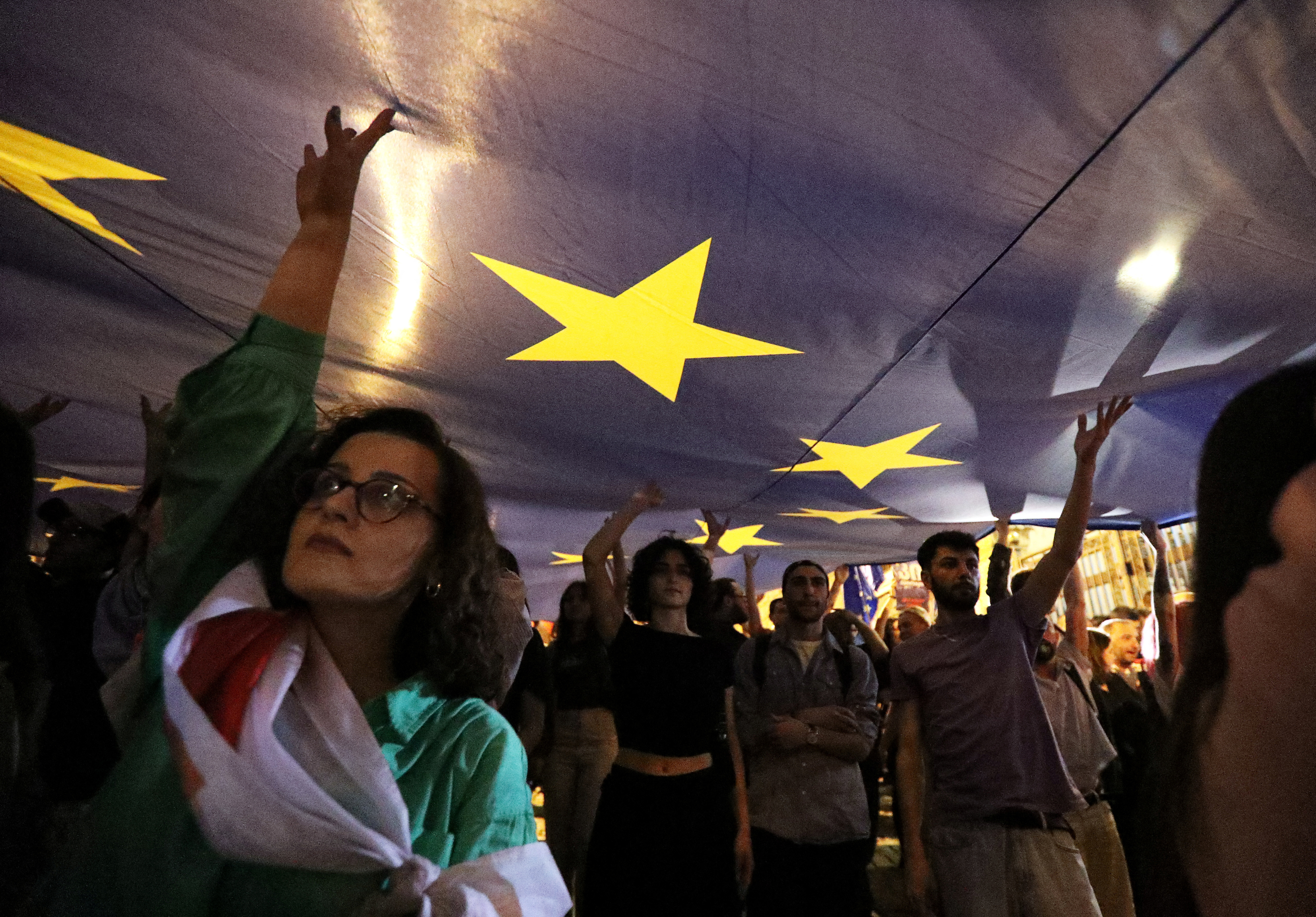
World Chevron

What polling can (and can't) tell you
On Nov. 5, election officials across America will count more than 150 million ballots to answer a burning political question: Who will be president of the United States? Until then, the best signals we can get will mostly come from public opinion polls, which will be the fuel of endless debate on who has the lead, Democrat Joe Biden or Republican Donald Trump. But what do polls really tell us? Lik
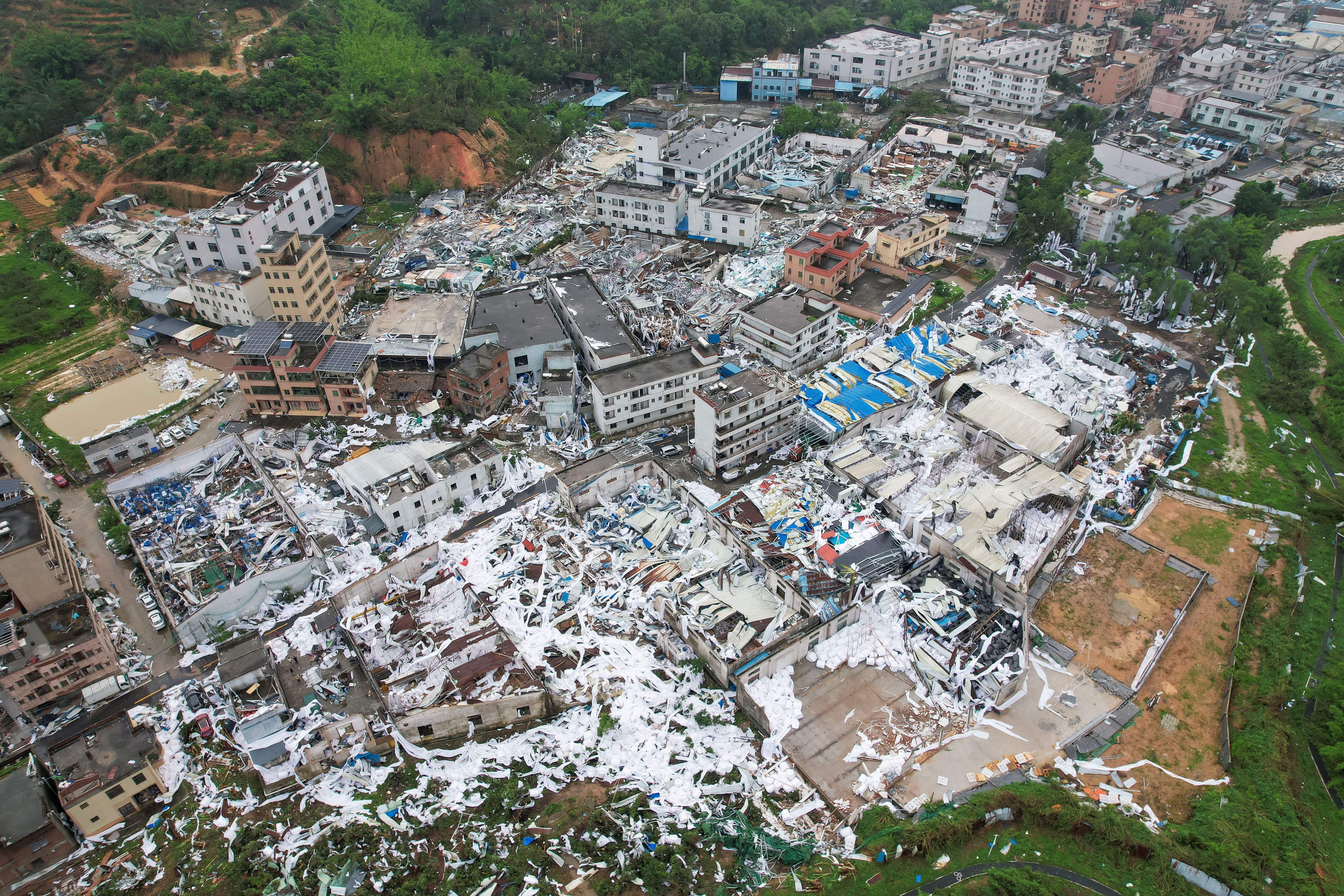
The U.S. military said on Sunday it had engaged five unmanned drones over the Red Sea that "presented an imminent threat to U.S., coalition, and merchant vessels in the region."

In honor of Earth Day 2024, today's Google Doodle takes us on a trip around the world

Want to take a trip around the world? You can in two seconds thanks to Google.
Releasing its annual Earth Day doodle, Google displays the beauty of all six continents around the world. Using satellite technology, the search engine giant created a collage with each Google letter that shows the global sustainability efforts within each continent. The goal for this doodle is to give the audience a tour of positive environmental change in the world.
Here's a look at the Google Doodle for Earth Day:
When is Earth Day 2024?: Get ready to help your planet with our guide to the holiday.
Letters in Earth Day Google Doodle represent climate change progress
Location: Turks and Caicos Islands
Turks and Caicos is home to many biodiversity areas. In an effort to preserve the countries conservation, the island has made an effort to protect natural resources such as reefs and restoring endangered species like the rock iguana.
Location: Scorpion Reef National Park, Mexico .
Flying to the Gulf of Mexico, Google makes a stop in Arrecife de Alacranes. This is the largest reef in the southern Gulf of Mexico and the UNESCO biosphere reserve. In this marine protected area, many coral and several endangered bird and turtle species call this area home.
Location: Vatnajökull National Park, Iceland
If you like the cold you'll love Google's pitstop in Iceland. Although the country is well-known for its polar bears, the country has more beauty offer. In 2008, the UNESCO World Heritage Site was established as a national park to protect the ecosystem in and around Europe’s largest glacier. With the mix of volcanoes and glacial ice, this area is able to produce rare landscapes and flora.
Location: Jaú National Park, Brazil
If you'd like to spend time in a forest, Brazil's got you covered. Parque Nacional do Jaú is one of South America’s largest forest reserves. Located in the heart of the Amazon rainforest this UNESCO World Heritage Site protects many species, including the Amazonian manatee, the giant otter, jaguar and the margay.
Location: Green Great Wall, Nigeria
Bringing you back to the heat, Google take us to Nigeria. The African Union-led initiative's goal is to restore the land affected by desertification across the width of Africa. To combat this, the group has planted trees and other vegetation in sustainable ways. By doing this, communities in the area have seen an increased economic opportunities, food security and climate resilience since 2007.
Location: Pilbara Islands Nature Reserves, Australia
To end the journey around the world, Google's last stop is one of the Pilbara Island Nature Reserves in Australia. These reserves help protect fragile ecosystems, increasingly rare natural habitats and threatened or endangered species. Some of the species include marine turtles, shorebirds and seabirds.
Ahjané Forbes is a reporter on the National Trending Team at USA TODAY. Ahjané covers breaking news, car recalls, crime, health, lottery and public policy stories. Email her at [email protected] . Follow her on Instagram , Threads and X @forbesfineest.
- Share full article
Advertisement
Supported by
What to Know About Venice’s Fees for Day Trips
Venice is trying to mitigate overtourism with a small fee on busy days. City leaders hope it will make visitors more aware of the city’s fragility.

By Elisabetta Povoledo
Reporting from Rome
After years of debate , Venice on Thursday began charging day visitors five euros to visit its fragile historic center on peak days, making it the first city in the world to adopt such a measure to counter overtourism.
Critics question whether a nominal fee will put people off from visiting one of the world’s most desired destinations. But officials hope that it might encourage some to rethink their plans and decide to come on weekdays or in the off-season.
That might help mitigate the impact of the estimated 20 million visitors who descended last year on the city’s beleaguered residents, who number fewer than 50,000, according to municipal statistics . About half of those visitors came only for the day, city officials said. Overnight guests are exempt from the fee.
The spirit of the initiative, city officials have said, is to make people aware of the uniqueness — and fragility — of Venice. Overtourism is creating an economy solely based on tourism that risks killing the city by pushing its dwindling residents out, said Nicola Camatti, an economics professor and expert in tourism at Ca’ Foscari University of Venice.
When will Venice start charging?
The fee went into effect on Thursday, a holiday in Italy. For 2024, city officials have singled out 29 peak days when single-day travelers in Venice between 8:30 a.m. and 4 p.m. have to pay. The days run until mid-July and are mostly on national holidays and weekends. The access-fee website provides a list of the dates.
Who must pay?
While just about everyone visiting the city has to register to obtain a QR code, not all visitors have to pay the fee. Overnight guests at registered accommodations like hotels or Airbnbs are exempt, because they already pay a daily tourist tax, as are people who study or work in Venice and those visiting relatives. There are other exemptions as well.
Residents of Venice, those born there and minors under 14 are among those who do not have to register. But they must have documents that prove their status.
It is possible that different fees will apply next year on a sliding scale that will depend on how many people city officials expect on any one day. City officials said the fees could be as high as 10 euros per day.
How will the system work?
Before coming to Venice on peak days, visitors should use the website to register and get a QR code.
The code will be scanned at points where visitors enter, like the train station, the city parking lot, the airport and the sprawling waterfront along the San Marco basin where boats dock. The access points will have one line for tourists and another for residents and what officials call city users, who are coming into Venice for reasons other than sightseeing.
At least for now, those who do not register ahead of time can do so at some access points or on their cellphones, officials said. Assistants will be available.
Initially, the controls will be “very soft,” said Michele Zuin, the municipal councilor responsible for the city’s budget.
Speaking to reporters at the foreign press association in Rome this month, Mayor Luigi Brugnaro said the fee was not about cashing in on tourists. “The costs of the operation are higher than what we’re going to make,” he said.
Why is Venice doing this?
City officials hope to relieve some of the stress that tourists put on the city by encouraging them to come on less busy days. They also say that by knowing ahead of time how many visitors to expect, the city can better deploy services.
“We want to better manage the numbers of tourists and disincentivize mass tourism” that makes it difficult for residents and visitors to “live in this city,” Mr. Zuin said this month.
To track the flow of visitors, the city already monitors them via phone location data and surveillance cameras, a system some critics have likened to Big Brother .
Venice has also fallen under the scrutiny of the United Nations’ culture agency, UNESCO, whose experts are concerned that not enough is being done to protect the city. Last year, Venice risked being added to UNESCO’s list of Endangered World Heritage Sites after experts at the agency listed mass tourism , along with climate change and development, as a major threat to its future. It urged City Hall to take steps to ameliorate the damage.
The municipal council approved the access fee just days before UNESCO was to vote on its status, and Venice stayed off the “in danger” list . But UNESCO officials said in a statement that “further progress still needs to be made” to conserve Venice.
Critics of the access fee note that officials have not capped the number of visitors, and they say that the nominal fee is hardly a deterrent. As recently as Friday, city officials said that about 80,000 visitors swelled the city’s narrow calli, as the streets are known, and the gardens of the 2024 Venice Biennale , still the world’s principal place to discover new art .
How else is Venice trying to restrict visitors?
Venice also has taken other steps it hopes will reduce what city officials call “mordi e fuggi” tourism, or “eat and flee,” referring to those who seek the city’s greatest hits — the Rialto Bridge and St. Mark’s Square — and who bring packed lunches and dump their garbage, contributing little to the local economy.
After years of heated debate and protests by vocal Venetians, the city banned cruise ships from its inner canals in 2021 , though Mr. Camatti, the tourism expert, said the ban on the ships had not reduced the number of day visitors.
This year, the city imposed a limit of 25 people per tour group and also banned the use of megaphones.
Elisabetta Povoledo is a reporter based in Rome, covering Italy, the Vatican and the culture of the region. She has been a journalist for 35 years. More about Elisabetta Povoledo

IMAGES
VIDEO
COMMENTS
Half-Day Itinerary for the Island of Rabbits in Japan: 10:13 - Arrive to Tadano-Umi station from Mihara Station. Buy rabbit food at the cafe and round-trip ferry tickets for 620 yen. 10:25 - Depart on the ferry to Okunoshima. 10:40 - Arrive on Okunoshima. Take the free shuttle bus to the Kyukamura hotel.
April 4, 2012 June 16, 2021 jjwalsh 74871 Views Day trip, Family-friendly, Kid-friendly, rabbits. ... Located about an hour's drive past Kure from Hiroshima city is the island of Okunoshima. The island is now a popular day-trip destination or weekend holiday spot. When you arrive in Tadanoumi, there is now a great little port which has a ...
A DAY TRIP TO THE ISLAND IS FUN ENOUGH, BUT STAYING OVERNIGHT CAN GIVE YOU THE CHANCE TO FULLY EXPLORE THE ISLAND, INCLUDING ITS DARK HISTORY. B eing the center of chemical weapons research and production during WWII, Rabbit Island was completely "erased" from the map and workers on the island were sworn to secrecy. With its picturesque scenery of the Inland Sea, the island is now a ...
This awesome trip is the perfect day trip from Hiroshima (only 2 hours by train) or if you are travelling the other way from Onimichi it's around 45 mins by train. A visit to Okunoshima rabbit island can even be extended to an overnight trip if desired, they have a hotel bookable on the actual island.
Okunoshima is about 50 km from Hiroshima, easy to reach with a bullet train and ferry combo and making for a perfect day trip from the city. The popularity of Okunoshima is hardly a secret , made famous by viral videos of 'rabbit stampedes' and articles from major newspapers - but when we got off the ferry and set foot onto the island ...
Located about an hour's drive past Kure from Hiroshima city is the island of Okunoshima. The island is now a popular day-trip destination or weekend or holiday vacation spot. There is a good sized hotel (resort) with hot spring bath, restaurant, pool (in summer) cycle and walking paths, kid-friendly museum and it is also possible to visit the ...
Access and transportation to Okunoshima island. 1. Get off the train at JR Tadanoumi station (忠海駅), about 30 minutes from JR Hiroshima station. 2. From JR Tadanoumi to Tadaoumi ferry pier, at the exit of the JR station, turn right and walk about 10 minutes until finding the bridge, then turn right at the junction before the bridge.
There are conflicting stories as to where the rabbits came from. Some believe they are descended from a small batch of eight rabbits released by school children in 1971, while others say the original rabbits were test subjects released after World War II. Either way, they are now the island's biggest draw, and they are very well cared for.
The Kyukamura Hotel : the only hotel on Okunoshima. The Rabbit Island is mostly visited as a day trip but this hotel allows overnights and access to the rabbits during their most active times; dawn and dusk. Prices are around 11,000 yen per person per night. There is a free shuttle bus from the port to the hotel.
Then by boat-- about 15 minutes with the ferry boat connecting Okunoshima and Tadanoumi Port (¥310 (~US$2.09) per trip) Free shuttle between Okunoshima Port and Okunoshima Kyukamura Hotel. Place not reachable with the JR Pass. Get there with Suica card or a rental car. ... One-day bike rental: Adults: from ¥600 (~US$4.05) (+ ¥1,000 deposit)
It takes time to go to Okunoshima, not because the island is remote, but because you'll be doing A LOT OF waiting along the way -- both waiting for the ferry and the train (times two, if you are doing a day-trip). If you are short on time, I wrote a few options below. The closest large city to Okunoshima is perhaps Hiroshima.
The electric assist is 600 yen for guests every 2 hours, and 800 yen for day trips. A deposit of 1000 yen is required for day trips (there is a refund after using a rental bicycle). By the way, there is a free shuttle bus from Okunoshima pier to Kyukamura Okunoshima.
1. Visit the museum. Despite their protected status life wasn't always so good for the island's inhabitants. During the Second World War, Okunoshima was used to test poison gas, with the poor bunnies as the test subjects. If you are interested in the history of the island, you could pay a visit to the museum. 2.
Visit Okunoshima, Japan's rabbit island! As well as frolicking with the island's residents, you'll make your own bamboo pinwheel in the historic city of Takehara, famous for its samurai residences and bamboo crafts. ... Multi-Day Tours (2) Night Tours (52) Sake & Wine Tours (19) Food Tours (50) Meet the Locals (41) Seasonal Events (37 ...
Okunoshima is a small island in the Seto Inland Sea, 13 minutes by ferry from Omishima Island. Okunoshima is known for its rabbits, its poison gas museum, and its ruined gun emplacements. The island makes a good day-trip, and is an attractive destination for photographers.
Let's take a raincoat on a rainy day. ・Let's reserve the hotel (Kyukamura-Ohkunoshima). You can enjoy Okunoshima in a day-trip, but if you stayed at the hotel, you can enjoy more. Because there is not the person other than a hotel guest early in the morning at night in particular, a rabbit is very active. Kyukamura Okunoshima(Rakuten Travel)
Tadanoumi Port. Here's the easiest way to get to Rabbit Island Okunoshima from Hiroshima: 1. Take the Tokaido-Sanyo Shinkansen (bullet train) to Mihara Station (~30 minutes) 2. At Mihara Station, transfer to the Kure Line (a local train) bound for Hiro (3 stops, ~25 minutes) 3. Get off at Tadanoumi Station. 4.
Travel Tips For Okunoshima: Try to come during the week, so you have all the rabbits mainly for yourself. Best rabbit spots are: visitor center, hotel, observation platform, ferry terminals and the little shrine. You can easily do this as a day trip from Hiroshima. You can spend as much time there as you want.
Bunny Island was famous in Japan before the rest of the world took note. Yes, there's the whole kawaii appeal of an island full to the brim with cute rabbits, but there's also a different side to rabbits in Japanese culture that makes the island that bit more significant.. These critters are considered to be lucky. They often appear in Japanese folklore, tales, and even as motifs on all ...
Hiroshima Okunoshima. Only a fifteen minute ferry ride from Tadanomi Port in Takehara City, this small isolated island offers 4 kilometers of beaches and campgrounds. Visitors can enjoy meals and a day trip to the hotsprings in "Kyukamura Okunoshima," which is the island's only lodging. Visitors have the chance to see the wild rabbits which ...
If you've heard about Okunoshima, more widely known by its popular name of Rabbit Island (official website), you can thank YouTube.Before a 2014 YouTube video of a woman being "attacked" by a horde of friendly bunnies went viral, most visitors to Okunoshima were either elderly Japanese coming to enjoy the local onsen hot springs or school children on a field trip.
Okunoshima, also known as the Japanese "Rabbit Island" is one of the day trips from Kyoto that might seem very difficult to plan. But it really isn't the case. But it really isn't the case. To get to Okunoshima island from Kyoto, you'll have to hop on a train to Tadanoumi (about 2:30 hours).
See and Feed the Rabbits on Okunoshima Island / Day Trips from Hiroshima. NUMBER 2. Poison Gas Museum. Poison Gas Museum was created in 1988 to remind us about the deadly gas that was manufactured on the island. It displays the materials from that time and explains the misery brought by the gas.
Pope Francis made a day trip to Venice Sunday to attend a famed annual cultural event, meeting prisoners, artists and young people, stressing the role that art can play in shaping culture for the ...
Watch: Antony Blinken says the US will act if China does not stop sending 'critical components' to Russia US Secretary of State Antony Blinken has warned Washington will act if China does not stop ...
Now, this new plan means people arriving for just a day must pay 5 euros, roughly $5, for a ticket valid from 8:30 a.m. to 4:30 p.m. Given the crowds, city officials like Marco Bettini says this ...
Pope Francis made his first trip out of Rome for seven months on Sunday with a packed visit to Venice that took in an art exhibition, a prison and a Mass, with the 87-year pontiff acknowledging ...
Releasing its annual Earth Day doodle, Google displays the beauty of all six continents around the world. Using satellite technology, the search engine giant created a collage with each Google ...
Chinese leader Xi Jinping said the US and China should be "partners rather than adversaries" as he met with top American diplomat Antony Blinken in Beijing's cavernous Great Hall of the ...
For 2024, city officials have singled out 29 peak days when single-day travelers in Venice between 8:30 a.m. and 4 p.m. have to pay. The days run until mid-July and are mostly on national holidays ...